Deities & Demigods 1E by Jerik
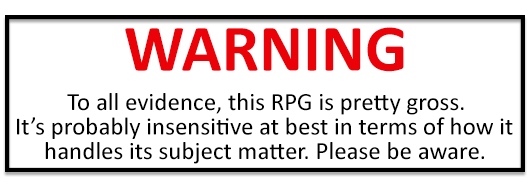
A Brief History of the Planes
Original SA post Deities & Demigods 1EPart 1: A Brief History of the Planes
Hey, I've been lurking here for a couple weeks, but decided it was time to make an account and contribute, and after some thought I figured something I could tackle was my favorite D&D setting: Planescape. I know this setting very well (well... I knew it; honestly it's been long enough since I've done anything with it I've probably forgotten a lot)—I have all the Planescape supplements; I've run several campaigns in the setting; and I was one of the contributors to the semi-official-but-not-really 3E Planescape conversion on planewalker.com. (Though I wasn't one of the editors, and I'm not in favor of all the decisions they made.) When and if Wizards of the Coast ever opens up Planescape to the DM's Guild, I'm going to jump right in with my own Planescape books and adventures. But as much as I love the setting, I don't think it's perfect by any means, and I think it's worth discussing in detail.
(This decision has nothing to do with Mors Rattus's review of the clearly heavily Planescape-inspired Sig. I had already begun writing these reviews well before those started—I wanted to be a few posts ahead and have several parts of this review written before I actually posted the first one—, so the timing is entirely coincidental. In fact, the entirety of this first post was completely written before the first Sig post dropped, except of course for this paragraph.)
Okay, I checked out the archives, and I see that the first few Planescape products were previously covered by SirPhoebos (and one later adventure has a partial review by DAD LOST MY IPOD). But most of them weren't, and even those that were I have lots to say about that isn't in SirPhoebos's (or DAD LOST MY IPOD's) reviews, so I think it'll still be worthwhile for me to write up my own take on them.
So let's get started.
Or actually, let's not, quite yet. I was going to start with the original Planescape Campaign Setting boxed set, but on second thought I think I'll go back a little earlier. Planescape came out during the time of the second edition of Dungeons & Dragons (or "Advanced Dungeons & Dragons", as it was then called to contrast it with "Basic Dungeons & Dragons"), but it had roots in first edition. The most obvious inspiration is the first-edition Manual of the Planes. And so I was going to start with that... but then I figured, what the hey, let's go back even earlier.
The Manual of the Planes was the first book to really describe the planes in detail—and its descriptions were mostly followed in Planescape, and in later presentations of the D&D planes. But it wasn't the first book to define the D&D cosmology. The existence of other planes had been hinted at as early as the original Dungeons & Dragons boxed set, which included the spell "Contact Higher Plane"—or arguably even earlier in D&D's predecessor Chainmail, which included elementals that had to be "conjured up by a Wizard", though it didn't specify where they were "conjured up" from. (Incidentally, is it just me, or is "conjured up" kind of a weird phrasing? "I'ma gonna conjure me up an elemental, ayup.") The full Great Wheel cosmology—though it wasn't named that at the time—was first laid out in Dragon #8, in the grandiloquently titled article "Planes: The Concepts of Spatial, Temporal and Physical Relationships in D&D", by (who else?) Gary Gygax, co-creator of Dungeons & Dragons. It wasn't much—barely longer than a page, with a single diagram that Gygax himself admitted looked like "abstract art", but it was a start. (It wasn't really abstract art, he clarified, but "a 2-dimensional diagram of a 4-dimensional concept." I'm not sure how he decided it was "4-dimensional"; by my analysis, if each plane is infinite in three dimensions, and if we assume that planes shown as adjacent in the diagram are also literally physically adjacent along some geometrical axis, then the given arrangement of the planes would require at least five dimensions total. But that's not really important.)
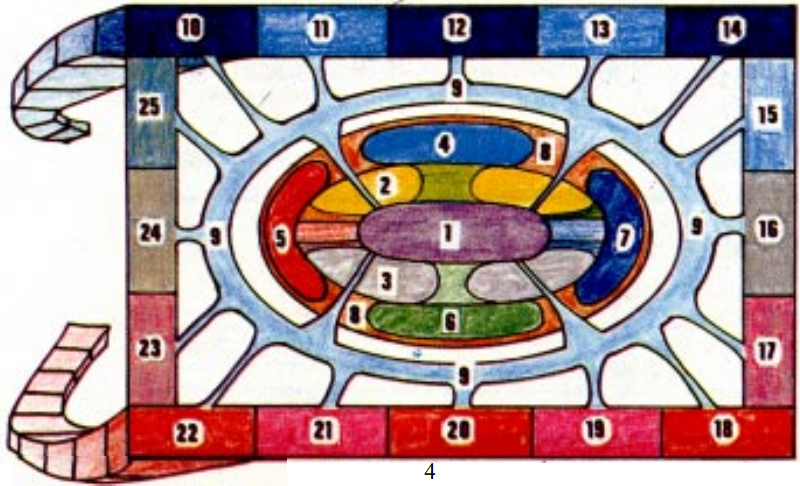
Did he... did he color this in with crayons?
In the first-edition Player's Handbook, "Appendix IV: The Known Planes of Existence" recapitulated the information from Dragon #8; it took up two pages instead of just one and a quarter, but that wasn't so much because it added new information as because it had more spacing between paragraphs and included two large diagrams instead of just one small one.
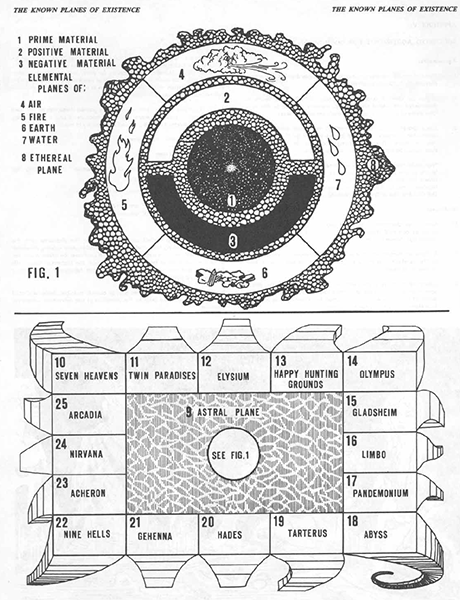
As it later turns out, the Elemental Plane of Air is not in fact inhabited by living clouds with faces as shown in this diagram. The Happy Hunting Grounds, however, is. (Are?)
But the same couldn't be said of "Appendix 1: Known Planes of Existence" in the first-edition Deities & Demigods, which took up a full six pages. Some of this was, again, due to more tables and diagrams; this appendix included five diagrams, as well as encounter tables for both the Ethereal and Astral Planes and tables for making a random choice from either the Inner Planes or the Outer Planes. But it did also include some new information, including six new planes not mentioned in Dragon #8 or the Player's Handbook: the Plane of Shadow (the distant ancestor of fourth and fifth edition's Shadowfell), the true neutral Outer Plane of Concordant Opposition (later known as the Outlands), and the four Para-Elemental Planes that lay between the four main Elemental Planes. But the influence of Deities & Demigods on the D&D cosmology wasn't limited to this appendix—the fact that it defined homes for each of the gods on the planes had significant consequences for the Manual of the Planes and later Planescape and the D&D cosmology in general.
So that's where we're starting our look at Planescape and its predecessors, with the first-edition Deities & Demigods, by James M. Ward and Robert J. Kuntz. I chose this book not only because of the impact it would have on the D&D planes, but also because, well, there's a lot to say about it. Deities & Demigods was probably the most—I hesitate to use the word "problematic", because it kind of gets overused to the point of near-meaninglessness, but here I think it does apply, so what the hey—problematic book of first-edition D&D. Alongside fantasy pantheons and ancient pantheons like the Greek and Norse, it included rather more culturally insensitive entries like the "Indian Mythos", which described gods still widely venerated today by the roughly one billion Hindus in the real world; and the "American Indian Mythos", which lumped together unconnected traditions from disparate peoples all over the North American continent into one muddled, ahistorical syncretism.
This isn't entirely new to the first edition Deities & Demigods, actually—the fourth supplement to the original D&D boxed set, "Gods, Demi-Gods & Heroes"—not coincidentally by the same authors, though listed in the reverse order—also included most of the same mythoi, including the Indian but not the "American Indian". It also, incidentally, included the mythos of "Robert E. Howard's Hyborea", which did not make it into the 1E Deities & Demigods. I'm not going to give a full review of this supplement—it didn't really have a direct impact on Planescape—, but I will bring it up again; in fact it's going to come up again in the next post.
Before we get into the meat of the book, though, let's take a gander at the cover:
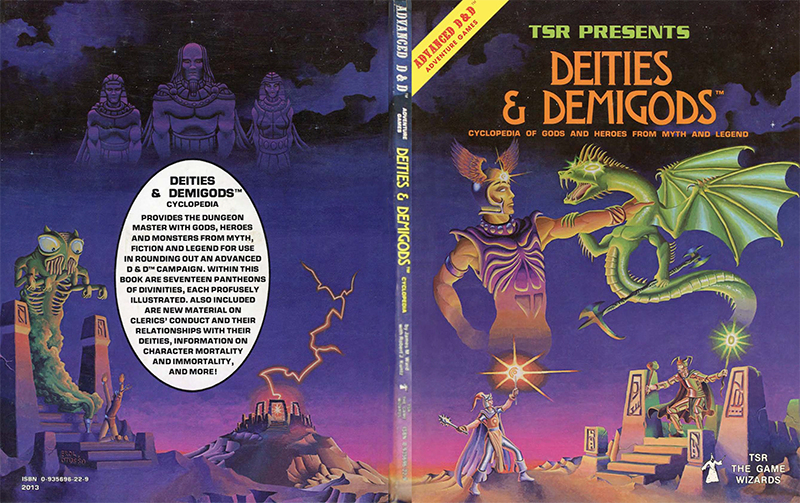
I'm pretty sure the two gods on the front cover are supposed to be fighting, but they don't really seem to be into it.
Anyone familiar with the art of first-edition D&D will recognize that as the work of Erol Otus, who definitely has an instantly identifiable style of his own. Otus also did some interior illustrations in some other books and illustrated the cover of the 1981 version of the D&D Basic Set, and did many covers and interior illustrations for Dragon Magazine and some adventure modules. He's also done work for other role-playing game companies, as well as art for some video games, including Star Control II.
None of the entities on the cover actually appear in the book, though. Unless those three gods in the sky are supposed to be Egyptian gods, which... maybe? The middle one could be Ptah, I guess, but I'm not sure who the other two would be.
Incidentally, both credited authors of Deities & Demigods are still alive, and still working to some degree in the RPG industry, though not on Dungeons & Dragons. Both were players in Gary Gygax's original Greyhawk games, and both have been immortalized in the game under scrambled versions of their names. James M. Ward created the first science-fiction role-playing game, Metamorphosis Alpha, released by TSR about the same time as "Gods, Demi-Gods and Heroes". The Greyhawk archmage Drawmij, the eponym of the spell Drawmij's Instant Summons (and several other spells in earlier editions), was named after him—note what you get if you spell "Drawmij" backwards. Robert J. Kuntz, meanwhile, was for a time the co-Dungeon-Master of Gygax's Greyhawk campaign, and contributed heavily to the Greyhawk setting. His player character Robilar not only eventually appeared as an NPC in the Greyhawk setting, but also had a scrambled version of his name attached to a core magic item, the iron bands of Bilarro. Kuntz also was more directly referenced via an anagram of his surname in another NPC, the archmage Tzunk, first mentioned in the third supplement to the original D&D boxed set, "Eldritch Wizardry", as a wizard who wrote about the Codex of the Infinite Planes—although there his name was spelled "Tzoonk"; it was respelled "Tzunk" in the first-edition Dungeon Master's Guide, perhaps to make the homage to Kuntz a little clearer.
Anyway, Deities & Demigods was eventually reprinted under the title Legends & Lore (not to be confused with the entirely different second-edition Legends & Lore... at least TSR didn't reuse old titles to the extent that Wizards of the Coast later would during the third-edition era), but I refer here to the former title because the first printing of the book had two pantheons (or "Mythoi", in this book's terminology) that the later printings, including those under the Legends & Lore title, lacked: the Cthulhu Mythos, based of course on the works of H. P. Lovecraft and his collaborators and imitators, and the Melnibonéan Mythos, based on the stories of Elric of Melniboné by Michael Moorcock. (Actually, Moorcock had an important influence on D&D that's worth discussing... but I'll save that till we get to the Melnibonéan Mythos.) I'd bought the book when it first came out (or rather had it bought for me, I suppose, since I was a young child at the time), and so I had a copy of the printing that included these two mythoi—still have it, in fact, along with all my other first-edition D&D books, though at the moment due to limited shelf space they're in a box in a storage unit. Unfortunately, the book is in pretty bad shape; the spine is missing, and the cover is badly battered, which I'm sure greatly reduces its value to a collector—not that that matters much, since I have no intention of selling it. But anyway, I guess its well-worn condition testifies to how much use this book saw—or at least how much I enjoyed looking through it, since its actual application to a game was somewhat limited.
The obvious explanation for the absence of the Cthulhu and Melnibonéan Mythoi from later printings is that TSR had failed to acquire the rights, and so was forced to remove them. That's not the real story, though; what really happened was more complicated. It's debatable that rights were even needed for the Cthulhu Mythos, which was almost certainly in the public domain by then; Arkham House, a publishing company set up by August Derleth and Donald Wandrei, claimed the rights to Lovecraft's work, but that claim wasn't necessarily on firm legal ground, and it's doubtful that it would have held up against a serious challenge in court. But TSR didn't try to challenge Arkham House's claim, so that's moot. The same couldn't be said of Moorcock, however, who was still alive at the time—and at the time I'm writing this still is—, but TSR actually had contacted Moorcock and obtained his permission to use his characters and concepts. The fact is that it wasn't Arkham House or Moorcock that objected to TSR's inclusion of these mythoi at all—it was another role-playing game company that had officially acquired the rights to those two properties, and wasn't sure it liked the idea of a different company using them. That other game company is, incidentally, still around today, and if you know much about role-playing games you can probably guess who it was.
That's right: Chaosium, publisher of Call of Cthulhu. Call of Cthulhu is now in its seventh edition, but back then was only in its first. (Or was about to be in its first; when Deities & Demigods came out Chaosium was working on Call of Cthulhu but hadn't actally published it yet.) At the time, it was also publishing (or about to publish) a game called Stormbringer, based on the same works by Moorcock that Deities & Demigods drew on for its "Melnibonéan Mythos"; that game is out of print today, but went through six editions (five under the name "Stormbringer", one under the name "Elric!" between Stormbringer's fourth and fifth editions) before Chaosium let the license lapse in 2007. (The original Stormbringer game, incidentally, was co-written by Ken St. Andre, probably best known for his role-playing game Tunnels & Trolls, the first real competitor to Dungeons & Dragons.)
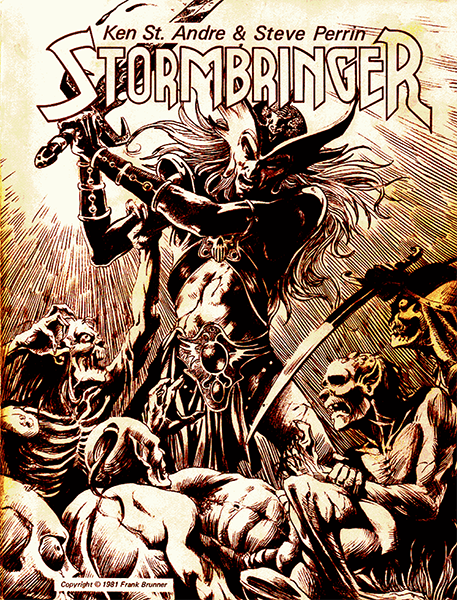
Chaosium's production values were a little lower back then than they are today.
However, when Chaosium threatened legal action, TSR contacted them and worked out a deal. Chaosium would withdraw their objections to TSR's using this material, as long as TSR included them in the acknowledgments. And they did—at the end of the "Credits and Acknowledgments" section of the first printing of Deities & Demigods was the sentence "Special thanks are also given to Chaosium, Inc. for permission to use the material found in the Cthulhu Mythos and the Melnibonean Mythos".
Unfortunately, the next year TSR was taken over by two brothers, Brian and Kevin Blume, who had a very different vision than Gygax (and who would eventually sell their stock to TSR manager Lorraine Williams, giving her a controlling interest in the company—but that's another story). The Blumes didn't like the idea of mentioning a rival company in their own book, and decided they would rather excise those two chapters entirely than leave in the single sentence thanking Chaosium. And so in the second printing they did just that—or they did half of that, anyway. Ironically, when they removed the chapters on the Cthulhu and Melnibonéan Mythoi, they neglected initially to take out the offending "special thanks" that was the whole reason they wanted to remove those chapters in the first place. So the second printing of Deities & Demigods still thanked Chaosium for permission to use material that no longer appeared in the book—as did the third, and part of the fourth, until they finally got around to getting rid of that sentence that had bothered them so much. I'm not sure the Blumes were terribly competent.
So while Legends & Lore was essentially the same book as Deities & Demigods except for the title and the cover and those two missing mythoi from the first printing of the latter, because I'm going to include those two mythoi in my review here I'll refer to the book throughout as "Deities & Demigods". Before moving on, though, I will remark that Legends & Lore had a much blander cover:
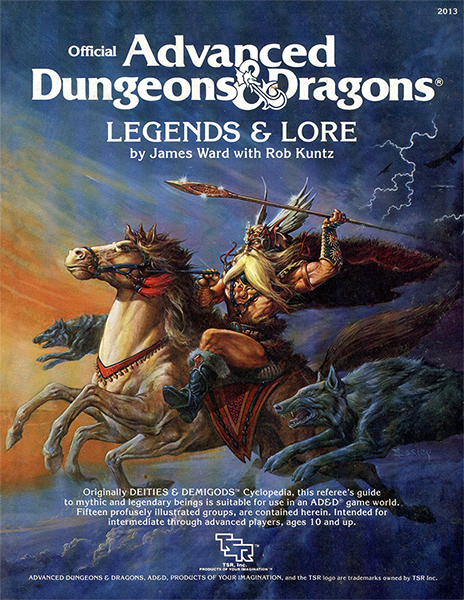
I'm not bothering with the back cover this time because it doesn't have any art—just text on a solid-color background.
Anyway, I think this preamble has gotten long enough for a post by itself, so next post I'll get around to actually discussing the contents of the book.
Next Time: Gods and Monsters
Gods and Monsters
Original SA post Deities & Demigods 1EPart 2: Gods and Monsters
The first thing we see when we open the book (assuming we open it at the beginning) is another piece of art by Erol Otus:
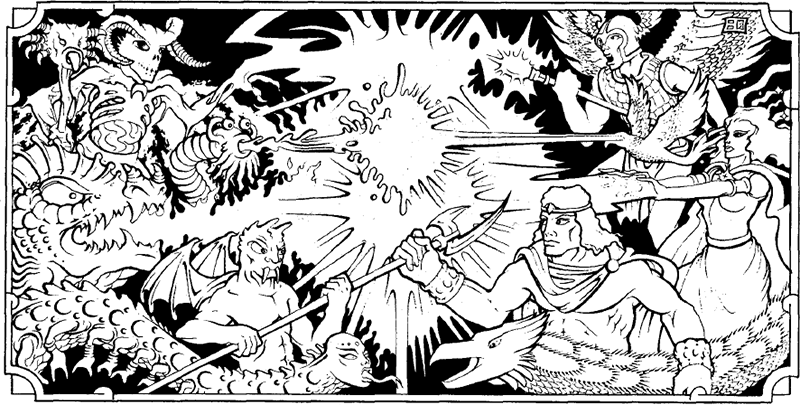
I kind of like to think the entities on the left are good, and the ones on the right are evil, just to play against type. Or maybe both sides are good and it's a dispute of law vs. chaos. Just a friendly disagreement. They're not really trying to hurt each other.
None of these creatures appears in the book either.
Anyway, below that image are the credits, and then we get a foreword by Gary Gygax that lays out the goals of the book.
Gary Gygax posted:
[O]ne particular aspect of fantasy role playing was foremost in my mind: there was either a general neglect of deities or else an even worse use by abuse. That is, game masters tended to ignore deities which were supposedly served and worshiped by characters in the campaign, or else they had gods popping up at the slightest whim of player characters in order to rescue them from perilous situations, grant wishes, and generally step-and-fetch. Obviously, there is a broad ground between these two extremes, and that is squarely where I desired AD&D to go."
He goes on to emphasize just how much input he had into the book and its format, and how closely he supervised the authors to make sure the book matched his vision. Which, incidentally, I totally believe; I think pre-Blumes Gygax was pretty hands-on and protective of his game. I'm not going to quote the whole foreword—it fills most of a page; I don't think anyone ever accused Gygax of being laconic—but there are two other bits I want to highlight. One is that he mentions that the "[d]iabolical and demoniac deities are important to the campaign milieu", but not included in this book, because they were already in the "MONSTER MANUAL and the attendant volumes forthcoming", and it was "no great matter to extract these beings from the other works and include them amongst the other deities"—which seems to imply he intended Dispater and Demogorgon and the other archdevils and demon princes from the Monster Manual to be considered gods on par with Anubis and Artemis. (Actually, that's made more explicit later in the book, in the chapter on Nonhumans' Deities... we'll get to that eventually.) The other thing I wanted to mention is this:
Gary Gygax posted:
It is worth commenting that the strength and powers of the beings contained herein are appropriate to the overall work. Thus, addition of these deities and demigods does not imbalance the campaign. Furthermore, characters who become a match for them are obviously to be ranked amongst their number, no longer suitable for daily campaign interaction, but to be removed to another place and plane and treated accordingly.
So the PCs were not intended to fight the gods, because any PCs powerful enough to fight the gods would ipso facto be gods themselves, and no longer player characters. So then why were the gods given full statistics in the first place? This question is revisited (but not really answered) in the Editor's Introduction—not directly bylined, but presumably by Lawrence Schick, who's credited as the book's editor:
Lawrence Schick posted:
Well, here it is, DEITIES & DEMIGODS, the latest addition to the series of ADVANCED D&D volumes. But what exactly is it? Let's see, it has a nice cover—open it up, inside there are lots of pictures next to sets of stacked statistics . . . it must be just like the MONSTER MANUAL! There, that was easy. Now that we know what it is, we know what to do with it, right?
Wrong.
DDG (for short) may resemble MONSTER MANUAL, and in fact does include some monsters. However, the purpose of this book is not to provide adversaries for players' characters. The information listed herein is primarily for the Dungeon Master's use in creating, intensifying or expanding his or her campaign.
Okay, but again, if the gods aren't intended to be encountered by player characters, why do they have full statistics?
This wasn't the first time this matter had come up. The "Gods, Demi-Gods and Heroes" supplement to the original D&D boxed set had also included full statistics for the gods within—"full" being a relative term, because statistics for anything in the original boxed set were pretty sparse. This matter was addressed in that book by Timothy J. Kask, TSR Publications Editor:
Timothy J. Kask posted:
This volume is something else, also: our last attempt to reach the "Monty Hall" DM's. Perhaps now some of the 'giveaway' campaigns will look as foolish as they truly are. This is our last attempt to delineate the absurdity of 40+ level characters. When Odin, the All-Father has only(?) 300 hit points, who can take a 44th level Lord seriously?
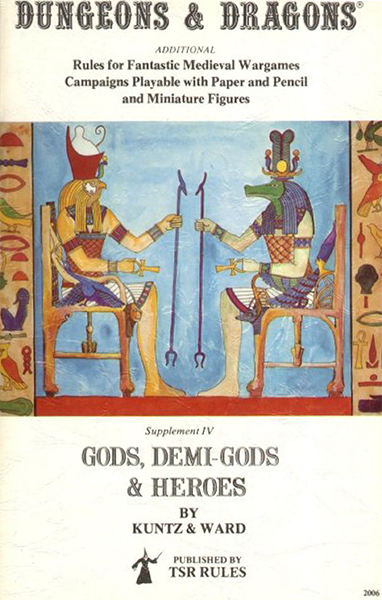
I feel like this post needs more images, so here's the cover of "Gods, Demi-Gods and Heroes"
While this—along with the Editor's Introduction from Deities & Demigods— wasn't written by Gygax himself, it seems a sure bet that Gygax read it and approved it before it saw publication, and that it mostly reflected, or at least didn't conflict with, his own views. But, well, this last rationalization really doesn't seem to me to hold much water. First of all, if you want to highlight how ridiculous high-level characters are, there are simpler means than creating more than a hundred stat blocks you never expect to be used. Second, well, if that was really the intent, the method seems counterproductive. If you provide the players with statistics for anything, at least some players are going to think they're supposed to fight them, no matter how much you try to protest otherwise in the introductory sections that a lot of players are just going to skip over anyway. Stat up the gods, and players will fight the gods. And of course they did.
Not that I did myself, or know anyone who did. I've never been interested in powergaming, and I've never had a character reach nearly that kind of power level—nor has it happened in any campaign I've run as a DM, and I've run long campaigns that went on for real-time years. But my experiences are not universal; there's clear evidence that some players did play in such absurdly high-level campaigns. Early issues of Dragon Magazine include letters from players boasting about their 358th-level characters. That's not an exaggeration: a letter in Dragon #137 began with the sentence "Recently my AD&D® game character, Waldorf, a 358th-level magic-user, created the nuclear bomb." Okay, maybe it's a little bit of an exaggeration, in that I referred to "358th-level characters" in the plural, but while others may not have reported that exact level, some claimed levels that were even higher. In Dragon #31, a writer to the "Sage Advice" column mentioned having "two characters that are at one thousand-plus level". ("I don't know whether to laugh or cry," columnist Jean Wells responded.) And in the same issue as the 358th-level Waldorf, the writer of another letter stated that his friends had "been playing the AD&D game for over six years now" and their characters had "levels in the millions, maximum scores for almost every ability, and can obliterate five planes of the Abyss in a round." (They complained that they were out of challenges, and asked how they could "have fun with these high-level characters." "Perhaps you should meet Waldorf," editor Roger E. Moore replied.)
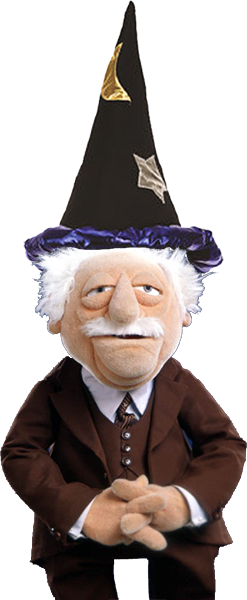
"Now I am become Death, the destroyer of worlds! Do ho ho ho!"
Actually, those "thousand-plus level" characters are particularly pertinent to the matter at hand, because of how they got to be thousand-plus level. I think I'll just quote that entire letter:
Some silly person posted:
Question: In GODS, DEMI-GODS AND HEROES it says that a forty-plus level character is ridiculous. In our game we have two characters that are at one thousand-plus level. This happened in "Armageddon," a conflict between the gods and the characters. Of course, the characters won. What do you think about that?
In other words, yes, at least some players are on record as having used the book of gods as a book of monsters, having their players gain experience from defeating gods. I'm sure they weren't alone.
But was this really an unintended consequence? On Gygax's part, at least, I'm inclined to say yes. I think Gygax's oft-expressed contempt for such absurdly high-level play was genuine, and that he really didn't intend for players to treat the gods as monsters to be fought. Which, however, again leaves unanswered the main question: Why did they have full statistics?
I think I may have an answer. One thing that gets talked about with regards to early versions of D&D is "Gygaxian naturalism"—the idea that Gygax included a lot of statistics and details in his books not because they had any direct impact on gameplay, but just because they made the world seem more detailed and real. This wasn't really the case in the original D&D boxed set, but certainly was in first edition; monsters frequently had abilities that didn't directly relate to combat; stats and rules and tables were included to deal with all sorts of relatively mundane situation; Gygax's adventures often included notes as to how dungeon features were maintained, even though adventurers were unlikely to discover this. Gygaxian naturalism survived Gygax's own involvement with the company; arguably second edition engaged in it to an even greater extent than first, with monster entries having detailed notes on their habitats and ecologies and even their reproduction, and third edition went so far as to stat up monsters using similar rules to player characters. Of course, this kind of naturalism wasn't unique to D&D, and other games have similarly fleshed out their gameworlds and tried to give them a plausible basis, some to a greater extent than Gygax ever did. So maybe "Gygaxian naturalism" is a bit of a misnomer, but even if wasn't something unique to Gygax, it was definitely something promoted by him. And I can see that as the reason for the gods having stats—if these are something that exist in the gameworld, then by golly they should have statistics (for purposes of naturalism), even if they're never going to be used!
Now, personally, I'm all for Gygaxian naturalism, or whatever you want to call it. To me, a big part of the appeal of role-playing games—maybe the main part of the appeal—is to feel like I'm vicariously experiencing another world, and having the setting feel like a living, breathing environment not entirely focused just around adventures is an important part of that. That's probably why I'm not a big fan of "storygames", or other games that heavily incorporate metagame mechanics; the contrivances they go through to give the players a larger role in defining the gameworld and the environment work against the immersion for me... I don't want, as a player, to be able to influence elements of the surroundings that my character shouldn't have control over, because that undermines the sense of a larger world that doesn't exist just to serve the characters. It's why I don't like "rules light" games that leave much up to DM fiat and narrative convenience; I like having rules for everything, because it bolsters the illusion that there's an objective world where these events are taking place. It's also at least part of why fourth edition was my least favorite edition of Dungeons & Dragons. Yes, it may have been the most balanced edition, but it achieved that balance at the cost of jettisoning any pretense of naturalism; it may be the best edition for games centered around fighting monsters in set encounters and not worrying about what else is going on in the setting, but that's not the kind of game I want to play. (I am not, of course, saying that any of these kinds of games are objectively bad—only that they're not the kinds of games I, personally, prefer.)
So I guess my point, to the extent that I have one, is that while it's easy to poke fun at his including statistics for gods and then not expecting the players to use them, I think I can see why Gygax did that—or more accurately why he allowed (or even encouraged?) the writers to do that under his supervision. I might even have done the same in his place. So what, if anything, should he have done differently? I'm honestly not sure. Maybe been more upfront about his reasons for including the statistics? (Though introspection can be hard, and maybe he wasn't totally aware of his own motives—that's in no way intended as a slam on Gygax; I can't claim to be sure I'm fully aware of my own motives for everything I do either.) Maybe been more explicit about what players and DMs should do about characters who grow too powerful? Or maybe there's really nothing in particular he should have done differently, and the way it was presented served the goals he meant it to serve, and the fact that it also enabled powergaming players who wanted thousand-level characters was an arguably unfortunate but unavoidable side effect.
(Though it may not be directly pertinent to the matter at hand, I feel I would be remiss not to at least mention the existence of the third-edition Deities & Demigods (with its fully statted gods) and Epic Level Handbook (with its rules for characters becoming powerful enough to challenge them). Those books attracted a good deal of mockery and criticism at the time, but they're not completely without precedent; as we've just seen, giving full stats for the gods goes all the way back to the original D&D game. Still, I guess there's a difference between giving stats for gods when those stats are brief enough that you can fit four gods on one page, and giving them when the stats for a single god take up nearly two pages; and while some players may have played ridiculously high-level characters in earlier editions, no previous edition explicitly condoned and encouraged such play the way the Epic Level Handbook did (the closest was probably the Basic D&D Immortal Rules, but even that was less over the top); so maybe the criticism isn't entirely unwarranted.)
Anyway, I've now spent almost two thousand words discussing why the gods have stats. Time to move on.
After Gygax's foreword, we come to the table of contents, at the bottom of which is our first piece of art not by Erol Otus. I'm not sure who it's by, actually; while the credits list all the artists, they don't say who did what, and I don't see a signature on this piece—and I'm not sufficiently intimately familiar with the styles of the various 1E artists to recognize it. (If I had to guess, I'd venture it's probably Paul Jaquays (as she was then credited; she now goes by Jennell Jaquays), but I'm not sure.)
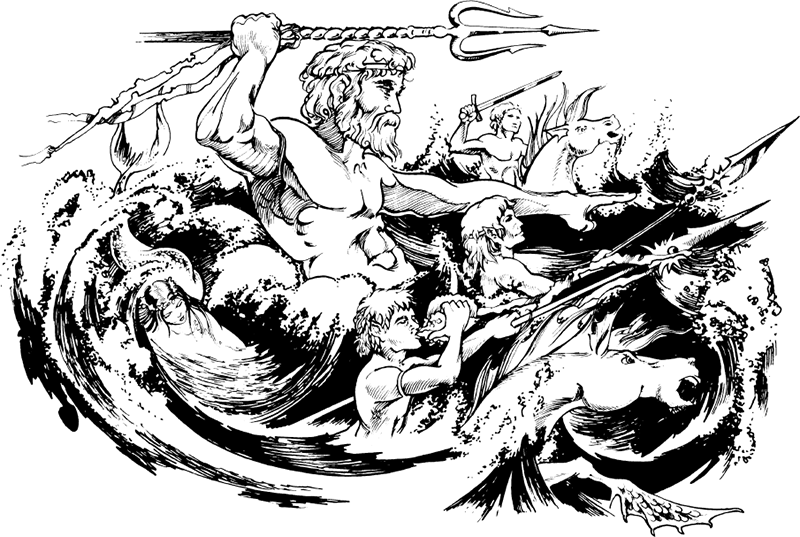
He looks kind of bored. "It's a living."
At least, assuming that's supposed to be Poseidon, this time it depicts an entity that actually does appear in the book.
We then get a preface by James M. Ward, who spends much of it discussing (in generalities) his reasons for the creative decisions the authors made in deciding on the gods' abilities and relative power levels. I'll just quote a part of this:
James M. Ward posted:
All of the leaders of the pantheons were given 400 hit points and the rest were scaled down from there; the relative resistance of beings to blows and magic was derived from studies of their battles with natural and supernatural forces; while concepts like strength were easily assigned in the case of deities of strength or war, this concept is less easily applied to the more powerful deities who have no need for massive muscles. Alignments were perhaps the hardest AD&D concept to deal with, and the one that will have the most debate among the interested users of this work. Beings like Set, Loki and Arioch are easy to classify, but when working with the middle-of-the-road deities who were often chaotic but known for consistent kindness, or were rogues of the worst sort but very companionable, it became necessary to consider them as a whole to make a judgment.
Actually, I don't think even Set and Loki were as straightforward as he's making them out to be. Both are usually depicted as evil in modern pop culture, but neither really was evil in the oldest myths. Set was originally a benevolent god of the desert and of warfare, and was widely honored; his name was used for love spells, and he accompanied Ra on his daily journey on the solar barge and protected the sun god by fighting off the evil serpent Apep. It was only after Set was adopted by the invading Hyksos that his association with foreigners, combined with the rise in worship of Osiris, induced the Egyptians to have a more negative view of him. As for Loki, he was certainly mischievous in many of the myths about him, but he was generally a staunch ally of the Aesir, and the only myths in which he did anything outright evil were set during (and just before) the events of Ragnarǫk—which may very well have been at least in part an invention of the Christian mythographers who are the only source we have for these stories.
Anyway, below the preface are the credits, including the aforementioned thanks to Chaosium, and then on the next page we finally get to... the Editor's Introduction. Yes, we have a foreword, a preface, and an introduction, each written by a different person. Don't worry; we don't also have a prologue, a preamble, or an exordium.
I've already quoted the beginning of the Editor's Introduction above; Schick goes on to discuss the vital role that clerics should have in a campaign and the importance of the DM's considering "the flavor of the campaign" when deciding which pantheons to use, and encourages DMs to read up on the mythologies themselves to "discover the fascinating stories behind these immortal characters, and get a really solid feel for how to play them." There's one odd statement I want to highlight:
Lawrence Schick posted:
The most important thing to remember about this book is that, unlike the other AD&D volumes, everything contained within this book is guidelines, not rules. DDG is an aid for the DM, not instructions.
I'm honestly not sure exactly what Schick is getting at here. Surely in some sense every book contains guidelines, not rules, but why is this more true of Deities & Demigods than any of the others? Gary Gygax was never going to come to your home and force you at gunpoint to roll a loyalty check for your faithful henchmen when you left them in a position where they could potentially steal your silverware. I think what Schick means is that you can choose which gods and pantheons to use in your campaign, and you can change their alignments and abilities if it works better for your purposes, but the actual rules regarding gods are just as much rules as anything in the Player's Handbook or Dungeon Master's Guide.
Anyway, after the Editor's Introduction we now finally get to the "Explanatory Notes", which... I guess I'll save for another post, because this one got long enough as it is. (Admittedly mostly because of the long digression about the gods having statistics.) Sorry.
Next time: The Consequences of Negative Charisma
The Consequences of Negative Charisma
Original SA post Deities & Demigods 1EPart 3: The Consequences of Negative Charisma

I probably should have been using this banner from the start... oh well.
Foreword, preface, and introduction finished, now we finally get to the meat of the book. Oh, we don't get to the gods themselves yet; no. First we've got to get through the:
EXPLANATORY NOTES
This section details the statistics given in each entry for a god or monster. Some of these statistics apply only to gods, others only to creatures, but they're all mixed together in these notes. Most of these are straight out of the Monster Manual and other early monster books: Frequency, Number Appearing, Armor Class, Move (with the quirky 1E convention of preceding the movement rate with a slash to indicate flying speed, two slashes for swimming, etc.), Hit Points, Hit Dice, % In Lair, Treasure Type, Number of Attacks, Damage per Attack, Special Attacks, Special Defenses, Magic Resistance (in 1E Magic Resistance was a standard item in every monster entry, even though the vast majority of monsters didn't have it), Intelligence, Size, and Alignment. We do get a few notes on possible special values for these items for gods: Move, for example, could be Infinite, indicating that "the entity can travel to any point desired with no time lapse, and this is the being's preferred mode of movement." We also get a description of how Magic Resistance interacts with deities' special abilities—surprisingly, it still applies. After Alignment we get our first item that hasn't been standard in monster books: Worshiper's Align, the typical alignment of worshipers of the god, which may or may not be the same as the alignment of the deity. ("This does not necessarily apply to the alignment of the deity's clerics, which must be identical with their patron's.") After that we get Symbol ("Fairly self-explanatory, this is the symbol by which the deity and his or her faithful followers are known. It will be found engraved upon most holy items."), and then Plane—the "deity's plane of origin", usually, but not always, one of the Outer Planes. After that, for deities and heroes we get their levels of ability in various classes and subclasses: Cleric/Druid, Fighter, Magic-User/Illusionist, Thief/Assassin, and Monk/Bard. (It's worth noting that the gods and heroes in this book do not apparently make any attempt to follow standard AD&D multiclassing/dual classing rules—which were, admittedly, messy and contrived anyway.) We then get Psionic Ability—like Magic Resistance, a standard item in 1E monster entries, even though it didn't apply to the vast majority of monsters (though most of the gods do have some level of psionic ability)—and finally, for gods and heroes, their ability scores: Strength, Intelligence, Wisdom, Dexterity, Constitution, and Charisma (abbreviated by their first letters, except Charisma, which is CH).
The ability scores get a little over a page of extra explanation, because while the Player's Handbook laid out the bonuses and penalties of ability scores ranging from 3 to 18, gods and heroes often had higher ability scores. Therefore, this book extends the tables from the Player's Handbook to include ability scores from 19 to 25—25 was a hard cap on ability scores in 1E, as 30 is in 5E. For example, characters with a Strength of 25 can carry 15,000 pounds, get a +7 bonus to hit and +14 to damage, and have a 23 in 24 chance of forcing open a stuck door (or 9 in 10 if it's locked, barred, magically held, or wizard locked). Characters with a Dexterity of 25 get a +5 adjustment to attacks, a −6 defensive adjustment to Armor Class (in 1E, lower armor classes were better), and bonuses ranging from 30% to 50% to the various thief skills.
Charisma is unique in that it gets extended to values not only above 18, but also below zero. "In certain instances," the book explains, "some divinities are so loathsome and repellent as to actually have negative charisma." For example, a being with a Charisma of −7 gets a reaction adjustment of −70%—meaning that 70% is deducted from the probability of an NPC's having a positive reaction to the character. Gods, but not other characters, also have a horror ability if they have a negative charisma, causing creatures below a certain threshold of hit dice or levels (12, for a Charisma of −7) to be "stunned with fear and detestation until the being is no longer in sight"—divine beings with a high positive Charisma, incidentally, have a differently flavored but mechanically identical awe power. Oddly, neither Deities & Demigods nor the Player's Handbook addresses the effects of Charisma between 0 and 2; apparently you can have a Charisma of −1, or you can have a Charisma of 3, but nothing in between.
After the Explanatory Notes, we have the Standard Divine Abilities—as well as another image, while I'll include here because I realize that other than the banner at the top I haven't included any images yet in this post (but this introductory text in Deities & Demigods is really light on illustrations—there'll be more once we get to the actual pantheons).
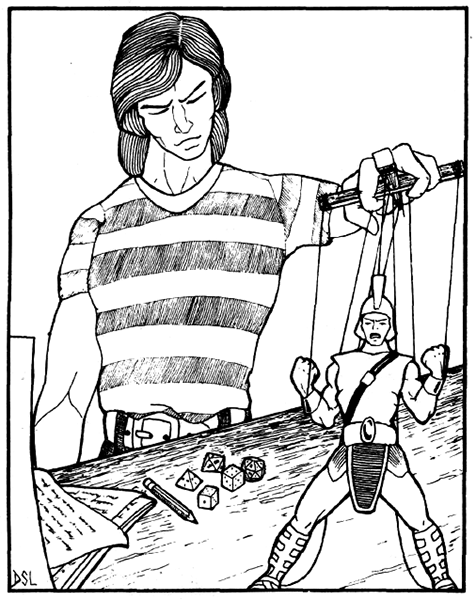
So is this drawing trying to make an analogy between role-players and gods? Because that seems really... trite.
STANDARD DIVINE ABILITIES
Basically, there are eight special abilities that all gods have, unless specified otherwise: they can command other creatures, with no saving throw; they can comprehend languages; they can unerringly detect alignment; they can gate in other beings of the same mythos; they can impose a geas or a quest (these were both spells in first and second edition, with similar but slightly different effects, so this counts as two different abilities); they can teleport; and they have true seeing, the ability to see all things as they truly are (also a spell... in fact, all these abilities are based on spells). These abilities all "function instantaneously and at will, but not continuously." The book also encourages DMs to give the gods "bonus powers" not listed in the book according to their judgment. Finally, all gods and demigods make all saving throws on a roll of 2 or higher on a d20; heroes need a 3.
DUNGEON MASTERING DIVINE BEINGS
Dungeon Mastering Divine Beings posted:
In AD&D, when the deities deign to notice or interfere with the lives of mortal men, it is the Dungeon Master who must assume their roles. DMing a divinity presents a far greater challenge than playing the role of a merchant, a sage, or an orc. Players will quite naturally pay special attention to the words and deeds of the gods, so the DM must make a special effort to understand how to present them.
Basically, we're told that the gods are egotistical beings who will harshly punish any mortals who try to intimidate them or treat them as equals. They "enjoy flattery, but any any god with a wisdom score above 15 will know it for what it is, and will generally not allow his or her opinion of the flatterer to be altered by the flattery." Most gods have much higher Intelligence and Wisdom than mortals, and shouldn't be easy to trick or fool. "In fact, as DM, you can usually assume that if you know why a character is saying or doing something, the deity would know it as well. This should help to simulate the deity's superior intellect and wisdom, and impress the characters." Gods rarely deign to enter combat with mortals, and even if they do they won't risk their lives, and are likely to just summon aid and then teleport away. Nor will they typically fight other gods, "[u]nless they have a history of mutual antipathy".
Gods are willing to aid their worshipers, but usually do so in subtle ways rather than by overt miracles, much less personal appearances.
Dungeon Mastering Divine Beings posted:
If the supernatural powers of the various Outer Planes could and would continually and constantly involve themselves in the affairs of the millions upon the Prime Material Plane, they would not only be so busy as to get neither rest nor relaxation, but these deities would be virtually handling all of their own affairs and confronting each other regularly and often. If an entreaty for aid were heard one time in 100, surely each and every deity would be as busy as a switchboard operator during some sort of natural disaster. Even if each deity had a nominal number of servants whose purpose is to supply aid to desperate adventurers, the situation would be frenzied at best. It is obvious that intervention by a deity is no trifling matter, and it is not to be allowed on a whim, even if characters are in extremis!
Nevertheless, it's not entirely impossible that a god might come to a character. Evil gods are particularly likely to appear, if they think they can make converts; good gods are more likely to send servants. The book does something very interesting here and suggests that the increased abilities of high-level characters are in fact due to direct divine intervention: "the accumulation of hit points and the ever-greater abilities and better saving throws of characters represents the aid supplied by supernatural forces." I guess that's one way to answer the pervasive question of what hit points really mean in the game world, but for better or for worse I don't think this was ever followed up on. (To be fair, the 1E Player's Handbook had mentioned "luck (bestowed by supernatural powers)" among the things that hit points above first level were supposed to represent, but Deities & Demigods seems to suggest that that's all they are.) In any case, this goes two ways; gods regard high-level characters as important resources, which means they may call upon those characters to do things for them. "In these cases, rather than being requesters of divine intervention, characters may actually become part of the intervention itself!"
This section ends with a discussion of the chances of a character's receiving divine intervention when requested, and it's... actually much higher than the preceding text would seem to indicate, at least for first-time petitioners.
Dungeon Mastering Divine Beings posted:
If the character beseeching help has been exemplary in faithfulness, then allow a straight 10% chance that some creature will be sent to his or her aid if this is the first time the character has asked for (not received) help. If 00 is rolled, there is a percentage chance equal to the character's level of experience that the deity itself will come, and this chance is modified as follows:
And then we get a bunch of modifiers to the chance: minus 5% for each previous intervention, plus 1% if the character is "opposing forces of diametrically opposed alignment", etc. We also get a note that this applies only to activity on the Prime Material Plane, or occasionally in the Astral and Ethereal; gods never intervene directly on the Outer Planes or the Positive or Negative Material Planes, and "intervention in the Elemental Planes is subject to DM option, based on the population he or she has placed there."
CLERICS AND DEITIES
Here we get information about the relationship between, well, clerics and deities. Most of this is fairly predictable stuff: gods expect their clerics to "maintain appearances and perform the proper rituals"; clerics may be expected to build places of worship for their gods; etc. One bit worth noting is that not all clerics have access to all spell levels; there are essentially three tiers of godhood, and only the highest tier, "greater gods", can grant their clerics spells up to seventh level (the highest level of cleric spell that existed in first and second edition). "Lesser gods" can only grant up to sixth level spells, and "demigods" only up to fifth. Personally, I think back when I played first-edition D&D I just ignored this fiddly and annoying rule, and I'm sure I'm not alone in that. (Not that it would have come up much anyway; clerics of sufficiently high level to cast sixth- or seventh-level spells were few and far between.) We're also told that first- and second-level spells come directly through the cleric's own faith and knowledge; third- through fifth-level spells are granted by divine servants; and sixth- and seventh-level spells are bestowed directly by the gods themselves... but it's not clear that this has any actual game effect. (Well... I guess the part about first- and second-level spells not requiring the deity to grant them does turn out to have one game effect that we'll get to later, but it's one that would only come up in extremely unusual circumstances.)
We then get a discussion of what happens if clerics fall away from the path of their deities. Basically, low-level clerics don't really need to worry about divine punishment; the gods expect more from higher-level clerics. (Although the book doesn't say so, I'm assuming that applies only to relatively minor transgressions; if a low-level cleric decides to go on a spree of desecrating the temples of his or her god and wantonly slaughtering the god's other worshipers, I would expect the god might actually raise an objection to that.) For such a cleric, a minor lapse can result in nothing more than an admonitory omen on first offense. (We'll be getting to omens in a moment.) If the trespass is repeated, however, the god may send a servant to require the cleric to undergo penance—which may be as simple as an atonement spell if the cleric wasn't really at fault (yes, this was a spell in earlier editions), and otherwise may involve "several days of fasting, prayer and meditation and/or minor sacrifices." More weighty infractions may require major sacrifice, minor quests, or, in some religions, "public degradation and humiliation"; really serious offenses may require the cleric to "sacrifice all of his or her possessions and then go on a major quest in order to restore good standing." And of course, really serious sins or heresies may result in excommunication or even "direct divine wrath".
So... really pretty much what you'd expect, although we're assured at the end of this section that a "faithful and true cleric... does not even consider committing actions which oppose those of his or her alignment and religion."
OMENS
And now we get a section on omens, "signs or indications from deities that display the pleasure or displeasure of the gods or serve to foretell the future." Oddly, we're told that this section "deals with many of the common omens of historical reality", by which I assume the authors mean phenomena that were historically believed to be omens, unless they really think that gods constantly dispensing omens is a part of genuine, real-world history. Players who act against their alignment will be sent bad omens, most commonly in the form of a slight loss of power. (Yes, the book says players, but of course it no doubt means player characters... there are a lot of things here that could be worded better.) This isn't limited to clerics; unfaithful fighters may lose half their hit points due to illness, magic-users may be unable to cast their higher-level spells, and so on. The importance of getting the player characters to stick to their alignments is really hammered hard here:
Omens posted:
In short, omens are devices for judges [i.e. DMs] to use in correcting players that constantly do improper things in the campaign. If a temporary loss of power does not deter a player from constantly violating his or her alignment or not following the ways of the deity, then more severe omens can be given or the effects of some can be made permanent.
We then get lists of common omens, though we're assured that they're "entirely optional", and that:
Omens posted:
Under no circumstances should a player be allowed to badger a DM into, for example, giving the player a bonus on saving throws simply because he or she is carrying a pouch full of four-leaf clovers! In the AD&D universe, such an occurrence might foretell seven years of ill fortune to follow.
First we get the good omens, and it's... not really particularly interesting. Yes, four-leaf clovers are there, along with dice, crossed fingers, "and the three apes that see, hear, and speak no evil", inter alias. We do get the interesting note that "[t]he wearing of leather from top to bottom is said to repel demons and devils"—which is given no hard rules to back it up, and, again, is never followed up on. Bad omens, we are told, are more numerous than good, and include standard superstitions such as breaking mirrors, spilling salt, and "[t]hirteen of anything in one group". Rather oddly, we're told at the end of the paragraph that "[t]he coming of a will-o'-the-wisp is interpreted to mean that some building is going to burn to the ground within seven days, while the wail of a banshee certainly means that someone is going to die that very night." Well, according to the Monster Manual, will-o'-the-wisps and banshees are evil monsters that want to kill you. I think calling them bad omens is kind of redundant.
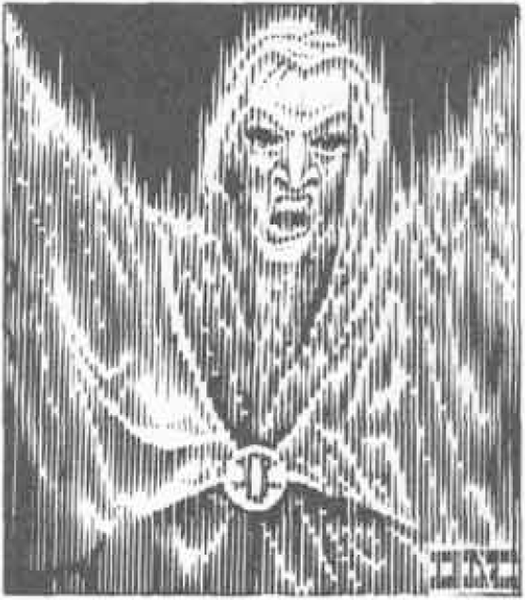
Save versus magic or be instantly killed by this bad omen.
In between the good and bad omens, dung for some reason gets a whole paragraph.
Omens posted:
Dung is said to have both good and bad properties. Objects or persons that are covered in dung reputedly cannot be touched or hurt by the undead. On the other hand, if even a small bit of dung is cast upon an altar consecrated to good, the altar is defiled and only evil can be contacted there. The forces of good must go to great lengths to resanctify such a tainted object.
The appearance of a rainbow, by the way, is a "definite statement from a deity. Its appearance means either that the deity wants to converse with a mortal, or that the deity wants the mortal to undertake a quest." So apparently in the D&D multiverse, every rainbow is a direct miracle specifically sent as a message from a god—at least according to this book, and no other D&D book ever. (One wonders how the mortals who see the rainbow know who the rainbow is specifically intended for, and what the quest is they're supposed to undertake. Perhaps D&D rainbows don't have a standard ROY G BIV order, but are color coded to signify their meaning.)

"Hm... blue red blue yellow purple green orange red. Welp, looks like Oghma wants Finn to go slay a hag."
MORTALITY AND IMMORTALITY
The last major section of the introduction is "Mortality and Immortality". This section begins by discussing the difference between souls and spirits—a technicality that existed in early editions of D&D, but was dropped from third edition on. Basically, only humans, dwarves, halflings, gnomes, and half-elves have souls; all other creatures that worship gods—including elves—have spirits. (Apparently creatures that don't worship gods don't have either souls or spirits, and are just gone when they die. Or they have some third, unspecified type of vital force (or anima, as the book calls souls and spirits collectively). Pneuma? Quintessence? And yes, we are given some brief guidelines for deciding whether or not a given type of creature worships deities.) Creatures with souls can be restored to life by a raise dead or resurrection spell; creatures with spirits cannot. (We are, however, assured that this system "is only a suggested one", and that "[i]ndividual Dungeon Masters should use a different system if they find this one unsuitable.")
Yes, that means in first and second edition elves could not be raised or resurrected. That part isn't actually new to this book; it was in the Player's Handbook—though that's another rule that I'm guessing was probably widely ignored. What is new to this book is the more detailed account of what happens to souls or spirits after death. Both souls and spirits go to an Outer Plane, usually the one where their deity resides, and more specifically to the part of that plane where the deity's influence is strongest. (Yes, there does seem to be an assumption throughout this book that every character will necessarily be devoted to a single god; characters who worship multiple gods or who don't bother worshiping any gods at all apparently don't exist.) The soul or spirit of a person who has not been perfectly faithful to his or her deity's tenets, however, may instead go to a different plane more in keeping with the character's true alignment. Once they get to their destination plane, souls are there for good; spirits, however, are eventually reincarnated and returned to the Prime Material Plane, though not necessarily as the same species as they used to be. The timing of the reincarnation is unpredictable: "It could range from as little as ten years to a millenium [sic] or more—time is not important to a deity."
(Speaking of reincarnation, it just occurred to me that the first- and second-edition reincarnate spell interacts weirdly with the soul/spirit distinction. The reincarnate spell could potentially bring back a dead human as an elf, or vice versa; does that mean the subject's soul was transformed into a spirit, or the reverse? Or does that result in a human with a spirit, or an elf with a soul? For that matter, the druid version of the spell could also bring back a dead human or elf as, say, a badger, or a raccoon (though I don't think any first-edition book ever had game statistics for raccoons); if badgers and raccoons don't normally worship gods, and hence don't have souls or spirits, is the soul or spirit of the reincarnated individual destroyed, or does he or she come back as a uniquely ensouled/enspirited badger or raccoon? Maybe these questions were addressed in a "Sage Advice" column somewhere, but if so I'm unaware of it.)
We're then given this parenthetical paragraph:
Mortality and Immortality posted:
(Note: The above is only a suggested method for dealing with character life-after-death. The DM may, of course, use whatever system is most appropriate to his or her campaign.)
Yes, we were already told a few paragraphs ago that this system was optional, but apparently the authors found that important enough to warrant reiterating. Okay, maybe the Editor's Introduction really meant what it said about everything in this book being guidelines, not rules after all.
Anyway, the soul or spirit is not instantaneously transported to an Outer Plane immediately upon a person's death. Rather, it has to travel through the Astral Plane, a process that takes 3-30 days. (At least, we're told that's the time "relative to those in the Prime Material Plane", but "time is meaningless to the soul or spirit". Which means... what, exactly? Does the soul or spirit experience it as instantaneous travel? Does the soul or spirit just have no idea at all how much time had passed?) This is why it's harder to bring people back with the raise dead spell the longer they'd been dead; the farther along they are in their travel to their destination plane, the farther they are from the Prime Material Plane. The resurrection spell works differently, though, and rather than calling back a soul in transit actually brings it back from the plane of its deity.
Mortality and Immortality posted:
As this involves the cooperation of the deity on the plane where the soul was, clerics must use extreme caution in employing this spell. If a cleric resurrects a being of radically different alignment, the cleric's deity (who gave the cleric this power) may be greatly offended. Similarly, if a cleric resurrects a being of different alignment simply to serve the purposes of the cleric or his or her deity (to extract information, for example), the deity on the plane where the soul was may be highly displeased and may take appropriate action.
So, wait, if resurrection requires the cooperation of the deity where the soul is, can't that deity just not cooperate if it doesn't want the person resurrected, rather than allowing it to happen and then getting all huffy about it afterward? Apparently not, I guess.
Two other notes about souls and spirits before moving on: First, we're told that the soul or spirit's journey through the Astral Plane can be dangerous because of the monsters that "roam the ethereal and astral planes at will" (why are the monsters that roam the Ethereal Plane relevant, if the soul is only traveling through the Astral?), and that this "is why burial chambers often include weapons, treasure, and even bodyguards to protect the soul on its journey." Second, we're told the following:
Mortality and Immortality posted:
The servants, functionaries, and minions of some deities (demons, devils, couatl, ki-rin, titans, and others) are actually spirits put into those forms for the purposes of the deity. It should be noted that the forms listed in the MONSTER MANUAL are by no means the only ones these servants can take — some chaotic deities rule planes where no two beings have the same form!
Which is another thing that was never really followed up on in later books, and in fact ends up being at least partly contradicted by them. Yes, we do later get details of how demons and devils are formed from the souls of the dead, but that seems to be a sort of quasi-natural process rather than an act of the gods, and there's no indication that couatls and ki-rin are formed similarly (and titans, at least, get an entirely different origin). Oh well.
We then get to what immortality means in D&D: basically, an immortal being doesn't age, but that doesn't mean it can't be killed. Whether a god appears old or young has nothing to do with the god's power level. Gods and their servants travel through the Astral Plane anchored by a "silver cord" similar to that of an astrally traveling mortal, except the god's silver cord is unbreakable. (The silver cord was another whole weird thing from early editions of D&D... I won't explain it now, but we'll get into it when we get to Appendix 1.) If the god or spirit is slain on another plane, the silver cord snaps it back to its home plane near-instantaneously and it's not destroyed, but it is weakened: even a greater god will need a few weeks of rest and recuperation, during which time any clerics of that god won't be able to recover any spells above second level. Any divine servant or even god is destroyed utterly if slain on its home plane, beyond even the power of the deities to restore. However, "[a]ll creatures are most powerful in their own territory", and it should be virtually impossible for a god to be killed on its home plane by anything other than another god.
The very last part of the introduction, a subsection under "Mortality and Immortality", deals with Divine Ascension. In other words, we get to find out how a mortal can become a god. Basically, there are four requirements for this to happen:
- The character must be significantly above the average experience level of "adventure-type characters" in the campaign. "(This includes all such non-player types as military leaders, royal magic-users, etc.)"
- The character must have had his or her ability scores somehow raised to be on par with those of the "lesser demigods"
- The character must have "a body of sincere worshipers"
- The character must "be and have been a faithful and true follower of his or her alignment and patron deity"
Mortality and Immortality posted:
This process of ascension usually involves a great glowing beam of light and celestial fanfare, or (in the case of those transmigrating to the lower planes), a blotting of the sun, thunder and lightning, and the disappearance of the character in a great smoky explosion.
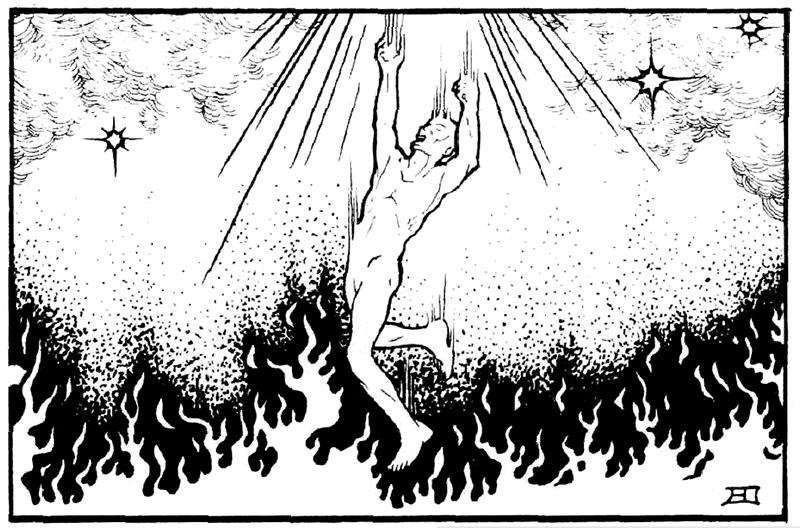
Although in this illustration it kind of looks like both are happening at once?
No description of what the process involves for characters that are neither good nor evil. (And yes, as we'll see, there are plenty of gods that are neither good nor evil, and there are Outer Planes corresponding to such alignments, so this does seem to be a significant oversight.)
Of course, a PC who ascends to divinity becomes an NPC. Still, I guess that's a better way for a character to retire than failing a saving throw against a giant centipede's poisonous bite.
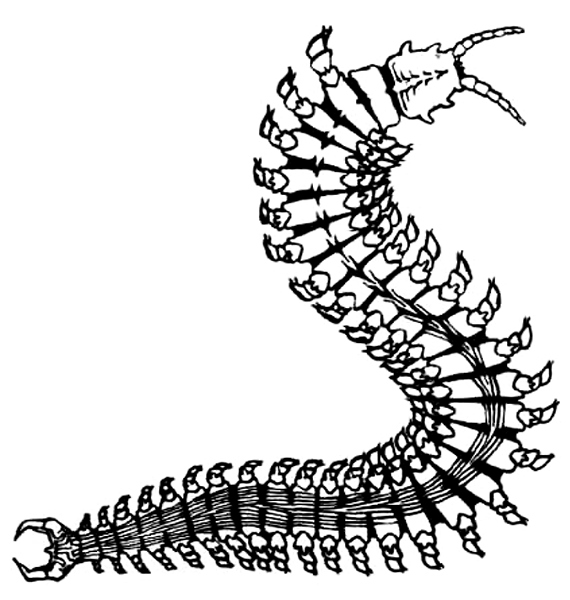
Save versus poison or be instantly killed by this common ¼-hit-die monster. (Okay, you get a +4 to your saving throw, but still...)
And that's that. Whew. Okay, I'm very glad to be through with all that introductory matter. Maybe I should have split it into more than one post, but honestly I'm just glad to get it done. Starting next post, we'll finally get into the actual pantheons.
Next time: Haida, Iroquois, Navajo... those are all basically the same thing, right?
Haida, Iroquois, Navajo... those are all basically the same thing, right?
Original SA post Deities & Demigods 1EPart 4: Haida, Iroquois, Navajo... those are all basically the same thing, right?
We start out with a bang, with one of the worst-handled "mythoi" in the entire book: the American Indian Mythos.

Or as the title seems to have it, the AMERICAN...indian mythos
As I've already mentioned, this is a grab-bag of figures and concepts from different Native American peoples, all jammed incoherently together. And we start out with a solemn reiteration of the standard cliché of Native Americans being close to the land:
American Indian Mythos posted:
The gods of the Indians of North America were as close to nature as their worshipers could make them. The natural world is the most important aspect of the Indians' existence. The gods will always prefer to appear in the form of a creature of the land. They can, if necessary, appear in human form, but such appearances require great energy and may only last a short time.
Please note that this last bit about the gods rarely taking human form is flatly contradicted in the descriptions of the gods themselves. Of the nine gods in this section, six are described as typically taking human form; a seventh doesn't have his form explicitly described but is depicted as humanoid in the illustration (and is said to use a shield and a bow or hand-axe, which would seem to be difficult for a four-legged animal). This leaves only two gods out of nine that "prefer to appear in the form of a creature of the land"—though they happen to be the first two gods listed.
The text goes on to tell us that "Indian" clerics wanting to control something must have a part of that thing already; that "the symbolism of a name is very important to the Indians", and that "[a]ll Indian rituals involving demons or devils require the use of a large fire for control of the creature." (Nothing further is said as to under what circumstances "Indians" would perform rituals involving demons or devils.) "Rituals revolve around the seasons", we are told, and "[f]ood, finely made jewelry, weapons used successfully in battle and the like are burned at these times for the good of the tribe in the upcoming season." This is all, frankly, pretty generic stuff—generic enough that I can't even say if it was based on the practices of a particular Native American people; it just seems like boilerplate priest-of-a-"primitive"-culture stuff. Clerics dress with magical symbols, which are "buried with the cleric in the event of his death"; young clerics go into battle while older clerics call upon the gods for aid... none of this is particularly interesting or evocative. At the end we finally get to some things that at least sound pop-culture-Native-American: we get a reference to "the warpaint of the warriors" (which, to be fair, really was fairly widespread among Native Americans, though obviously it had different meanings and details in different areas), and are told that "the tent or lodge of the cleric(s) is a place taboo to the rest of the tribe and supposedly guarded by strong spirits."
And then we get a couple of paragraphs about "sacred bundles", which in real life I think were mostly confined to some of the tribes of the Great Plains (and, apparently independently, in parts of Mesoamerica, but that's not covered in the "American Indian Mythos"—there's a separate chapter for the "Central American Mythos", which we'll get to later). This is... actually pretty flavorful, if not necessarily faithful to real Native American beliefs, and pretty blatantly overpowered. A warrior makes a sacred bundle with the help of a cleric and a summoned spirit, and it gives significant benefits: +2 on all saving throws, an armor class of 2 (equivalent in first-edition to Plate Mail +1), one point subtracted from every die of damage taken in battle, and the character has only a 1 in 6 chance of being surprised. The bundle contains 5 to 10 items, and... what the hey; I'll just quote the last paragraph:
Sacred Bundles posted:
There are always from 5 to 10 items in a bundle, and the summoned spirit chooses several of the items so that they are very dangerous to secure (thus proving the worthiness of the supplicant). Things like a rattle from a cave of giant snakes, a feather from a high nesting giant eagle, or the hair of 13 enemies killed in battle are the type of items that go into a sacred bundle. When all of the items have been acquired, the priest of the tribe must be brought; he will demand that the last offering placed in the bag be of his choosing. This thing is always something that the priest can use a part of for his own purposes.
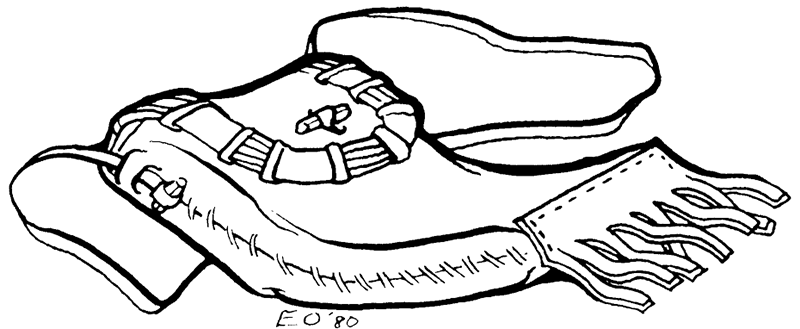
Wait... is that an "E.O." down at the bottom? Is this an Erol Otus drawing? Huh. Doesn't look like his usual style.
Now for the gods. In contrast to most of the pantheons, in which the gods primarily inhabit the Outer Planes, most of the "American Indian" gods make their homes in the Prime Material Plane. They're a mixed lot, though, and look pretty playable; all the alignments are represented among the gods except lawful neutral and neutral good. There's no information, however, about relationships between the gods, or how they interact with each other—which in one way is understandable, as the gods are drawn from several different traditions. The book does not specify which particular Native American culture each god is from, or in any way acknowledge that there is more than one Native American culture, but I've tried to track down the origins of each god and I'll state them as we go. (I am not, however, by any means an expert in Native American anthropology, and I may get some details wrong.)
RAVEN
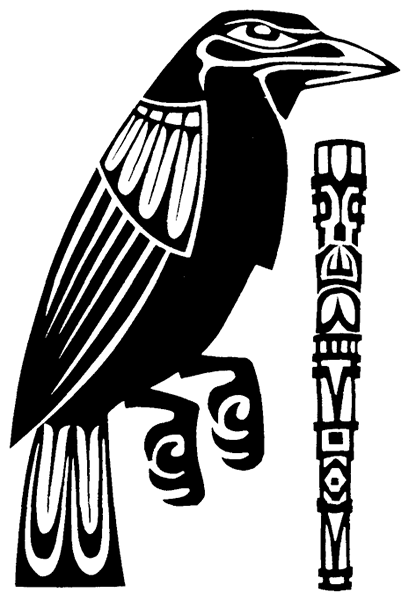
Ah, distinctly I remember, in the marshes of Marsember...
In most of the pantheons, the head of the pantheon comes first, and the rest of the gods are listed alphabetically. In the "American Indian Mythos", Raven is listed first, out of alphabetical order, implying that he's in some sense the head of the pantheon, though this isn't specifically addressed in the text.
Raven is chaotic good, though he is worshiped by people of all alignments, and makes his home in the Elemental Plane of Air for some reason. He's a 12th-level cleric, a 12th-level druid, a 10th-level ranger, a 16th-level magic-user, a 16th-level illusionist, and a 14th-level thief, and—in accordance with what's mentioned in the preface about the leaders of pantheons—he has 400 hit points, more than any other god in the pantheon (though Shakak, whom we'll get to later, is a close second with 390).
Raven is "the great transformer-trickster who is responsible for the creation/transformation of the world". His big thing is shapechanging—both himself and others. He can change his own shape to "appear in virtually any form he chooses", and can also transform others (who receive a −3 to their saving throws).
In actual Native American culture, Raven as a creator and trickster god was basically a thing of the Haida and Tlingit and other people of the Pacific Northwest. The art, too, looks vaguely inspired by those cultures, complete with a totem pole (also a thing specifically of the Pacific Northwest.).
COYOTE
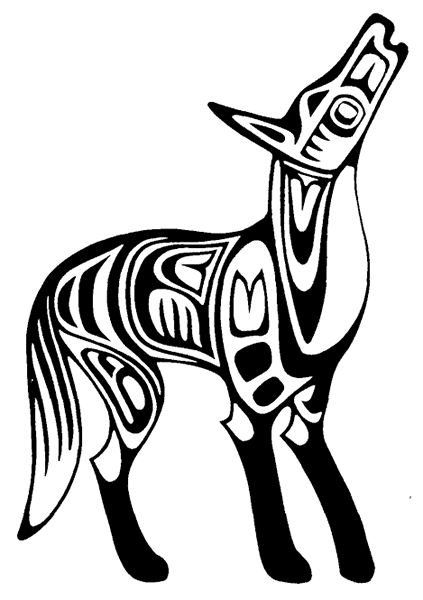
"Hello, Fire Head Girl!"
Of course Coyote is here, as possibly the most famous figure from Native American mythology. The trickster Coyote comes from the traditions of Native American peoples of the Plains and Southwest regions, but of course that doesn't prevent him from being crammed in here into the same "pantheon" with Raven from the Pacific Northwest and, as we'll later see, other entities from elsewhere in North America. He's a chaotic neutral 14th-level cleric/14th-level druid/15th-level fighter/14th-level magic-user/17th-level illusionist/18th-level thief, and after this I think I'm going to stop giving the class breakdowns of the gods unless there's something really interesting about them because seriously, they're usually like this.
"Although Coyote is responsible for teaching arts, crafts, and the use of light and fire, he is primarily a bullying, greedy trickster." (Which I think actually is pretty much how he was portrayed in a lot of the Native American myths, so fair enough.) He can also change his shape, but not as well as Raven; he can only change into different animals. He's largely worshiped by thieves.
HASTSELTSI
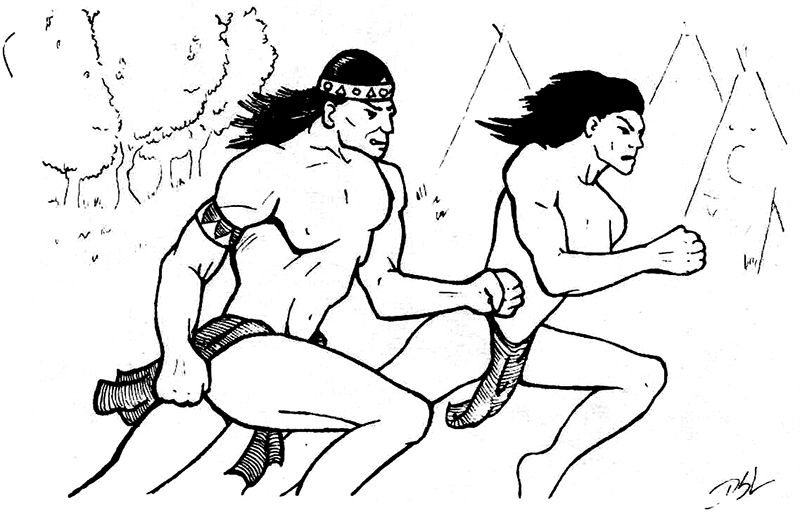
We can't have a chapter about Native Americans without teepees somewhere.
And now we toss in a god specifically from Navajo mythology, because why not. Actually, as we'll see, although this chapter draws from traditions from all over North America, the Navajo in particular get disproportionate representation.
Also known as the "Red Lord", Hastseltsi is a god of racing who appears as a man with all red equipment. (Exactly what equipment isn't specified.) He also has a giant maroon horse that "is enchanted so it will run faster than anything it is competing against."
quote:
When he enters a tribal area it is because he desires to race, with any person and in any way. He never shows his godlike abilities (always running iust a little faster than his opponent).
Which... seems like it would make for kind of a pointless encounter. There's nothing that says that he places any wager on the race, or that there's any consequence for losing, so basically I guess the PCs are just beat in a race by some guy wearing a red loincloth or whatever his "red equipment" is, and they never find out who he was, and nothing ever comes of it. I mean, sure, a creative enough DM could find a way to make something interesting out of this, but it certainly doesn't immediately lend itself to much. (And that's assuming he does beat the PCs... for all the emphasis on his divine abilities, Hastseltsi, unlike his horse, is not said to be enchanted to run faster than anything he is competing against, and his speed is twice the speed of a normal human, which is fast, but not insurmountably so; in first-edition he can be easily outrun by an eleventh-level monk. Granted, he can fly at twice the speed he can run (so four times human running speed), but if he flies during a race that might sort of qualify as "show[ing] his godlike abilities". (And even then, he'll lose to an eleventh-level monk under a haste spell.))
HASTSEZINI
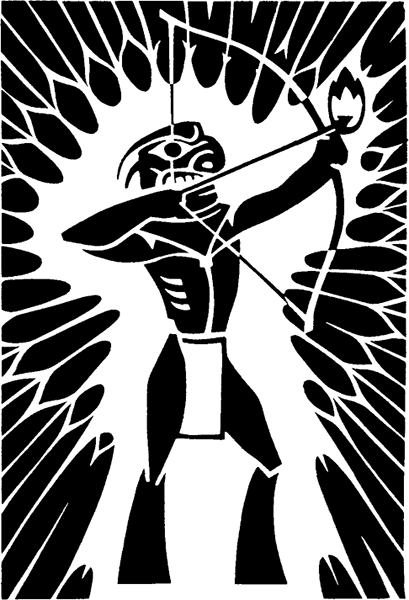
I kind of like the stylized art that some of the gods from this pantheon are given. As we saw with Hastseltsi, not all the gods are drawn this way, but we'll see one or two more that are.
Also known as the "Black Lord", Hastsezini is a lawful evil god of fire who makes his home on the Elemental Plane of Fire. "This being is jet black and extremely ugly," and "is very fond of destroying villages by fire if they do not make sacrifices to him." Most of his description is about his combat abilities, which is odd, because how likely is it that PCs are going to enter into combat with him? Wouldn't it be more useful to give information about his worshipers, or heck, his relationship to other gods in the pantheon?
This is another Navajo god, by the way, as you may have guessed from the similarity of the name to Hastseltsi's. Which I'm sure never had the potential to cause any confusion in play at all.
HENG
Heng comes originally from the traditions of the Huron, a Native American people who lived north of the Great Lakes. Heng's header actually says "HENG (thunder spirit)", but he's listed as a lesser god, so apparently he really is a full-fledged divinity. "This god is favored among all the Indian tribes because he can sometimes be relied upon to bring rain to those that suffer, and give luck to those that hurt." But only sometimes, I guess. His priests "sprinkle large quantities on the ground to attract his attention" when they need rain, and then he may or may not choose to answer the summons. The guy's lawful good... one would think he'd be a little more conscientious.
Oh... Heng lives on the Elemental Plane of Air. No word on whether he and Raven are roomies.
We don't get an illustration for Heng, but since he just "appear[s] as a braided warrior of the tribe that summoned him", I guess we're not missing much. That doesn't mean, by the way, that he just appears as some generic warrior; he apparently copies the form of a specific warrior of the tribe, and the warrior he copies "will have luck in battle for the whole year (in the form of a + 2 to hit enemies)."
HIAWATHA
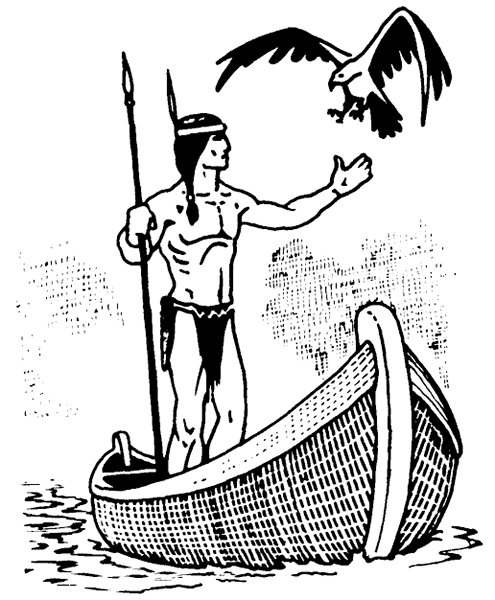
In his birch-canoe exulting / All alone went Hiawatha...
Hiawatha posted:
Possibly the greatest of all Indian heroes, this warrior can be found (with many other names) in many of the cultures of America. He is often depicted battling monsters and even gods on behalf of mankind.
Um... no, Hiawatha could not be found with many other names in many of the cultures of America. Hiawatha was not a mystical warrior who battled gods. Hiawatha was a real person. He was one of the founders of the Iroquois Confederacy, a semi-democratic union of several Native American nations that some scholars argue served as partial inspiration for the United States Constitution.
However, while the information here about Hiawatha is pretty much completely wrong, the authors of Deities & Demigods aren't the first ones to make that mistake. The Hiawatha in Deities & Demigods is almost certainly not based on the historical Hiawatha, but on the Hiawatha of Henry Wadsworth Longfellow's famous poem The Song of Hiawatha, which had nothing to do with the historical Hiawatha either. Rather, Longfellow's poem was rooted in the stories of a figure from Algonquin folklore variously called Manabozho, Tcakabesh, Wisakedjak, or Glusakabe, among other names. Longfellow had originally planned on using the name Manabozho for the protagonist of his poem, but he somehow got the confused idea that Hiawatha was yet "another name for the same personage," as he wrote in a journal entry, and decided to use that name instead.
At least you could argue that the Deities & Demigods portrayal of Hiawatha is more respectful than Walt Disney's Little Hiawatha cartoon, I guess. I mean, would you rather be remembered as a lawful good druid/paladin/ranger who "transcends the normal boundaries of tribal feuds in that he will help all people in trouble", or as a clumsy young boy whose pants keep falling down?
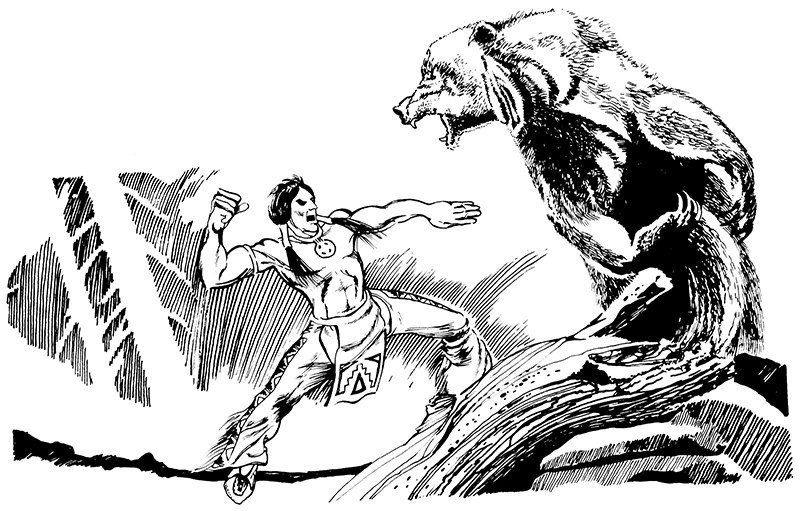
The text says Hiawatha "fought the great bear of death and won through hand-to-hand combat". So I guess that's what's happening here. We do not get statistics for the great bear of death.
HOTORU
A chaotic good wind god who casts lightning bolts in combat, Hotoru has a couple of things in common with Heng. First, despite his good alignment, he apparently only sometimes decides to help people out by giving them good weather or making their crops grow. Second, he doesn't have an illustration, but that's okay because he just takes the form of some nearby mortal anyway—though in his case it's "the form of the chief of any village that he is near", rather than a warrior of the tribe.
Despite these similarities in their presentations, Hotoru does not have the same origin as Heng—Hotoru comes from the traditions of the Pawnee, a Native American people from Oklahoma and its surroundings.
QAGWAAZ
Like Hiawatha, Qagwaaz is not a god, but a powerful hero associated with the pantheon; he's a neutral good ranger/bard who enjoys "chasing and capturing horses and buffalo on the plains for sport, and entering villages to test his strength against the best warriors there." And... I'm not really sure where he comes from. Apparently, neither is anyone else; I found a whole thread on EN World about the topic. (Well, about the gods from the "American Indian" pantheon from Deities & Demigods in general, but the title of the thread was "Deities & Demigods: American Indian Mythos (or, Who the Heck is Qagwaaz?)", so it seems they found this hero particularly troubling.) There is a Qagwaai, or Qagwaay, from Haida stories, but he seems to have little in common with the Qagwaaz of Deities & Demigods beyond the name—not to mention the fact that Qagwaaz is supposed to be a "hero of the plains", and the Haida are a people of the Pacific Northwest, nowhere near the plains. Still, I can't find any better leads, so my best guess is that Qagwaaz did ultimately come from Qagwaai, though he seems to have been changed quite a bit along the way. Perhaps the authors ran across the name but no further information, and just invented their own details.
SHAKAK
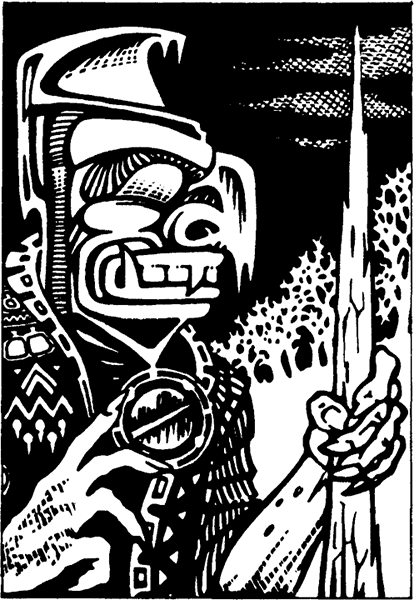
"Ice to meet you. Ha ha ha. Shut up I am so the first person to ever say that."
Shakak is a white-skinned, chaotic evil deity who has a human form with a demonic face. People sacrifice to Shakak by burning valuable items to propitiate him so he'll make the winter less harsh, "but no one prays to this evil being for fear that he will come." Like Heng, he's parenthetically referred to as a spirit ("SHAKAK (winter spirit)"), but he's listed as a greater god. Apparently the writers decided that "American Indians" referred to (at least some) gods as spirits, which... yeah, okay, I guess that's not surprising.
Shakak is a spirit of winter from the folklore of the Acoma Pueblo of New Mexico, opposed to Miochin, the spirit of summer, who does not appear in this book because apparently the authors just threw together figures from various Native American traditions at random.
SNAKE-MAN
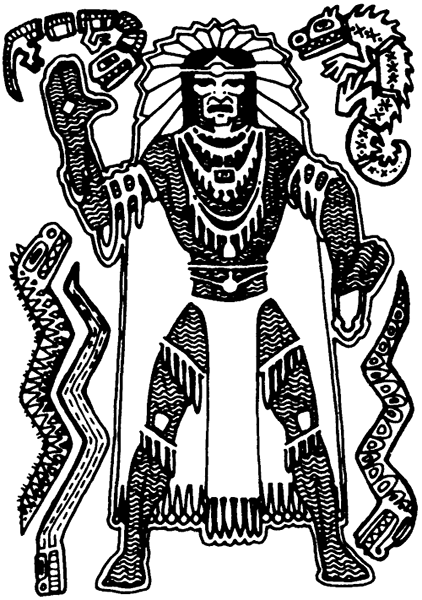
Bitten by a radioactive snake... wait, I may be thinking of someone else.
Snake-Man is a chaotic good god of reptiles, I guess. No reptilian creatures will attack him, including "fantastic reptilian beings such as certain devils, demons, dragons, and the like." He never fights physically; he either uses magic or summons snakes to fight for him—he "can summon 5-500 random types of snakes to serve him (once per day)." (So... if he summons 5-500 random types of snakes, does that mean just one snake of each type? Or if not, how many snakes does he summon, in all? One would think that might be more important than the number of types.) He also "ages at will, and often visibly turns younger or older in long conversations with other beings", and I'm not sure exactly how or if that's supposed to tie into the whole reptile theme.
Snake-Man "appears in the shape of a man with rainbow-colored skin", and "always wears 75,000 gold pieces worth of jewelry". (Always exactly 75,000 gold pieces worth?)
Traditions of some sort of "Snake-Man" existed among many Native American peoples, including the Blackfoot, the Hopi, and others, and none of them quite match the Snake-Man in Deities & Demigods, but if I had to guess, I suspect it was inspired by the divine Snake-Man, or Tł'iish Hastiin, from Navajo mythology, though I've been able to find very little information about this deity online or in any books I have and really I've spent way too much time on this already and ought to just move on.
STONERIBS
quote:
This hero is famed for his great strength and will wander from tribe to tribe and fight the best each tribe has. Sometimes he will lose, and when this happens he will stay with the tribe for one year and fight in their battles.
Also, he has "a cloak that enables him to turn into a halibut at will."
Stoneribs comes from Haida tradition, where he is most famous for killing a great sea monster and wearing its skin. That sea monster's name? Qagwaai. Remember how I said the Qagwaaz from Deities & Demigods seems to have little in common with the Qagwaai from Haida mythology except the name? Yeah. (To be fair, in some versions of the story Stoneribs assumed the sea monster's name after killing it, so I guess in a way there was a hero named Qagwaai, but he still... was nowhere near the plains, among other things.)
The turning into a halibut is straight out of the original stories, by the way, except that there he does it by somehow putting on a halibut skin instead of a "cloak".
Stoneribs is a lawful good 10th-level ranger, making him one of the few characters from this book (and the only one from this chapter) to stick to a single character class.
THUNDER BIRD
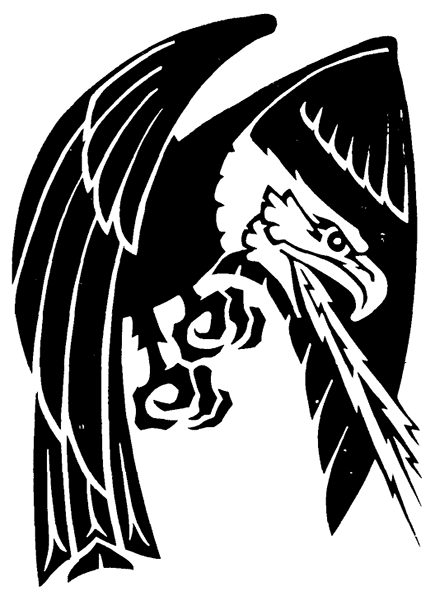
Thunder bird is go!
Yes, in addition to gods and mortal heroes, this book does, as the Editor's Introduction mentioned, "include some monsters" related to the various pantheons. The thunder bird is the only monster in this chapter, and its Frequency is given as "Unique", so it's a one-of-a-kind entity, not a species of which multiple individuals exist. It can cast thunderbolts and is never surprised, though I'm not sure why you'd want to fight it anyway, since it's chaotic good and it "warns of great disaster and is often found fighting evil creatures of great power that have been summoned by the enemies of good tribes." The thunder bird has been killed several times in the past, but it's always come back. No method is given of preventing its return from death, though again, there doesn't seem to be any real reason a PC would want to.
Thunderbirds were one of the few mythological motifs that actually were fairly widespread among Native American cultures; they're particularly prominent in the Pacific Northwest, but also appear in the traditions of various peoples of other areas as well.
TOBADZISTSINI
Tobadzistsini is another god who comes from Navajo myth, and another god who's referred to as a "spirit" ("TOBADZISTSINI (war spirit)"). In the original Navajo accounts, he was the younger twin brother of Nayenezgani, Slayer of Alien Gods, who was at least as important as Tobadzistsini in Najavo mythology but who does not appear in Deities & Demigods. Also, in the original Navajo accounts, Nayenezgani and Tobadzistsini were heroes who slew terrible evil spirits, but in Deities & Demigods for some reason Tobadzistsini is neutral evil. He "usually appears as a massively built male", and likes to butt into battles between tribes.
YANAULUHA
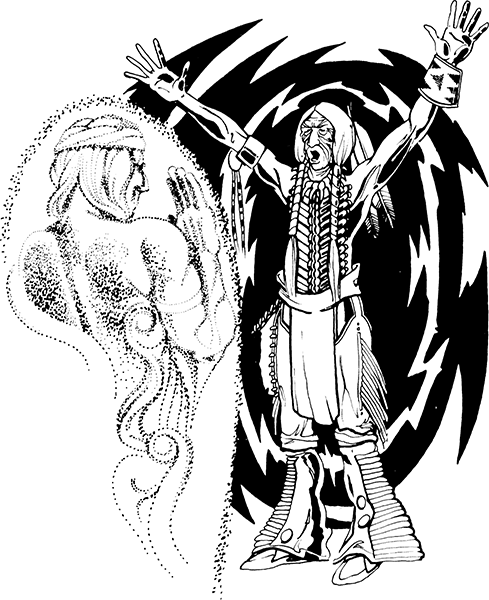
"I suppose you're wondering why I've called you here today..."
quote:
Yanauluha was the first of all tribal clerics, and he is able to summon any spirit (god) of this pantheon to his people. The priest is now classified as a friendly spirit and is invoked by Indian priests whenever they need an especially large boon from the gods.
So... Yanauluha is not a god, but he's a useful go-between to communicate with the gods. So... kind of like a Catholic saint, I guess? He's not all that hard to summon, either; any sacrifice of magic items gives him a 10% chance of appearing, and it seems if it doesn't work the first time there's nothing stopping you from sacrificing another magic item and trying again. (There's nothing specifying how valuable the magic items had to be, either, so apparently you can summon him by sacrificing first-level scrolls or potions of delusion—though granted magic items in general were harder to come by in first edition than they became in some later editions.)
Yanauluha "appears as an old man in rich Indian garb and talks very slowly." I like the "talks very slowly" bit—the DM actually gets some information on how to role-play him.
Oh—I almost forgot. Yanauluha comes from the mythology of the Zuni, a Pueblo people who lived in what's now eastern Arizona and western New Mexico. (Well, still live there, in fact, though in a much smaller area than they used to, and now mostly just in New Mexico.)
Okay, that's it for the "American Indian Mythos". This may not have been handled as well as it could have been, but it's mostly uphill from here. Sort of.
Next time: Fuck You, Mordred
Fuck You, Mordred
Original SA post Deities & Demigods 1EPart 5: Fuck You, Mordred

I'm not sure why there's a period. I don't think "Arthurian Heroes" is a complete sentence.
So here we get a section on the characters of the Arthurian legends. As a child, I found this the most boring chapter of the book, and I guess really I still do. There are no gods or monsters, mostly just a bunch of samey knights, and they don't even get much flavor text; not counting King Arthur himself, only two of the knights get more than five or six lines of description. Also, despite their common association with a fantastical version of medieval Europe, I'm not sure how well Arthurian legend really fits Dungeons & Dragons. The chapter includes a drawing of King Arthur chasing a D&D troll, and, I don't know, to me it just looks sort of weird and out of place.
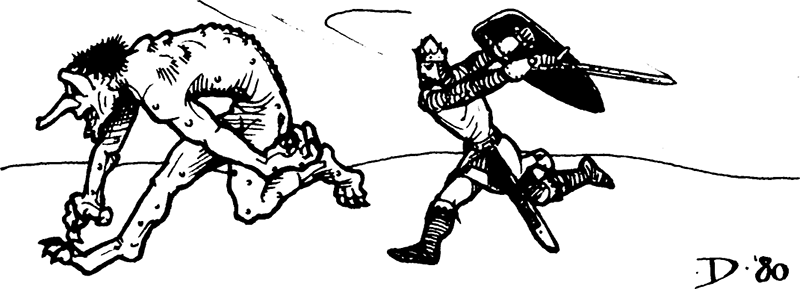
Also, it kind of makes me sympathize with the troll.
At least the text does sort of acknowledge its possibly ill-fitting nature:
Arthurian Heroes posted:
The knights of the Round Table may not fit into some AD&D worlds, but DMs may find it interesting to spice up their campaign with a trip to Arthur's Britain. More useful information can be found in TSR's KNIGHTS OF CAMELOT™ Fantasy Boardgame.
After a couple paragraphs of introduction, the first two entries on this page are for "The Average Knight of Renown" and the "Knight of Quality". These are general statistics, intended to be varied for individual characters. Average Knights of Renown are fighters of 8th through 10th level, with variable hit points "but never less than 60", and ability scores that "may never be below 10, and most average 15." Their alignment is "Variable (but 80% lawful)". Knights of Quality are fighters of 10th through 13th level, with variable hit points "but never less than 70", and ability scores that "may never be below 13, and most average about 16." Honestly, so many of the statistics are left as variables that these statblocks are pretty useless; it would have made more sense just to say that Knights of Renown are fighters of levels 8-10 and Knights of Quality are fighters of levels 10-13, and left it at that without having to fill space with mostly empty statblocks.
One interesting point in the description of these knights is that apparently 5% of Knights of Renown have squires who are better at fighting than the knights they serve. Also, Knights of Renown "will most often kill their defeated opponents, rather than grant mercy," while Knights of Quality "will usually (75% of the time) grant mercy to all those who ask for it during battle." Make of that what you will.
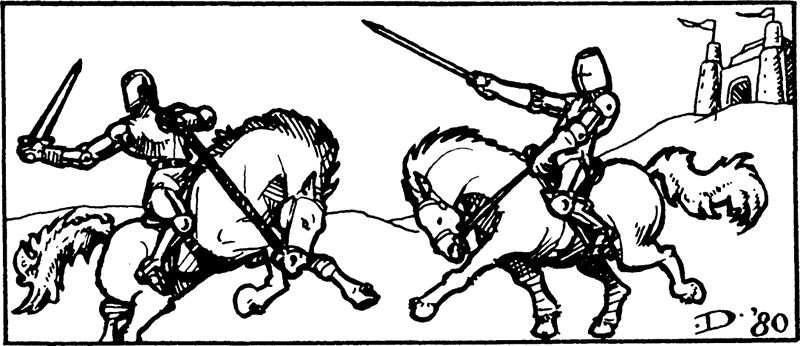
Is that horse on the right floating?
After that we get a long list of ninety "good or neutral knights of the Arthurian legends"—sixty-four Knights of Renown and twenty-six Knights of Quality (marked with asterisks). We are given no information about these knights beyond their names and in a few cases very brief parenthetical notes ("brother of Gawaine", "knight of the black lawns", etc.) After this, we get a similar but much shorter list of thirteen knights who "are evil through and through": nine Knights of Renown and four Knights of Quality. (None of these even get parenthetical notes.) These lists may be useful for someone already familiar with Arthurian legends who just needs a reminder about the characters, or for someone who needs to make up an Arthurian knight but is very bad at coming up with names. They're pretty much useless for anyone else. Fun fact: King Arthur's court jester, Dagonet, was apparently a Knight of Renown. Also, Mordred, one of the most famous and significant figures of the Arthurian legends, apparently wasn't deemed important enough to get his own full write-up, and instead is just listed without comment among the evil knights. At least he's a Knight of Quality.
This done, we get to those personages who, unlike poor Mordred, do get their own full entries, starting, of course, with King Arthur. He's a lawful good 14th-level paladin/5th-level bard with an 18 in every ability score except Wisdom, which is 19, and Dexterity, which is only 16. (Also, his Strength is listed as 18(52), because first edition had this weird "percentile strength" thing which, if you don't already know about it, isn't worth explaining.) Despite being the most important figure in the Arthurian Mythos, King Arthur is not, of course, the divine head of a pantheon, and thus does not get 400 hit points, having to settle for a measly 123.
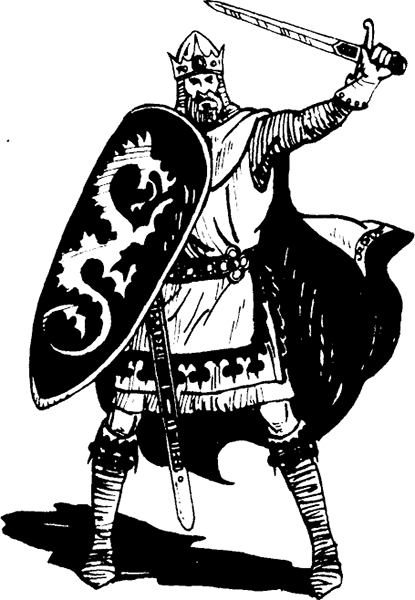
He didn't have that cape in the other picture. I guess he takes it off for troll-chasing.
We get a brief summary of Arthur's history—you know, the sword in the stone and all that—and are told that he "upholds the idea of lawful righteousness and fair play." Also, Excalibur is a +5 lawful good sword of sharpness, and its scabbard is also magical and prevents him from being cut by any attack.
Huh, come to think of it, you know who else doesn't get her own statblock, besides Mordred? Gwynevere. (Yes, that's the way the name of Arthur's wife is spelled here.) She's mentioned once in Arthur's description, but that's it; we're given no game information about her, not even her alignment. One would think the queen of the realm would warrant more than a single namedrop, but apparently not.
SIR BERNLAD DE HAUTDESERT (the magical green knight)
If you're familiar with the Arthurian story of Sir Gawain and the Green Knight, you might expect the Green Knight to be some magical being, probably a fairy of some sort. Nope. He's just a chaotic good fourteenth-level fighter who has magic armor that prevents him from being hurt by physical weapons. Also he has a +3 axe. So he's a really well-equipped fourteenth-level fighter, but that's still all he is.
By the way, the earlier listing of Knights of Quality also lists a different Green Knight, "Pertelope". No other information is given. It turns out Sir Pertelope does appear in what's apparently the primary source for this chapter, Sir Thomas Malory's Le Morte d'Arthur, where he's the brother of Sir Persaunt the Blue Knight and Sir Perimones the Red Knight, but that's not mentioned in Deities & Demigods—that is, Sir Persaunt and Sir Perimones are both listed too, but there's no indication that the three are brothers. But anyway, if Sir Bernlad de Hautdesert and Sir Pertelope are both Green Knights, then sure, they can each be a Green Knight, but could either one of them really be called the Green Knight?
SIR GALAHAD
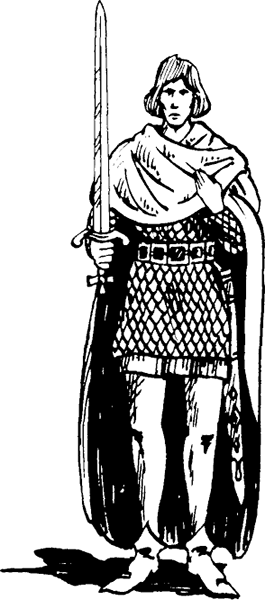
I'm no historian, but was it normal to wear armor on the torso and leave the legs completely unprotected?
He's a 20th-level paladin, he's the bastard son of Sir Launcelot, and he successfully completed the Quest for the Holy Grail, and he has 18s in all his statistics except Intelligence, which is 15. And there's really nothing else interesting to say about him.
SIR GARETH OF ORKNEY (knight of the many colors)
He's called the knight of the many colors because of "the many colors he used on his armor and shield". "He was the most modest of all the knights", and really I guess there's no reason for him not to be modest, because he's a pretty ordinary neutral good seventeenth-level fighter. With, admittedly, pretty good ability scores, but not as good as Sir Galahad's.
SIR GARLON (the invisible knight)
Sir Garlon was given a special power "by a witch of the fens for the promise to only use the power for evil". Can you guess what the power was? Aside from that, really the only thing noteworthy about him is that he's one of the few knights in this chapter who's not just a single-classed fighter or paladin. He's a 13th-level fighter/3rd-level thief. Oh, and he's chaotic evil.
SIR GAWAINE
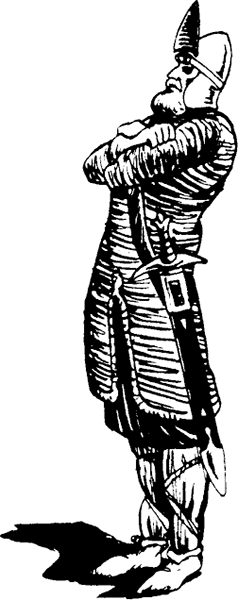
Sir Gawaine's had enough of your shit.
Sir Gawaine posted:
Gawaine has been given a magical gift of an unusual nature. From 9 in the morning till 12 noon, he gains in strength. From 9-10 he has a 19 strength; from 10: 11 he has a 20 strength; and from 11-12 his strength is 21. After 12 his strength returns to normal.
Well, that's weird, and kind of pointless. Okay, apparently this is actually a thing in Malory's Le Morte d'Arthur, but it's still weird. (Also, why the passive voice? He "has been given a magical gift"? By whom? The Dungeon Master?)
Sir Gawaine is true neutral, and is "a revengeful knight [who] would travel to the ends of the earth to right some supposed wrong done to him or his family."
SIR LAMORAK
Sir Lamorak is a neutral 15th-level fighter, and there's nothing special about him (except maybe for the fact that he has really good ability scores), and I don't know why he needs his own entry and isn't just listed among the Knights of Quality. Oh. Right. Those only go to thirteenth level. Okay then, I guess.
SIR LAUNCELOT DU LAKE
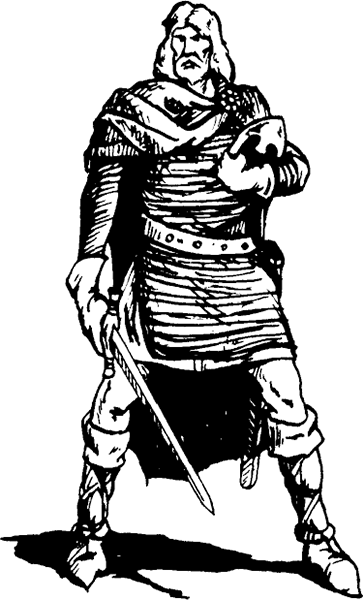
Also known as "The Knight of the Mullet".
You probably know who this is; he's the most famous figure from Arthurian legend next to King Arthur himself. Here, he's a 20th-level paladin, or I guess maybe he's not, because while his stat block says he is his description says that he "was able to use all the powers of a Paladin, until he fell from grace". We get a little information about how he fell from grace and what he did afterward, but there's nothing really interesting. His lowest ability score is Wisdom, which... yeah, that tracks.
MERLIN
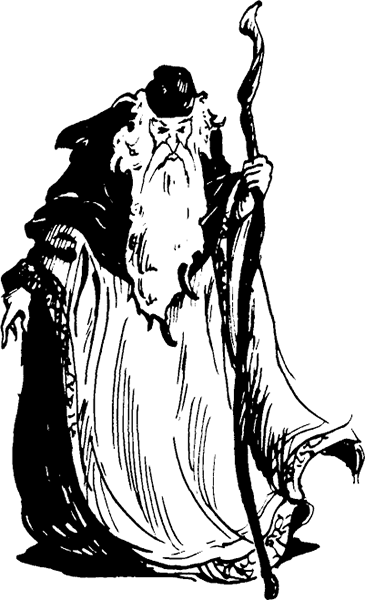
"Higitus figitus migitus mum..."
Merlin posted:
The son of a sorceress and an incubus (a succubus shape-changed into male form), Merlin has a combination of powers and abilities for beyond those of mortals. There is a great deal of evidence to support the concept that Merlin is a being as powerful as the Great Druid with magical powers thrown in.
That evidence being his stat block, which lists him as a 14th-level druid/15th-level magic-user/10th-level illusionist. The Great Druid, in first edition, was a 14th-level druid, the highest level listed for druids in the Player's Handbook. Or rather, the Great Druid was the 14th-level druid. That is to say, in any given campaign world, there existed only one 14th-level druid, and that individual was called the Great Druid; any PC wanting to advance to 14th level would have to defeat the incumbent Great Druid in combat in order to do so. Although before doing that, the PC in question would have to have defeated one of the nine existing capital-D Druids to advance to 12th level, and one of the three Archdruids to advance to 13th. There was a similar deal for monks—apparently there could only ever exist three 8th-level monks, and only one for each level above that!—and for assassins—to reach 14th level an assassin would have to seek out and challenge or assassinate the local Guildmaster Assassin, and to reach 15th the character would have to do the same to the unique Grandfather of Assassins. Yeah, this was another of those weird things in first edition that many DMs may have just ignored... assuming the PCs in their campaigns ever reached those levels in the first place.
(All of which means, I guess, that that bit in the review of the previous chapter where I mentioned that Hastseltsi could be outrun by any eleventh-level monk maybe isn't that big a deal after all, if there are only seven monks of that level or higher (the 1E level progression for monks ends at level 17) in the entire world.)
And yes, the succubus was a thing in first edition (unlike in fifth edition, in first (and second and third) edition the succubus was explicitly a type of demon, and in fourth edition for some reason it was a devil), but the incubus wasn't (at least, not in any of the books, though an incubus did appear in Dragon Magazine issue 54—though that didn't come out till the year after Deities & Demigods was first published). So because Malory said Merlin was the son of an incubus they had to write in an explanation of just what an incubus was in D&D. (Which did not match what Dragon #54 would say an incubus was the following year, but oh well.)
Merlin posted:
Merlin can foresee the future in a random manner. There are times when his inability to see what lies just ahead in the future causes him great problems... He is a very earthy being and a pretty face may cause him to act rather boyish in order to impress a lady.
MORGAN LE FAY
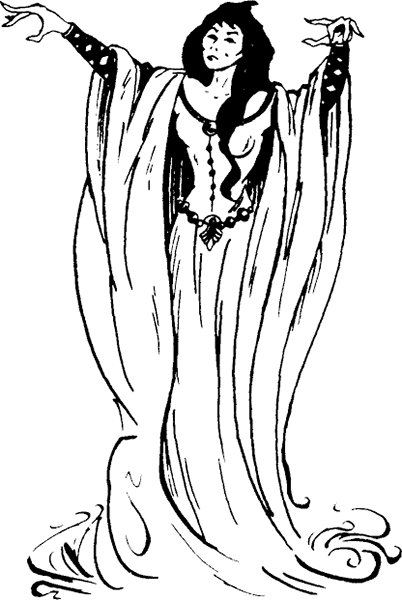
She's either casting a spell or conducting an orchestra. I'm not sure which.
Morgan Le Fay is a chaotic evil 12th-level magic-user/12th-level illusionist who "is at least partially nonhuman". (Thanks for being so specific.)
...By the way, something just struck me about the "American Indian Mythos" from the previous post. Among all the gods and heroes presented there, every single one is male; there's not a single goddess or female hero. This isn't especially relevant to the "Arthurian Heroes" chapter (well, except insofar as it has almost as extreme a gender imbalance, with only a single statted female character), but it's something I thought was worth mentioning. I should have noticed it earlier. Hmm. I guess that shouldn't be a surprise, though I admit I have been pleasantly surprised at the consistent use of "he or she" in this book to refer to players and Dungeon Masters. I mean, that's not a big thing, but it's a better nod toward representation than I was expecting from a first-edition book, especially considering some of the disturbingly sexist material that appeared in early issues of Dragon Magazine. (And, briefly checking the first-edition Player's Handbook and Dungeon Master's Guide, I see that they... actually mostly do that too. In the foreword to the Player's Handbook, TSR Games & Rules Editor Mike Carr refers to the Dungeon Master only with masculine pronouns, but the rest of the book does seem to use "he or she" pretty consistently for both players and DMs. The same goes for the Dungeon Master's Guide; players and Dungeon Masters are routinely referred to as "he or she". (Though it's certainly possible there were some slips that I missed in either or both books; I only gave them a quick glance.) So, well, that's nice. I mean, obviously it doesn't come close to meaning there's nothing sexist in first-edition D&D, but at least it's one small step in the right direction that I hadn't remembered.)
SIR PALOMIDES THE SARACEN
The only things worth mentioning about Sir Palomides are that he's another knight who's not just a single-classed fighter or paladin (bizarrely, he's a 16th-level fighter/3rd-level monk/3rd-level bard), and that he's "noted for his use of the composite bow (a weapon not usually used by knights of any order)."
KING PELLINORE
King Pellinore is a lawful neutral 12th-level fighter who's entirely unexceptional, except again for his high ability scores (for ordinary humans, the knights in this chapter seem to have an awful lot of 18s in their abilities), and that he "hunts a strange unique creature, the Questing Beast, which his family is fated to pursue, though neither they nor anybody else will ever catch it."
We do not get statistics for the Questing Beast. We do, however, get an illustration of it.
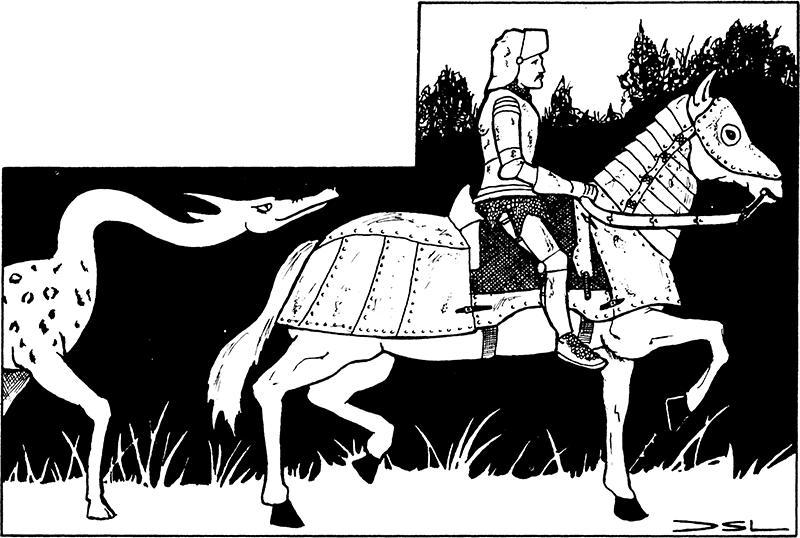
At least, I'm assuming that's what this is supposed to be.
Actually, we do get statistics for the Questing Beast in the 2E Legends & Lore. In fact, I think there are enough interesting things to compare and contrast between the two books that I've decided I want to review Legends & Lore, too. (Not right away, though; I still intend to cover the 1E Manual of the Planes next.)
Yes, I know I started this review by saying I was going to cover Planescape, and I still do intend to do that; I just have these precursors I want to get through first, because I think they give some useful insight on Planescape's origins. At least the next book, the Manual of the Planes, is maybe a little more directly and obviously Planescape-related. Still, I'll get to Planescape proper eventually...
SIR TRISTRAM OF LYONESS
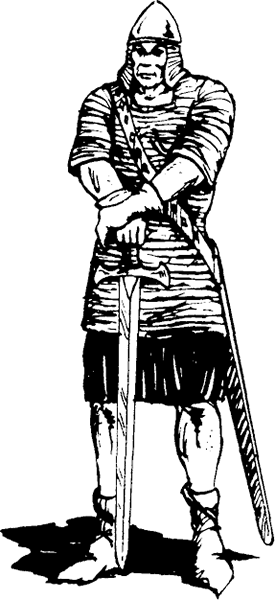
Seen here carefully suspending the point of his sword two inches above the ground for some reason.
He's a neutral 17th-level fighter who is not remotely interesting in any way whatsoever and is only here so we can get a very brief one-paragraph summary of the tragic story of Tristram and Isolde. (Isolde, of course, doesn't get a statblock.) Or the beginning of the tragic story of Tristram and Isolde; apparently we're to assume that the ending hasn't happened yet. Can the PCs step in and prevent events from unfolding as they did in the original story? Maybe. Is there something more exciting they could be doing instead? Almost certainly.
So there we have it. The most boring chapter of the book, mostly devoted to a bunch of bland fighters. I said in the last post that it was mostly uphill from there, but... well, it's mostly uphill from here in a different sense.
NEXT: Everything is Demons
Edited because I realized I misspelled Sir Tristram's name. Or... spelled it in a different way than it was spelled in the book, though I think both are acceptable variants.
Everything is Demons
Original SA post Deities & Demigods 1EPart 6: Everything is Demons

I can't say the writing style of the logo screams "Babylonian" to me, but I don't know what would. Maybe cuneiform?
Ah, here we get to a pantheon I did make heavy use of in my own campaigns. Well... not the whole pantheon. Just one god. I'll point him out when we get to him.
(Not that I didn't make any use of the other pantheons. I don't think I ever used anything from the Arthurian Heroes section, but I did have a country in my homebrew campaign world that was Native-American-flavored, and where the gods of the "American Indian Mythos" were worshiped. Or at least, I guess they presumably would have been, though I don't think any PCs ever visited that country in any campaigns I ran, so the matter never really came up.)
For some reason, the authors choose in this chapter to go on at some length as to how hard it was to research this pantheon, and, well, I'll just quote this part:
Babylonian Mythos posted:
The origins of Babylonian mythology are extremely ancient. Because of this, misconceptions, duality among the gods and goddesses, and similarities between their deities and those of other pantheons exist. In formulating this list for your use, we have consulted many sources, and some of these conflict with each other. This version is designed to be close to historically accurate and still playable in AD&D terms.
(NOTE: If you wish to look hard enough, we are sure that you will find many points of disagreement with certain historical sources. This is unavoidable, when so many sources conflict.)
Really, most of that could be said of any of the historical pantheons. Contradictions, duality among the gods and goddesses, and similarities with deities of other pantheons exist aplenty in the Egyptian, Greek, and Norse pantheons as well. Regardless, though, I like the fact that this pantheon is here at all; ancient Mesopotamia typically gets short shrift in fantasy worlds compared to more familiar places like Greece and Egypt. In fact, the ancient Mesopotamians get not one, but two pantheons in this book... as we'll see later, there's a Sumerian Mythos as well. On the one hand, this makes sense; as much as people sometimes talk about "Mesopotamian mythology" and "Mesopotamian culture", Mesopotamia is a place, not a specific civilization, and there are a number of distinct civilizations that existed there at different times (Babylonia and Sumer, yes, and also Akkadia, Assyria, Chaldea... and of course modern Iraq and its neighbors). On the other hand, they just got done two chapters ago trying to shoehorn all of pre-Columbian North America into a single pantheon, and as we'll soon see they also have a single "Central American Mythos" rather than having distinct pantheons for the Aztecs, Maya, and Olmec. So the separate treatment of the Babylonian and Sumerian Mythoi certainly isn't wrong or unjustified, but it is a bit... inconsistent with their treatments of other areas. Anyway, I'll revisit this point when we get to the Sumerian Mythos, where the authors do address their reasoning for separating the mythoi. Sort of. Not really.
We start with our requisite few-paragraph overview of the pantheon. The high priest is usually also the ruler of the country, and "must be a combination magic-user/cleric of great power". Which... raises a big question right there, since in first edition the only way for a human character to have more than one class (and the priest-king definitely must be human, for reasons we'll see shortly) is to "dual class", starting as one class and then switching into another. So... did the priest-king reach a high level as a magic-user, and then switch over to devote himself to clerical pursuits late in life? Or did he first level up as a cleric, and then take considerable time off from his clerical progression to learn the way of the magic-user? Either way it seems odd. Maybe the priest-king is supposed to be a rare exception to the usual dual-classing rules, but the book doesn't say that.
Anyway, clerics of the Babylonian Mythos "remain aloof from the normal populace in temples and shrines", but apparently they go on quests together—even the priest-king—to "bring back riches (usually through conquest) to further the sect". They seem, in fact, overall to be rather a mercenary lot; the book says they also advance "through the payment of gold to the high priest's court." Successful priests may be "given great (and highly dangerous) quests to prove their worthiness to stand by the King." All Babylonian clerics wear white kilts with red cuneiform writing on the hem.
We get a whole paragraph about the harshness of punishment for clerics who fail in their duties. Clerics who violate minor laws may be required to fast, meditate, and sacrifice animals and gold or precious jewels. Those who violate major laws are excommunicated and denied all spell use (apparently even the first- and second-level spells that we were told in the introductory text come directly through the clerics' faith and aren't granted by deities), unless they agree to go on major quests to help the faith. Such violations of major laws include "helping enemies of the sect", "dealing with humans of the opposite alignment", and... "communicating with intelligent creatures or demi-humans (all of whom are considered 'demons') other than humans".
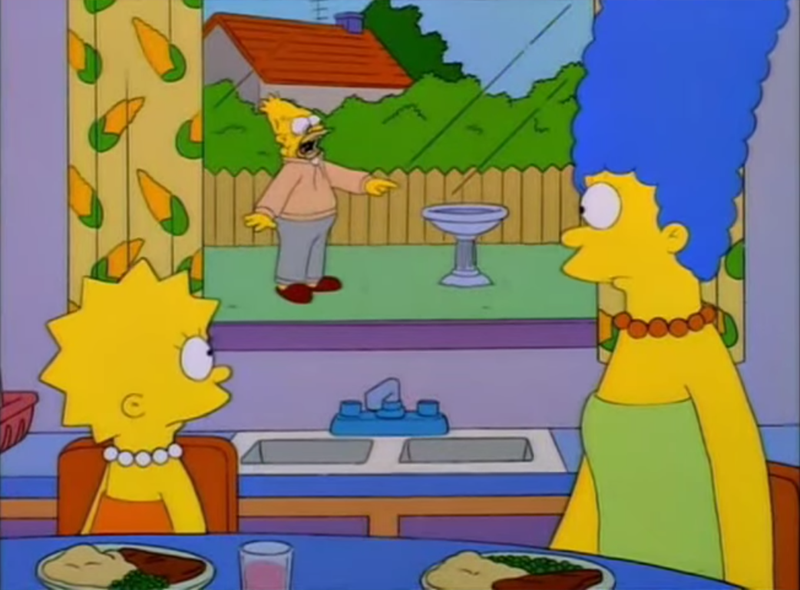
"Deeemooon!"
So... the entire pantheon is fantasy-racist.
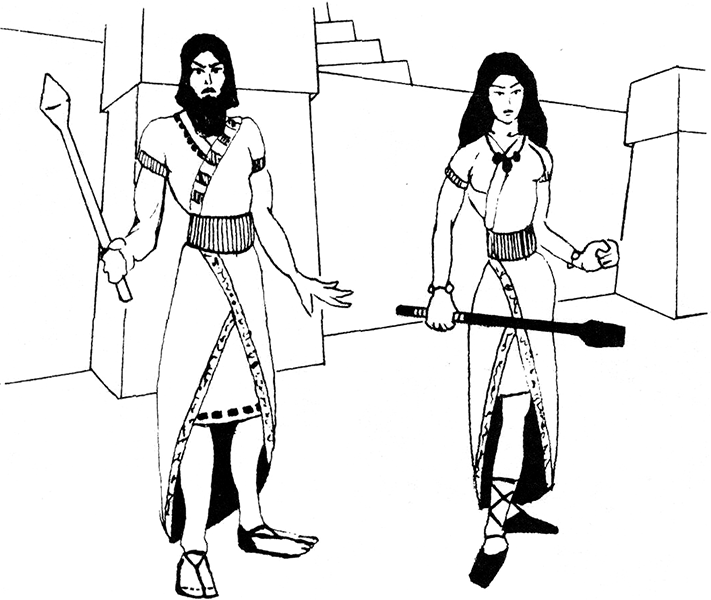
"Didn't you see the sign? 'No nonhumans need apply.'"
Anyway, let's get to the gods.
ANU (god of the sky) "Chief of all the Babylonian Deities"
The head of the pantheon is Anu, lawful neutral god of the sky, who makes his home in Nirvana (the plane of lawful neutrality, later renamed Mechanus). All we're told about his appearance is that "[t]his god appears as a man." Um... any particular kind of man? Always the same man, or does he vary his appearance? It doesn't say.
Okay, we do get an illustration, so I guess that may answer the question of what he looks like, though it doesn't answer the question of whether he always looks like that.
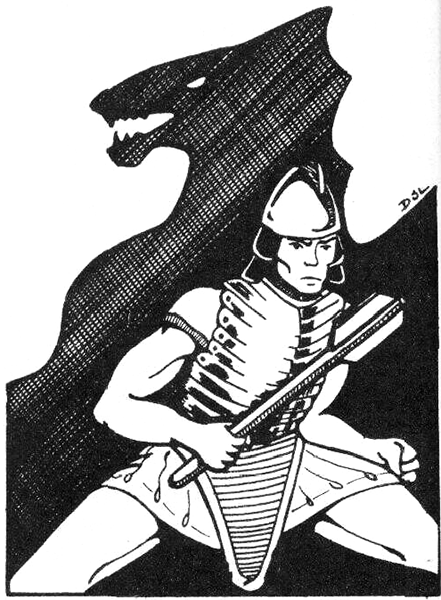
"A dragon, a dragon, I swear I saw a dragon..."
"Beings casting things at this god must make a saving throw against disintegration at −4 for both the being and the thing cast." Saving throws in first edition were divided into various categories based on what you were saving against: paralyzation, poison, or death magic; petrification or polymorph; rod, staff, or wand; breath weapons; or spells. Note that "disintegration" is not one of those categories. So apparently what's meant here is that the being must make a saving throw or be disintegrated. But then what kind of saving throw is it? It doesn't say. I'd guess death magic, but it would be nice if the text were more specific. That is, if this were something that was ever actually going to come up, rather than combat notes about a god that players almost certainly should never be fighting anyway.
Other random facts about Anu:
- "A strong breeze constantly blows in the direction of his gaze."
- "His voice is the voice of all leaders" (what?)
- "He can summon any dragon type (except for the king and queen and any other types of dragon royalty) to fight for him once a week, per dragon type." (I guess by the "king and queen" it means Bahamut and Tiamat?)
- "Anu is said to have created the heavens and the earth."
- All his ability scores are maxed out at 25, except, oddly, his Strength, which is "only" 19.
- In his statblock, for his levels as "MAGIC-USER/ILLUSIONIST", it just says "See below". There is no mention in his descriptive text of any magic-user or illusionist abilities. Oops.
ANSHAR (god of darkness and the night)
Anshar is a chaotic evil god who "always appears as a dark-skinned human and only appears at night or in deep darkness". He casts a darkness beam that does damage, and he can teleport in areas of shadow and darkness, and fortunately halfway through his description the writers finally stop using the word "darkness" so much. He can grasp spells out of the air and toss them back, and usually stores spells before battle, and wait a minute, why are we talking so much about what he does in combat? How often is that going to come up? Aren't there more useful things we can know about this guy? There's nothing about who worships him (other than that his worshipers' alignments are chaotic evil or neutral evil), or how, or why, or what his goals are, but we know he has a 200 spell level storage limit, because that's certainly going to be important to campaigns.
DAHAK (three-headed dragon spirit of death)
Dahak's statted as a unique monster, not a god, though it's a very powerful monster. It's chaotic evil, and it "will only eat the flesh of lawful or good creatures, and it never goes hungry." It is ethereal except when attacking with its bite; it can "negate any magical ability permanently with a touch of all three of its heads at the same time", and once again we get no information about its goals, or how it fits in with the rest of the mythos. Apparently there's just some random über-powerful three-headed evil dragon wandering around for no particular reason.
I was curious enough to look up Dahak to see what role it actually played in Babylonian mythology, and it turns out, as far as I can tell, well, it doesn't. It's not actually from Babylonian mythology at all. Dahak, also known as Zahhak or Aži Dahāka, comes from Persian mythology, which means it's from roughly the right geographical area, but at least a few hundred years too late. Oh well.
DRUAGA (ruler of the devil world)
Remember I said there was one god in this pantheon that I made heavy use of? This is him. Not that he ever made a personal appearance in any of my campaigns, as far as I can recall, but he played a major role behind the scenes. This despite my not having a defined place in my homebrew campaign world for the Babylonian Mythos—eventually I decided there was a distant Babylonian-flavored country across the ocean where the pantheon was worshiped, but I never really developed anything about the country except the name.
Anyway, aside from his appearance, Druaga really isn't all that interesting as evil gods go, frankly. I think the only reason I liked him so much was because I liked his illustration.
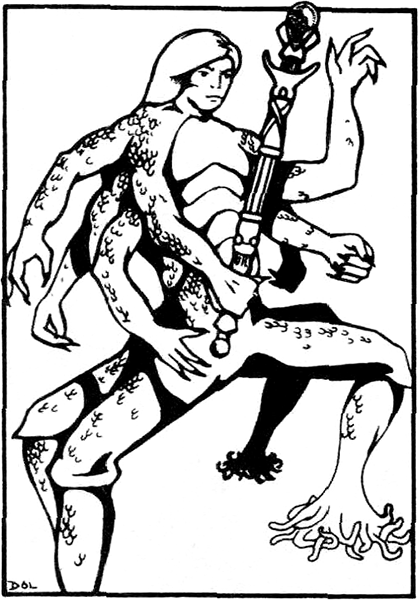
Okay, I actually still kind of do like his illustration.
Anyway, we start with a description, which I'm not going to bother to quote because it pretty much matches the illustration, although I will mention that we're told the "combination is so hideous that it often causes enemies to be paralized with fear." (No game effects listed, though; "often" implies that it's not automatic, so is there a saving throw? Does it just happen at the DM's whim?) But while that's his true form, he can shape change at will, and "generally never appears to anyone at the same way twice." (Of course, he's a god; how often does he personally appear to the same person more than once anyway?)
Huh, odd thing I just noticed: Druaga is referred to as "it" in the first paragraph of his description, but "he" in the remaining paragraphs. Oh well.
Anyway, not for nothing is he called the "ruler of the devil world". He can call on any type of (non-arch-)devil once a day "in numbers of 2-20", and anyone hit by his ruby mace must make a saving throw versus magic or turn into a random type of devil under his control.
Also, we get a weird bit about his having a "soul object" that contains the "total essence of his being" and that he places in an unwitting living human for safekeeping. If Druaga is ever killed, he regenerates from his soul object. I guess the idea is that he can be killed for good if the soul object is destroyed, but there's absolutely no information about how that can be done. Is the soul object destroyed if the human it's implanted in is killed? If so, then implanting his soul object in a living human seems like a really stupid move on his part. I mean, he's a literal god with 230 hit points, an Armor Class of −1, and 75% Magic Resistance; I'd think his soul object would be a heck of a lot safer in his real body than implanted in some random human.
Druaga, by the way, is another god here that isn't genuinely Babylonian. In fact, as far as I can tell, he's not genuinely anything; the authors seem to have pretty much just made him up. Not necessarily completely out of whole cloth; the name may come from the Zoroastrian concept of druj, or the related Old Persian root drauga, related to lying or deceit. But personalizing this concept as an eight-armed, snaky-legged monster with "the head... of a beautiful boy" appears to be all on Kurtz and Ward.
(Yes, Druaga as described in Deities & Demigods did also appear in an arcade game called Tower of Druaga (and a later anime series inspired by it), but that game came out four years after the release of Deities & Demigods, and no doubt copied Druaga from it. This is by no means the only example of a Japanese video game ripping off D&D... take the original Final Fantasy game, with monsters such as ankhegs, mindflayers [sic], ochus (otyughs), sahagins (sahuagin), remorazzes (remorhazes), piscodemons (piscodaemons), and, um, bihorudaa (beholders)... which apparently were a step too far and got renamed to "evil eyes" in the American localization.)
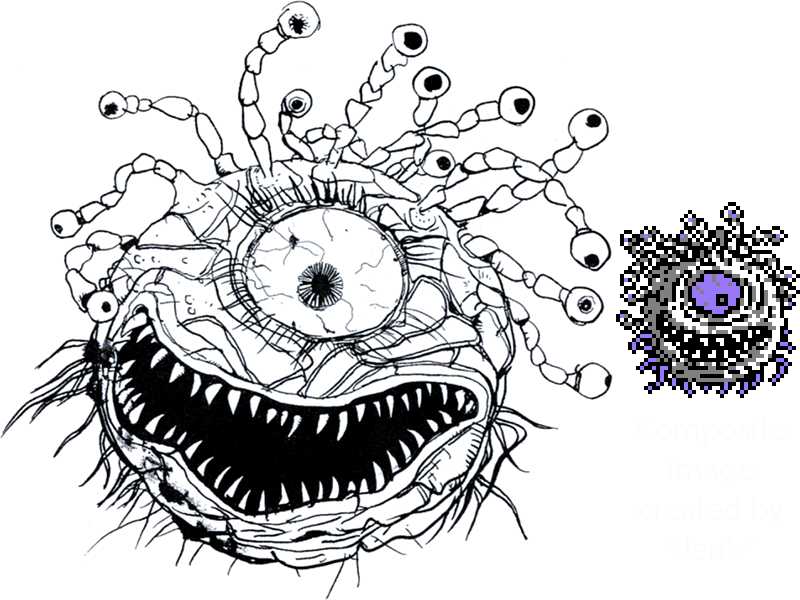
The concept drawing for the Final Fantasy bihorudaa, by artist Yoshitaka Amano, and the original Japanese sprite. Yes, the appearance was changed in the localization too.
(Not that this was unique to the Japanese; a lot of the monsters in the early Ultima CRPGs were blatantly ripped off from D&D too. But anyway, I digress...)
GILGAMESH (hero)
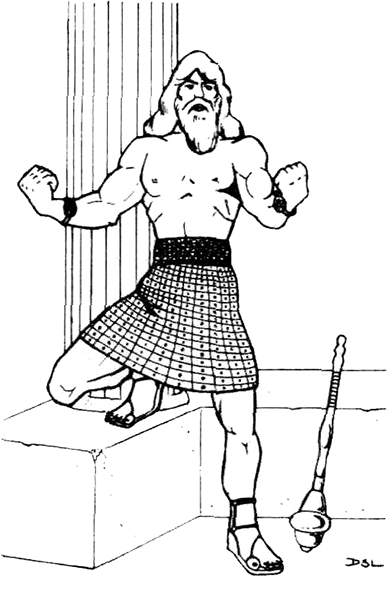
"I can take all of you! Come at me!"
Gilgamesh is a great king who is neutral good and "noted for his tyrannical rule". I'm not sure those two things go together. "Although he governs well and maintains peace, he uses his authority to satisfy his personal pleasures." Still getting some mixed messages here.
As apparently is usual for Babylonian kings, he's both a cleric and a magic-user, though oddly despite being described as a "warrior/necromancer/high priest" he's only a 5th-level cleric.
He "has a great fear of death, and if he learns of any way to avoid death, he will do whatever is required to gain it." This is certainly a reference to an episode in the Babylonian Epic of Gilgamesh in which Gilgamesh undergoes a long series of adventures to seek out his ancestor Utnapishtim, who had been granted eternal life after following the gods' instructions to preserve his family through a great flood (in a story very similar to, and probably the inspiration for, the Biblical story of Noah), to ask for the secret of immortality. Still, we can't leave the impression that Gilgamesh's fear of death makes him a coward:
Gilgamesh posted:
One oddity, however, is that his fear of death seldom occurs to him while facing a terrible foe. At such times, his courage will hearten him and he will fight without wavering.
Gilgamesh was a real historical king, but he ruled in Sumer, not Babylonia. Still, it wasn't till the time of Babylonia that the myths that had developed about Gilgamesh really coalesced into a coherent narrative and the Epic of Gilgamesh came together, so I guess there's some justification for including him in the Babylonian Mythos instead of the Sumerian.
GIRRU (god of fire)
We start with another of the detailed, highly informative descriptions that characterize this chapter: "Girru usually manifests himself as a man." Yeah, great.
Girru casts all fire spells as a 40th level magic-user, and I'm not even sure what that means, because the "SPELLS USABLE BY CLASS AND LEVEL - MAGIC USERS" table in the Player's Handbook only goes to level 29, and I don't see any notes on how it might be extended beyond that. I guess it means that he's considered to be level 40 for any level-dependent parameters in the spell, like that fireball in 1E has a range of 10" + 1"/level and does 1d6 damage per level. So... he's blasting fireballs with a range of 50" (that is, 500 feet indoors or 500 yards outdoors) that do 40d6 damage. All right then. Sure, why not. In light of that, the fact that he also has a mace with a poisoned barb and a +3 axe that can stun people it hits kind of seems like overkill. Also, any weapon that touches his body will disintegrate, with no saving throw. Yeah, we get over half his description devoted to his fighting abilities again. Sheesh.
Girru is lawful good, and he "hates all things evil and will destroy such whenever he comes in contact with them." So that's nice, I guess.
ISHTAR (goddess of love and war)
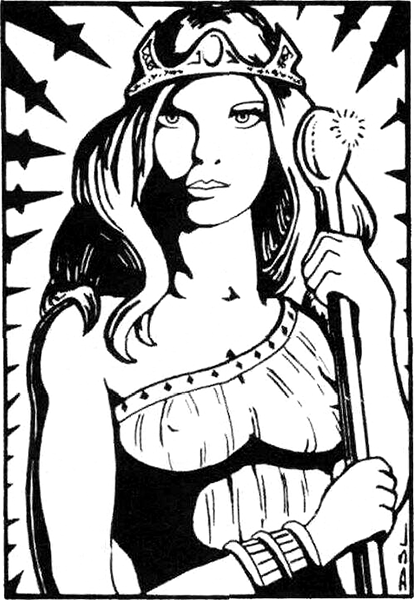
Also goddess of movies that run over budget and bomb at the box office.
Ishtar "never appears to her worshipers in any form other than that of a beautiful woman." Because of course she doesn't. "She has the strength of a titan, the ability to shape change at will [which she apparently never uses, at least in front of her worshipers], and she uses her voice as a constant suggestion spell", because of course she does. She wears a magic item called the headdress of love and war, which forces any male she is interested in "to become passionately in love with the wearer (no saving throw applicable), but she must really be interested in that male." We get a fun dangling participle in the next sentence: "When fighting an enemy, the headdress gives the wearer the same powers her enemy(s) has." If we take this literally, apparently her headdress fights enemies on its own.
Ishtar has a flying chariot pulled by seven enchanted lions, and we do get brief statistics for the lions for some reason. She also has a blue crystal rod which "is able to transform any spell energy into direct energy times ten, e.g. she is able to strike for 90 points of damage when expending a ninth level spell through the rod and 10 points when using a first level spell through the rod." That seems a little overcomplicated, but okay.
MARDUK
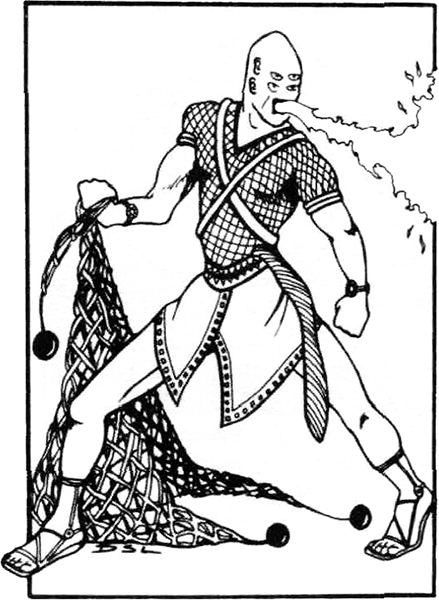
Is he wearing scale mail, or a fishnet shirt?
"Marduk is also called 'the justice bringer' and 'lord of pure incantations'." As you can see from the image, he's "one of the few nonhuman-appearing beings in the pantheon"—in fact, he seems to me to be the only nonevil nonhuman-appearing being in the pantheon (he's lawful neutral, though his home plane is Arcadia, which could imply he tends toward good). Apparently flames shoot from his mouth when he speaks, so I guess he's not really attacking the panel border up there; he's just... yelling at it?
Marduk fights with a "net made of the four winds" that "binds the target until Marduk releases the net". He can also "create any type of weather condition in an instant", including summoning "20 dice lightning bolts". But maybe his most impressive power is that he "can borrow any single ability from any one other deity in the pantheon (no saving throw applicable) and use it as he sees fit." It doesn't say how close the other deity has to be for him to do that—it does say the power "can be given back at any time from any distance", but it doesn't say whether the same holds for borrowing the power in the first place.
Marduk "occasionally assumes the leadership of the Babylonian gods when Anu is preoccupied." Also, "[h]is battles with Tiamat are legendary." Which actually makes sense, because Tiamat is originally from Babylonian mythology, and the mythological Tiamat did fight with the god Marduk. (And was in fact killed by him.) Well... the name Tiamat is originally from Babylonian mythology, anyway, but while the mythological Tiamat was a female figure of primordial chaos, there's certainly nothing in Babylonian mythology to suggest she was a five-headed dragon. (And that, of course, is another thing that was copied from D&D by the original Final Fantasy...)
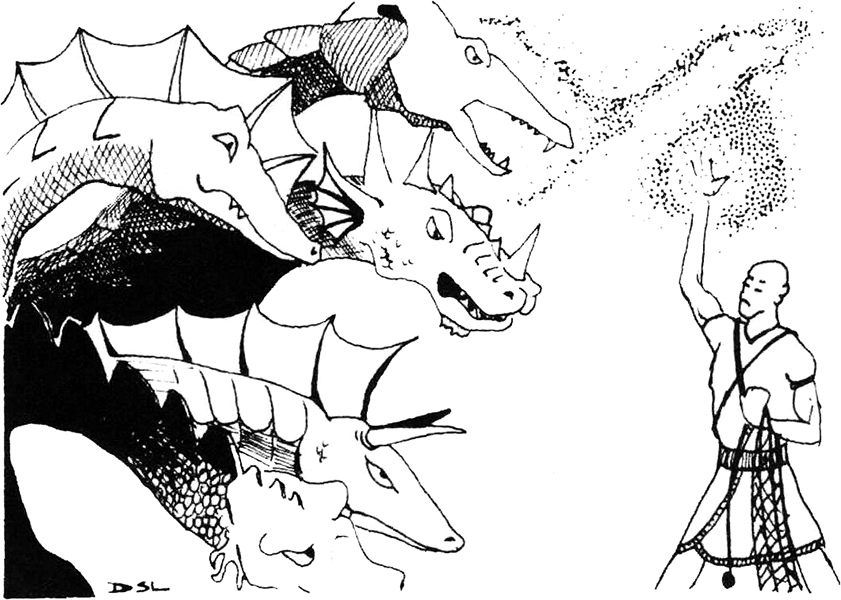
Making a special guest appearance, everyone's favorite evil dragon queen...
By the way, Tiamat's not the only figure from Babylonian mythology to appear in first edition outside the Deities & Demigods book. There's also Pazuzu.
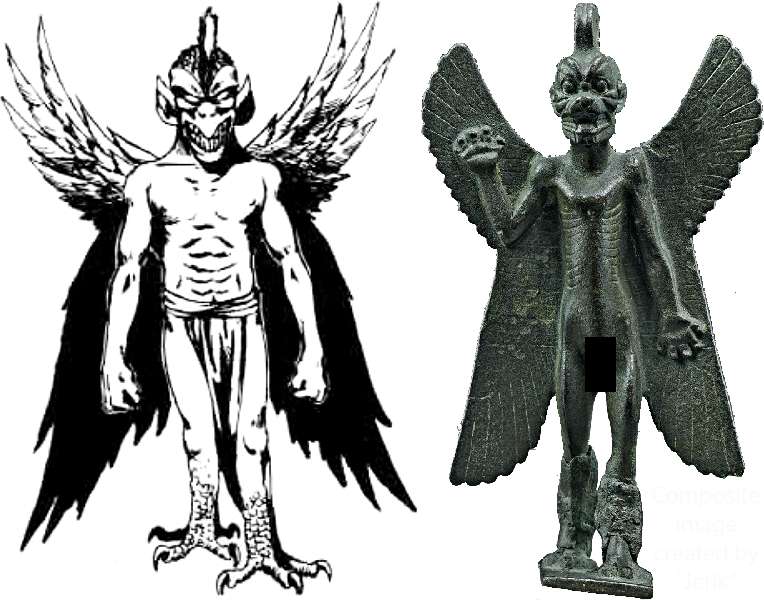
Till I looked him up just now to double-check that I was remembering correctly about him really being from Babylonian mythology, I actually didn't realize just how closely this illustration was patterned after a real ancient statue of Pazuzu.
But Pazuzu appeared in the Monster Manual II, which came out after Deities & Demigods, so of course it makes sense that he's not mentioned here.
Actually, Pazuzu played a major part in a long-running campaign I DMd in college, so I guess there are two Babylonian divinities (or semidivinities) that I used a lot back in the first-edition days. But only one from Deities & Demigods.
NERGAL (god of the underworld)
Nergal "rules over all things that are dead and never uses any form but a human one." Again, does he always use the same human form? If so, what does his human form look like? It doesn't say. Thanks.
As with Anu, though, we do at least get an illustration.
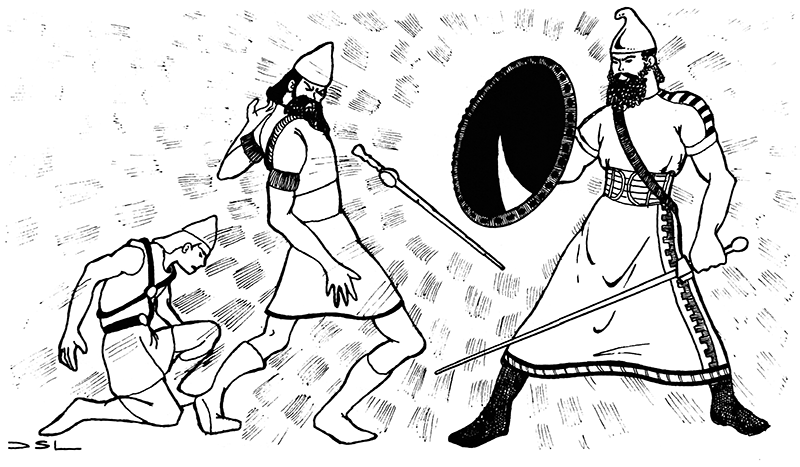
Why is he bothering to carry a sword, if his shield kills people? Maybe he just uses it to chop vegetables.
He is worshiped by those who wish success in evil deeds, and who gain his favor by sacrificing good creatures on his black basalt altar. In combat, because once again we for some reason have to dedicate more than half his description to his combat abilities and tactics even though he's a god and the chances of the PCs ever facing him in combat are minuscule, he has a +5 shield that "casts a death spell aura (saving throw applicable) in a 30 foot radius around the god", but his "favorite tactic is to revive the 5 most powerful dead enemies of his foe and have them fight for him."
(It's widely claimed that Nergal—the original Mesopotamian god, not the D&D version of him—was the inspiration for the Chaos God Nurgle in the Warhammer setting, but I haven't seen any sources for that, and while it definitely seems plausible I'm not completely convinced it's true until I see confirmation from one of the developers. There are certainly similarities beyond the name, but not marked enough to rule out the possibility of their being coincidental.)
RAMMAN (god of storms and thunder)
Not counting Ishtar's form as a "beautiful woman", Ramman is the only god of whose form we get more description than "a man"—he appears as a man "with massive build and a rather homely face". See, Kuntz and Ward, was that so hard? Why couldn't you have given us descriptions like that for Anu or Girru or Nergal? Anyway, he's a neutral god who is worshiped by "beings who wish rain" of all alignments and who "sacrifice expensive liquids" to bring rain or cooler weather. He also has a core of neutral worshipers who always perform their services at night, though it's never described what those services entail. In combat, he shoots lightning and throws his 10 foot boomerang mallet and has +4 ring mail made out of cloud vapor, but seriously again who cares about what the gods do in combat!? Seriously.
So there we have it. The Babylonian Mythos. Maybe a little lacking in diversity—there's only one good god, only one chaotic god, and only one goddess. (Though I guess that's one more goddess than we got in the American Indian Mythos, at least.) But honestly, for all its flaws (like the lack of physical description of the gods and the pointless obsession with their combat abilities), I think this was the best chapter so far. Though given the competition that's a low bar.
Next time: A New Use for the Severed Head of Your Enemy
A New Use for the Severed Head of Your Enemy
Original SA post Deities & Demigods 1EPart 7: A New Use for the Severed Head of Your Enemy

I wonder if it's the same artist doing all these chapter titles, or if they're done by the same person who does the art for the corresponding chapter? I'm guessing the former.
It says "Celtic", but these gods are mostly Irish, or at least use Irish names. We do get one Welsh god, one Welsh hero, one (rather obscure) Gaulish god, and one god who isn't Celtic at all and seems to have wandered into this chapter by mistake, but all the rest of the gods and heroes in this section are Irish. On the one hand, one could reasonably argue that there are enough similarities between the different Celtic traditions that it wouldn't really be feasible to have separate mythoi for each one, and it makes sense to combine them; on the other hand, there are enough differences that it might have made more sense to pick one and call it, say, the Irish Mythos, rather than making a "Celtic Mythos" that's almost entirely Irish anyway and just tossing in a few gods from other cultures. Oh well.
"The Celtic mythology is by no means confined to the British Isles", the book correctly says, and then proceeds to give us exactly two gods that aren't from the British Isles, and one of those, as previously mentioned, isn't even Celtic. We're told that "[t]he beings listed are all in human form, unlike some of the other pantheons in this book." But not unlike the Finnish, Greek, Japanese, Norse, and Sumerian pantheons, so it's unclear why this fact was singled out for the Celtic Mythos as if it were something unusual.
Most of the Irish gods here, by the way, were members of the Tuatha Dé Danann, an ancient people in Irish lore who had potent magical powers. I mention this not to argue that they shouldn't qualify as gods—in later tradition, they became equated with fairies, but "gods" worked differently in every culture, and the Tuatha Dé Danann qualified as gods as much as anything else did in Irish mythology. I only bring this up because I'll be mentioning the Tuatha Dé Danann later, so I figured I should go ahead and define the term up front.
Celtic Mythos posted:
[The gods] all have spheres of influence and these spheres are areas of control for the deities. Any major manipulation of these areas by humans or other life forms will cause the god or goddess in question to take an interest (in force) and attempt to put a stop to it.
...Again, isn't that true of all the pantheons in this book? All of them list particular spheres of influence for each god, and presumably all the gods are protective of their spheres of influence. Why is this written here as if it were something special to the Celtic pantheon?
In the next paragraph, we do get to something that is special about the Celtic pantheon, namely that the clerics of most of its deities are druids. Now, this seemed to present a complication, in that druids in first edition had to be true neutral in alignment. Most of the gods in this book, however, were not true neutral. If the clerics of most of the gods were druids, then the "WORSHIPER'S ALIGN" for those gods would have to include true neutral, even if the god in question was of another alignment. Did the writers take that into account?
Well, credit where it's due, they did. First of all, while most of the gods in the book as a whole are not true neutral, most of the gods in this chapter are... all but three of them, in fact. Secondly, unlike in most of the chapters, the "WORSHIPER'S ALIGN" for most of the gods in this chapter—including all the non-neutral ones—did not actually list alignments at all, but instead fields of interest like "All beings worshiping death" or "Beings that use the healing arts" or "Beings using the sea"... designations that presumably could include druids. So, okay, that's at least consistent with most clerics of this pantheon being druids; fair enough.
We get some description of druid religious services, including the fact that human sacrifices are made four times a year: "on November 1 (called Samain) celebrating winter's start; February 1 (called Imbalc) celebrating winter's leavetaking; May 1 (called Beltane) celebrating spring's planting; and Augist 1 (called Lugnasad) celebrating the time of harvest". Okay... two issues here. First of all, the use of the real-world calendar strikes me as awkward; does that mean that every world where the Celtic pantheon is worshiped has to use the same calendar as Earth? Second, well, the idea that druids have to perform human sacrifice is... troublesome. That seems like a pretty evil thing to do, and I'm not sure the insistence that "[c]ondemned criminals are typical sacrifices" helps much. (And of course it's historically dubious at best; there are classical accounts of druids performing human sacrifice, but given that the Greeks and Romans were trying to conquer the druids' people at the time they weren't exactly impartial chroniclers, and their accounts are widely believed by modern scholars to have been little more than sensationalist propaganda.)
We get a paragraph about druid groves, and then another paragraph on druid wardrobe. Worth mentioning in the latter paragraph is that "[e]very druid wears a torc (ornamental neck ring), and it represents the god or goddess most favored by the druid... The best ones are encrusted with precious gems and imparted with magical powers by their high-level owners". Also, every druid owns a cauldron that they use to "catch all the blood or sap of a sacrifice." (Sap of a sacrifice? Do the druids sacrifice trees? There was nothing about that mentioned earlier.)
Celtic Mythos posted:
The cauldrons of tenth level or higher druids act as crystal balls when filled with human blood.
Okay then. Where do they get all that quantity of—you know what? Never mind.
Celtic Mythos posted:
Druids consider themselves an elite group, separate from all other humans. They do not mingle with others, and are only allowed to mate with worshipers within their sect.
So... I guess that kind of rules out Celtic druids as PCs, then, unless all the PCs are druids. Huh.
As a side note, I think this chapter contains my least favorite illustrations in the book. Personal preference, I guess; I'm just not a fan of the art style. (The same artist also illustrated the Japanese Mythos, but for whatever reason his illustrations for that mythos don't bother me as much.)
DAGDA (dozen king)
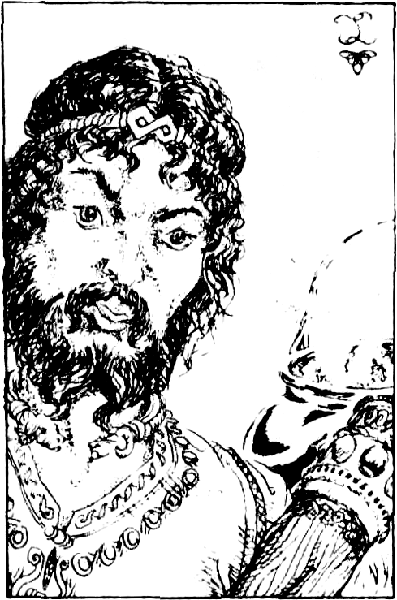
What exactly is going on with his lips?
Meet the leader of the Deities & Demigods Celtic pantheon. He's loaded up with magic items that seem kind of... superfluous for a deity. He has a staff that can act as a death spell on creatures touched by the large end, and raise the dead by touching them with the small end. He has a cauldron that "enables him to brew any nonmagical liquid or food". And he "sings with a sentient harp that talks in the common tongue and can control weather."
Dagda posted:
His two primary attributes are the ability to separate himself into 12 distinct and powerful entities. All 12 are fully aware and mobile, but 11 are ethereal in nature and roam the earth with unlimited range, constantly supplying information to Dagda. These beings have all the qualities of the original, but they must stay in the ethereal state at all times.
That's, uh, by my count that's one primary attribute. What's the second? (No, it's not covered in the next paragraph; that starts off by listing some of his "other attributes". It looks like there may be something they forgot to include.)
The mythological figure that Dagda was based on was actually generally referred to with a definite article, as "The Dagda". While he wasn't generally considered the overall ruler of the Tuatha Dé Danann, he was a very powerful being who had a position of rulership, so that part's not completely out of left field. I'm not sure where the "Dozen King" part comes from, though; I haven't been able to find a source for that.
ARAWN (god of the dead) "The Dark One"
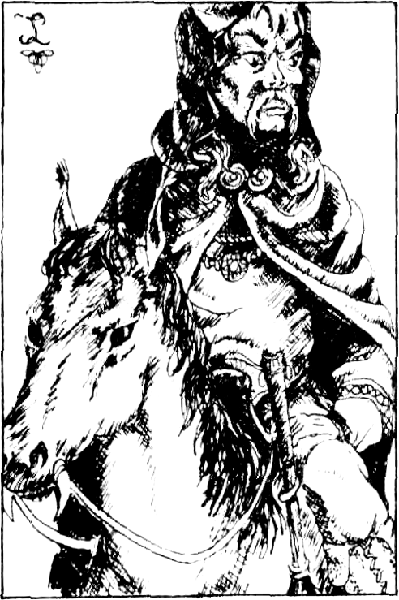
Wait... does that horse have fangs? (No, the horse is not mentioned at all in his description.)
Arawn is unique among the gods in the Celtic pantheon in three ways: He's the only Welsh god in the pantheon; he's the only evil god; and he's the only one not to make his home in the true neutral plane of Concordant Opposition. (Rather, his home base is on the Prime Material Plane, on "an island in the sea that only the dead can find.") He "can flash 2 death spells from his eyes at any time, striking independent targets if he chooses." (I have a mental image of his going wall-eyed to use his power on two enemies on either side of him.)
Remember in the post about the introductory text, I brought up the question of why, if resurrection "involves the cooperation of the deity on the plane where the soul was", a god wouldn't just refuse to cooperate and prevent someone from his plane from being resurrected if the god didn't want the person to be, rather than apparently letting it go on and being "highly displeased" after the fact? Well, that comes up again here:
Arawn posted:
The god will appear if someone restores to life a person he wants to stay in his domain (a 2% chance of this per level of the dead person, if he or she worshiped one of the Celtic gods), and he will either fight for the dead person or offer a substitute from the vast ranks of the dead (there is a 25% chance of this offer being made).
Okay, but again, how can someone restore to life a person he wants to stay in his domain in the first place, if we were explicitly told in the introductory text that that resurrection can occur only with his cooperation? I kind of get the impression that immediately after writing that sentence about resurrection involving the deity's cooperation, the authors completely forgot about it.
Incidentally, Arawn's evil alignment isn't really justified by the original myths; there, he wasn't so much the king of the underworld as the king of the otherworld—the world of Faerie, you could say more or less, though it wasn't called by that name in Welsh mythology—and there was nothing particularly malevolent about him. In fact, he struck up a friendship with a mortal prince and seems to have been a fairly amiable guy. Also, by the way, some scholars think that the story of Sir Gawain the Green Knight, alluded to in the Arthurian Heroes chapter, may have been based on the story of Prince Pwyll and Arawn.
BRIGIT (goddess of fire and poetry)
Brigit is basically exactly what you would expect a goddess of fire and poetry to be, in pretty much every way. I do, however, want to call attention to the following:
Brigit posted:
Note: if any players wish to worship Brigit (and possibly catch her attention) by singing during battle, the DM should require that the player make up an original battle-song on the spot and sing it while engaging in strenuous activity.
I don't know; I think most players might object if their DM insisted they do jumping jacks while improvising a song, or whatever, but I could be wrong.
CU CHULAINN (hero)
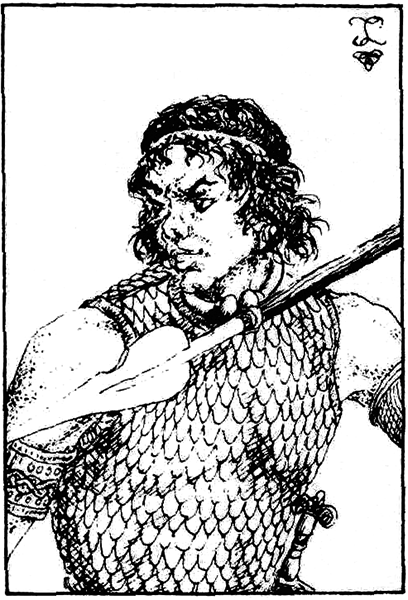
...Okay, he's actually not bad-looking, though he's got a bit of a pug-nose thing going on.
Cu Chulainn fights with a spear called Gae Bolg that only he can wield, and he "shines with a brilliance that makes it impossible for his mortal enemies to look directly at him".
Cu Chulainn posted:
The hero exists to fight giants and right wrongs all over the countryside. He often appears when all hope is lost.
Not really sure what else there is to say about him. I mean, in the original Irish myths there are a lot of interesting stories about Cu Chulainn, but none of them are related in this book.
DIANCECHT (physician of the gods)
I mentioned that Arawn was the only evil god; Diancecht is the only good one. He "appears as a young man" and "can heal any wound or restore any dead being, no matter how long dead"... although "[h]is power will not work on beings who have had their head taken away." (I guess decapitation is okay, as long as the head is still present?) He "never fights in large battles" (do most gods typically fight in large battles?), but he "has fought with Arawn over some of his dead." "In these battles, Diancecht has always won", which is weird, because Diancecht is only a lesser god and Arawn is a greater god, although looking at their stats Arawn doesn't really seem to be notably more powerful.
Diancecht "is hardly ever attacked because he will heal friends and enemies alike during a battle." Yeah... I can see how that would be kind of counterproductive, though I wouldn't think that would make enemies less likely to attack him... I'd think it would just make his allies less likely to ask him for help fighting.
DUNATIS (god of the mountains and peaks)
Why the authors decided to include this god I'm not sure; he seems to be a really obscure Gaulish deity, and there are several much more important and better known Celtic gods they could have included instead. He does not, incidentally, seem to have been a god of mountains in real Gaulish mythology; rather he had dominion over sacred places and fortifications. Be that as it may, in Deities & Demigods he can "raise a mountain peak into a flat plain, or flatten a giant mountain into a prairie", and that's... about all that's worth saying about him, really. He doesn't even get an illustration. I guess I could also mention that he fights by forming boulders from thin air and throwing them up to 1,000 yards, but, yet again, how gods fight doesn't seem terribly important.
GOIBHNIE (blacksmith of the gods)
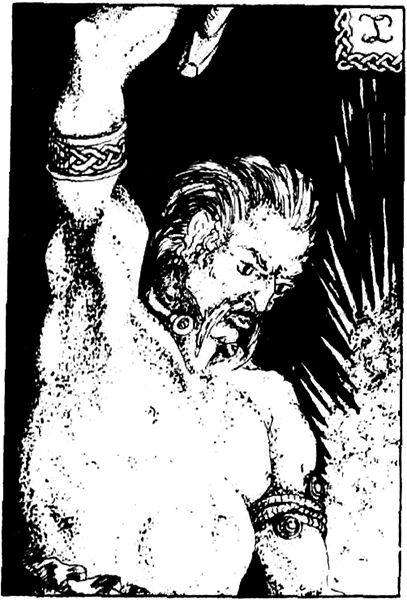
Is it really wise to be wearing metal armbands while working near a hot forge? Eh, I guess if you're a god it doesn't really matter...
I'm not sure where the authors of Deities & Demigods got the spelling they used; this god's name seems to be more commonly spelled "Goibniu" or "Goibhniu". Regardless, he "appears as a hugely proportioned man", and he creates "weapons and amulets of great power for the gods and the very few mortals he favors." Goibhnie's magic amulets "have the power to nullify any one specific spell", but they'll shatter if you try to wear more than one at once. His weapons will "never miss their target", but if they're "used to attempt an impossible hit (like a sword strike from 200 yards away), the weapon will hit, but will then shatter and bring on the wielder the instant wrath of the god in the form of a thunder bolt". Hm. What is the range on those "impossible hits", then? Is 200 yards the maximum, or was that just an example? Could you use them to attempt a sword strike on someone you can barely see on the horizon? Also, if the weapon does hit such an impossible strike, what exactly happens? Does the sword suddenly become 200 yards long? Does it fly 200 yards to the target and return? Does it swing normally, but a wound appears on the target without direct contact? I don't know. I'm not sure the authors know either.
LUGH "long handed" (god of generalities)
God of generalities?
"So, Lugh, what are you the god of?" "Eh, you know... stuff."
The description doesn't make the matter much clearer; it says that he's "a druidical ideal, and more fully understands druidism than any other entity", but it's not really clear that generalities = druidism, is it?
Lugh "appears as a tall man with very large hands." He "is unique among the gods in that he can use any one attribute of any being he has ever met", which seems like a heck of a power... Marduk from the Babylonian Mythos had something similar, but he was kind of the vice-head of the pantheon. For that matter, Lugh can also cast an unlimited number of druid spells "at the 30th level of magic use (an unattainable level for any other being)," so why isn't he the head of the pantheon? He seems more powerful than Dagda, frankly. Sure, Dagda has more hit points, but only barely. Maybe Lugh just isn't interested in the headaches of leadership.
In actual Irish mythology, Lugh was associated with arts and crafts, the sun, and the law, among other things. So okay, he wasn't really a tightly focused god, but it still seems it should be possible to define his field of interest more specifically than "generalities". (It would be hard to define his field of interest less specifically than that.) Also, for what it's worth, according to some sources he was the most powerful of the Irish gods. He was also the father of Cu Chulainn, though for some reason Deities & Demigods doesn't bother to mention that.
MANANNAN MAC LIR (god of the sea)
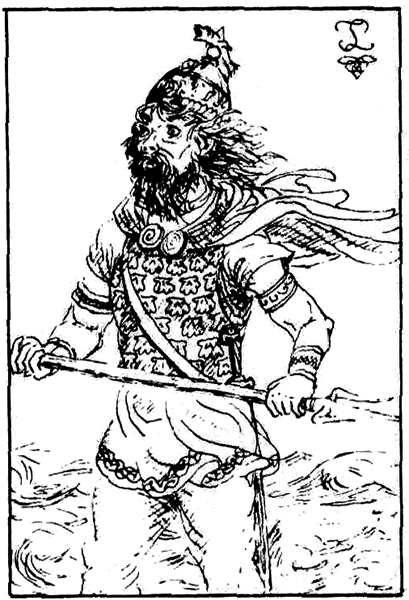
Based on his description, I guess he's supposed to be wearing armor made of sea shells, but it looks more like a tunic made of fabric with a scallop pattern.
I said Arawn was the only evil god of this pantheon, and Diancecht was the only good god; Manannan Mac Lir is the only chaotic god. (Both Arawn and Diancecht are lawful.) His main enemies are the fire giants, though I'm not exactly sure why, since the sea seems like the last place in which they'd have any interest. He has a trident that "absorbs moisture from the bodies that it hits (draining ¼ of the total amount of the victim's original hit points)", which may sound pretty good until you read on and find out that he also has a sword that automatically kills every time it hits "(magic saving throw applicable)", so... I'm not sure why he bothers with the trident? Maybe to use against enemies with really good saves? (Though it still does a good amount of damage even if the save is made... admittedly maybe not "¼ of the total amount of the victim's original hit points" good.)
"His main attribute is the power to call on any non-godlike creature of the sea to fight for him at any time and in numbers up to 50." I'm not sure what it is with this chapter that it seems to feel it necessary to call out the gods' "main attributes". We saw it before in Dagda's "two primary attributes" (though only one was actually described), but, though I haven't been quoting it every time, we were also told about the "main attributes" of Arawn, Dunatis, and Goibhnie, and all with the same wording ("His main attribute is the power/ability to...") Okay, it looks like that same phrase does come up a few times in later chapters as well, but not as frequently as it does in this chapter. It's really odd.
MATH (magic-user)
Math is not a god (in this edition), but a hero, "the greatest of all the legendary wizards in Celtic myth". He has a rod that "turns any being touched into a pool of water (permanently), magic saving throw applicable." (This raises a lot of questions, none of which are answered in the text.) "He has given himself the power to hear anything said in a breeze anywhere in the world. He has done so much for the gods that he has been given a Torc of the Gods (q.v.)." We'll get to that.
In Welsh mythology, Math ap Mathonwy was a powerful sorcerer and king who "could not exist unless his feet were in the lap of a maiden". Uh... okay, I'm actually kind of glad they left that last part out of his description in Deities & Demigods.
MORRIGAN (goddess of war)
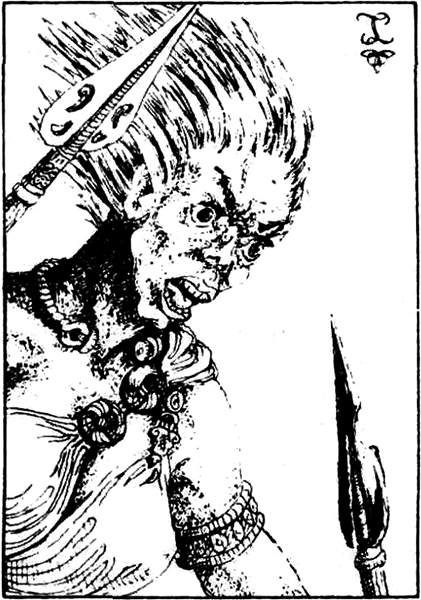
The text specifies that she has a "hideous face", but honestly I think almost all the faces in this chapter are fairly hideous.
Morrigan "appears as a well-proportioned woman with a hideous face". She can "deprive all who face her of their courage", and has a 5% chance of striking dead any of her worshipers who flee from a battle she is watching. But there's only a 10% chance she's watching any given battle, so there's really only a 1 in 200 chance she'll strike a fleeing worshiper dead. I guess those aren't terrible odds. She fights with two spears, one of which has a red head and one of which has a yellow head but they otherwise have exactly the same properties.
Speaking of things with the same properties, "Morrigan's servants include four demi-goddesses of war, Fen, Neman, Badb, and Macha, who are identical to her in all regards save hit points (they each have 200)." That's... weird. So they're identical in all respects save hit points? Do they each have identical red and yellow spears? Do they all look the same? That must get confusing, seeing five identical hideous-faced women. How do onlookers know which one is the real Morrigan? I guess they don't.
In the original myths, Morrigan was often said to be the wife of the Dagda, though Deities & Demigods doesn't mention that. Also, like her sometimes-husband, she was usually named with the definite article, as the Morrigan.
NUADA (god of war) "god of the Silver Hand"
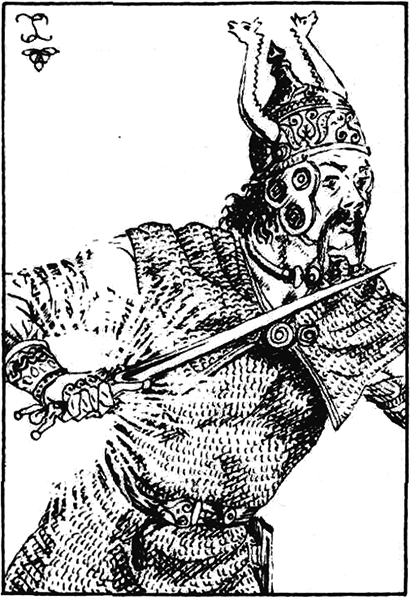
Not to be confused with Tycho Brahe, astronomer of the silver nose. (Okay, fine, turns out it was actually brass.)
The sobriquet isn't metaphorical; Nuada "appears as a man with an artificial silver hand." The description goes on about his combat abilities, but never quite gets around to saying anything about his worshipers, or his relationship to other gods, or... really anything else besides his combat abilities. Oh well. I guess it's kind of interesting to note that in battle his silver hand detaches and flies around on its own.
Oddly, despite his status as a god of war, Nuada has no fighter levels (though he does have levels as a ranger, which I guess is close enough).
In Irish mythology, Nuada was the first king of the Tuatha Dé Danann. So wouldn't it have made more sense to make him the leader of the Celtic Mythos here, instead of Dagda? Oh well.
OGHMA (god of knowledge) "The Binder, Patron of all Bards"
Or all bards who worship the Celtic Mythos, anyway, I guess.
Oghma gets no illustration, but the longest description of any god in this chapter. He "looks like an aged, white-haired man", and, somewhat surprisingly, "is the best wrestler of all the gods and considered their champion when fights with giants occur." Huh. In fact, "[h]is strength is such that when facing any being, he will have equal to that being's strength plus his own." I'm not sure how that's supposed to work, though, given that his Strength is already 25, and that's as high as the Strength tables go. Do you add the bonuses together? (If so, what happens if his opponent is weak enough to have penalties to their hit probability and damage?)
Any time someone sings an original composition, there is a 1% chance that Oghma is listening. The book states no consequence of this, but I guess it's nice to know. If "a song or tale is spread by others", though, there is a 5% chance that he hears it and "reward[s] the creator with great wealth in the form of gold 'strangely' given by the lord of the particular hold that the person was visiting and performing at."
Oghma knows "the secret name of any non-godlike creature." For, you see, "[i]n Celtic mythology, everything has a name it gives to the world, and another secret name that links it to its soul. If any being knows the secret name, he or she can control the creature or being or simply make them die (save vs. death applicable)." Okay, but if this is a general feature of everything in Celtic mythology, shouldn't it have been in the introductory text for the mythos and not buried in the description of a specific god?
Oghma posted:
Oghma is known as The Binder for his ability to successfully force demons and devils into a special prison of his making where they stay imprisoned until he wishes to bring them out.
Yes, that's... that's what a prison does, all right. Also, I like the fact that the authors felt it necessary to include the word "successfully". Consider the alternative. "Oghma is known as The Binder for his constant attempts to force demons and devils into a special prison of his making, even though it never works."
SILVANUS (god of the forests and nature)
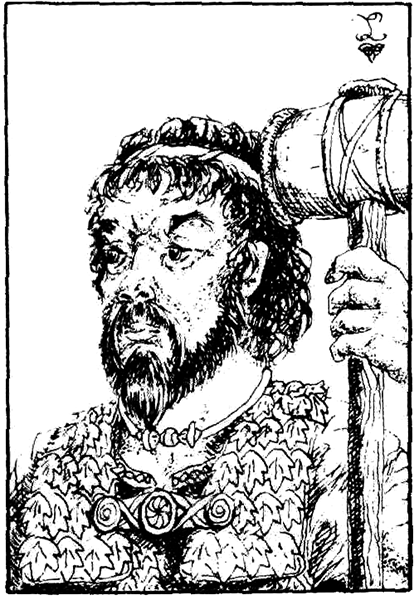
Silvanus, seen here just after eating a lemon.
Here he is, the god who isn't Celtic at all but insisted on barging his way into the Celtic Mythos chapter anyway. Silvanus was, in fact, a minor Roman god. Sure, he was sometimes equated with a Celtic god, but so were many of the other Roman gods: Vulcan was equated with Goibhniu, Neptune with Manannan Mac Lir, Mars with Nuada, etc. Furthermore, one of the gods with which Silvanus was frequently equated already exists in the chapter as a separate god, Dagda. My best guess as to why Silvanus got inserted into the Celtic pantheon is just because his sphere of influence made him seem like he could be associated with druids. In any case, however mythologically inaccurate, his inclusion in the D&D Celtic pantheon ended up sticking, all the way through the current fifth edition where he's listed among the Celtic Deities in Appendix B of the 5E Player's Handbook.
Anyway, Silvanus "looks like a man with very long legs". He "can control any number of animals and creatures of the forest with the sound of his voice", and can "make plants grow and shrink at any rate he wills." He is accompanied by a giant wolfhound (for which we also get brief stats), which I guess jumps in front of any and all physical attacks on Silvanus and takes damage for him, though the wording of that part is a little confused. Given that the wolfhound has only 100 hit points to Silvanus's 333, I'm not sure this is a great idea on the wolfhound's part, though at least the wolfhound does regenerate 5 hit points per melee round.
"There is a 1% chance that [Silvanus] will appear whenever harm is done to a high level druid or his or her grove." It doesn't say, though, what he does if he does appear. Presumably he takes revenge upon the person who inflicted the harm, but maybe he just shakes his head sadly, a single tear sliding slowly down his cheek.
So that's all the gods in this chapter, but we're not done yet... now we have brief descriptions of two magic items. I was going to say that the Celtic Mythos is the first (but not the last) chapter in the book to include some new magic items. (That is, magic items that have their own separate headings and descriptions, rather than being mentioned in the entry of a specific god or hero like Excalibur or Druaga's mace.) But on second thought, that's not really true; the "American Indian Mythos" chapter included the sacred bundle. But for some reason there it was at the beginning of the chapter, whereas the magic items in the Celtic Mythos chapter are at the end. Glancing ahead, this inconsistency is repeated throughout the book; some chapters have magic items at the beginning, before the gods, some have them at the end, with no apparent rhyme or reason. Well, whatever.
TATHLUM
Anyway, the first of the two magic items here is the tathlum, which is a weapon created by cutting off the head of an enemy and coating it in several coats of lime from the decedent's former territory. The exact number of coats is not specified, but we are told that each coat takes one week to dry, so we're talking a few weeks at least that it takes to make this thing. Once it's made, it can be thrown at "friends of the former owner of the head", and if this is done under bright sunshine, it does damage "up to ¼ of the original hit points of the person hit", or half their hit points if they're "a relative of the head". Considering that this is only good for one shot, I'm not sure that's worth the time investment.
TORC OF THE GODS
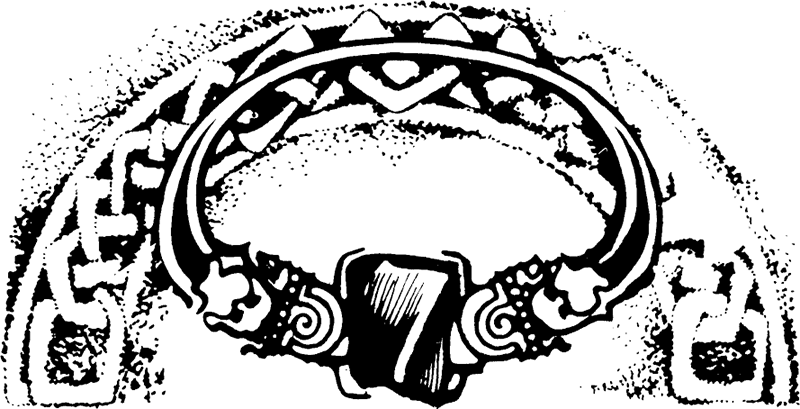
Useful and stylish. I guess.
Remember from the introductory text the discussion of torcs, "ornamental neck ring[s]" worn by druids of the Celtic Mythos? Well, the torc of the gods is a magical torc made by Goibhnie that "allows the holder to shape change or polymorph others." (How often? At will? If so, that's pretty damn powerful.) It isn't clear from the description whether the torc of the gods is a one-of-a-kind item or whether multiple torcs of the gods exist, but given that Math's description says he was given "a Torc of the Gods" I guess the latter is intended.
THE WILD HUNT
Finally, we get a page and a half on the Wild Hunt, including full stat blocks for the Master of the Hunt and the dogs that make up the Pack of the Wild Hunt. (And, to be fair, also including a large illustration that accounts for half a page.)
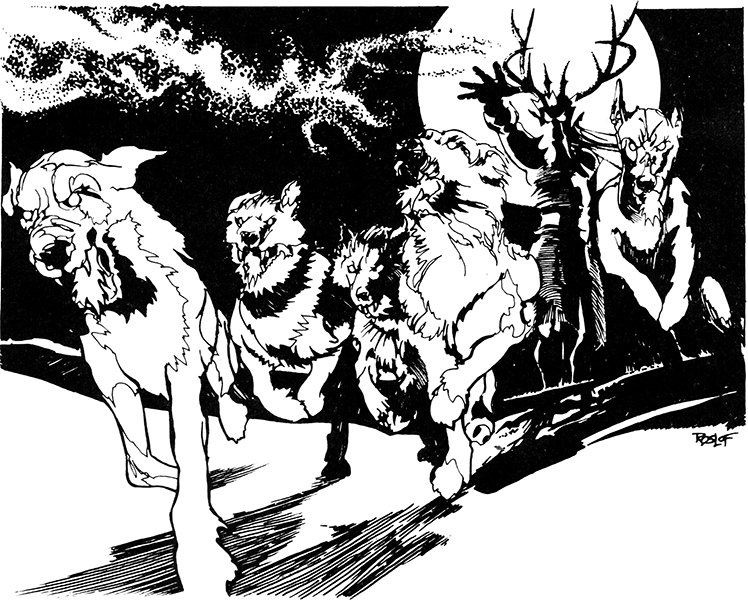
The description says nothing about the Master of the Wild Hunt's wearing any sort of mask, but he certainly seems to be wearing one here. Either that or he's got a really weird face.
The Wild Hunt posted:
The Wild Hunt exists in all the lands where Druids and their deities dwell. It is a physical manifestation of "life force" that always takes on the same form. The Hunt is made up of one huge black-skinned man with antlers growing from his head and his pack of hounds.
The Wild Hunt "appears wherever there is evil in the land"; it always begins ten miles from "the source of the evil that has created it". After passing by the source of evil, "it will travel on in a random direction for ten more miles." While it usually sticks to the ground, it can run into the air to "fly over obstacles or especially difficult terrain."
Wait... that's it? The Wild Hunt just passes by the source of evil? It doesn't actually do anything about it?
Apparently not. The Wild Hunt does attack its quarry, but its quarry isn't the source of evil that summoned it. Anyone who sees the Hunt as it passes by must make a saving throw versus magic or join the Hunt; anyone who hears the hunt and actively pursues it likewise becomes a part of it when they see it. (The howling of the dogs and the Hunt Master's horn "can be heard for miles in the night.") If the Hunt is still on its way to the source of evil, there is a 10% chance per mile of distance from that source that a person joining the hunt will do so as a hunter. Otherwise, the person becomes the prey. Anyone caught up in the Hunt after it passes the source of evil has a 90% chance of becoming prey. If the Hunt still hasn't found any prey by the time it's traveled ten miles away from the source of evil, it will just hunt down the nearest large game animal. Anyone who has been a part of the Hunt before (either as hunter or as hunted) has a flat 50% chance of being drawn in again if they ever see the Hunt on a future occasion.
So... yeah, apparently the Wild Hunt is drawn to the Prime Material Plane by a source of evil, but instead of actually doing anything about that source of evil, it hunts down some hapless random passerby instead. Well, that's just great.
Anyone joining the Hunt as a hunter will magically be able to keep up with its pace, regardless of their own usual speed, and will be compelled to attack the Hunt's quarry in a fight to the death (regardless of alignment—the book specifically gives the example of paladins being compelled to attack helpless women). The Master and his hounds will let the other hunters take care of the hunted, but if all other hunters are defeated, they will then step in and finish the job, unless they're killed themselves. Short of defeating all the hunters, including the Master and his pack, the only ways for someone hunted by the Wild Hunt to escape are to evade them till morning or to get more than ten miles away from the source of evil that summoned it.
There are legends in the past of great heroes slaying the Master and his hounds, but they always return somewhere else the next night, "proving that the force that creates the Hunt is eternal."
Like I said, we then get stats and descriptions of the Master of the Hunt and his pack. They're pretty tough, but not impossible for a high-level character to handle.
The Master of the Hunt posted:
The Master has iet black skin and glowing green eyes. His head is crowned by a set of stag antlers, and he wears a suit of black leather. The Master never speaks.
The pack of the Wild Hunt are "huge black hounds [with] licks of green fire for tongues and green fire for eyes." They have average human intelligence for some reason.
And that's the end of the chapter. Before moving on, though, there's one other thing I'd like to touch on. I mentioned in a previous post "Gods, Demi-Gods & Heroes", the fourth supplement to the original D&D set, which was written by the same authors as Deities & Demigods, and clearly inspired it. I didn't do a separate review of "Gods, Demi-Gods & Heroes", and maybe I should have... although it has very little flavor text and is mostly just stat blocks, so there's not much to review. What I think I will do, though, is a brief sort of compare and contrast with the presentations of the mythoi in the two works—or rather, where a Mythos appeared in that earlier book, I'll combine my review of the chapter in Deities & Demigods with a brief rundown of the presentation of the mythos in "Gods, Demi-Gods & Heroes". All but one of the mythoi in "Gods, Demi-Gods & Heroes" would later appear in Deities & Demigods, the only holdout being "Robert E. Howard's Hyborea". The reverse is not true; there are many mythoi that appeared in Deities & Demigods that did not appear in "Gods, Demi-Gods & Heroes". There was in the earlier work no "American Indian Mythos", no treatment of the "Arthurian Heroes", no Babylonian Mythos. There was, however, a description of the Celtic Mythos, making this the first one we've come to so far to appear in both works.
(In case you're wondering whether, by just comparing each chapter rather than having a full review of "Gods, Demi-Gods & Heroes", we're missing out on some interesting front matter... we're really not. There's a one-page foreword, part of which I've already quoted in previous posts, there's a table of "Gods Psionic Abilities"—rather than being individually detailed, the gods were sorted into six different classes of psionic abilities, a practice that was repeated in Deities & Demigods—and then we get the following note:
Gods, Demi-Gods, and Heroes posted:
Unless specifically noted otherwise all Gods and Demi-Gods pre-rolled abilities (strength, intelligence, etc.) are considered to be 20. Heroes or otherwise nonGod types are either listed or will have to be pre-determined by the respective judge.
And that's it for the front matter; we then jump right into the descriptions of the gods, starting with Egyptian Mythology (for some reason... I'm not sure what the logic was behind the ordering of the mythoi in this book, but it's certainly not alphabetical). So, yeah, I'm not really skipping anything important.)
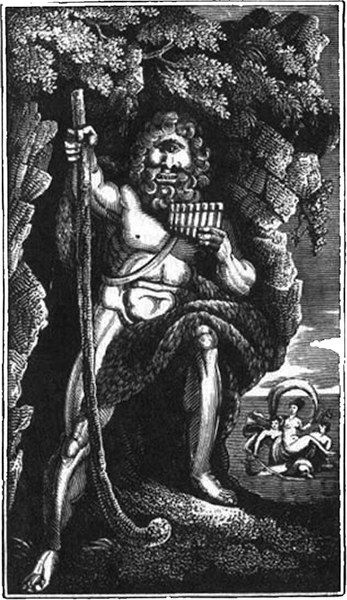
Here's an image from the title page of "Gods, Demi-Gods & Heroes", just to avoid going too long without an illustration.
As opposed to the six paragraphs of introductory text on the Celtic Mythos that we get in Deities & Demigods, in "Gods, Demi-Gods & Heroes" we get just one short paragraph:
The Celtic Mythos posted:
The Celtic mythology is by no means confined to the English Isles. The Gods are all in human form as opposed to some of the other pantheons mentioned. They all have spheres of influence given for each God. These spheres are areas of control for the Gods and any manipulation of them by humans or other life forms causes the Gods to take an interest.
You might recognize that everything in this paragraph also appears in Deities & Demigods, and we've already covered the issues with it. The fact that the same text appeared earlier in "Gods, Demi-Gods and Heroes"... doesn't really explain anything.
As for the actual gods, all the same gods and heroes appear in "Gods, Demi-Gods and Heroes" as would eventually appear in Deities & Demigods, though they're in a different, apparently random order, and some of them have different names. Even Silvanus is already here, so even though he really has no business being in the Celtic Mythos he's been there in D&D since the beginning. In most cases, the name differences are just a matter of a variant spelling: Dagda is "Daghdha" (and already has his "Dozen King" epithet and corresponding power), Lugh is "Liegh" (and here he's not said to be the "god of generalities", but it's not specified just what he is the god of); Cu Chulainn is Cu Chulain. Two of the name changes, however, are more substantial. The Celtic god of death in "Gods, Demi-Gods & Heroes" has a very similar (albeit much briefer) description to that of Arawn in Deities & Demigods—but his name isn't Arawn; it's Donn. Now, unlike Arawn, Donn actually was a god of the dead in Irish mythology, and the description here—and the description of Arawn in Deities & Demigods—actually fits the mythological Donn a lot better than it does the mythological Arawn. So why did the writers change the god's name to Arawn in Deities & Demigods? Maybe because they wanted to get more representation from other Celtic peoples than just the Irish, so they threw in a figure from Welsh mythology, even if that figure didn't fit the description of the Irish god it had originally been applied to. But there's at least one other possible explanation. Deities & Demigods doesn't mark the first time that Arawn appeared in pop culture as a figure of evil; he was the main villain of the young adult fantasy series The Chronicles of Prydain, by Lloyd Alexander. (A series I read and loved as a child, and that would later form the (loose) basis for one of the least remembered and least regarded Disney animated films, The Black Cauldron. (The books were better.))
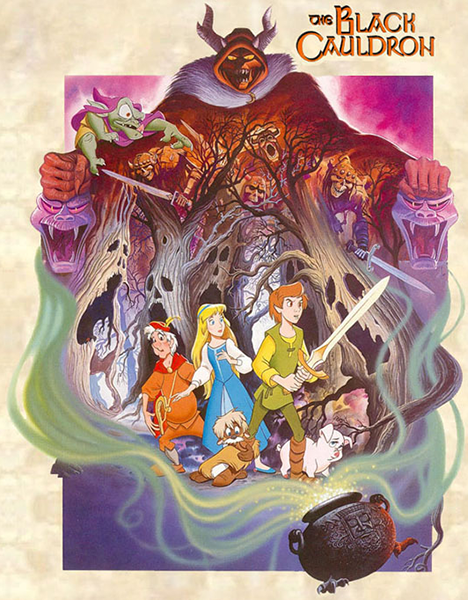
In the books, Gurgi was a gangling humanoid monster; in the movie, for some reason he's a mustachioed chihuahua.
The Chronicles of Prydain predated Deities & Demigods by more than a decade, but I don't know that the authors of Deities & Demigods were familiar with it or that it had any role in inspiring the treatment of Arawn there—though I also don't know for sure that they weren't and it didn't. One possible hitch in this theory is that The Chronicles of Prydain predated not just Deities & Demigods, but also "Gods, Demi-Gods & Heroes", so if Kuntz and Ward were inspired by the series to include Arawn as an evil god of death, why hadn't they done so earlier? Of course, there are possible explanations for this—perhaps, for example, they read the series in between writing "Gods, Demi-Gods & Heroes" and Deities & Demigods—but ultimately this is just speculation anyway. I don't know their reasons for changing Donn to Arawn, but regardless it really would have made a lot more sense to leave the god of death as Donn.
The other major change is that Morrigan was originally named Medhbh (but had a similar (but briefer) description, complete with the part about the "hideous face"). Like Donn and Arawn, Medhbh and Morrigan were two different gods mythologically, though unlike Arawn they were both Irish, and it has been suggested they may have been linked in some way. By the time of the best recorded Irish myths, Medhbh wasn't really considered a goddess, but a mortal queen, but historians believe she may have been based on a sort of "sovereignty goddess" in older times. ("Medhbh" is, incidentally, a cognate of the name "Maeve"—much later used as the name of the queen of the Seelie Court of the Shadow Fey in the Ravenloft setting—and also possibly of Queen Mab of Shakespearean fame.) The change from Medhbh to Morrigan makes more sense than the change from Donn to Arawn; while both Medhbh and Morrigan had some association with war (in that Medhbh was considered a warrior queen), Morrigan's association was stronger, in addition to which Morrigan was better known and more definitively divine. The better question in this case, actually, isn't why they changed the name from Medhbh to Morrigan, but why they didn't use the clearly more appropriate Morrigan in the first place.
"Gods, Demi-Gods & Heroes" also has one additional character who didn't make the cut to Deities & Demigods: Balor.
Balor posted:
Once a huge monster, this creature is now nothing but a 30 foot tall head. When the eyes of this head are forced open, all beings looking at it will die (no saving throw applicable).
Balor also comes from Irish mythology, where he was the king of the evil Fomorians, the main enemies of the Tuatha Dé Danann (who would later be loosely adapted into D&D as a race of evil giants in the 1E Monster Manual II)... although the myths only said he had a single deadly eye, not deadly eyes plural. Why he didn't make it into Deities & Demigods I'm not sure, although my best guess is that it's because the name "Balor" had already been used in the Monster Manual as a sample name for a demon, so perhaps the writers though that also using it as the name of a specific mythical monster would be confusing. Of course, the similarity of the demon name "Balor" to the name of the Irish mythological figure was almost certainly coincidental; D&D's "Balor" most likely originated as a mangling of "Balrog", the Tolkien creature that inspired that demon type.
(Yes, in 1E "Balor" was a sample name of an individual demon, not the name of a type of demon as it would later become:
1E Monster Manual posted:
Each type VI demon has its own name. (Balor is a type VI demon of the largest size.)
The same was true of the name "Nalfeshnee" for a (specific) type IV demon and "Marilith" for a type V. The use of these names to refer to the entire corresponding type of demon—and the dropping of the Roman-numeral "type" numbering from first edition—wasn't a thing till second edition.)
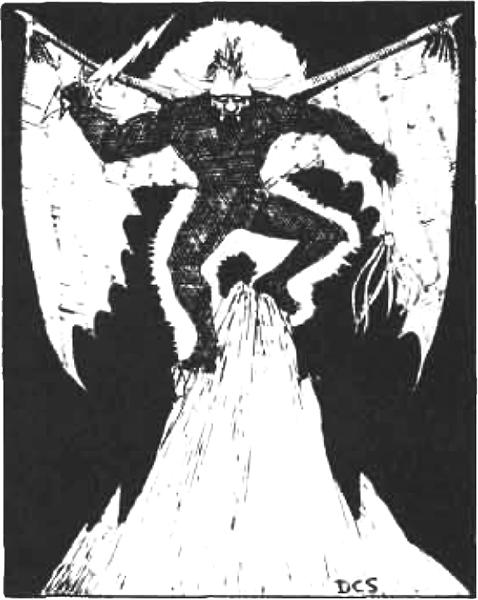
The type VI demon illustration from the 1E Monster Manual. Not sure why it's shown holding a lightning bolt, since it has no electrical attacks... and of course even if it did, a lightning bolt isn't really something you can hold.
After the gods, we get, as in Deities & Demigods, entries on the Torc of the Gods and the tathlum, though the descriptions here, again, are much briefer. And then we get a description of druids... sort of. Actually, what we get is this:
The Celtic Mythos posted:
DRUIDS:
For an excellent description of these beings see Eldritch Wizardry, Supplement III to D&D.
Yes, in the original D&D set, druids appeared in one of the supplements... the same supplement, incidentally, that introduced the demon types that would later appear in the AD&D Monster Manual, though the sample names like "Balor" wouldn't appear till then. So the section on the "Celtic Mythos" in "Gods, Demi-Gods & Heroes" basically just suggested that the druids from Supplement III would be a good fit for the mythos without going into further detail.
Anyway, there we have it, the Celtic pantheon, the first "major" pantheon in this book, in the sense that it made it into a lot of later books and was a fixture of the similar books of gods in later editions.
Next time: Gods from a Parallel Universe
Gods from a Parallel Universe
Original SA post Deities & Demigods 1EPart 8: Gods from a Parallel Universe

Why does every chapter title have that weird little knot/percent-sign thing after it? What exactly is that supposed to be? I thought it was a period when it showed it up in the "Arthurian Heroes" title, but apparently not. Is that the artist's monogram? If so, what initials does that represent? ...Hm, one of the credited artists was "Darlene Pekul"; I guess that could be a "dp"...
Central American Mythos posted:
The Aztec and Maya presented the world with an interesting set of closely related gods, goddesses and creatures that have a moral background similar to that of other ancient mythoi. The beings are just as evil or just as good; the difference seems to be that they are not moved by anything resembling human thoughts and feelings, unlike the deities of other mythoi. They act only upon their own inscrutable motives.
Okay, I'm sorry, but this opening paragraph strikes me as pretty much gibberish. Don't a "moral background similar to that of other mythoi" and being moved by something "resembling human thoughts and feelings" go together? Are the writers trying to say that the Central American gods still follow moral principles, but for completely different and incomprehensible reasons? And anyway, what drove them to the conclusion that the gods of this mythos were so much more alien and unfathomable than those of other mythoi anyway?
It gets worse.
Central American Mythos posted:
These beings are said to have come from the stars, and their "plane of origin" is not the same as other mythologies. For the purposes of this work, we will assume that these gods come from the Prime Material Plane of a parallel universe.
Wha—what!? I...
Seriously, this whole thing about the Mesoamerican gods being unknowable alien beings from a parallel world is just... bizarre. And it isn't really supported by the presentation of the gods themselves, who are for the most part treated like personalized entities with typical human emotions; we're told that Camazotz can be "tempted to comply with a summons", that Chalchiuhtlicue is "eager to aid" petitioners under certain circumstances; that Itzamna "tries to temper his father [Tezcatlipoca]'s harsh dealings with man." These pretty much sound like something "resembling human thoughts and feelings" to me.
Inscrutable or not, the gods of this mythos are an unusually malevolent lot. Fully half the gods presented in this chapter are evil, and only two are good. Hm. (Of course, in two chapters we'll get to an even more malevolent mythos...)
Anyway, despite the mention at the top of the "Aztec and Maya", what we get here is mostly Aztec. Granted, there were plenty of similarities and borrowings between the two cultures, but, again, that was at least as true of the Babylonians and the Sumerians, but they each get their own Mythos. Why combine the Aztec and Maya gods, but not the Babylonian and Sumerian? I don't know, but here we are anyway.
Central American Mythos posted:
The clerics of this mythos are the elite of the populace, and even the lowest levels have absolute authority over any of the peasants. Along the same lines, any cleric of a higher level may give orders to lesser clerics of the same deity with complete freedom. Though all sects must usually work together, there is much clandestine infighting between groups for followers among the rich and poor alike.
The text goes on to describe the rituals, which take place every twenty days and which the public is forced to attend. (And yes, they sometimes, but not always, involve human sacrifice.) We're told that "[a]ll temples are built on the step pyramid design"—both the Aztecs and the Maya did historically build step pyramids, so okay, fair enough. We then get a paragraph about divine punishment of clerical transgressions—oddly, "defeats in personal combat (duels)" count as offenses against the gods for some reason. Finally, the last paragraph states that each cleric must choose one of the four cardinal compass directions to be associated with, and get combat bonuses when facing in that direction.
Central American Mythos posted:
Clerics of the east must wear red clothes at all times, clerics of the south must wear yellow, clerics of the west must wear black, and clerics of the north must wear white.
Those particular color associations with the compass directions are from Maya culture (and, incidentally, also some Lakota); the Aztecs also associated each compass direction with a color, but their color correspondences were different. The Maya also associated the center, between the four colors, with another color, blue and/or green (Mayan languages do not necessarily distinguish between these colors), but Deities & Demigods doesn't mention that. It might also be interesting to note, although Deities & Demigods doesn't mention this either, that both the Aztecs and the Maya associated each compass direction with a particular god or gods as well. For example, the Aztecs associated the north with Tezcatlipoca, Lord of the Smoking Mirror, God of Sorcery, Strife, and the Night Sky; the west with Quetzalcoatl, the Feathered Serpent, God of Learning, Wind, and the Morning and Evening Star; the south with Huitzilopochtli, the Turquoise Prince, God of the Sun, War, and the Cycle of Day and Night; and the east with Xipe Totec, the Flayed One, God of Agriculture, Disease, and Not Appearing in This Book.
This is another pantheon that did also appear in the "Gods, Demi-Gods & Heroes" supplement to the original D&D boxed set, though there it was called the "Mexican and Central American Indian Mythology". Rather than summarize the differences at the end of this post as I did for the Celtic pantheon, I'll just mention the differences in each god as we get to them. (Not all the Central American gods in Deities & Demigods were also in "Gods, Demi-Gods & Heroes", however, and if I don't mention a god's treatment in "Gods, Demi-Gods & Heroes" it's because the god didn't appear there.) I'll quote here the introductory paragraph for the "Mexican and Central American Indian Mythology" section:
Mexican and Central American Mythology posted:
Due to the lack of space in this booklet we, the authors, are only able to present parts of this mythology. What is listed below will be mainly the gods & let it be noted that information on these divinities is scarce.
Uh... what? They're only presenting parts of all the mythologies. Surely the authors didn't think their Celtic Mythos section comprehensively covered every god from Celtic mythology, or likewise for Egyptian, Greek, and so on. And if they found information on Central American gods particularly scarce (though I don't see any reason that ought to have been the case), then it makes even less sense to call out the fact that they're only presenting part of the mythology in this section in particular, if they had less material to draw on. Oh well.
QUETZALCOATL (god of the air) "Law Giver"
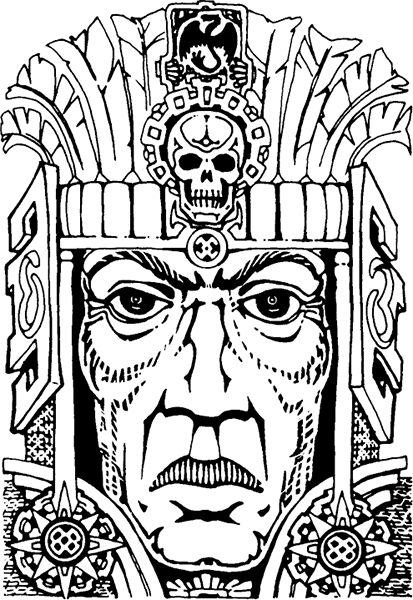
Wait... why does he have a skull on his hat? Is he a baddie?
Quetzalcoatl posted:
Also known as Kukulcan, or (in his capacity as wind god) Ehecatl, this god appears in a bewildering number of forms, and while he usually acts as per his [lawful neutral] alignment, there are times when he works in chaotic or evil ways (making it very hard to align him).
So I guess this is the one god whose description does sort of live up to whole "inscrutable motives" thing, but he's the only one. I don't know that the note about its being hard to align him was really necessary, any more so than it would be for other gods; most major gods in ancient mythologies had contradictory myths develop about them. Heck, Zeus did some pretty dang evil things in Greek mythology, but, as we'll see when we get to the Greek Mythos, he still gets to be chaotic good. (And Athena is lawful good, despite the part she played in the Judgment of Paris and the Trojan War...)
Quetzalcoatl posted:
He appears occasionally on our plane and works closely with his worshipers against other gods.
I wanted to quote this sentence just because of the odd use of the first person. Are Kuntz and Ward suggesting that they live on the same plane as their D&D characters? Or are they suggesting that Quetzalcoatl occasionally drops by on real-world Earth? Anyway, moving on...
Quetzalcoatl fights in the form of a monster of his choice, and "cannot be hurt by creatures of the same form he is using; in other words, when he is in the form of a dragon, he cannot be hurt by any dragon type, and when he is in the form of a magic-user, he cannot be hurt by magical spells." (Wait... so "magic-user" counts as a form of monster? Can he take the form of a fighter, and be immune to weapon attacks?) If he "suffers a great loss of hit points", he will "take the form that he had assumed at the beginning of the battle and quadruple its powers and re-attack". If he could just arbitrarily quadruple his powers, why doesn't he just attack with the higher power to begin with? (Also, what exactly does it mean to quadruple his powers? Does he attack four times as often? Do his attacks do four times as much damage? Are his magic spells harder to resist, and if so, what constitutes four times as hard? Or does he cast spells like a magic-user of four times the level?)
Quetzalcoatl posted:
Quetzalcoatl was the mightiest god of the mythos, though his claim is disputed by the followers of Tezcatlipoca, his arch-enemy. Quetzalcoatl is patron of the arts and the founder of metallurgy.
Mythologically, Quetzalcoatl was especially associated with books and learning, though he did also preside to some degree over the arts in general, and was also an especial patron of priests and merchants. "Ehecatl" was the name of a wind god usually considered an aspect of Quetzalcoatl, and "Kukulcan" was the name of a Maya god often identified with the Aztec Quetzalcoatl—making this the only time in this chapter the writers give both an Aztec and a Maya name for a god. "Gods, Demi-Gods & Heroes" gets all this rather dramatically wrong, saying that "Quetzalcoatl is the feathered Serpent-God of Mayan religion" (emphasis added), and that he's called "Kulkulkan [sic] in Incan". Not only was Kukulcan not an Inca name, not only was Quetzalcoatl by any name not part of Inca mythology, not only is "Incan" not a language (the official language of the Inca Empire was Quechua, which is still spoken today by some people in Peru and nearby countries), but the Inca didn't live in Mexico or Central America at all; the Inca Empire was located along the western edge of South America! Perhaps it's for the best that in Deities & Demigods the authors didn't try to specify which culture each god came from, if that's what happened when they did...
Quetzalcoatl was closely associated with the feathered serpent, and was often depicted in that form—in fact, both the names "Quetzalcoatl" and "Kukulcan" basically mean "feathered serpent". (This is also, of course, where D&D's couatl comes from.) Deities & Demigods does list Quetzalcoatl's symbol as a "feathered serpent" but doesn't otherwise acknowledge this association, though there is a picture of a feathered serpent at the bottom of the page. In this one aspect, at least, "Gods, Demi-Gods & Heroes" arguably did better than Deities & Demigods, in that it did explicitly refer to Quetzalcoatl as a "feathered Serpent-God". It also gave him serpent-specific powers that weren't in his Deities & Demigods entry: "[a]ll serpents are subservient to him", and he "has at his beck and call one of every class (type) of dragon."

"What're you looking at?"
CAMAXTLI (god of fate)
quote:
This human-appearing god is able to see the past and future of any being and put this information to use in his own way. He is not allowed to kill any being, but he can look into that being's past and discover what force caused the most physical damage to that being, and then recreate that force exactly to again do the same amount of damage.
We get another instance of passive-voice vagueness here. He's not allowed to kill any being? Who or what is stopping him? Quetzalcoatl? Some kind of universal law? Gary Gygax? The Dungeon Master?
There's a 25% chance that Camaxtli will, for a short period, "do what he can to help" anyone who sacrifices precious metals in the amount of 500,000 gold pieces or more. On the one hand, that's a lot of money; on the other hand, hey, we're apparently talking about the direct, personal help of a greater god, so maybe it's worth it. As a colorful touch, "[t]he sacrifice is always cast into the beyond by the most powerful means available (i.e. a random teleport spell, a limited wish, or the like)."
(Please note, however, that by the book casting objects "into the beyond" via a "random teleport spell" doesn't actually seem to be possible. The description of the teleport spell in the Player's Handbook says that it can only be used to teleport the magic-user casting the spell; the magic-user can bring "a certain amount of additional weight" along, but doesn't seem to be able to teleport objects without going him- or herself. Also, the spell description does not give any indication that it can be used to teleport things randomly, though there is a random chance that the teleport could be off from the intended destination. (In keeping with the high incidence of random instant death in early editions of D&D, any result where the magic-user arrives lower than the intended destination "means the instant death of the magic-user if the area into which he or she teleports is a solid"—and there's a 1% chance of that happening even if the magic-user is teleporting to a very familiar destination. And no, targeting the air slightly above the intended destination to avoid being killed by a low result is explicitly ruled out: "there is no possibility of teleporting to an area of empty space, i.e. a substantial area of surface must be there, whether a wooden floor, a stone floor, natural ground, etc." Have fun having a chance of instantly and unavoidably dying every time you teleport, first-edition magic-user! (Unless I guess you target the upper floor of a building, or another place where you know there's an open space just below the floor, maybe.)))
Tragically, Camaxtli would be one of several gods pointlessly killed off offstage in a certain Planescape adventure... but we'll be getting to that (much) later.
CAMAZOTZ (bat god)
So Camazotz is this big chaotic evil bat god with venomous claws and bite who really likes eating bugs. No, seriously:
Camazotz posted:
This god appears as a huge bat and is always found with 1,000 normal bats flying around him. He may be tempted to comply to a summons by a being that offers many insects for his followers. Priests can actually appease this deity by offering him insect plagues.
I like the fact that he can be summoned by offering insects to his followers, too. What are they going to do with them? Do his followers eat insects, too, to emulate their god? (Or just to be polite?) Or are they just resigned to people giving them big piles of insects that they then stash away in a shed behind the temple?
Camazotz appeared in "Gods, Demi-Gods & Heroes", but he was called "Tezcat", which is weird, because, well, that's not a name that as far as I can tell any Central American culture ever actually used for him. There was another god named Tezcatlipoca, but, well, that's an entirely different god... and one we'll be getting to later. But no, this description is clearly for the same god that in Deities & Demigods is (more appropriately) called Camazotz; it even has the weird bit about offering insects to his followers and appeasing him with insect plagues. We also get the following even weirder bit:
Tezcat posted:
He is served by three servants:
Water Women:
Treat as Water Naga. (See SR #4)
Water Monster:
This is an intelligent Sea Monster of 20 hit dice.
Third Monster: Conch and Cane — (no further information available)
Setting aside the strangeness of insisting that there's "no further information available" on the third monster (hey, you guys know you can make stuff up, right?), why was a bat god being served by water creatures?
(Also, by the way, the water naga actually appeared in Strategic Review #3, not #4. Oh well.)
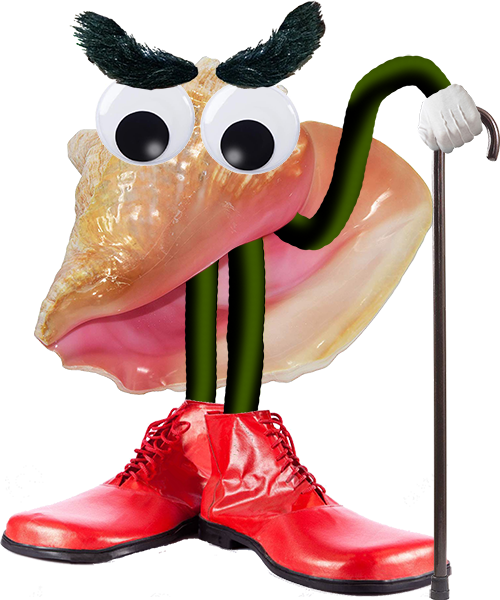
The Bat God's sinister servant, Conch and Cane.
So far I'm definitely getting the feeling that Kuntz and Ward at least did a little more research on Aztec and Maya mythology between "Gods, Demi-Gods & Heroes" and Deities & Demigods. I mean, there are certainly issues with the "Central American Mythos" in Deities & Demigods, but the "Mexican and Central American Mythology" section in "Gods, Demi-Gods & Heroes" is downright ridiculous.
By the way, I was going to add that a "Sea Monster" isn't a specific, statted up monster in D&D, but I just double-checked the "Monsters & Treasure" book from the original D&D boxed set and huh, turns out it kind of was:
Sea Monsters posted:
As a general rule these creatures are more for show than anything else. However, they could guard treasure. The typical Sea Monster of mythology is equal in size to a Purple Worm, and they work upwards from there to double or treble that size. The best guide is a book on prehistoric life forms, from which the referee can pick a number of suitable forms for his Sea Monster. Typically, hits from a Sea Monster would inflict 3 or 4 dice of damage.
The "Sea Monsters" entry in the "Monster Reference Table" isn't particularly helpful, though; while most monsters' entries in the table include "Number Appearing", "Armor Class", "Move in Inches", "Hit Dice", "% In Lair", and "Type or Amount of Treasure", the "Sea Monsters" row just says, in its entirety, "All variable and at referee's discretion". So "an intelligent Sea Monster of 20 hit dice" still isn't terribly specific.
One last note: Camazotz is one of only two gods in this chapter who comes from Maya mythology rather than Aztec.
CHALCHIUHTLICUE (goddess of running water and love)
Chalchiuhtlicue posted:
Also known as the "goddess of the jade petticoat", this goddess is not only a water deity, she is the goddess of chaste love.
Is there a goddess of unchaste love, you might ask? Yes. Yes there is. We'll get to her.
Chalchiuhtlicue posted:
In any of these aspects, she uses her power for the good of the beings that she is favoring at the time.
Unlike most gods, who of course use their power to benefit beings they actively dislike.
Anyway, she's chaotic good, and you can get her help by sacrificing high-quality jade by tossing it "into a bottomless pool of water in one of several such areas in the mountains." (As we all know, the mountains of Central America have bottomless pools of water all over the place.) Also, the sacrifice must be carried out "by the light of the full moon, and there must be no other being within a mile of the area." If all that is done, there's a 1% chance that she'll help (unless you're a priest performing the sacrifice on behalf of the needy, in which case the chance goes up to 25%). Which seems to contradict a sentence in the previous paragraph that said that "[t]hose that sacrifice to her (of any alignment) can expect her help if the proper forms are observed"—I mean, I wouldn't necessarily expect something that only has a 1% chance of happening.
Another interesting note:
Chalchiuhtlicue posted:
She also has the unusual ability to transform 3-300 beings into any single form she wishes (usually fish). This ability is used only to save the lives of devout worshipers.
Do situations really commonly come up where the lives of her devout worshipers can be saved by the transformation of three hundred people into fish? Okay.
The last sentence of her entry just says that "Chalchiutlicue [sic] is the wife of Tlaloc." I'll be coming back to that when we get to Tlaloc.
Chalchiuhtlicue also appeared in "Gods, Demi-Gods & Heroes", but only as the otherwise nameless "Goddess of the Jade Petticoat", and with a total of two brief sentences of description. But hey, at least, unlike Quetzalcoatl's and "Tezcat"'s, her entry in "Gods, Demi-Gods & Heroes" doesn't include anything drastically wrong. Though I do wonder, given the brevity of her entry and the fact that she's a water deity (even though "Gods, Demi-Gods & Heroes" doesn't say that), whether perhaps the three misfit servants of Tezcat were intended to be hers, and were put in Tezcat's entry by mistake...
(Okay, full disclosure here... unlike Deities & Demigods and the other first-edition books, I don't actually own a print copy of "Gods, Demi-Gods & Heroes". I'm going by a PDF for that, and it's possible that some mistakes were made in the conversion. That wouldn't explain things like the erroneous reference to Kukulkan being an Incan name, but might explain things like Chalchiuhtlicue's servants maybe being put under Tezcat instead. Or it might not, but I figured I should acknowledge the possibility.)
HUHUETEOTL (fire god)
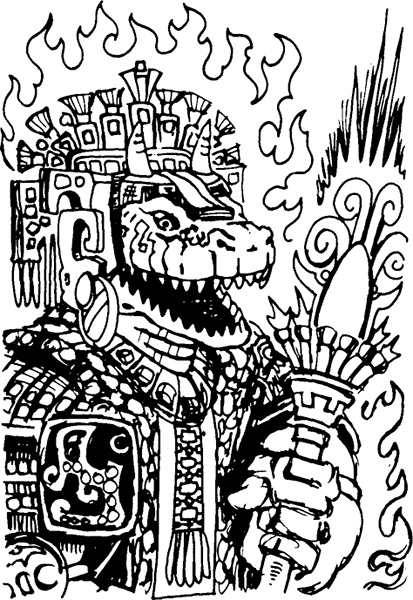
"I'm just happy to be here!"
Huhueteotl posted:
Physically, Huhueteotl appears to be a demon with a humanoid body, reptilian facial features, flames shooting all around him, and hair patches where his red gem armor does not cover him.
In Aztec iconography, Huhueteotl was usually depicted as a wrinkled old man, but sure, Deities & Demigods, you do you.
Anyway, we're told that Huhueteotl "requires frequent human sacrifice", and then in the very next sentence that "[s]acrifices are in the form of valuable articles of clothing and or gems and jewels", which I cannot help but note are not usually considered human.
Huhueteotl posted:
The god is also in charge of keeping time in motion, and in this capacity must have a special sacrifice of gems, feather robes, and humans every 52 years. During the fifty-second year, the god has the ability to stop the motion of any one thing in any single day. In this stopped state, that thing cannot be harmed by any force in the Prime Material Plane.
Presumably this is based on the Aztec and/or Maya calendars, both of which included fifty-two-year cycles. Why exactly Deities & Demigods associated this cycle with Huhueteotl in particular, though, I'm not sure, since he doesn't seem to have mythologically had any special connection to it. Other questions raised by this paragraph and unanswered: What makes the "special sacrifice" different from the normal frequent sacrifices Huhueteotl requires? What happens if he doesn't get the sacrifice?
HUITZILOPOCHTLI (god of war)
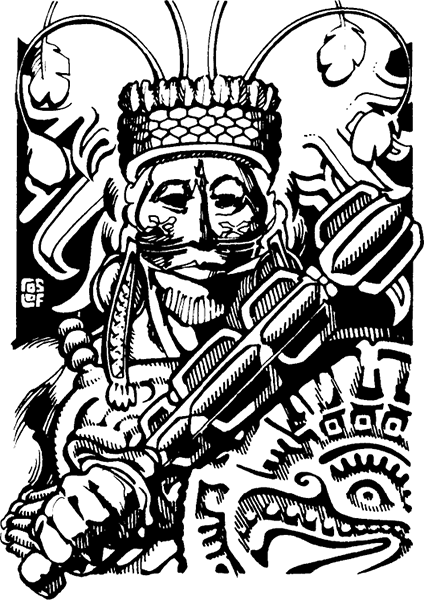
The text says his headdress is made of hummingbird feathers. That must have been a really unusual hummingbird.
Huitzilopochtli is neutral and completely antisocial. Commune spells don't work with him; "[h]e can rarely be called upon for any non-warlike situation", and while he may "appear on any battlefield where his worshipers are fighting and aid them", "this will not be in such a manner to make sure his side will win." (So... he'll pull his punches? He'll take out one enemy, declare "My work here is done", and go away?) Sacrifices can only be made to him in battle ("and only by fighting clerics"), which seems like it would be difficult, unless just slaying an enemy counts as a sacrifice, but the text doesn't say that.
If a sacrifice is (somehow) made to Huitzilopochtli, though, there's a 5% chance he'll show up, in which case he "will take the body of a dead warrior that won great victories either during that battle or in the past." Which turns out to be a good deal for the dead warrior, because "that warrior will be raised and live a long and lucky life", whether Huitzilopochtli's side wins the battle or not. (The text even quantifies exactly what it means by "lucky": "This luck takes the form of a +3 on all saving throws.")
Huitzilopochtli was apparently considered primarily a god of war in early myths, but in later myths he took on other aspects as well and became the supreme god of the rulers of the Aztec Empire and the patron god of the city of Tenochtitlán (which would become modern Mexico City). You know how the Mexican flag depicts an eagle perched on a cactus and holding a snake its beak? That's based on a mythological account of an omen sent by Huitzilopochtli to show where the city of Tenochtitlán should be founded.
In "Gods, Demi-Gods & Heroes", Huitzilopochtli didn't have the ability to possess (and raise) a dead warrior, but he did have other special abilities: all fighters below 10th level would "fight him as if a slow spell had been placed upon them", while all fighters above 10th level would "see two exact duplicates of this god when engaged in combat with him." I guess fighters who happened to be exactly 10th level could fight him without any special drawbacks?
HUNAPU AND XBALANQUE (twin heroes)
Well, we may only have two good-aligned gods, but at least we have two lawful good heroes, though they're "legendary for their thirst for revenge", which... doesn't sound all that lawful good to me? (Also, they have levels as druids (in addition to as rangers and magic-users), which shouldn't be possible in first edition for lawful good characters, but as we've already seen the heroes in this book make no apparent attempt to follow the rules for player characters.)
Hunapu and Xbalanque posted:
Their father was killed by beings of the underworld and so they went down and defeated these beings in games and battle.
All the rest of the text is about their combat abilities, which I guess is a little more excusable than combat abilities for gods, though I'm still not sure why PCs would want to fight these guys. They use poisoned blow gun darts, and are slightly resistant to cold and fire for some reason.
The twin heroes—or "Hero Twins", as they're more often called among anthropologists, appear in the Popol Vuh, the oldest known account of Maya mythology. (Camazotz the Bat God also appeared in the Popul Vuh, sort of, but there the word seems to have been used to refer to a type of demonic bat creature rather than an individual entity.)
ITZAMNA (god of medicine)
Itzamna posted:
Itzamna normally appears to men in the guise of a toothless old man, with sunken cheeks and a Roman nose, leaning on a crooked staff. However, he may also assume the form of light in one of its myriad aspects, e.g. a blazing globe, a fading ember, or a dusty moonbeam, and when in this guise he may take on any size.
Itzamna is a lawful good god who "often travels in the world of men", and who "is often called upon by his clerics to intercede for man with the other gods in times of calamities and sicknesses." He is the son of Tezcatlipoca, whom we'll be getting to in a bit, and if he's "ever in a desperate situation he will call upon his father for help", despite his father being of the exact opposite alignment.
Although the text says he is "by no means a weakling", neither he nor his clerics like to fight. Itzamna's clerics "are loath to do combat unless there is no other recourse", and Itzamna himself "rarely relies on the strength of his arms" in his dealings with other gods. (Do other gods rely on the strength of their arms in dealings with each other? Do they engage in combat with each other, or just arm wrestle?)
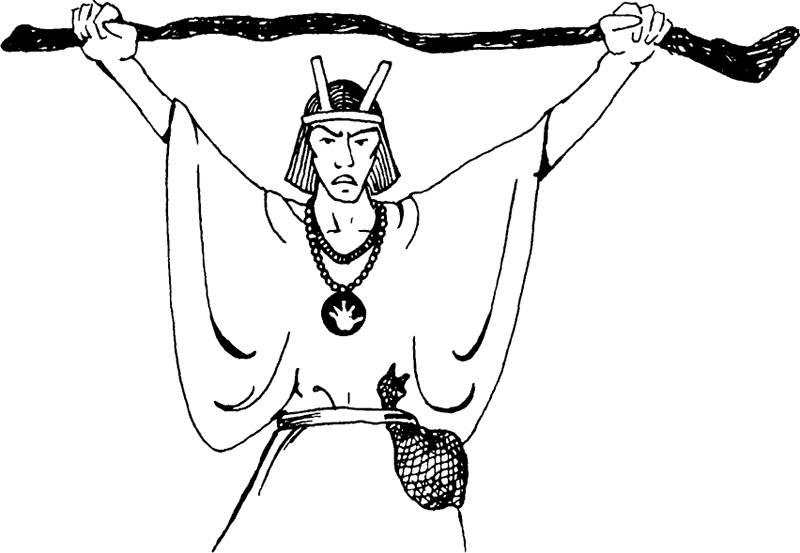
We don't get an illustration of Itzamna himself, but we do get a picture of one of his clerics.
Like Camazotz and the Hero Twins, and unlike any other entity from this chapter, Itzamna comes from Maya mythology rather than Aztec. He's a creator god and was according to at least some accounts the most powerful and most important Maya deity, though he was also the patron god of medicine, so fair enough.
Incidentally, how did a Maya god become the son of an Aztec god? I don't really have an answer for that; I have no idea where the bit about Itzamna being the son of Tezcatlipoca comes from. Maybe the authors just added that to try to connect the mythos together, but then in the original myths Quetzalcoatl, Huitzilopochtli, and Tezcatlipoca were brothers, and they didn't include that, so... who knows.
MICTLANTECUHTLI (god of death)
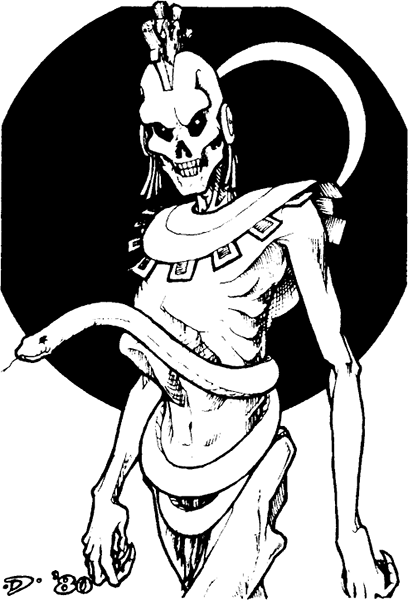
That snake is a daring fashion statement.
Mictantecuhtli posted:
The god usually appears in a lich form, and no undead is able to resist his commands. At any given time, he can instantly summon 20-200 skeletons, 10-100 ghouls, 6-36 wights, and 2-5 spectres. He can be summoned only after at least 50 live human sacrifices have been given the god in worship. The god demands these lives during the dark of the moon and requires them from the ranks of his worshipers.
So he requires his worshipers to sacrifice each other? In numbers of fifty at a time?... Must be hard to get new recruits. Oddly, his stats include "WORSHIPER'S ALIGN: All alignments", so I guess there are lawful good worshipers of this evil god of death who don't mind slaughtering each other at their deity's whim. Hm.
Then of course we get a paragraph of his combat abilities, which... I'm not going to bother with.
Mictlantecuhtli is basically the same in "Gods, Demi-Gods & Heroes", although he's said to appear as "the skeletal figure of a man" rather than a lich, and the numbers of undead of each type that he can command are multiplied by a factor of ten. (Exactly a factor of ten, as a matter of fact; apparently when writing Deities & Demigods Kuntz and Ward decided he should only command one-tenth the numbers of undead he did in "Gods, Demi-Gods & Heroes", for some reason. I mean, sure, I wouldn't like to try to run a combat involving two thousand skeletons, but ease of running doesn't seem to have been much of a concern in most of these entries.)
Oh... also, at least "Gods, Demi-Gods & Heroes" doesn't put up with that "All Alignments" business:
Mictantecuhtli posted:
Any person that worships this God is definitely worshipping Chaos itself, since Mictantecuhtli craves death. Human sacrifice is very prevalent with this god.
TEZCATLIPOCA (sun god)
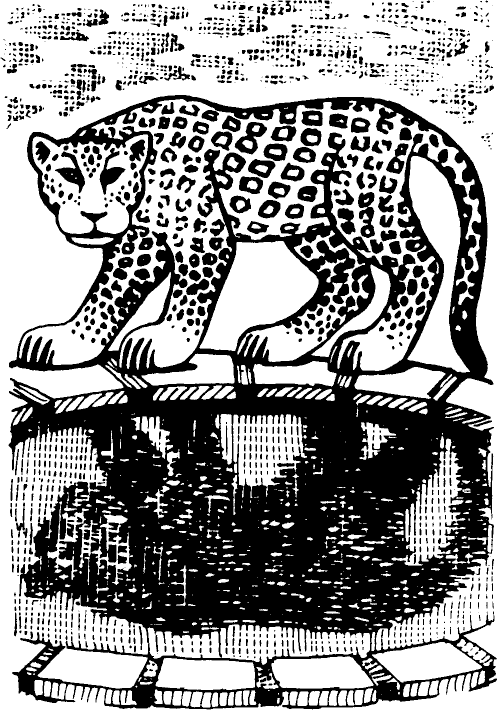
I'm kind of guessing this jaguar was drawn without photo reference.
Tezcatlipoca posted:
Tezcatlipoca (which means "the smoking mirror") is the god of the sun who ripens the crops but also brings drought and famine. Conversely, he is also the god of the moon and the night. Tezcatlipoca and his followers are always plotting the overthrow of Quetzalcoatl, and this god is the patron of treacherous schemings and betrayals.
The part about plotting the overthrow of Quetzalcoatl does have a basis in Aztec mythology. Tezcatlipoca and Quetzalcoatl were co-creators of the world who then became enemies and rivals. One account has Tezcatlipoca as the original ruler of the gods until Quetzalcoatl usurped him; another has Quetzalcoatl as the original leader who was supplanted by Tezcatlipoca. At least one account even has Quetzalcoatl taking Tezcatlopoca's place as the leader of the gods and then Tezcatlopoca later throwing him down and taking it back.
I'd say the part of this paragraph that's least faithful to the original myths is making him the god of the sun... Tezcatlipoca was the god of many things, but the sun doesn't seem to have been one of them. Well, that and making him a "patron of treacherous schemings and betrayals"... sure, he was an enemy of Quetzalcoatl, but the myths weren't really clear on who betrayed whom, or whether their conflict really involved any betrayal at all. Still, here Kuntz and Ward apparently decided to make Tezcatlipoca the unambiguous, chaotic evil bad guy.
Tezcatlipoca rarely takes human form, and when he does it's "to masquerade as someone else in the furtherance of one of his schemes". More often, he appears as a giant jaguar or a bear, and more often still he doesn't appear in physical form at all, and just "prefer[s] to remain invisible and intangible." (Is that a thing all gods are supposed to be able to do? Because nothing under the "Standard Divine Abilities" in the first part of this book gave that impression.)
Tezcatlipoca posted:
Once a year, at a great religious gathering, Tezcatlipoca's priests sacrifice a young, perfect human male and offer the god his heart. These sacrifices (usually war prisoners) are pampered and feted for a full year before the ritual. Though they are given almost anything they might desire during this period, they always end up on the altar.
This actually was a real thing, and did go down pretty much as described here. So... hey, at least this book isn't totally historically inaccurate.
Tezcatlipoca posted:
Tezcatlipoca is a spreader of disorder and war, but also an originator of wealth.
He is large; he contains multitudes.
Tezcatlipoca didn't appear in "Gods, Demi-Gods & Heroes"... but a different sun god did, Tonatiuh. In the previous cases we've seen so far of a god from "Gods, Demi-Gods & Heroes" being renamed in Deities & Demigods (Donn to Arawn, Medhbh to Morrigan, Tezcat to Camazotz), at least part of the original description was carried over intact. Here it isn't; aside from the fact that they're both sun gods there really isn't anything the descriptions of Tonatiuh and Tezcatlipoca have in common. (Among his other powers, Tonatiuh "may cause great draughts [sic] and... can form something like the 'Death Valley U.S.A.' in about one week's time.") So I'm not sure in this case whether it's a matter of Tonatiuh being renamed to Tezcatlipoca, or of Tezcatlipoca being added and then Tonatiuh being removed because the authors judged him redundant. In any case, unlike Tezcatlipoca, Tonatiuh really was a sun god in Aztec mythology, as well as a patron of warriors, which makes him somewhat redundant not with Tezcatlipoca, who has no business pretending to be a sun god, but with Huitzilopochtli, who is one, and who ended up overshadowing Tonatiuh in later Aztec mythology.
TLALOC (rain god)
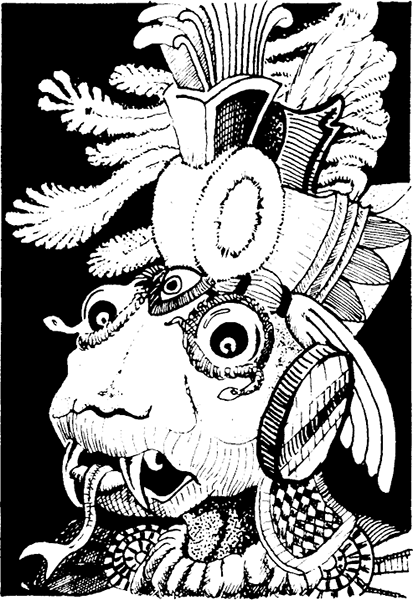
Doesn't this look like a Charisma 19 kind of face to you?
Tlaloc posted:
With his great tusks and goggle eyes, Tlaloc's appearance is quite impressive. He wears all black but for a garland of white feathers.
Anyway, we get a whole paragraph about how priests regular sacrifice children and babies to him. ("WORSHIPER'S ALIGN: All who need rain. So lawful good people who need rain are okay with cooking babies, apparently.) In accordance with his lawful evil alignment, I guess, he does ("usually") grant rain to his worshipers if they've been carrying out all the sacrifices and rituals, but if not, he'll punish them.
Tlaloc posted:
Tlaloc has four pitchers of water: one filled with good water to make crops grow properly, one filled with water that contains spiders' eggs and webs and causes blight, one filled with water that turns to frost, and one with water that rots all fruit.
And then we get a paragraph about his combat abilities, because this is Deities & Demigods.
In Aztec mythology, Tlaloc was generally considered a relatively beneficent god... but on the other hand, children really were sacrificed to him, so okay, I'll accept his evil alignment. (Even the part in Deities & Demigods about how "[i]f the babies cry during the sacrifice, this is taken as a good sign that rain will be abundant during the coming year" has a historical basis.) Then again, child sacrifices were also made to Quetzalcoatl and Chalchiuhtlicue (albeit less frequently), and neither of them is evil, so... uh...
Oh, speaking of Chalchuihtlicue, remember how she was the wife of Tlaloc? Note that Chalchuihtlicue and Tlaloc have diametrically opposite alignments. I can't imagine that's conducive to a lot of marital harmony. Of course, we touched earlier on the fact that the father/son pair of Tezcatlipoca and Itzamna also have opposite alignments. There's a lot of family disagreement among the gods of the Central American Mythos, it seems.
TLAZOLTEOTL (goddess of vice)
 (Link to image on external site due to mild NSFWitude)
(Link to image on external site due to mild NSFWitude) 
Tlazolteotl posted:
When this goddess is under stress, rushed, or being attacked, she appears as an incredible monster, with a humanoid body, demonic face with fangs and blazing eyes, talons for the ends of her feet and hands, and a black warty skin with a slick, greasy look. This is an illusion, however. When she is at ease, before her worshipers, working on a victim, or in front of many strangers for one reason or another, she appears as a beautiful woman...
All right, that's actually kind of different; most of the time when you get a monster or some other entity with a hideous monster form and an attractive human form it's the monster form that's the true form and the attractive human form that's the illusion. So okay.
I stopped the quote in the middle of a sentence there, so let me continue with the rest of it.
Tlazolteotl posted:
...she appears as a beautiful woman capable of inspiring desire in any male and jealous respect from any female.
Because gay men don't exist in first-edition Dungeons & Dragons, apparently. (Or her powers make even gay men desire her, but, uh, I don't think that's really much better.) Or asexuals, for that matter, I guess. Okay, it's not fair to single Deities & Demigods out for this; I don't think any games were doing much to acknowledge nonheterosexuality in the eighties; but I still didn't want to let that pass without comment.
Also, "jealous respect"? Isn't that a bit of an oxymoron?
Anyway, Tlazolteotl is chaotic evil and "tries very hard to ruin lawful good beings all over the Prime Material Plane" apparently just because that's what chaotic evil does. She usually fights with magic, especially charm spells, and doesn't fight physically at all: "if met with beings that cannot be hurt by spells, she will teleport away." She has fifteen levels as an assassin, though, and no compunction about using those; assassinating people doesn't count as fighting physically, apparently. Also, "[n]o evil being can even think of harming her, even if they are magically controlled", which is weird, because I didn't think evil was really known for its sense of team spirit, but whatever.
Tlazolteotl was in fact an Aztec goddess of vice, but she was also a goddess of garbage and decomposition, which I think might somewhat cut down on her allure... I'm not sure most men would really be so sorely tempted by someone known as the "Eater of Filth". To be fair, though, she was known to inspire licentiousness, so even if the Deities & Demigods description doesn't capture all her aspects it's not completely off. (Though the "incredible monster" bit does sort of come out of left field.)
XOCHIPILLI (god of gambling and chance) "Lord of Flowers"
Xochipilli is a neutral god who "almost always appears as a young man" and who "can often be found wandering among the people bestowing good and bad luck in the form of lost or granted saving throws." There's no mention of how he decides whether to grant good luck or bad luck, so maybe he just does it at random, although we are told that he "is most pleased with beings that take a large calculated risk." We're also told that he is "predominantly a peaceful being" (I guess giving people bad luck isn't technically attacking them), and that he "gives a great deal of happiness to his followers"... which seems to imply either that he always gives his followers good luck, or that they're just really good sports.
In Aztec mythology, Xochipilli wasn't a god of gambling; he was a mischievous but benevolent god of beauty, flowers, creativity, love, alcohol, and revelry. Incidentally, apropos of what I just mentioned about ignoring nonheterosexual orientations, he also seems to have been a patron of gay men and male prostitutes. (He also had a sister, Xochiquetzal, not mentioned in Deities & Demigods, who may have played a corresponding role for women.)
Anyway, that's the last god in the chapter, and we don't get any new spells or magic items this time, though I guess it may be worth mentioning that several gods have some kind of animal totem listed as their symbols. Mictlantecuhtli's symbol is a "dog totem (itzcuintli)", Tlaloc's is a "deer totem (mazatl)", Tlazolteotl's is an "ocelot totem (ocelotl)", and Xochipilli's is a "monkey totem (ozomahtli)". Nowhere is it explained what these "totems" actually are, or what they're made of. I don't recall ever having used this mythos in a campaign myself, but I guess for all its inaccuracies it's serviceable enough, though I'm still not sure what's up with the whole "parallel universe" thing.
Oh, it just occurred to me, there's one more thing that this chapter (and some others, but especially this chapter) could probably have used: a pronunciation guide. I'm guessing the average D&D player back then (or now, for that matter) would have no idea how to pronounce most of these names. Then again, I'm guessing Kuntz and Ward probably didn't know how to pronounce them either.
Next time: It's Like The Office, But With Gods
It's Like The Office, But With Gods
Original SA post Deities & Demigods 1EPart 9: It's Like The Office, But With Gods

I get what the artist was going for with the faux-brush-strokes technique for the title, but I don't think it really works.
We start out with a paragraph that commits the same absurdity as the "Mexican and Central American Mythology" section in "Gods, Demi-Gods & Heroes":
Chinese Mythos posted:
The title of this section is somewhat misleading, as the mythology of the Chinese is so vast and varied that it is impossible to cover it adequately and remain within our size restrictions. We have chosen the deities we feel most appropriate for inclusion.
Okay, but again, isn't this true of all the real-world mythologies they included? They certainly didn't include every god from Celtic mythology, or Babylonian, or Central American. Didn't they just choose the deities they feel most appropriate from them as well? At least it's a little better here in that they didn't technically imply that their treatments of other mythologies are complete, only that they're "adequate", but still... are their treatments of other mythologies in other chapters really more "adequate" than their treatment of Chinese mythology here?
Well, whatever.
Chinese Mythos posted:
The Chinese image of the Heavens is that of a great bureaucracy. Many of the deities exist to perform a special task and watch over a special area of life. Each god is supervised by a more important deity, who is responsible for seeing that things are done correctly. Every being is accountable to the Emperor of the Heavens. Every year the gods send reports to their supervisors, and it is not uncommon to be promoted or demoted for work done during the year.
Okay, all this talk of reports and promotions and demotions is making me think less of a vast quasigovernmental bureaucracy and more just a typical, somewhat inefficiently run business. I mean, I guess there are similarities between the two, and one could easily argue that most businesses are bureaucracies (and conversely that demotions, promotions, and reports do happen in governmental bureaucracies as well), but that's what it makes me think of, and I'm not sure that's the kind of bureaucracy the writers have in mind. I'm picturing the other gods sitting around a big conference table while Yen-Wang-Yeh shows them a PowerPoint presentation, except he can't get the remote he's using to work right and keeps bringing up the wrong slides, and he's getting increasingly nervous as Shang-Ti is shaking his head and Lu Yueh just keeps scarfing down donuts...
Anyway, we're told that the emperor is both the head of state and the head of the church "(thus gifted with high priest powers by the gods)", that clerics "travel about the countryside preaching to rich and poor alike", and that worshipers atone for their misdeeds by sacrificing valuable items.
Chinese Mythos posted:
If the deed was severe enough (judge's option as to this in AD&D terms) the atonement might even be death.
The reason for this is explained in the sixth slide in Yen-Wang-Yeh's PowerPoint presentation, which he'll be glad to show you in just a moment; he—no, wait, that's a photo from his vacation last summer; that's not supposed to be here...
This is another mythos that did appear in "Gods, Demi-Gods & Heroes", but there it was called the "Eastern Mythos", because Eastern = Chinese, apparently. All of the same gods appeared there as here, all but two or three with the same names (plus or minus a hyphen); I'll only comment on their presentation there if there's an interesting difference. There are also a few beings, though, that appeared in "Gods, Demi-Gods & Heroes" but not in Deities & Demigods, and I'll cover those at the end of this post.
I will, though, again, quote the introductory paragraph of the section in "Gods, Demi-Gods & Heroes":
Eastern Mythos posted:
The mythology of the Far East is varied and colorful. In dealing with it, the concepts of Yin and Yang must be defined. These are the Chinese equivalents of bad and good. These opposites are almost beings in themselves and move all Gods and creatures in a war for supremacy. In using eastern Gods one should always think of them as not lawful or chaotic, but having good Yang or bad Yin.
Defining "Yang" as "good" and "Yin" as "bad" is of course a severe oversimplification, but I think this is kind of interesting in suggesting a different alignment axis than the typical law-chaos of OD&D and Basic. (And, apparently, different from the later good and evil added to AD&D, since it seems to make a point of saying "bad" rather than "evil".) I mean, of course "Gods, Demi-Gods & Heroes" doesn't actually do anything whatsoever with this, but it's at least potentially interesting in theory.
(Well, almost nothing; the description of one god, Huan-Ti, does mention that "[w]hen hard pressed, he draws a plus 3 sword with the purpose of slaying all things Yin.")
Oh, we also get this note at the very beginning of the section:
Eastern Mythos posted:
Note: Unless otherwise specified, treat as Psionic Ability: Class 6
This note is entirely unnecessary, since the psionic ability of every god is, in fact, explicitly specified. (And yes, most of them are Class 6, which means they have no psionic abilities, but they're "invulnerable to any kind of psionic attack.")
As we'll see, while many of the gods in this section go back thousands of years, there are some of them that are still worshipped today, so... this is another of those chapters that comes across as kind of tone deaf at best (and horribly offensive at worst). Well, at least the book doesn't include any stats for famous Chinese historical figures like Confucius or Lao Tzu. No, they saved that for second edition.
It might also be worth mentioning that of course there are multiple ways to transliterate Chinese names; Deities & Demigods usually uses the Wade-Giles romanization scheme. Nowadays, the Wade-Giles system has mostly fallen out of favor and been largely supplanted by Pinyin, but at the time Deities & Demigods was written Wade-Giles was the system in the most widespread use, so the authors can't really be faulted for using it. What they can be faulted for is leaving out the apostrophes and umlauts that have important significance in distinguishing between phonemes, but oh well. Anyway, for consistency with the Deities & Demigods convention, I'll use Wade-Giles romanization for the gods and other entities in this post, though I'll also include parenthetically the Pinyin transcription and (when I can find it out) the actual Chinese spelling. (I did stick to the now-standard Pinyin system for the names of Chinese dynasties and places. Also, I should note that I can't actually speak or read Mandarin or any other Chinese language, and it's very possible I've made some mistakes here in the transcriptions.)
Before we get to the gods, we get brief descriptions of a baker's half-dozen magic items:
- The CANON OF CHANGES, a magical "book of the gods" that maybe is based on the I Ching, though I'm guessing that only based on the name (the I Ching is also called the "Book of Changes"), and not on the description, which doesn't have anything obvious to do with the I Ching at all. The Canon of Changes "deals with redistribution of matter and motion" and "allows the reader to create any nonmagical object instantly when the command words are spoken"—but it takes 72 hours to learn the command words for each object, and "[o]nly immortals have the constitutional stamina to read the passages for the length of time required", so I guess it's useless for PCs.
- The DANCING SWORD OF LIGHTNING, which does exactly what you'd expect from the name except that it only works for gods and demigods and "performs as a normal sword when held by mortals". (Again with the items only useable by gods... kind of limits their uses in a campaign.)
- FIRE GEMS, which shoot flame and have 2-12 charges. Also, there's nothing this time that says that only gods can use them, so hey, that's a plus.
- The GIANT BLACK PEARL, which is three feet in diameter (I guess? It just calls it a "3 foot sphere", so I'm assuming that's diameter, not radius) and automatically "negates all wind and earth turbulence in a one mile radius".
- The IRON WAND, which can make invisible things visible, or vice versa; acts as "a staff of striking with unlimited charges"; and will on command grow to a hundred feet long and "become roughened for easy climbing"
- The JADE SCEPTER OF DEFENDING, which allows no one to strike its master with any material weapons as long as its master concentrates on it (during which time "no other action may even be contemplated.")
- WIND FIRE WHEELS, which "are used in large battles where the gods fear that they might be defeated." (By whom, exactly? Who is out there threatening the gods in large battles?) Only 25 of these exist, and they're distributed among "the demi-deities and their servants" by the head of the gods, Shang-Ti. They are "1 foot circular fans" that require a command word to activate and "shoot fire and/or wind like a staff of the magi", but they also draw a hit point from the user for every 5 charges expended. The text doesn't say how many charges they have, but I guess we can infer it's the same number of charges as the staff of the magi? Also, what happens if the charges run out? When a staff runs out of charges in 1E, it "become[s] forever useless", crumbling to powder as its last charge is expended." Does that happen to the wind fire wheels as well? And if so, does Shang-Ti make more of them to replace the ones that are used up? Or are they a non-renewable resource and once they're gone, they're gone? None of that is addressed here.
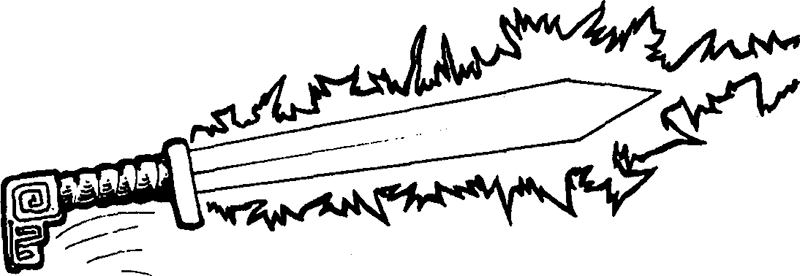
Only the sword gets an illustration, because, hey, everyone knows what a wind fire wheel looks like, right?
Anyway, now for the gods. Once again, I'll try to discuss the real mythology behind the god as far as I can find it, but, once again, I'm by no means an expert in Chinese mythology, and I may make some mistakes. (Actually, you can just assume this disclaimer applies to every chapter.) Anyway, we'll start with the god whose name has already been mentioned:
SHANG-TI (supreme god of the heavens, god of the sky and agriculture)
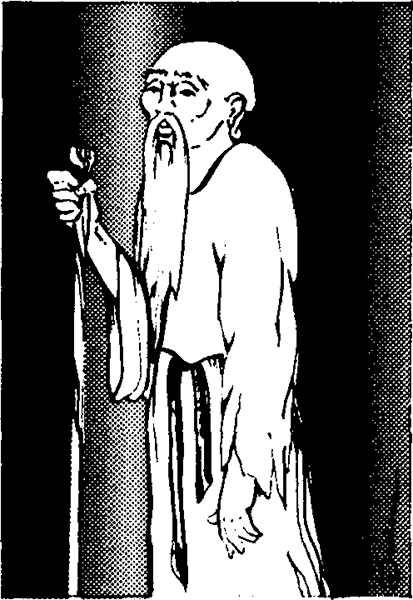
Only the head of the Celestial Bureaucracy gets the privilege of screentone.
Shang-Ti posted:
Shang-Ti is the head of the Celestial Bureaucracy, and all the other deities ultimately report to him. His word is law among all of the gods and goddesses, regardless of their alignment, and he is the final arbitrator in any dispute among them.
So why is his word law to the chaotic and evil gods, exactly? Does he enforce it by strength of arms? Or is the idea that honor and tradition are so important to this pantheon that even the chaotic evil gods wouldn't think about going against their leader? Or did the authors just not think it through?
Shang-Ti posted:
Shang-Ti can sometimes be found travelling among mortals. On these occasions he appears to be an aged man with a long white beard, dressed in tattered robes.
No word on how he appears when he's not travelling among mortals. (Okay, we do also get a sentence about how he "also likes to float in the air ethereally, viewing cities and towns and the manner in which he is or isn't being worshiped", but still, what is his true form? How does he appear when he's just hanging out in his realm in Nirvana? (Yes, I know the name "Nirvana" comes from Indian tradition, not Chinese, but that's the lawful neutral Outer Plane in first-edition D&D, and that's where Shang-Ti lives.) I mean, sure, he's a god, and so one could try to argue that he doesn't have a true form and is inherently just an intangible presence, except that that's certainly not how things seem to have worked for any gods so far.
There are a few more paragraphs in Shang-Ti's description that I skipped, but, well, they're mostly about his combat abilities. I think from here on out I'm going to stop even mentioning that there are parts I skip about the gods' combat abilities. Just take it for granted that the descriptions of most if not all of the gods do include useless information about their combat abilities, but I'm not going to comment on it unless I think there's something particularly noteworthy about it.
Anyway, Shang-Ti (上帝; Shàngdì in Pinyin) was in fact the supreme god of the people of the Shang dynasty (roughly 1600 B.C. to 1046 B.C.), though he was considered a remote god who wasn't actively worshipped. The word is still sometimes used in China to refer to other concepts of a supreme being, including the god of Christianity.
CHAO KUNG MING (demigod of war)
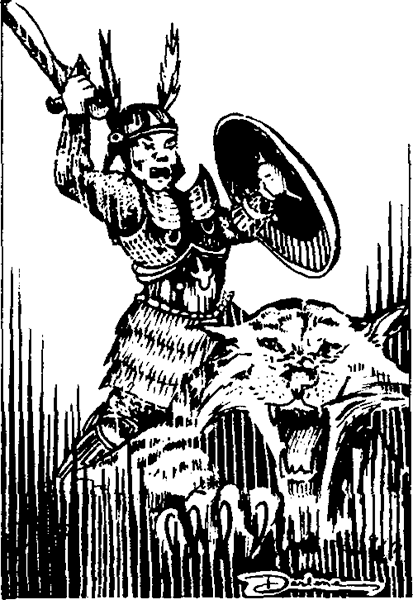
"Let's go, Battle Cat!"
Chao Kung Ming "appears as a very muscular man with bright red skin", lives in the Elemental Plane of Air for some reason, and "is able to travel from plane to plane with however many beings he wishes." Really? However many? There's no limit? So if he wanted to transport the entire population of the Material Plane to the Abyss, he could just... do that? I mean, he's neutral good, so he probably wouldn't want to do that, but still...
Chao Kung Ming posted:
He rides a giant flying tiger into battle
We get a brief stat line for the giant flying tiger. Alas, based on that illustration it certainly isn't a giant realistic flying tiger.
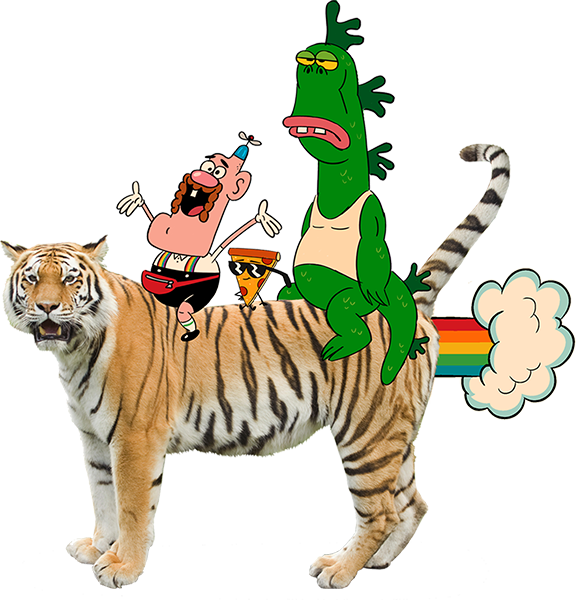
"Good morning!"
Chao Kung-Ming (趙公明; Zhào Gōngmíng in Pinyin) was a hermit with magical abilities that he used to support the Shang dynasty. (He may or may not have been based on a real historical person, but if so, needless to say, the historical Chao Kung-Ming presumably did not have magic powers.) He was identified with Ts‘ai Shen (財神; Cáishén in Pinyin), god of wealth. Exactly what induced Kuntz and Ward to make him a god of war, I have no idea. (Especially when there's another god of war anyway... I guess this is a case of bureaucratic redundancy.) I thought maybe they'd confused him with a different god, but Caishen was said to ride a tiger (albeit a black tiger that was not necessarily giant or flying), so... I don't know. (Unlike Deities & Demigods, "Gods, Demi-Gods & Heroes" does mention that the tiger is black, but not that it's giant.)
CHIH-CHIANG FYU-YA (god of archers, punisher of the gods)
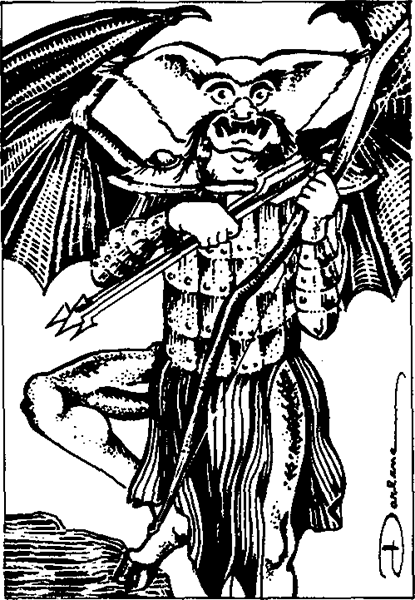
That's a really weird way to hold arrows.
quote:
This god has fiery red skin resembling scales, a black demonic head with tusks, elephant ears, a large set of leathery wings with a span of 40 feet, a humanoid body, and cloven hooves.
According to the description, he's eight feet tall. A forty-foot wingspan would therefore be five times his height. That seems... a bit excessive. I guess it's not completely out of the question—the wingspan to body length ratio of the greater flying fox is not too much less than that—but it doesn't look that big in the illustration. Then again, I also don't see anything in the illustration that I'd call tusks...
quote:
It is the duty of Chih-Chiang Fyu-Ya to avenge offenses against the gods, particularly desecration of temples.
This guy was a hard one to track down the basis for, and I almost gave up and was going to just conclude that Kuntz and Ward must have just made him up. I wouldn't be the first person to reach that conclusion—a poster on the Giant in the Playground forum said this god "appear[ed] to be a complete fabrication". Not helping matters is the fact that "Fyu" isn't even a valid syllable in the Wade-Giles system of Chinese romanization... or any other major Chinese romanization system, as far as I know.
Deities & Demigods has a (brief) biblography (which we'll get to in the last post), and it includes one book specifically on Chinese mythology and one on "Asiatic Mythology"; both books, as it happens, are now freely available online at archive.org, so I thought I'd check them out and see if I could find any god in either of those books who bore any resemblance to Chih-Chiang Fyu-Ya. I couldn't. Of course, Chih-Chiang Fyu-Ya had also appeared in "Gods, Demi-Gods & Heroes", and he may have gotten into Deities & Demigods just because he was in there, and "Gods, Demi-Gods & Heroes" didn't have a bibliography, so who knows what the authors' sources were for it? In fact, as previously mentioned, all the gods in Deities & Demigods appeared in "Gods, Demi-Gods & Heroes", so it seems likely that it was "Gods, Demi-Gods & Heroes" that was the real source for this chapter, and the reason those two books are listed in the bibliography was less "Here are the sources we used to research this chapter" and more "Here are two books we found after this chapter was written that you can maybe read for further inspiration, though we didn't read them ourselves."
Nevertheless, it turns out Chih-Chiang Fyu-Ya wasn't a complete fabrication after all... he's just been butchered a bit. Well, a lot. There was a mythological figure, Ch‘ih Chiang Tzŭ Yü (Chi Jiang Ziyu in Pinyin; I haven't been able to find a source for how his name would be written in Chinese characters (or for that matter for the tones to include in the Pinyin transcription), and I've spent way too much time on this as it is), who was a companion of the Yellow Emperor (we'll get to him), and who eventually became Hou I (后羿, Hòu Yì in Pinyin), god of archers. Yeah, "Tzu Yu" and "Fyu Ya" are pretty different, but not so different that, say, if the authors had taken hand-written notes on their reading and then misread them later, they couldn't have made that mistake. Why didn't Kuntz and Ward just use the name "Hou I", which is much better known and more widely attested? Maybe they just liked the other name better, even if they didn't get it quite right.
Mind you, this still doesn't explain why he has a demon face or is especially concerned with avenging desecration of temples, neither of which seems to have been an attribute of Hou I, but as I think has been pretty definitively established by now the treatment of the gods in Deities & Demigods often bears only a tenuous relationship to actual mythology.
Hou I was the husband of the moon goddess Ch‘ang O (嫦娥; Cháng'é in Pinyin), who does not appear in this book.
CHIH SUNG-TZU (lord of rain)
Chih Sung-Tzu "appears as a very muscular man [who] always wears a blue war helm", and that's about all the description we get of him that isn't about his combat abilities. Well, okay, he also likes to ride a big storm cloud; I guess that's not a combat ability. I'm not sure why he rides the storm cloud, though, since he can fly on his own at twice the speed the storm cloud travels. Maybe it's just less tiring. Or maybe it's just so he can bring other passengers along with him. Like Chao Kung Ming, he lives on the Elemental Plane of Air, and at least in his case it makes a little more sense, since rain has more to do with air than war does. (Of course, rain is made of water, but it's not rain if it doesn't have air to fall through, I guess. Maybe it could have made sense to place him in between the planes of Air and Water, except that what's there is the Paraelemental Plane of Ice, so... never mind.)
This is one of the two or three gods that had their names changed between "Gods, Demi-Gods & Heroes" and Deities & Demigods—in "Gods, Demi-Gods & Heroes" he was called "Yu Shih". Mythologically, Ch‘ih Sung-Tzu (赤松子, Chìsōngzǐ in Pinyin), which means "Master Red Pine", is a mythological figure identified with Yü Shih (雨師; Yǔ Shī in Pinyin), god of rain, so those are more or less two names for the same god. I'm not sure why they decided to change the name in Deities & Demigods, especially since "Yü Shih" seems to be the name this god is better known by. Yü Shih is still worshipped today in parts of southwestern China, which makes his inclusion here a little inappropriate at best, but that's clearly not the reason for the name change... just wait till we get to the Indian mythos.
"Gods, Demi-Gods & Heroes" says that Yu Shih "looks like a man wearing plus 3 armor which seems to be rusting off his body", which is odd, because I never really assumed in D&D that +3 armor looked any different from +2 armor, or even from nicely made nonmagical armor. I'm pretty sure you're not supposed to tell the power of magical armor just by looking at it.
CHUNG KUEL (god of truth and testing)
Chung Kuel posted:
This god is always dressed in costly robes, and his primary ability is to draw from a well of knowledge so that he can meet any test with success, if given time to visit his well. In any physical contest, if his normal powers will not let him immediately win (and he will know if this is possible), he will always run and secure the materials that will allow him to win, and he will do nothing else until he does win.
"Wait, let's put this thumb-wrestling contest on hold for just a moment while I go get a monkey wrench."
Chung Kuel posted:
This god occasionally travels around the Prime Material Plane dressed as an old pot-bellied man with a long grey beard. He asks beings riddles, and if they answer correctly, he may grant them a reward, perhaps even a limited wish. The more difficult the riddle, the greater the reward.
"So here's my riddle: What materials should I use to win a thumb-wrestling contest? I'll give you a hint: the answer isn't a monkey wrench. Not sure what I was thinking with that one."
Like "Fyu", "Kuel" is not an permissible Chinese syllable, in either the Wade-Giles or the Pinyin romanization systems. (The only consonants or consonant digraphs that can end a Chinese syllable are n, ng, h (Wade-Giles only), or r (Pinyin)/rh (Wade-Giles).) Nevertheless, in this case it's easily explicable as a typo or misreading, similar to that that apparently turned Qagwaai into Qagwaaz in the "American Indian Mythos", or, for that matter, Chih-Chiang Tzu-Ya into Chih-Chiang Fyu-Ya on this very page. The actual name for this god is supposed to be Chung Kuei, with an I... or actually, it's supposed to be Chung K‘uei, with an apostrophe (鍾馗; Zhōng Kuí in Pinyin); like I said before, Kuntz and Ward leave out the apostrophes, but in the Wade-Giles transliteration those apostrophes are actually important. The typo, incidentally, goes all the way back to "Gods, Demi-Gods & Heroes", where he appeared with the same name, providing more evidence that the authors just copied the gods in this chapter from there without doing additional research or double-checking their sources (whatever they were).
Anyway, Chung K‘uei was best known for his ability to capture or drive off ghosts and demons, and even today images of Chung K‘uei are often placed in homes and businesses to keep away evil spirits. How he turned in Deities & Demigods into a god of "truth and testing" I don't know, but by this point I guess that's pretty much par for the course.
FEI LIEN & FENG PO "Counts of the Wind"
Fei Lien & Feng Po posted:
These beings figure prominently in all major battles of the gods, and are
often used as go-betweens for gods and men.
Again, what battles of the gods? We were told in Shang-Ti's entry that all the gods obey him regardless of alignment, and he settles disputes among them. So why are there battles?
Fei Lien & Feng Po posted:
They appear to be demonic creatures in that their skin is jet black, their eyes blaze fire and they are tusked.
They appear to be demonic creatures, but in fact they're neutral good. Actually, while it's sandwiched between the two evilest pantheons in the book, the Chinese Mythos is pretty benevolent overall. It includes six good gods, five neutral gods, and five evil gods, so while the good gods don't have a majority, they at least have a plurality. Also, this is the first pantheon that actually has gods of all nine alignments. So that's nice.
Anyway, Fei Lien (飛廉; Fēilián in Pinyin) and Fêng Po (風伯; Fēngbó in Pinyin) seem to have originally been two different wind gods from different parts of China, but later on they were identified with each other. Fêng Po seems to have been the better known; conceptions of him changed over time. During the Han Dynasty era, he had the form of some kind of beast or bird; during the Tang Dynasty he was a fierce gladiator; during the Yuan Dynasty he was a ghost with red hair, the hips of a panther, and the head of a dog; during the Qing Dynasty he was an old, bearded man. Fei Lien originated as a wind god of the people of Chu in southern China, and according to some sources had a monstrous form with the head of a peacock or sparrow, the tail of a snake, the body of a stag, the spots of a leopard, and the horns of a bull... other sources say he had the head of a deer, but I guess there were probably variations in his description regionally or over time, or both. Please note that none of these descriptions matches the description of Fei Lien and Fêng Po in Deities & Demigods... though there seem to have been enough different conceptions of these gods that it wouldn't be surprising that one of them was described as a tusked, black-skinned creature with fiery eyes somewhere.
As far as I can tell, Fêng Po is the only one who was actually called the "Count of the Wind"... at least early on; I guess later you could say that title applied to both of them, but only because they were considered to be the same entity. Fêng Po was mythologically closely associated with the rain god Yu Shi, and the two of them frequently worked together... which of course is not mentioned at all in Deities & Demigods.
HUAN-TI (god of war)
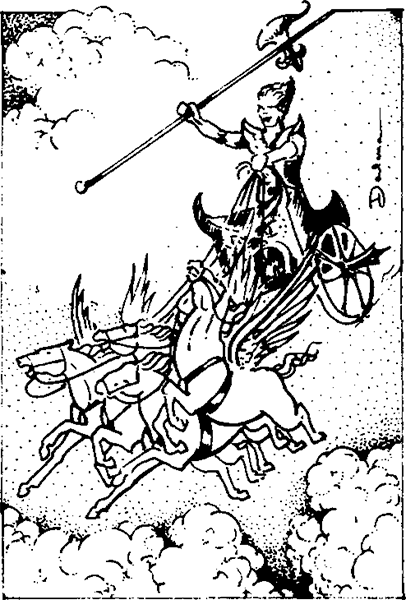
He goes to the same hairstylist as the githyanki from the first-edition Fiend Folio.
Huan-Ti "appears as a heavily muscled man in red +3 plate mail" (which, again, it seems to me would look pretty much the same as a heavily muscled man in red nonmagical plate mail). His clerics "must always wear red armor or clothes." He flies around in a chariot pulled by four pegasi.
Huan-Ti posted:
He watches every battle in which his worshipers take part, and when any mortal dedicates the last ten slain enemies to him he may (on a 1% chance) destroy utterly the very next enemy that being faces. Slain enemies dedicated to Huan-Ti must have their heads taken off and burned, or the sacrifices will not be received.
Taking time to decapitate ten bodies and burn their heads in the middle of a battle for a 1% chance of divine intervention to destroy a single enemy doesn't necessarily seem like a wise use of time. I guess maybe if the enemy forces include one especially powerful foe you have no chance of defeating on your own but also a lot of much weaker foes that you can easily kill and sacrifice—and if you're certain that you can arrange for that one especially powerful foe to be the very next enemy you face after the sacrifices—then it might be worth the gamble, but that strikes me as a very specific and unlikely circumstance.
"Huan-Ti" seems to be another typo; there is a Chinese god of war named Kuan Ti (關帝; Pinyin Guāndì), and I think that's who this is based on. Huan Ti is in turn based on a real historical person, Kuan Yü (關羽; Pinyin Guānyǔ), a close companion of the famous warlord Liu Pei (劉備; Liú Bèi in Pinyin) during the Three Kingdoms period, who was deified after his death. (Both Kuan Yü and Liu Pei are major characters in the Romance of the Three Kingdoms (三国演义; Sānguó Yǎnyì in Pinyin; San Kuo Yan I in Wade-Giles), a famous fourteenth-century Chinese historical novel about the events of this period that has been the basis for countless films, video games, and other adaptations.) While Kuan Ti is usually depicted with a red face, he wears a green robe, so the bit in Deities & Demigods about the red clothes is a bit confused. (That's new to Deities & Demigods, though; there's nothing in "Gods, Demi-Gods & Heroes" about the clothes worn by Huan-Ti or his clerics being any particular color.) He is also a god of literature, which is not reflected in his Deities & Demigods description in the slightest.
It's possible that the change from Kuan Ti to Huan-Ti may have something to do with confusion with a different Chinese mythological figure, the Yellow Emperor, Huang Ti (黃帝; Huángdì in Pinyin), a legendary ancestor of the Chinese people who supposedly lived during the third millennium B.C. However, the Yellow Emperor had no particular association with war (and as one might guess from his name, red wasn't the color he was most associated with either), so it seems to me more likely that Kuan Ti was the basis for Deities & Demigods's Huan-Ti, and that the Yellow Emperor, despite being an extremely important Chinese mythological figure, didn't make it into Deities & Demigods.
Kuan Ti is still worshipped in China today, and is, among other things, a patron of police officers, and is revered in both Buddhism and Taoism. Which, again, makes his inclusion in a book of gods for a fantasy game kind of... fraught.
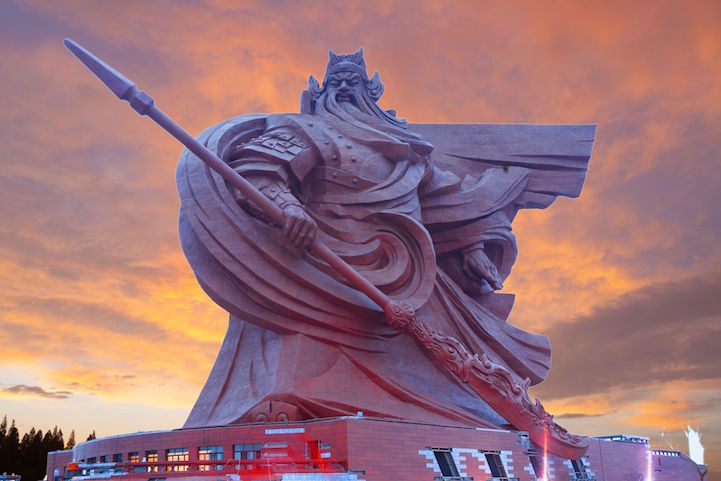
A nearly-two-hundred-foot-tall statue of Kuan Ti that stands in the city of Jingzhou.
Pegasi, incidentally, obviously aren't Chinese in origin, but there were winged horses in Chinese mythology, called t‘ien ma (天馬; tiānmǎ in Pinyin), although I don't know of any specific connection they had to Kuan Ti.
KUAN YIN (goddess of mercy and child bearing)
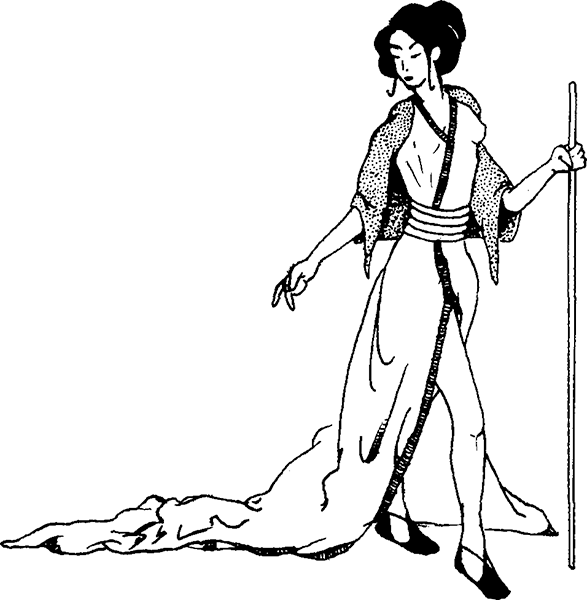
"Scissors beats paper. I win again."
Kuan Yin posted:
Her main following is with the common folk and all may work in her cause and expect to be rewarded someday. Her clerics are the peacemakers of the world and work diligently for the end of violence.
Actually, while it's not necessarily directly related to mercy or child bearing, ending violence seems to be her main schtick. Once per round, she can stop any act of violence directed at anyone, and no being in the universe can ever direct any violence against her. "For example, she could walk safely through 500 different types of demons and devils and never be harmed." (Presumably that means walking through a crowd of demons and devils, not walking through the demons and devils themselves. Walking through a creature seems like it would be kind of a violent act in and of itself.)
Kuan Yin posted:
When a being accomplishes a good act affecting 50 or more worshipers of Kuan Yin, and if the goddess is near, that being may be granted a wish (5% chance).
I'd think someone benefiting 50 or more of her worshippers while the goddess herself is nearby would be a rare enough occurrence that we could handle having more than a 5% chance of her rewarding them. At least it's better than the 1% chance of Huan-Ti rewarding an elaborate sacrifice during a battle. The authors really like giving tiny chances of gods reacting to things.
Kuan Yin (觀音; Guān Yīn in Pinyin) is the Chinese name for a Buddist bodhisattva known in Sanskrit as Avalokiteśvara (अवलोकितेश्वर). She is associated with compassion and is a patron of mothers, so I guess the Deities & Demigods depiction of her isn't too bad, aside of course from the issue that it's giving game statistics for a figure still widely venerated today by hundreds of millions of people.
LEI KUNG (duke of thunder)
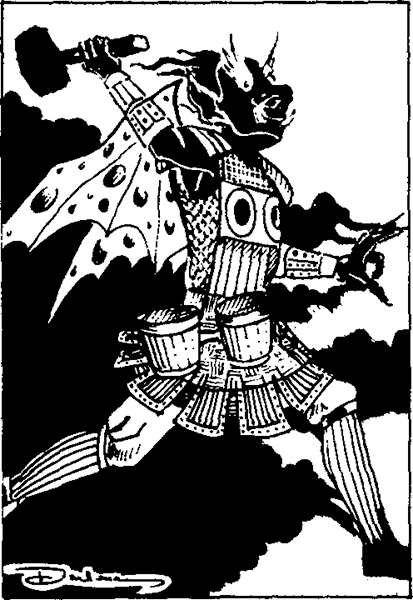
Three-year winner, Best in Show, Beijing Eyebrow Festival.
Lei Kung posted:
Lei Kung appears as a man with smoking black skin and eyes with pupils like lightning bolts. He has 2 large tusks and a huge nose. He has red spotted wings with a span af 40 feet.
Huh, another forty-foot wingspan. Okay, I cut Chih-Chiang Fyu-Ya some slack on this, but he was eight feet tall; Lei Kung is only six feet tall, so that's a wingspan-to-height ratio of more than six to one. Yeah, I think that's a bit much. (And his wings clearly aren't anywhere close to that big in the illustration.)
Lei Kung posted:
Lei Kung exists to make foul weather of one type or another at the request of the other gods of the pantheon. These gods will request such when they feel that their worshipers need a lesson. Lei Kung particularly delights in creating wind storms that destroy fragile things of beauty or value."
So I guess sometimes the Chinese gods outsource their bad omens. Okay.
"Yeah, Lei Kung, I'm not really happy with the way this cleric's been doing things lately. You mind drizzling on his temple a bit?"
Lei Kung (雷公; Léigōng in Pinyin) is indeed a god of thunder in Chinese tradition, though in mythology he wears only a loincloth instead of the +3 plate mail that Deities & Demigods gives him. Also, he's blue or green, not black, and at least according to some accounts he has a bird's beak, not an oversized but otherwise human nose. Well, at least he does have wings and tusks. This, by the way, is another god who still plays a role today in Chinese folk religion and, to a lesser degree, in Taoism, so, uh, maybe he doesn't really belong in a book of gods for a fantasy role-playing game?
LU YUEH (god of epidemics)
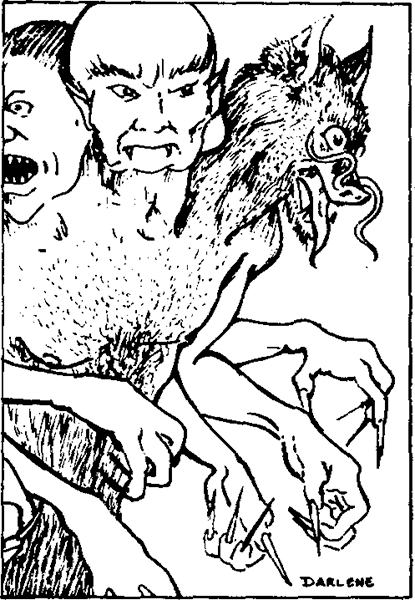
The middle head looks like he kind of resents the head on his left.
quote:
This god has 3 demon-like heads, 6 arms ending in claws, and green scaled skin. He has a look of death about him and an odor of putrescence.
Apparently there are two diseases in particular that he likes to cause: the Red Fever, which "will subtract 3 hit points... every melee round", and a rotting sickness, which "will kill his enemies who fail to make their saving throw versus poison in two melee rounds." And yes, "Red Fever" is consistently capitalized, and "rotting sickness" consistently italicized, and I don't know why. Also, anyone who hits him at close enough range "will suffer the rotting sickness (no saving throw applicable)"... so does that mean they don't get a saving throw against contracting it, but still get to save against dying in two rounds, or are they just going to unavoidably die in two rounds no matter what?
Lu Yueh posted:
Lu Yueh bestows gifts on those he deems evil enough. This is decided whenever an evil act affects more than 500 people. If the god is watching (on a 1% chance) there is a 5% chance he will give the evil being a disease-causing present with no strings attached.
So whenever anyone does an evil act that affects 500 people, there's an 0.05% chance that Lu Yueh will reward them with a disease-causing present. Okay. So first-edition DMs, if you didn't roll d10000 every time someone did such an evil act and have Lu Yueh reward them if you rolled 5 or under, you were doing it wrong.
Lu Yueh got by far the longest entry in the "Eastern Mythos" section of "Gods, Demi-Gods & Heroes", his description taking up more than a page. (By contrast, most gods got only a small stat block and a brief paragraph, and it wasn't uncommon for five gods to fit on a page; the entire "Eastern Mythos" section was only seven pages long, and that's including more than two pages devoted to magic items and monsters.) Much of that, however, was because we got information about "5 servants that fight with him in any battle", each of which had a full entry of his or her own (or what passes for a "full entry" in "Gods, Demi-Gods & Heroes"); if you don't count those as part of Lu Yueh's entry, then he only had the second-longest entry, being narrowly beat by Tou Mu. (We'll get to her.)
Lu Yueh's five servants are called BEING CALLED "CENTER", BEING CALLED "SPRING", BEING CALLED "SUMMER", BEING CALLED "AUTUMN", and BEING CALLED "WINTER". The first three have identical stat blocks (but not descriptions), but Autumn has twice the hit points, and Winter has three times the hit points of the first three and also a better Armor Class and movement rate. They all appear as clouds of gas in different colors (yellow for Center, green for Spring, red for Summer, white for Autumn, and grey for Winter), and they're all referred to with feminine pronouns except Autumn, who's apparently masculine, though that could be a typo (or an error in the PDF conversion).
They also like to roam in different directions, and you'd expect the four seasons to correspond to the four cardinal compass directions and Center to correspond to, well, the center, but no. Center "likes to roam the West", Spring "likes to roam the East", Summer "roams over the South", and we're not told where Autumn and Winter roam, so I don't know if one of them wanders to the north and the fifth one just lazes on a couch, or if maybe nobody likes wandering in the north because, I don't know, it gets too chilly. Each of Lu Yueh's five servants has a different weird magic item, except Winter, who I guess doesn't need one.
These five servants are kind of strange, but the oddest thing about them, frankly, is the way they're listed. Why not just write "CENTER" instead of "BEING CALLED 'CENTER'"? I mean, isn't Lu Yueh really a "being called 'Lu Yueh'"? But anyway, for some reason that's the way they're listed here in BOOK CALLED "GODS, DEMI-GODS & HEROES".
Another thing that lengthens Lu Yueh's description in "Gods, Demi-Gods & Heroes" is that it not only includes the bit about his giving gifts to people who do evil deeds (in fact, it has him much more likely to do so; only fifty people need to be affected, and it's given a flat 5% chance without having to check against a 1% chance that he's watching), but it also lists exactly what those gifts are. There are five different gifts listed, and the DM (or "judge") is advised to roll d6 to determine which one he gives; "if a 6 is rolled the person gets his choice."
Anyway, Lu Yüeh (吕岳; Lǚ Yuè in Pinyin) was a somewhat obscure god of plague who appeared in the famous sixteenth-century mythical-historical novel Investiture of the Gods (封神演义; Fēngshén Yǎnyì in Pinyin; Feng Shen Yan I in Wade-Giles). He appeared in several different forms, but yes, in one of his forms he did have three heads and six arms. Chinese myth also included a "Ministry of Epidemics" which according to some accounts included one member associated with each of the four seasons and one with the center—so that's where Lu Yueh's servants in "Gods, Demi-Gods & Heroes" come from. They actually did have their own names, so "Gods, Demi-Gods & Heroes" really could have avoided that whole "Being Called 'X'" business, but maybe those names weren't in whatever source Kuntz and Ward used. (For what it's worth, their names were respectively Shih Wen Yeh (史文業; Shǐ Wényè in Pinyin), Chang Yüan Po (張元伯; Zhāng Yuánbó in Pinyin), Liu Yüan Ta (劉元達; Liú Yuándá in Pinyin), Chao Kung Ming (yes, the same Chao Kung Ming we already covered... okay, maybe there is a reason they didn't use these names, though I still think it's more likely they just didn't know about them), and Chung Shih Kuei (鍾仕貴; Zhōng Shìguì in Pinyin).
MA YUAN (killer of the gods)
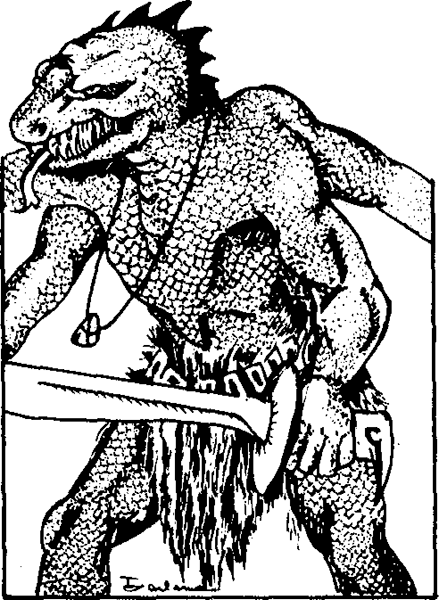
♪ I love you, you love me, we're a happy family... ♪
Ma Yuan isn't presented as a god, but as a unique monster, with a standard monster stat block. (Including a "% IN LAIR", which in his case is 10%. No word on what his lair is like.) He's a seventy-foot tall creature with "the strength of a storm giant" who "is said to have killed at least 10 minor deities."
Ma Yuan posted:
This monster has 3 eyes in his tyrannosaurus-shaped head, and has 4 large humanoid arms.
I'm going to go out on a limb here and guess that nowhere in the original Chinese myths was there any reference to his head being "tyrannosaurus-shaped".
Ma Yuan posted:
The existence of Ma Yuan prevents complacency among the gods.
I'm not sure that seems like an effective management strategy. It's not a practice I foresee many businesses adopting any time soon.
"I think we've had a problem with complacency here at DystopiCo. So, to make sure all employees stay on their toes, we've hired this assassin to randomly hunt you."
Ma Yuan posted:
He also has a powerful magical device shaped in the form of a small triangular piece of stone that has the power to turn into any weapon the holder wishes, magical or otherwise.
And according to the illustration, it also makes a snazzy necklace...
In case you're wondering why I kept saying that "two or three" gods had their names changed between "Gods, Demi-Gods & Heroes" instead of just specifying one number, Ma Yuan is why. His name in "Gods, Demi-Gods & Heroes" was given as "Ma Yuan Shuai". So it did sort of change, but only by shortening it; I wasn't sure that should completely count, so I hedged my bets by saying "two or three".
Ma Yuan is another god who was supposed in a post in that Giant in the Playground thread to be "invented [out of] whole cloth". And, as with Chih-Chiang Fyu-Ya, that turns out not to be true; Kuntz and Ward may have mangled some of the gods in this chapter pretty badly, but there are none that they completely invented—and Ma Yüan-Shuai (馬元帥; Mǎ Yuán Shuài in Pinyin) is no exception. I quote from Myths and Legends of China, by E. M. Werner, a book that was published in 1922 and therefore could easily have been Kuntz and Ward's source (the elusive Ch‘ih Chiang Tzŭ Yü, incidentally, also appears in this book):
quote:
Ma Yüan-shuai is a three-eyed monster condemned by Ju Lai to reincarnation for excessive cruelty in the extermination of evil spirits. In order to obey this command he entered the womb of Ma Chin-mu in the form of five globes of fire. Being a precocious youth, he could fight when only three days old, and killed the Dragon-king of the Eastern Sea. From his instructor he received a spiritual work dealing with wind, thunder, snakes, etc., and a triangular piece of stone which he could at will change into anything he liked. By order of Yü Ti he subdued the Spirits of the Wind and Fire, the Blue Dragon, the King of the Five Dragons, and the Spirit of the Five Hundred Fire Ducks, all without injury to himself. For these and many other enterprises he was rewarded by Yü Ti with various magic articles and with the title of Generalissimo of the West, and is regarded as so successful an interceder with Yü Ti that he is prayed to for all sorts of benefits.
Too bad neither "Gods, Demi-Gods & Heroes" nor Deities & Demigods included statistics for the Five Hundred Fire Ducks...
And yeah, you'll note there's no mention of a "tyrannosaurus-shaped head".
NO CHA (demigod of thieves)
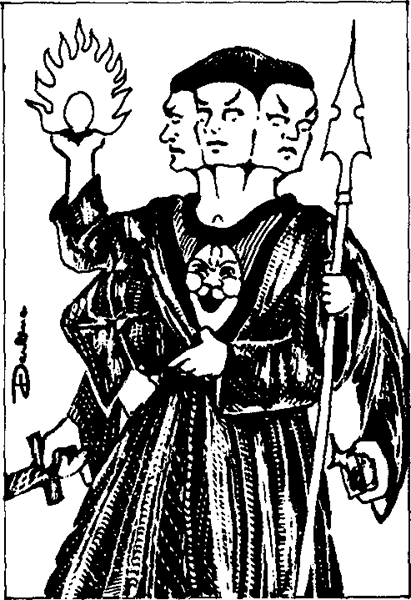
Three heads and not a decent haircut among them.
No Cha posted:
The god appears as a three-headed, eight-armed man, with silvery scaled skin, eyes that blaze like fire, and the ability to grow or shrink in size.
But according to his stat block he's sixty feet tall by default.
No Cha posted:
No Cha is the patron of thieves, and there are many tales of his famous thieving exploits.
No Cha (哪吒; Nézhā in Pinyin) did, according to the myths, start out as a monstrous creature with three heads and eight arms. But he didn't stay that way. He has a... rather complicated story involving his being reborn inside a ball of flesh, committing suicide and then asking his mother in a dream to build a temple to him, and being brought back to life in a body made of lotuses and water lilies. Oh... the wind fire wheels were one of his weapons, so that's where those came from, I guess. But anyway, while he had his moments of mischief and anger and attempted patricide, he ended up as a protective deity and a patron of adolescents, so how exactly he became a neutral evil god of thieves in Deities & Demigods I have no idea.
Incidentally, just a couple of weeks ago an animated movie about No Cha/Nezha was released in China and broke the record for the highest-grossing Chinese animated film. Not that that has anything to do with Deities & Demigods, but I figured it merited mention.
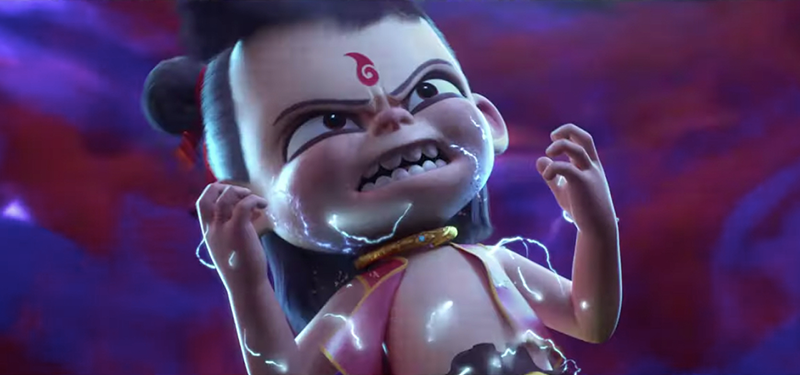
I have no idea what is going on in this picture, but I'm pretty sure that's Nezha.
Anyway, there are still a couple pages to go in this chapter,, but I guess I'll have to put the rest in a separate post because apparently this post exceeds the maximum message length, which I didn't know was a thing until just now. So, uh...
Next time: The Classic Conflict of Law vs. Evil
The Classic Conflict of Law vs. Evil
Original SA post Deities & Demigods 1EPart 10: The Classic Conflict of Law vs. Evil

Eh, since I already showed the chapter header in the last post, may as well reuse the generic header in this one.
Okay, this wasn't originally intended to be a separate post; I'd written the review of all the Chinese Mythos chapter up as a single post. But, as I mentioned at the end of the last post, it turned out to be so long a post that when I tried to post it I found out it exceeded the maximum message length, so I have to split it up. Yeah... I guess I got a little carried away with this chapter, maybe. In any case, I don't expect that any future chapter is going to require quite so much research as this one, so I hope there won't be that much time between posts again—and I don't expect I'm going to write enough about any future chapter to have to divide it into two posts again, either. (No promises, though.)
Xiahou Dun, who is in his own words "an academic focusing on medieval Chinese things" and who therefore, unlike me, is an expert on this subject, posted some further information about the material in this chapter and what's wrong with it. Those who have been following along in the forum will have of course already read his post but, for the sake of the eventual archiving of these posts, I'll link to it here.
Selachian posted:
I will note that along with Mjolnir and Stormbringer, Ma Yuan's omni-weapon gadget was one of the most sought-after bits of loot from this book back in the day. At least among Monty Haul campaigns where god-killing was a popular recreation.
Huh. That's something I didn't consider. I almost didn't even bother mentioning the "omni-weapon gadget" at all; the only reason I added it into the post at the last minute was because its description was very similar to a bit in the quote from Werner's Myths and Legends of China, strengthening the evidence that this may have been a primary source for Kuntz and Ward's treatment of this mythos. (As we'll see in this post, that evidence in aggregate turns out to be pretty strong!) I knew in the abstract there were players who enjoyed powergaming campaigns where they'd fight the gods and would treat the descriptions of their possessions as a shopping list, but like I said in the second post in this review, I've never run or played in such a campaign, and I don't tend to think that way, so it didn't really occur to me how desireable such an item would be from a powergaming player's perspective, but I guess I can see that.
Anyway, let's continue from where we left off...
SHAN HAI CHING (god of wind & sea)

He looks as confused as the people seeing this illustration are.
Shan Hai Ching posted:
This god has a roc's body with the oversized head of a man.
So, yeah, not only is he a bird with the head of a man, but he's a bird with the head of a man and a sixty-foot wingspan.
Shan Hai Ching posted:
The god and his clerics serve all beings using the sea, and any trip out into the oceans requires a sacrifice to this deity for good winds and the like.
Oh, he's one of those gods. The protection racket gods. "Oh, so you're traveling on the sea, eh? Nice ship. Be a shame if anything happened to it."
Shan Hai Ching posted:
His wind force is said to be able to last a full day when "great wrath is upon the deity".
Wait... so how long does his weather control last normally? Also, why is that last bit in quotation marks? Is it quoting something?
Amusingly, we're told in "Gods, Demi-Gods & Heroes" that while Shan Hai Chang "is perfectly able to fly for himself, he likes to ride on the back of an imperial dragon (explained later)." So if you think he looks silly now, just imagine that awkward human-headed bird sitting on the back of a dragon. I think that makes it even worse. Or better.
Shan Hai Ching is so special he gets two illustrations... though, alas, neither shows him sitting on a dragon.
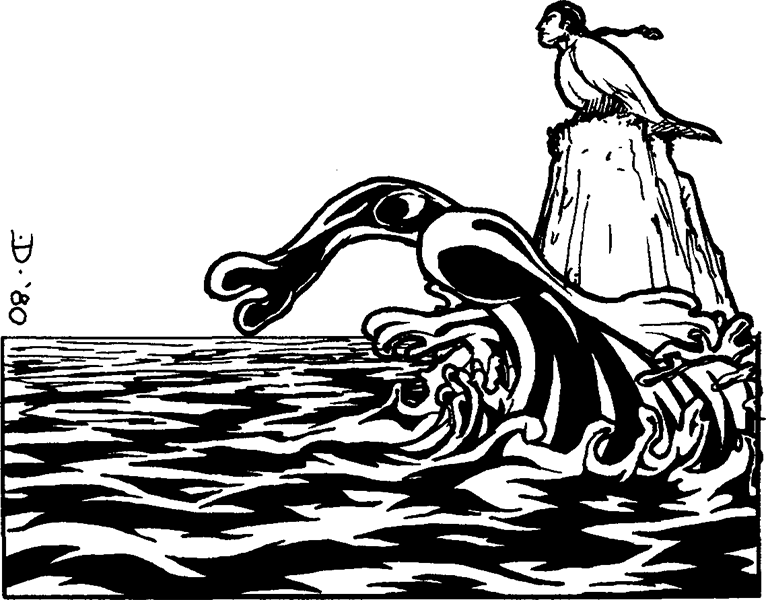
Shan Hai Ching, seen here serenely contemplating his ridiculous appearance.
I think Kuntz and Ward got a little confused about this one. There is, as far as I can find, no actual Chinese god named Shan Hai Ching, or anything similar. There is, however, a very famous Chinese book called the Shan Hai Ching (山海經; Shānhǎi Jīng in pinyin), which in English is usually called the Classic of Mountains and Seas. This book dates back at least to the Han dynasty (and parts of it are almost certainly much older), and contains many fanciful descriptions and illustrations of mythical beasts—including at least three different birds with human heads.
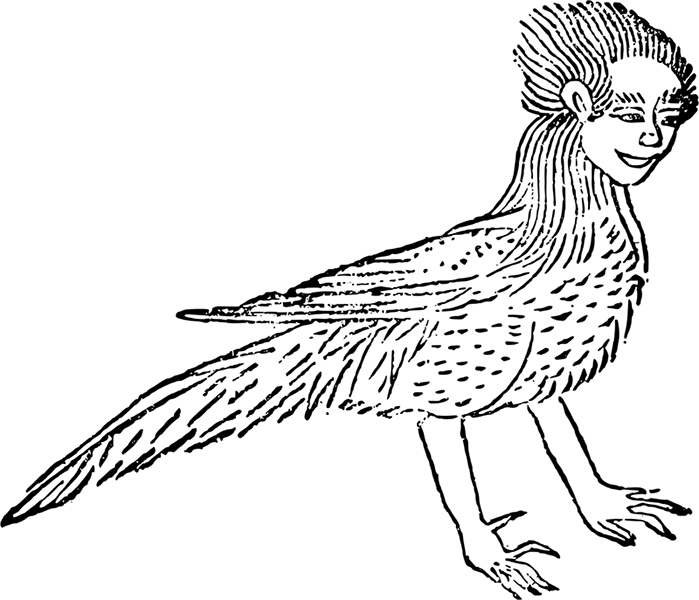
One of several illustrations of human-headed birds in the Classic of Mountains and Seas.
So my guess is that Kuntz and Ward found one of these illustrations and misunderstood the caption, mistaking the name of the book from which it was taken for the name of the entity it represented. I don't know for sure that that's what happened, of course, but it seems as good an explanation as any.
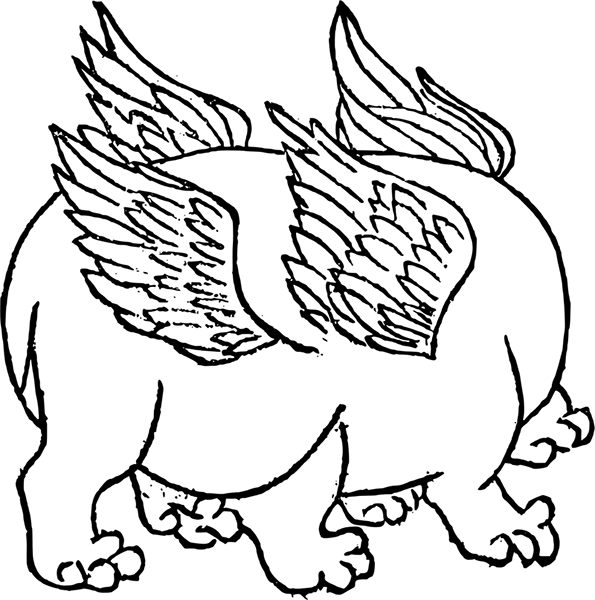
Another illustration from the Classic of Mountains and Seas. This one has nothing to do with any entry in Deities & Demigods, but it amuses me. (In case you're wondering, this is the Ti Chiang (帝江; Dìjiāng in pinyin), a faceless, eyeless creature that likes to sing and dance.)
SPIRITS OF THE AIR
These again are monsters, not gods: minions of the wind gods who "exist to fight for the gods" and "can be summoned by them in numbers of up to 100 every day."
Spirits of the Air posted:
They have black skin, large bat wings, clawed feet (which they use in battle), and a tusked monkey's head.
"Gods, Demi-Gods & Heroes" also says they have an eagle's beak, but that disappeared from later descriptions. Anyway, Deities & Demigods doesn't include an illustration of them, but if you really want to see one, just be patient; they also appear in the Planescape Monstrous Supplement, included in the Planescape Campaign Setting boxed set, which we'll be getting to eventually, and they do have an illustration there.
I guess these things provide yet more evidence for Werner's Myths and Legends of China having been a source for "Gods, Demi-Gods & Heroes" (as I mentioned before, the main (and probably only) source for the "Chinese Mythos" chapter in Deities & Demigods seems to have been "Gods, Demi-Gods & Heroes" itself), because that includes a description of a "spirit of thunder" that's pretty much an exact match for these "spirits of the air":
Myths and Legends of China posted:
The Spirit of Thunder, for whom Lei Tsu is often mistaken, is represented as an ugly, black, bat-winged demon, with clawed feet, monkey’s head, and eagle’s beak, who holds in one hand a steel chisel, and in the other a spiritual hammer, with which he beats numerous drums strung about him, thus producing the terrific noise of thunder. According to Chinese reasoning it is the sound of these drums, and not the lightning, which causes death.
(Who's Lei Tsu? Well, there was a goddess of crafts and silk named Lei Tsu (嫘祖; Léi Zǔ in pinyin), the wife of the Yellow Emperor, but that doesn't seem to be the intended referent here. Rather, it seems that "Lei Tsu" (雷祖; Léi Zǔ in pinyin again) was also an alternate name for Wên Chung, whom we'll be getting to shortly.)
The problem is that there was apparently a bit of a misunderstanding here, because if you read carefully Werner isn't referring to multiple spirits of thunder, but to a singular spirit of thunder... and in fact that spirit of thunder is identified with Lei Kung, who already appeared in this chapter as a god. So... oops?
TOU MU (goddess of the north star)
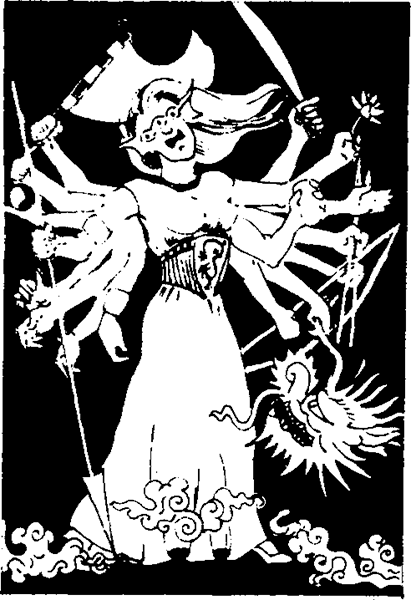
I know it's not the intent, but it's always looked to me in this illustration like she's wearing three-eyed goggles.
So what would you expect the "goddess of the north star" to be like? Would you expect her to be a chaotic evil twenty-foot-tall monster with three eyes, sixteen arms, and red scaly skin who carries around the living head of a red dragon that breathes fire on her enemies, and likes running people over with the unbreakable jade wheels of her five adamantine flying chariots? Because that's what she is. Also, if you say you expected that, I don't believe you.
She carries around other things besides the red dragon head; that's just kind of the weirdest item... though the "piece of the moon that is able to block any single hit directed at her person in any given melee round" is a close second, and I guess the "lotus flower that heals all wounds at a touch" is in the running too. The red flag that shoots death spells is also a bit odd; that's not really something you'd expect a flag to do. Anyway, I guess since she has sixteen arms she's able to carry all this stuff around and still have plenty of hands free.
There's nothing in the text to indicate what her actual goals are, or what if anything she presides over besides "the north star". The first paragraph of her two-paragraph description is mostly about all the weapons and random doodads she totes with her, and the second paragraph is entirely devoted to describing her chariots. Oh well.
We get a little more information in the "Gods, Demi-Gods & Heroes" description of her. If she likes an "especially valiant fighter", she will give him a magical book: either a "tome of death" that "allows anyone reading it to use one death ray spell once a day", or an unnamed book that "allows anyone to raise the dead once a day". (Not just a person reading it; the very fact that this book exists means that anyone is able to raise the dead. Okay, obviously that's not what the authors meant, but it... could have been worded better.) We are specifically told that she has an unlimited supply of these books (just in case any Dungeon Master was thinking of having her run out, I guess), and that the books are "made of a very brittle paper, but will remain useable as long as they are not exposed to hard wear and tear." Oddly, we are told at first that whether or not she likes a particular fighter is the "judge's option", but later in the paragraph we're told that "[t]he chance of her doing this is 3% in any battle having 1,000 or more persons", so apparently there's a fixed percentage chance and it's not just "judge's option" after all.
You might think that rewarding valiant fighters doesn't seem like a particularly chaotic evil thing to do. I think you would probably be right. Alignments aren't mentioned for most of the gods in "Gods, Demi-Gods & Heroes" (the only items in their brief stat blocks are Armor Class, Move, Hit Points, Magic Ability, Fighter Ability, and Psionic Ability), but there's nothing there to indicate that she's supposed to be evil, and at least one item that suggests that she's not: her gadget collection includes one pair of items that doesn't appear in Deities & Demigods, "2 amulets of Yin and Yang that protect the Goddess from spells sent by any person of the lawful and evil alignments." Okay, this is a bit strange, because "lawful and evil" aren't really contrasting alignments, because original D&D generally didn't refer to "evil" alignments anyway, and because weren't we specifically told at the beginning of this section not to think of the gods of this mythos as lawful or chaotic? Still, one would think that an evil goddess wouldn't have items to protect her against evil alignments. Maybe when they wrote Deities & Demigods and had to assign an alignment to her, Kuntz and Ward didn't remember their original source, and just figured that a goddess that weird and inhuman-looking had to be evil.
Mythologically, Tou Mu (斗母; Dǒumǔ in pinyin—the name means "Mother of the Big Dipper") is a kind and virtuous goddess who keeps a book in which she records the life and death of every person in the world. She does have three eyes and sixteen arms, though, at least in some depictions. (In other depictions she has only eight arms, though sometimes she has four faces.)
Tou Mu is yet another figure who still plays a role in modern Buddism and Taoism; I admit I don't know much about either Buddhism or Taoism, but my guess is that neither Buddhists nor Taoists would in general be thrilled about her being depicted as a chaotic evil horror.
WEN CHUNG (minister of thunder)
Wen Chung posted:
Wen Chung has 3 eyes in his head and a massive dark-skinned body. He summons weather for Lei Kung and for his chaotic worshipers.
Okay, wait. So the other gods outsource their bad omens to Lei Kung, and then Lei Kung outsources them to Wen Chung. Huh. I guess this really is a bureaucracy.
Wen Chung is the third god in this mythos to live in the Elemental Plane of Air. Not sure why that's such a popular place for Chinese gods. Maybe they just like the atmosphere.
Wên Chung (闻仲; Wén Zhòng in pinyin) is another character from Investiture of the Gods, though he's also described in Myths and Legends of China, so Kuntz and Ward probably got him from there. (The same is true, by the way, of Lu Yueh.) He has quite an elaborate backstory, none of which is even hinted at in his brief four-sentence entry in Deities & Demigods (half of which is, of course, about his combat abilities).
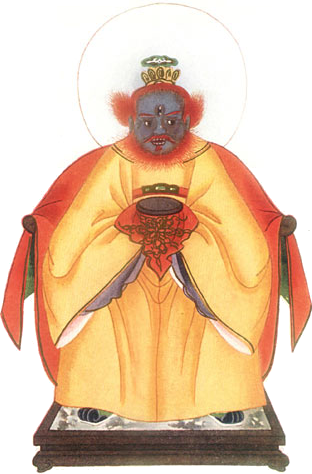
Deities & Demigods doesn't include an illustration of Wen Chung, but Myths and Legends of China does.
YEN-WANG-YEH (judge of the dead)
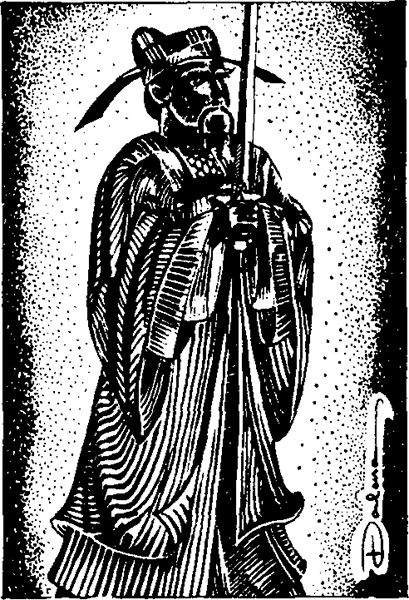
"I heard vertical stripes are slimming."
Yen-Wang-Yeh posted:
This god collects all the souls and spirits of the dead and makes sure that they are transported to the proper plane and do not roam the earth at will. He tracks down spirits that do and makes them suffer for eternity. He has no power over the dead who have risen to a higher plane through their good deeds.
So either there are no undead in settings where the Chinese Mythos is worshipped, or Yen-Wang-Yeh isn't very good at his job.
Also, he can shoot death rays out of his eyes and "shape change into an oriental dragon", and "[a]nyone touching his body with anything" has to succeed on a saving throw or be paralyzed. Yes, I said I wasn't usually going to mention the gods' combat abilities anymore, but my reasons for mentioning them in this case will become clear momentarily.
This is the other god who had a different name in "Gods, Demi-Gods & Heroes". He's there—the description doesn't mention the black skin, but it does list the same combat abilities: it doesn't specify the form of an "oriental dragon" for his shape changing, but it does say he can shapechange, and the death rays and the thing about being paralyzed if you touch him with anything are there. But his name in "Gods, Demi-Gods & Heroes" isn't Yen-Wang-Yeh: it's "Yama".
Now, that's not necessarily completely wrong. There is a god of death in Buddhist tradition sometimes called Yama. But there are two problems here. First of all, "Yama" is a name for the god, but not really a Chinese name for him; the Chinese call him "Yen" (阎; Yán in pinyin), though they generally don't use that name alone, but as part of a longer name as in "Yenwang" (阎王; Yánwáng in pinyin—the name means basically "King Yama") or "Yen Lo Wang" (閻羅王; Yánluó Wáng in pinyin). Secondly, he was ultimately derived from the same source as the Hindu god Yama, which wouldn't be an issue except that that god also appears in "Gods, Demi-Gods & Heroes", in the "Gods of India" section. My guess is that the reason for the name change has more to do with the second reason: probably that the authors noticed they had two gods of death with the same name who were otherwise completely different, and realized that would be confusing, so they decided to change one of them. (And yes, the Hindu god Yama does appear in Deities & Demigods. We'll see him when we get to the "Indian Mythos".)
...Wait, hold on, "Gods, Demi-Gods & Heroes" also includes yet another god named Yama in the "Robert E. Howard's Hyborea" section. I mean, Howard's Yama was almost certainly based on the Hindu Yama, but his description here is completely different. So... that's three Yamas. That is altogether too many Yamas.
"Yen-Wang-Yeh" (閻王爺; Yán Wáng Yé in pinyin) is in fact just another Chinese title for Yama. Of course, I don't know whether Kuntz and Ward knew this was another name for the same god or whether they ran across a reference to a Chinese death god named "Yen-Wang-Yeh" and assumed it was an entirely different god, but I guess it doesn't really matter.
Anyway, that's it for the Deities & Demigods chapter on the "Chinese Mythos". But while all the gods in this chapter also appeared in the "Eastern Mythos" section of "Gods, Demi-Gods & Heroes", the reverse is not true—there are a few entities in "Gods, Demi-Gods & Heroes" that didn't make the cut for Deities & Demigods. So before I end this post, let's take a look at those.
TAI YANG TI CHUN GOD OF THE SUN
Tai Yang Ti Chun posted:
This God appears as a noncorporal [sic] column of light that stands 20 feet tall and 4 foot [sic] wide.
Hm. Maybe he didn't make it into Deities & Demigods just because the authors thought a god with such an abstract form wouldn't be a good fit? I don't know.
T‘ai Yang (太陽; Tàiyáng in pinyin) is the Mandarin word for "sun", but as far as I can tell the most usual name for the Chinese sun god is T‘ai Yang Hsing Chün (太陽星君; pinyin Tàiyáng Xīngjūn). However, the name T‘ai-yang Ti-Chün (太陽帝君; Tàiyáng Dìjūn in pinyin) does appear in, you guessed it, Werner's Myths and Legends of China. (Not that it appears only there, but I mean by now I think we've pretty much established that was probably one of Kuntz and Ward's main sources, if not the main source.)
LEI CHEN TZU DEMI-GOD "SON OF LEI KUNG"
Lei Chen Tzu posted:
Lei Chen Tzu stands 10 feet tall, has green scaled skin, 2 large tusks in his one head, an overly long nose, red spotted wings with a span of 30 feet, has the strength and the damaging power of a
Storm Giant, and his 2 eyes act as a Mirror of Life Trapping.
I think it's kind of amusing that the authors feel it necessary to specify he has "one head", but given there are two gods in this mythos with three heads, I guess maybe it's understandable. (By the way, does each of his eyes act as a mirror of life trapping, or do both eyes act jointly as a single mirror? I guess that only really matters under certain special circumstances.)
Lei Chen Tzu posted:
Anyone daring to kill this darling boy will suffer the revenge of Lei Kung.
I'm assuming the bit about referring to him as a "darling boy" is meant ironically, but if so it's a rare touch of intentional humor in this very dry book. I do find it kind of charming that the lawful evil Lei Kung has such a strong sense of paternal affection. (Granted, "Gods, Demi-Gods & Heroes" didn't say he was lawful evil; his alignment wasn't specified until Deities & Demigods.)
Okay, the first thing I checked for a reference to this god was Myths and Legends of China and, surprise, he's there—as Lei Chên-tzŭ (雷震子; Léizhènzǐ in pinyin)—, and the desciption in "Gods, Demi-Gods & Heroes" pretty much matches his description there. Not all sources make him out to be a son of Lei Kung (and in fact some sources say he simply is Lei Kung by another name), but Myths and Legends of China does so so does "Gods, Demi-Gods & Heroes". Even according to the accounts in which he is Lei Kung's son, he was actually abandoned by his father Lei Kung and adopted by a hermit, so I'm not sure Lei Kung would really care that much if he was killed, but Myths and Legends of China never addresses that question so neither does "Gods, Demi-Gods & Heroes".
That's it for the gods, but then we get some non-god entities:
SHEN SHU: powerful spirits that guard portals the most powerful of which are called Yu and Lei.
Yes, that's how the heading appears. And despite the heading referring to them in the plural, the descriptive text refers to "[t]his spirit", singular.
Shen Shu: powerful spirits that guard portals the most powerful of which are called Yu and Lei posted:
This spirit seems to be a man until he starts to fight.
What does he look like after he starts to fight? We aren't told.
Shen Shu: powerful spirits that guard portals the most powerful of which are called Yu and Lei posted:
It stands by a portal summoned by a very powerful wizard or God in ethereal form and when beings of the wrong type try to enter it moves to stop them. It fights in plus 2 armor and shield and uses a halberd.
What are beings of the "wrong type"? I guess that's defined by whoever summons the shen shu, but the text doesn't explicitly say that. Also, wasn't the spirit a "he" in the previous sentence? Why is it an "it" now?
Turns out these guys are also in Werner's Myths and Legends of China, as two "Door-gods" named Shên Shu (神荼; Shénshū in pinyin) and Yü Lü (鬱壘; Yùlǜ in pinyin). However, in this case that may not have been Kuntz and Ward's only source on these beings, because other sources give the other door god's name as Yulei (郁垒; Yùlěi in pinyin), the syllables of which match their names for the "most powerful" shen shu. Of course, that still doesn't explain why they decided to split the name of one door god in half to make two different names and use the name of the other door god as the generic name for the type, especially when there already was a generic Chinese name for the door gods, mênshên (门神; ménshén in pinyin). But hey, Werner didn't mention that name, so...
(Wait, actually, I take that back, Werner actually does mention that the "Door-gods" are known as "Mên Shên"... but several pages back from where they're described in more detail and Shên Shu and Yü Lü are named, so Kuntz and Ward may have missed it.)
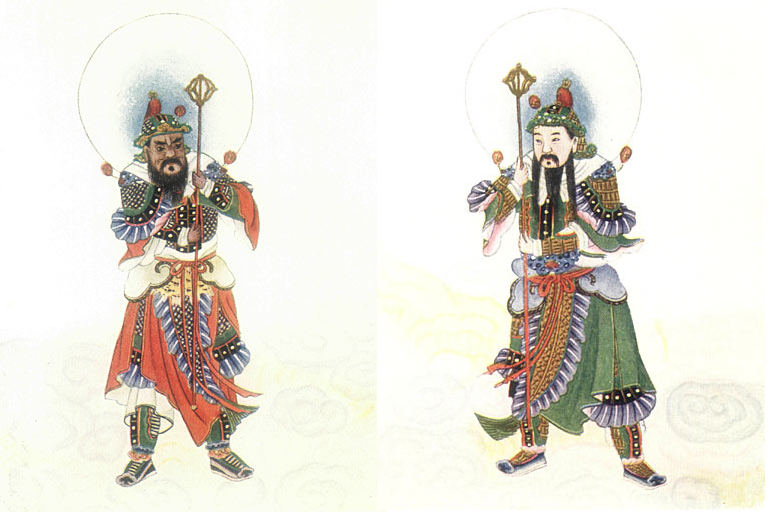
Werner even includes illustrations again.
DEMONS
Demons posted:
Refer to the India section and the Rakshasas for their powers. While these beings are evil they have been on occasion on the side of the Gods in battle.
Against whom? Who are the gods and demons jointly battling against?
FAIRIES
Wait... fairies in Chinese mythology? What?
Fairies posted:
At the top of every large mountain is a group of 1-10 Fairies. These beings stand 1 foot tall with gossamer wings and a delicate elfin appearance. One member of this group is a 15th level wizard and the rest are from the 7th to the 10th. They are very afraid of mortals and will react violently at any incursion of their land.
If the weakest fairies are 7th-level wizards, why are they afraid of mortals? Apparently if you go up to the top of a large mountain in China, you're just begging to get fireballed.
EVIL SPIRITS
That's very specific, thank you.
Evil Spirits posted:
These noncorporal creatures of the air roam the earth with the ability to inhabit statues and use them for evil destructive purposes.
So I guess their statistics refer to them when they're in statues? Anyway, they're pretty slow, have no magical abilities (aside from the statue possession), and don't have a huge number of hit points (25), so these things don't seem horribly deadly... though they do have a good Armor Class and some psionic ability.
Okay, that's all the monsters from the Eastern Mythos, but we're still not done. Now we get magic items.
Eastern Mythos posted:
NOTE: The Gods have magic devices that they use in common of which they are very fond and will react violently at their misuse.
So, once again, these magic items are used by the gods, and aren't intended for mortals, and are therefore pretty much useless for a campaign. (Except maybe, I guess, for a powergaming campaign where the players run around killing the gods and looting their corpses, the exact kind of campaign that Gary Gygax and the editor insist should never happen.) Anyway, all seven magic items from the Chinese Mythos chapter in Deities & Demigods are here, but there are also a few extras:
THE 5 FIRE, 7 FEATHER FAN OF DEFENDING
The 5 Fire, 7 Feather Fan of Defending posted:
This device acts as a Jade Scepter of Defending and also negates all spells used against the holder.
THERE ARE 4 PURPOSE WHIPS
Please express your item header in the form of a complete sentence.
The whips are presented in a numbered list:
There Are 4 Purpose Whips posted:
- Slay Demon Whip
- Slay God Whip
- Slay Law Whip
- Slay Evil Whip
Ah yes, once again the classic D&D conflict of Law vs. Evil.
There are no descriptions of these whips. Apparently the authors decided the names were self-explanatory.
YIN-YANG MIRROR
Yin-Yang Mirror posted:
Paralyzes all beings of the lawful or evil alignment that look into it: duration - 1 year
So... does it sustain them without food or drink for that year? Also, "lawful or evil"? Seriously, what is it with this section (and only this section) repeatedly contrasting law with evil? Are we meant to assume that lawful = yin and evil = yang? Because that's certainly not the impression given by the paragraph at the beginning of the section.
Anyway, we're still not quite done, because now we get:
NOTES ABOUT DRAGONS
Notes About Dragons posted:
The Eastern dragon goes through 3 stages of metamorphosis in growing. While young, he has the head of a horse, the body of a lizard, tail of a snake, large red wings, and 4 lion legs ending in talons. In its middle years it has the horns of a deer, head of a camel, eyes of a demon, neck of a snake, scales of metal, claws of an eagle, and legs of a tiger with large yellow spotted wings. In old age it appears as the classical type.
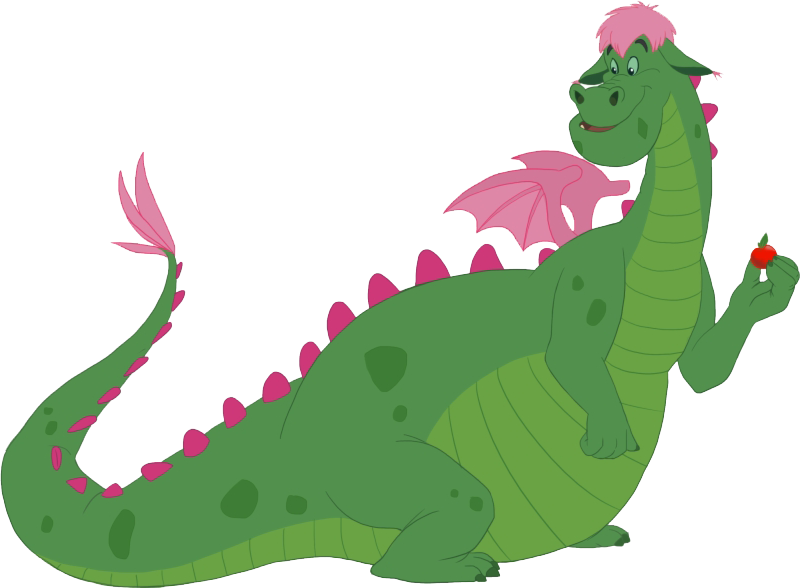
♪ He has... the head of a camel... ♫
"Oriental dragons" would eventually appear in AD&D in the Fiend Folio, but very differently from how they're presented here. Here there are six types of Eastern dragon, most of which are color-coded like standard D&D dragons, though it's not clear whether they're supposed to be otherwise similar to the standard dragon of the same color. There are green dragons who "are lawful and unaffected by anything with wood in it", blue dragons who "are made of the sky and neutral and not affected by anything launched in the air at them", and red dragons who "are very evil and breathe fire". (Again we have law vs. evil. Huh.) Then there are gold dragons who "are found in all 3 alignments" and get no further description; "Imperial Dragons" who are yellow and live in the sea and "can cause wind and rain storms, breathe fire, and fly, even though [they do] not have wings"; and an unnamed "dragon of treasure whose skin is made of gems and gold" and that "attracts treasure to its body as a magnet to iron". "Evil dragons live in mountains and hills, whereas good dragons live in water areas", and now they're not even trying to stick to the usual law and chaos alignments of original D&D. (Or the yin and yang alignments indicated at the beginning of the section.) All Eastern dragons "can polymorph themselves, become invisible, and use the ESP spell".
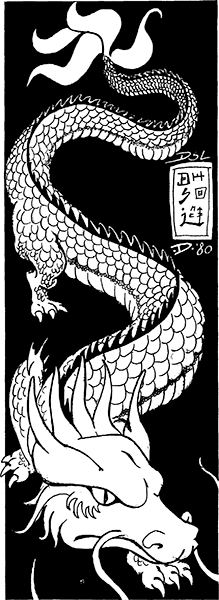
"Gods, Demi-Gods & Heroes" doesn't have an illustration of an "Eastern dragon", but Deities & Demigods does. With a bunch of gibberish fake Chinese characters (that bear very little resemblance to actual Chinese characters) in a box to the right. The leftmost of which are designed to resemble the artist's initials, but maybe he figured people wouldn't notice that so he also put his initials above the box. Wait... there's a different artist's monogram below the box. Did it take two artists to make this illustration for some reason?
And now we're finally done with this chapter. In terms of actual gameplay applicability, useless magic items aside, this may be the best chapter so far; it includes an interesting assortment of gods, and as I said, it's the first one to include gods of all nine alignments. In terms of mythological accuracy and cultural sensitivity, though, well, I'm not sure it's worse than the abysmal "American Indian Mythos", but it's definitely down at that level.
There are, alas, other chapters to come that are just as bad in that respect. But first, we'll take a short break from mutilating ancient mythologies...
Next time: Three Synonyms for "Tentacle"
Three Synonyms for "Tentacle"
Original SA post Deities & Demigods 1EPart 11: Three Synonyms for "Tentacle"

Not sure why this time the title is right-justified and the artist's monogram migrated to the left side. Maybe just to mix things up.
And here, at last, we get to one of the two Mythoi famously appearing only in the first printing of the book: the Cthulhu Mythos, based on the cosmic horror works of H. P. Lovecraft and others who built on his ideas.
Deities & Demigods was my own first exposure to the Cthulhu Mythos. Nowadays, Cthulhu has become a fairly common part of pop culture, and referenced in comics and TV shows. That wasn't the case back when Deities & Demigods first came out, or at least if it was, I missed it. I had never heard of Cthulhu or H. P. Lovecraft before reading about them in this book. I knew nothing about the context of these creatures, but I loved the pictures and descriptions, especially of the Great Race and the Primordial Ones. (And yes, I did use many of these creatures in campaigns I ran, though not necessarily in a way that really made sense for their background or had anything to do with their context in the stories.)
We haven't seen anything of Erol Otus since the third post, but we'll be seeing more of him now. With one or two exceptions, each pantheon was assigned to a single artist to illustrate (as you've probably noticed), and Erol Otus was given the Cthulhu Mythos. That was a good choice; otherworldly Lovecraftian monsters are an excellent match to Otus's organic, unearthly style. And he really went all out with the wild monstrosities... okay, Cthulhu himself is nothing special to look at (though I do like the sort of silhouette of R'lyeh surrounding him), but wait till we get to the last two gods of the pantheon.
All the gods in the Cthulhu Mythos are chaotic evil, with the sole exception of Azathoth, who's chaotic neutral—possibly because it's described as mindless (and given no Intelligence or Wisdom score), and the authors figured you'd have to be intelligent to be evil (but not, apparently, to be chaotic). Whether this really reflects the original stories is debatable—the introductory text says that "all of [Lovecraft's] gods were evil and chaotic, and the best mankind could expect from them was indifference", but in fact much of the point of Lovecraft's cosmic horror was that the only thing mankind could expect from these beings was indifference. They weren't actively hostile toward humanity; they just didn't care about humans; humans were essentially beneath their notice; and their very existence happened to be inimical to human life. I suppose you could make a sort of an argument that not caring about humans is itself chaotic evil... but then D&D alignments in general are a dubious subject I'd rather not get into further just now, so I'll drop this topic for the moment. Like the gods of the "American Indian" and Central American Mythoi, the gods of the Cthulhu Mythos don't inhabit the Outer Planes—some live in the Astral Plane, some live in the elemental planes, and some live in the Prime Material Plane.
Before we get to the text of the chapter, let's address the elephant in the room: Lovecraft was a gigantic racist, even for his gigantically racist time. Some people like to make allowances or mitigations for Lovecraft's racism—oh, he had a sheltered childhood; he got less racist as he got older; he married a Jewish woman; he may have written horrible things but he was always unfailingly polite in person. That all may be true, and yes, like every other human being Lovecraft was a complex, multifaceted person and not a one-dimensional cartoon. That doesn't change the fact he was still pretty damn racist. And so his whole cosmic horror theme is often interpreted in that lens, as derived from his fear of the Other, only he used metaphors and made the Other into tentacled space gods instead of people with differently colored skin.
I think that's been exaggerated, though. Not Lovecraft's racism—the guy was absolutely racist as heck. But the extent to which that racism informed the Mythos. It doesn't even really make sense to say that the Great Old Ones and the Outer Gods were a metaphor for other races, because, well, the basis of the horror surrounding these beings is that they were greater and vastly more powerful and more intelligent than man, knew secrets of which man was ignorant, and were utterly incomprehensible. All of that is... basically the opposite of what Lovecraft thought about other races. Lovecraft could (and did) portray some people of other races as depraved servants of these cosmic entities, but that doesn't mean those cosmic entities themselves represented other races. Sometimes a cosmic space god is just a cosmic space god.
That's not to say there's no racism in Lovecraft's work, though, by any means. When he mentions people of other races in his stories, he uses language like "men of a very low, mixed-blooded, and mentally aberrant type", "[d]egraded and ignorant... creatures"— (both from "Call of Cthulhu"), "a loathsome, gorilla-like thing, with abnormally long arms which I could not help calling fore legs, and a face that conjured up thoughts of unspeakable Congo secrets and tom-tom poundings under an eerie moon" (from "Herbert West—Reanimator"), and "prowlers" with "swarthy, sin-pitted faces" who speak in "the blasphemies of an hundred dialects" (from "The Horror at Red Hook"). And while the overall idea that the Great Old Ones reflect Lovecraft's racism in that they embody Lovecraft's fear and hatred of the Other doesn't make much sense on examination, the idea that, for instance, The Shadow over Innsmouth is driven by fear of miscegenetion holds a lot more water. So, yeah, Lovecraft was super racist, and there's racist stuff in Lovecraft's stories, but the core concept of the Mythos is not fundamentally racist.
Besides, Lovecraft may have made up Cthulhu, but he's not the only person who contributed to the mythos. Even during Lovecraft's lifetime, many of his correspondents and contemporaries wrote their own stories expanding the Mythos, including Frank Belknap Long, Clark Ashton Smith, August Derleth (who coined the term "Cthulhu Mythos")... and Robert E. Howard, whom we'll be dealing with here a dozen or so posts from now. That's not to say that those authors were free of any taint of racial prejudice—Howard, in particular, certainly wasn't—but at the very least they weren't as ragingly racist as Lovecraft himself. Even today, many writers continue to explore and expand on the Mythos, often putting their own idiosyncratic spins on it. Neil Gaiman, for example, wrote an entertaining Doyle/Lovecraft mashup pastiche, "A Study in Emerald", which I just found out is now available as a PDF on Neil Gaiman's website, amusingly formatted to look as if it appeared in a period newspaper, complete with referential vintage advertisements.
So anyway, I guess all I'm really getting at here is that while Lovecraft was a humongous racist, I don't think that makes the "Cthulhu Mythos" necessarily inherently and ineradicably racist, and I don't have a problem with its being included here. (Of course, as discussed before, Chaosium had a problem with its being included here, but that was for an entirely different reason.) On the other hand, I admit I'm not really in a position to make the call about how much Lovecraft's racism should bother people. I'm a mixture of at least seven or eight different ethnicities, but all the ethnicities in question are very, very white, so I haven't personally ever been a target of racism, and I have no experience with what that's like. So if someone is uncomfortable with any use of the Cthulhu Mythos because of Lovecraft's racism, I certainly won't say they're wrong to feel that way.
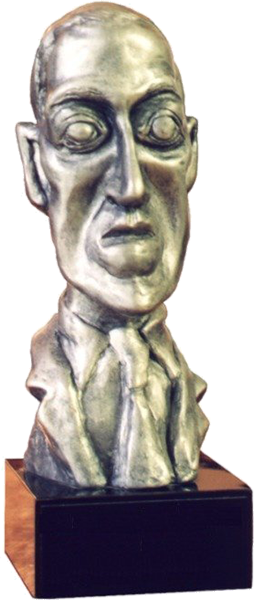
The World Fantasy Award used to be a caricature of Lovecraft, until some winners understandably objected to being honored with a bust of a guy who would have considered them subhuman.
Anyway, today probably when the average person thinks of Lovecraft, they don't think of racism, or even of the powerlessness of humanity against cosmic forces (which was kind of a major theme of Lovecraft's stories). They think of tentacles. To such an extent that "Lovecraftian" sometimes almost gets used as a synonym for "tentacled", as if that's the only salient characteristic of Lovecraft's creations. For an example from an (infamous) RPG, "Venger Satanis" in the introduction to the core rulebook for Empire of Satanis referred to the setting of the game as "H. P. Lovecraft's version of Hell". Of course, Lovecraft, being a staunch atheist and materialist, didn't have a version of hell, but even setting that aside, the demons of Empire of Satanis are very personal and effable beings, and the hell of Empire of Satanis is a place that is very much focused on humans and (im)morality, pretty much the diametric opposite of Lovecraft's impersonal cosmos to which humanity is insignificant and irrelevant. It's not remotely Lovecraftian in any sense, except maybe one: tentacles. (Well, that and unnecessary overuse of obscure adjectives.)
Of course, this misrepresents the Mythos somewhat. Sure, the most famous figure of the Mythos, Cthulhu, had tentacles (except in Deities & Demigods he doesn't, exactly, for some reason), but not everything did, and many of Lovecraft's creatures he didn't describe at all. Still, here in the descriptions of the gods and beings of the Cthulhu Mythos in Deities & Demigods, we're going to encounter a lot of tentacles. Not every god and monster has tentacles, though. Some have pseudopods instead. And some have feelers, or cilia. Okay, there are a few who don't have any of those things... but they're in the minority. So, just for fun, let's count how many times tentacles and similar appendages are mentioned in the descriptions of the entities in this chapter.
Anyway, most of the introduction is given over to a history of the development of Cthulhu Mythos, and to recommendations of particular stories to read. I'm not going to quote or comment on most of this because it's not really germane to the use of this mythos in games; I'll just mention some of the bits that have more applicability to a campaign.
Cthulhu Mythos posted:
Beginning with "The Call of Cthulhu" in Weird Tales, Lovecraft began referring in his horror stories to a pantheon of beings known as the Old Ones, who had descended to Earth from the stars in pre-human times. First worshiped by the non-human races of the planet, the Old Ones were later banished or locked away by the elder gods. The elder gods do not enter into the stories much, and their identity is a mystery. They left the Old Ones weakened, but not destroyed. When man appeared, he found traces of the older civilizations and remnants of the pre-human races. Religions grew up around the Old Ones and legends of their imminent return to power — especially around Cthulhu. Bits of the old lore were discovered and transcribed into books, extremely dangerous books.
My first impulse here was to say that the first sentence here was inaccurate, because "The Call of Cthulhu" wasn't nearly the earliest story in the Cthulhu Mythos—the best candidate for that would be "Dagon", published in 1919, and "The Call of Cthulhu" didn't come till 1928—but the text doesn't actually say that it was the start of the mythos, only that it was the first time Lovecraft referred to the "Old Ones", and that much seems to be correct. I could quibble that the actual term is the Great Old Ones, but that's terminology that crystallized for the Mythos over time; Lovecraft actually did refer to them as "Old Ones" in "Call of Cthulhu" both with and without the "Great". Anyway, this part isn't bad as far as setting the stage for the mythos and hinting at how it could be used in the campaign. I could, again, quibble with the "especially around Cthulhu" part; I don't know that Cthulhu was ever supposed to be the most widely worshipped or the best known in-universe of the Great Old Ones—he's just the one that, for whatever reason, has become most famous and the "face" of the mythos.
Cthulhu Mythos posted:
Cults of men, and particularly of non-human creatures, keep alive the worship of the Great Old Ones and anxiously await their return to power. Various evil magic-users and priests, desirous of superhuman powers, experiment with some of the forbidden books (such as The Necronomicon) and occasionally unleash some horror on themselves or their surroundings. Merely speaking the name of one of the Old Ones results in a 5% chance that the god named will hear, for these deities are quite attuned to the Prime Material plane. If the god does hear its name spoken, it will appear and attempt to kill the being so rash as to speak its name (some of the greater gods will send minions to accomplish this).
Hm... "particularly on non-human creatures"? I don't know about that... sure, Dagon had the Deep Ones, but overall isn't there more mention of human cults of the Great Old Ones in Lovecraft's stories than non-human creatures? Though maybe the non-human cults are just better hidden, so, eh, I don't know, I guess this can work. Anyway, again this is okay for suggesting how to use the mythos in a campaign, though the gods having a 5% chance of showing up to destroy anyone who speaks their names is a bit silly.
We end the introduction with this "SPECIAL NOTE":
Special Note posted:
All creatures of nature are very sensitive to the presence of all creatures of the Cthulhu Mythos. They instinctively call out their warning sounds and flee if any of the Old Ones or their minions come within range of their senses.
Eh... same thing that's said of a lot of supernatural creatures, really. I don't know that this is really interesting enough to be worth having included here, let alone to be set aside in a "special note". But whatever. On to the gods and monsters.
While the Cthulhu Mythos did not appear in "Gods, Demi-Gods & Heroes", it did appear in Dragon Magazine #12, in the article "The Lovecraftian Mythos in Dungeons & Dragons", written by Rob Kuntz, one of the authors of "Gods, Demi-Gods & Heroes" and Deities & Demigods. Or actually I guess it wasn't—the byline says Rob Kuntz, because I guess it was part of a regular column he wrote ("From the Sorcerer's Scroll"), but Kuntz's introduction says the article was written by "J. Eric Holmes (known for his work with Basic Dungeons & Dragons) with additions by my humble self". Anyway, all the gods and monsters in this chapter in Deities & Demigods had appeared previously in this article, with "Gods, Demi-Gods & Heroes"-style entries—and so did the serpent god Yig, who for whatever reason does not appear in Deities & Demigods. This chapter is clearly based mostly on that article, just as many of the other chapters are clearly based mostly on the corresponding sections in "Gods, Demi-Gods & Heroes". (I'll just abbreviate the article title to "TLMDD" when I refer to it below.) Furthermore, for what it's worth, H. P. Lovecraft was one of the seven authors singled out in Appendix N to the first-edition Dungeon Master's Guide, "INSPIRATIONAL AND EDUCATIONAL READING", as having been probably "the most immediate influences on AD&D". (We'll be dealing in depth with two of the other authors in this list in later posts.)
By the way, as it happens, I'm posting this on H. P. Lovecraft's birthday. That's... mostly a coincidence, except that the last couple days when I realized it was almost his birthday I figured I may as well wait to post this part then, so there was no rush to get it done sooner. This may have just been an excuse for procrastination.
But that's enough preamble. Let's get to the goods. (Or evils.)
CTHULHU
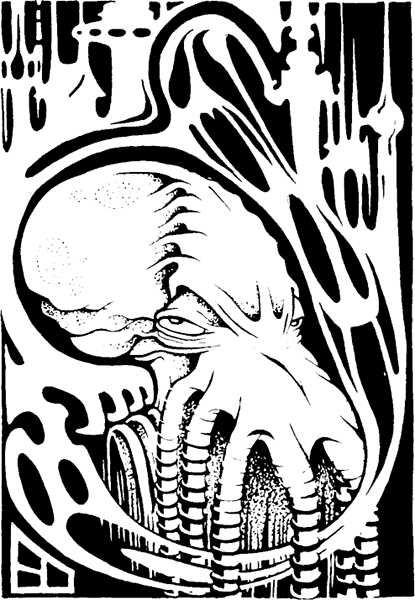
He looks awfully smug for someone who got popped by a yacht.
Yes, of course good old Cthulhu is the god who gets top billing for this mythos, even though in the stories he's not necessarily the most powerful of the Great Old Ones—never mind the Outer Gods, who are arguably more powerful still. (And whom Deities & Demigods doesn't mention... but more on that later.) To be fair, though, it's not clear that the intent is to make him the head of the mythos anyway; yes, he has 400 hit points, but so do all but two of the gods in this chapter.
Oh, remember what the introduction said about negative Charismas? Yeah, here's where it really comes into play. We have seen a few gods with negative Charisma in earlier mythoi: Hastsezini had a Charisma of −1; Morrigan's was "21 or −1" (this was not clarified in the text); Camazotz had −2; Mictlantecuhtli's was −4; Tlazolteotl's was "24/−5" (presumably depending on whether or not she was in her monstrous form, though this, again, wasn't clarified); Chih-Chiang Fyu-Ya's was −2; Lu Yueh's was −3. But Cthulhu has a Charisma of −7, the lowest Charisma listed in the table. All but one of the other gods in this mythos have negative Charisma, too, but only Azathoth and Yog-Sothoth have Charisma as low as Cthulhu's.
Cthulhu posted:
"Ph'nglui mglw'nafh Cthulhu R'lyeh wagh'nagl fhtagn." — "In his house in R'lyeh dead Cthulhu waits dreaming." R'lyeh is a great sunken city of non-Euclidian geometry hidden somewhere beneath the ocean. So bizarre is its construction that anyone entering the city (which occasionally rises above the waves) must make saving throws at +4 against fear and insanity. Cthulhu lies in a huge stone structure sealed with the Elder Sign (q.v.). If the seal is broken and the god released, everyone (and/or everything) in a radius of 100 miles must make a saving throw against death or go insane. This insanity lasts for a number of months equal to the creature's intelligence."
"And/or everything"? I'm assuming by "everything" the authors meant only living things, since it wouldn't make too much sense for rocks to have to make saving throws versus insanity. Even so, the "and/or" is odd. Sometimes people go insane; sometimes livestock and wild animals do; sometimes both.
We get a picture of R'lyeh, too:
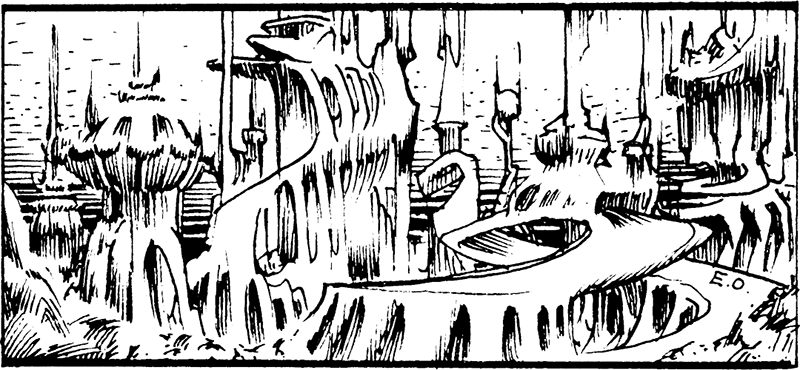
Okay, that's pretty unusual architecture, I guess, but is it really non-Euclidean?
Cthulhu posted:
He will retreat into his lair if confronted with an intact Elder Sign, another of the Old Ones (such as Hastur), or some natural catastrophe, such as the re-sinking of the city of R'lyeh into the sea.
I said I wasn't usually going to mention the gods' combat abilities, but I was curious just how formidable Cthulhu was in a fight and how important it would be to get him to retreat, so I took a look at his stats, and... yeow. Okay, each attack only does 1-10 hit points damage (which is still very respectable damage in first edition), but he has thirty attacks. I... how does that even work? What is he attacking with? In the original story "Call of Cthulhu", the only actual physical attacks we see are "[t]hree men... swept up by [his] flabby claws". (A fourth guy gets somehow swallowed by geometry, but that's not really a physical attack, and anyway might be an effect of R'lyeh rather than Cthulhu himself.)
Cthulhu posted:
Cthulhu is served by the Deep Ones as well as his human worshipers, who often interbreed with the fish-men. Cthulhu's cult is usually hidden and secret, and is dedicated to bringing about Cthulhu's return and conquest of the world.
We'll get to the Deep Ones in a bit.
Tentacle Count: "Tentacle-like cilia". The judges are divided as to whether to count this as a mention of "tentacles" and "cilia", or just "tentacles". Though really, if he has an octopus head, Cthulhu does have tentacles, doesn't he? I mean, octopuses don't have cilia. (Okay, well, their cells do, like those of all animals, but the octopuses as a whole don't have macroscopic cilia.) Did Kuntz and Ward not know what cilia are? Or did they decide Cthulhu was a single-celled organism? TLMDD refers to "feelers" instead, which makes a little more sense, but this is the one being for which it actually would have been entirely appropriate to just say "tentacles".
AZATHOTH (the center of the universe)

This illustration was on the previous page, but I'm going to assume it's Azathoth, partly because I don't know what the hell else it would be meant to be.
Azathoth posted:
Azathath is a blind, mindless, amorphous mass the size of a star, floating at the center of the universe on the astral plane. It is attended by satellite creatures that provide an eerie music, like the sound of idiot flute players.
Putting Azathoth in the Astral Plane seems... odd. I'm pretty sure in the original stories it was supposed to be in outer space. Still, I guess PCs are more likely to travel to the Astral Plane than to outer space, so maybe this was a nod toward making it more useful in a campaign? Though considering that "[a]ny creature coming within 1,000 miles of Azathoth must save vs. spells at −6 or go permanently mad", I still question just how useful it'd be in a campaign. It's not specified whether you have to repeat the save if you stick around in the vicinity, or whether if you make the save you're free to hang around Azathoth all you want without any further risk... apparently it only attacks physically if you attack it first, and it doesn't have any magical abilities outside of the insanity thing.
Come to think of it, if Azathoth is "the size of a star", a thousand miles isn't really that far away. Though stars vary in size by many orders of magnitude, so "the size of a star" isn't very specific. Exactly what kind of star are we talking about?
Azathoth posted:
Those who worship Azathoth worship insanity, and Azathoth's clerics are themselves insane. It is unknown how Azathoth grants powers to its clerics, or even if Azathoth is aware of them (which is doubtful).
Given that it's "mindless" and that its Intelligence and Wisdom are both listed as "—", I'd say it's doubtful it's aware of anything.
Azathoth is even more outrageous in combat than Cthulhu—it only gets twenty attacks instead of thirty, but each attack does 3-18 hit points of damage instead of 1-10. (That's 210 damage on average, to Cthulhu's 165. Though Cthulhu does also have magical and psionic powers, which Azathoth doesn't.) On the other hand, given that Azathoth is so much bigger than Cthulhu, I think a good argument could be made that its damage isn't nearly outrageous enough...
It may be worth noting that in the Cthulhu Mythos as usually understood Azathoth is not, in fact, one of the Great Old Ones; he's an Outer God, which is a separate and more powerful kind of entity. (He's the ruler of the Outer Gods, in fact, so if anyone merits being called the head of the mythos, it's him. And yes, my choice of pronoun is deliberate; while Deities & Demigods refers to Azathoth as "it", Lovecraft uses a masculine pronoun to refer to Azathoth in "Haunter of the Dark"—though one could certainly argue that as Azathoth is a mindless, utterly alien being, "it" might be more appropriate.) To be fair, it's not clear to what extent Lovecraft himself intended to make that distinction, and to what extent the clear differentiation between Great Old Ones and Outer Gods was the work of other writers.
According to TLMDD, "[i]f Azathoth is destroyed the entire universe will collapse back to a point at the center of the cosmos with the incidental destruction of all life and intelligence." So even if you are somehow powerful enough to defeat Azathoth... maybe don't?
Tentacle Count: "Many pseudopods".
BYAKHEE (servants of Hastur)
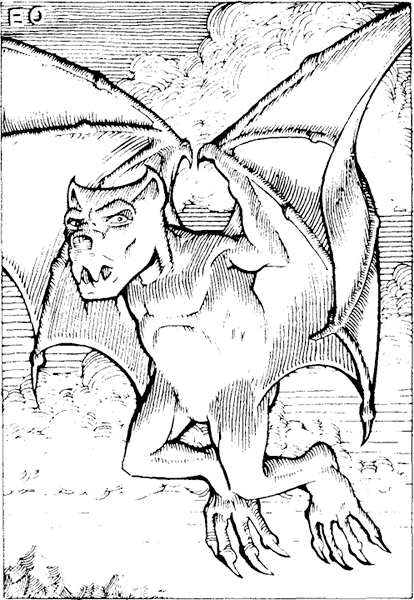
"You rang?"
Byakhee posted:
These giant furry bat-like creatures have humanoid legs that enable them to stand like men. They can be summoned by clerics of Hastur through use of a gate spell (1-4 Byakhee will appear). They are able to teleport throughout the Prime Material Plane at will, carrying human beings with them on their backs or in their talons. They are intelligent, telepathic, and will obey those who carry the Elder Sign or who appeal successfully to Hastur.
That's their entire description. I have nothing to add, except maybe that in the original stories they could fly at tremendous speeds through the vacuum of space, but they didn't actually teleport. But then, in first edition the nature of the Prime Material Plane past the worlds' surfaces hadn't really been defined (Spelljammer wouldn't come along till second edition), and I guess it wasn't really clear that the vacuum of space was even a thing in D&D. (Though I suppose "Expedition to the Barrier Peaks" kind of implied it was.)
Tentacle Count: None.
CTHUGA (master of the fire element)

I like that little divot to the left of its nucleus that kind of makes it look like it's smiling.
Cthuga posted:
This creature resembles a flaming amoeba with tentacles that appear to be flames emanating from its body.
And then after that one sentence of description we get seven sentences about its combat abilities. The last sentence of which calls Cthuga "him" when everywhere else in the description Cthuga is referred to as "it".
Well, okay, I guess one of those seven sentences isn't really about its combat abilities, but it's buried among six other sentences that are:
Cthuga posted:
It moves as a blink dog and attempts to destroy everything within any area to which it is summoned.
Okay then. I guess the only reason to summon Cthuga is if you really want a place trashed. (And if you think you can get out of there after summoning it but before the destruction begins, I guess.)
Cthuga lives on the Elemental Plane of Fire, and...
Cthuga posted:
The creature has a direct connection with the Prime Material Plane by way of a Palace of Fire that it has created in an active volcano. This palace is said to be filled with treasure resistant to flame and heat: gems, certain magic items, and the like.
So... is this intended to be an adventure hook to entice PCs into finding the Palace of Fire and looting its treasures? Because I think there are a lot of much less dangerous ways for PCs to get rich than trespassing in the lair of a chaotic evil greater god...
First of all, Cthuga's name is misspelled—it should be "Cthugha". And second, I don't know why Cthugha is here. Yes, technically he did appear in the Cthulhu Mythos (he didn't appear in Lovecraft's original stories, but was a creation of August Derleth), but uh, he's not one of the most prominent Great Old Ones, and certainly not one of the most interesting. (Nor, arguably, is he really a good fit for the Mythos; Derleth had this odd fixation about matching up Great Old Ones to the four classical elements that wasn't followed by any other major Mythos writer.) I can think of a bunch of entities from the Cthulhu Mythos that aren't in this chapter and probably deserved to be more than Cthugha does. Chaugnar Faugn, Dagon, Tsathoggua, Ubbo-Sathla, Yig... But oh well. Enjoy your boring weird fire amoeba.
Tentacle Count: "Tentacles that appear to be flames".
Cthuga's Flame Creature
These are basically smaller versions of Cthuga (but still huge; they have a thirty-foot radius compared to Cthuga's forty-yard radius). It mentions in Cthuga's entry that Cthuga's first act when appearing in any location is to summon 1-20 of these things. (TLMDD just lets Cthuga summon fire elementals rather than giving him bespoke monsters.) Also,
Cthuga's Flame Creature posted:
One of their functions is to appear when the god is supposed to appear but is too busy or chooses not to come.
We're given absolutely no information about what these things do when they're not being summoned, or sent on behalf of their master. Just hang around and be on fire, I guess.
Tentacle Count: None explicitly mentioned, but if they're smaller versions of Cthuga, they presumably also have "tentacles that appear to be flames".
DEEP ONES (followers of Cthulhu)
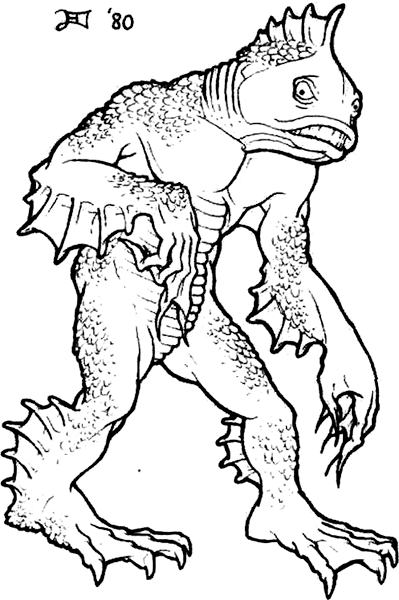
"Oh. 'You seem fishy.' Now I get it."
The Deep Ones are fish guys with "great strength (18)" but no special properties. We're given a few sentences about how they can breed with evil humans à la The Shadow Over Innsmouth, and told that they "promote evil in preparation of Cthulhu's return".
Deep Ones posted:
They do this by collecting treasures from the sea and using them as funds to spread the cult of Cthulhu and the Old Ones
...How exactly do they use these funds to spread the cult? Printing pamphlets? Hiring a PR firm?
Tentacle Count: None.
GREAT RACE
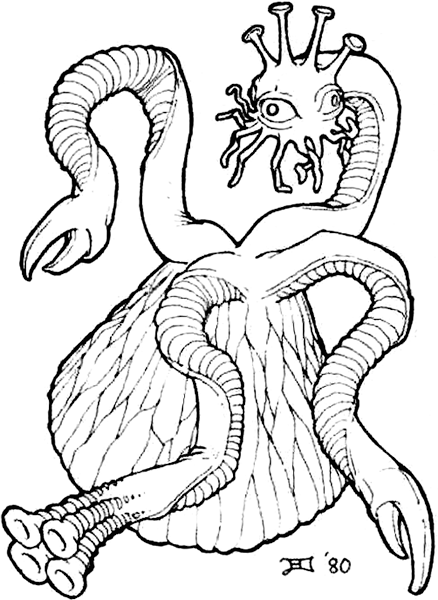
The Great Race was also a 1965 comedy starring Tony Curtis and Jack Lemmon, but that's clearly not what's depicted here.
Great Race posted:
These creatures populated the world eons ago and their cities still exist buried in deserts or other out of the way places. They hod a highly advanced scientific civilization, with psionics rather than magic. When their civilization was destroyed, some of them were frozen in time, and these are occasionally discovered... Humans discovering and freeing them are sometimes rewarded with gifts of knowledge.
Their big schtick in the original stories in which they appeared was that they could temporarily swap minds with people in other times. There's no indication of that here, though to be fair I guess that could be kind of difficult to work into a D&D campaign. Actually, their mind-swapping is described in TLMDD, so I guess it was just cut for Deities & Demigods.
Tentacle Count: "4 ten foot long tentacles".
HASTUR (He Who Must Not Be Named) "Master of the Air"
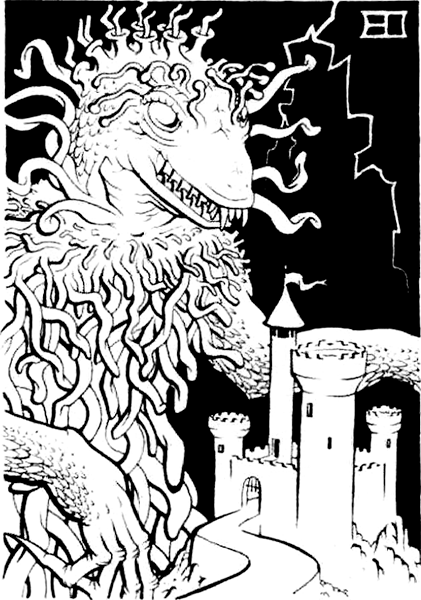
Hastur's stats say he's six hundred feet tall, so the scale here is actually about right. (He's only a hundred feet tall in TLMDD, though.)
Hastur posted:
Hastur is half-brother to Cthulhu, and like him Hastur has been imprisoned by the star-shaped Elder Sign. He lies in a crypt at the bottom of Lake Hali near the alien city of Carcosa. Hastur exists partly on the Prime Material Plane (and this part is imprisoned in the crypt) and partly on the Elemental Plane of Air (thus he is immune to cold and the vacuum of space). Hastur is never more than partially on the Prime Material Plane and is therefore not completely solid. This accounts for much of his great size.
I'm... not sure how any of that is supposed to work. So if you travel on the Elemental Plane of Air, can you encounter the part of Hastur that's trapped there? Can that part of Hastur ever leave the Elemental Plane of Air? Does it look the same and have the same characteristics as the part on the Prime Material Plane? What happens if both parts come to the same plane? Or is that impossible?
Anyway, remember in the introductory text how it said any of the Great Old Ones had a 5% chance to respond if you spoke their name? With Hastur that chance goes up to 25%. At first he'll just send 1-4 Byakhee (yes, it's capitalized), but if you defeat the Byakhee there's then a 25% chance that Hastur will appear himself, which... you probably really don't want to happen.
Combat-wise, Hastur's more ridiculous than even Azathoth (though just barely). While he only gets two attacks instead of Cthulhu's thirty or Azathoth's twenty, each attack does 20-200 hit points of damage. (So that's 220 hit points on average, to Azathoth's 210. And in case you're wondering whether there's a difference in their chances to hit, nope, Cthulhu, Azathoth, and Hastur all fight "As 16+ HD monster"—as does every god in this chapter except Ithaqua and Nyarlathotep.)
Tentacle Count: "200 tentacles projecting from its body". Hastur is the tentacle champion.
ITHAQUA (lord of the air)
Yes, Hastur is Master of the Air, but Ithaqua is lord of the air, so... I don't know what that means about their respective dominions. Oh... wait. "It is known that Ithaqua serves Hastur in special missions of great importance." So I guess Master > lord. Okay.
Ithaqua posted:
Ithaqua, the Wind Walker, appears as a cloud of fog or snow, huge but human in shape with blazing red eyes. When seen passing overhead, one gets the illusion of two bright stars close together.
"Ithaqua is worshiped by the natives of the far North" who "propitiate him with human sacrifices", because racism. He carries off the sacrifices and their frozen bodies are found years later, or sometimes they show up still alive only to soon "die from strange unnatural causes".
Ithaqua posted:
Ithaqua will also pursue and capture anyone who sees or annoys him, or meddles with his worshipers or their stone altars in the forest.
So he's a particularly active, hands-on type of Great Old One.
Ithaqua was another Derleth creation, who was identified with the wendigo (as mentioned in TLMDD but not in Deities & Demigods) and maybe the yeti, and in some ways his original description was a little less racist than his description in Deities & Demigods, in that only a few people made sacrifices to him—rather than it being a general practice among the "natives of the far North" as Deities & Demigods implies—and even they weren't so much worshipping Ithaqua as propitiating him. Ithaqua is another minor and not very interesting figure from the Cthulhu Mythos, and probably the only reason he's here instead of a better known figure is because he played a prominent rôle in Brian Lumley's Titus Crow series, which had been published only shortly before Deities & Demigods. (Lumley is explicitly namedropped in the introductory text to this chapter as one of the "younger authors" currently writing stories based on the Cthulhu Mythos, so Kuntz and Ward were certainly aware of his work.)
Tentacle Count: None.
MI-GO (the fungi from Yuggoth)

Those mouths(?) might look alien, but I have no idea how they're supposed to actually function.
Like the byakhee and the Deep Ones, these are monsters rather than gods, and like the byakhee they have only a single paragraph of description.
Mi-Go posted:
These red, bat-winged creatures somewhat resemble lobsters in that they have many legs, feelers, and eyestalks, and forearms that end in great pincers. Though they appear to be crustaceans, they are actually fungus creatures. Mi-Go are immune to the effects of cold, dark, and vacuum, and can fly across interstellar space. They cannot speak, but communicate by clicking their pincers.
Of course, if they're completely alien beings with no connection to Earth organisms, it doesn't make any sense for them to be crustaceans or fungi, but, well, the Lovecraft Mythos was never hard sci-fi. "Yuggoth", in the Lovecraft Mythos, is a planet at the edge of the solar system. When Pluto was discovered in 1930, Lovecraft made a perhaps tongue-in-cheek suggestion in a letter that Pluto might be Yuggoth, but not all contributors to the Mythos followed this suggestion (nor did Lovecraft himself make this identification explicit in any of his stories). TLMDD does say that Yuggoth is "the planet Pluto", though.
Tentacle Count: "Feelers".
NYARLATHOTEP (the crawling chaos, the messenger of the gods)
Nyarlathotep posted:
Nyarlathotep appears as a tall dark man. His appearance in the world is said to foretell the return of the Old Ones from their imprisonment.
Actually, Nyarlathotep was associated with the Outer Gods, not the Great Old Ones, but whatever.
Remember I said all but one of the gods in this pantheon had negative Charismas? Nyarlathotep's the one. He has a Charisma of 19. He's a charming guy.
Actually, he's literally a charming guy. He can charm with his gaze "humans, humanoids, and non-magical animals", causing them to "either obey him or behave in a purely chaotic manner"; good creatures get a bonus to their saving throws, and evil creatures get a penalty. "Thus his progress across the face of the land is followed by riot, war, mass murder, suicide, and insanity."
As for what he looks like, we're told that "[t]he god is believed by some students of the occult to have various guises, including a red bat-like form with three evil eyes." Nyarlathotep did indeed appear in various forms in the stories of the Lovecraft Mythos, including the form described here (which appeared in Lovecraft's last story, "The Haunter of the Dark"), but this form doesn't seem to have been one of the most prominent, so I'm not sure why it's the one that gets singled out here. TLMDD says instead that he "appears as a tall dark man, often dressed as a pharaoh, but is sometimes portrayed as a faceless sphinx".
Tentacle Count: None mentioned, but if he has "various guises" there's a good chance he has tentacles in at least one of his forms.
PRIMORDIAL ONE
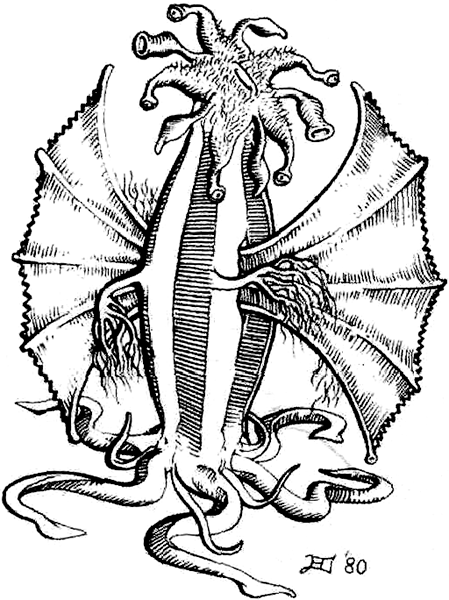
Those wings look far too small for flight.
More monsters rather than gods, but not mere monsters but "actually an alien race of high intelligence and advanced science." The alignment of the Primordial Ones is given as lawful evil, which is... disappointing. In At The Mountains of Madness, the Lovecraft story that introduced these creatures, much was made of how for all their weird physiology, these things seemed to have been very close to human in thoughts and behavior; I'd rather have seen them as neutral, or maybe even good. Here we get the description that "[t]hey hate all other types of intelligence, and will destroy them if possible". That makes me sad. We need more bizarre, utterly inhuman entities that aren't necessarily hostile, goddamit.
(For what it's worth—which admittedly isn't much"when these creatures finally appeared in Pathfinder as "elder things" in the Pathfinder Roleplaying Game Bestiary 4 (Pathfinder really has a thing for using creatures from the Cthulhu Mythos, despite their not remotely fitting with Pathfinder's cosmology in any way), they were lawful neutral, which... okay, I guess that could be justifiable.)
In TLMDD, these creatures aren't called primordial ones, but "The Old Ones"—though this is followed immediately by a disclaimer that this is "[a] misnomer, since this refers not to the ancient gods, but to a minor race of interstellar beings." Actually, neither name is the one usually used for them in the Cthulhu Mythos; they're usually called "elder things", like in the Pathfinder Bestiary 4. To be fair, in "At The Mountains of Madness" both the terms "Elder Things" and "Old Ones" are used for them, though "primordial ones" seems to have been an invention of Kuntz and Ward (presumably to avoid the ambiguity of "Old Ones").
Tentacle Count: A twofer: "wiry cilia" and "5 powerful tentacles". Again, I do not think Kuntz and Ward knew what cilia are.
SHOGGOTH
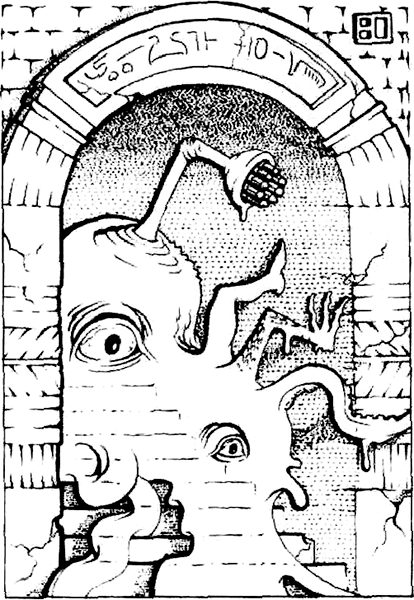
Did it form a missile launcher out of its protoplasm?
Another monster, another one-paragraph description.
Shoggoth posted:
Originally created by the Primordial Ones as servants, the Shoggoths eventually rebelled and destroyed the civilization of their masters. Shoggoths resemble huge, intelligent amoebae, able to form almost any shape out of their near-transparent bodies, including legs, eyes, mouths, huge weapons, or whatever is needed. The few remaining Shoggoths lurk in distant, long-deserted areas, sometimes aiding servants of Cthulhu or other Old Ones.
In TLMDD, their name is spelled "shaggoths"—which is in fact how the name appeared in one printing of "The Thing on the Doorstep", but that seems to have been a transcription error.
Tentacle Count: None mentioned, but given that they're described as resembling huge amoebas, the authors really missed an opportunity to use the word "pseudopods" again here.
SHUB-NIGGURATH (black goat of the woods with a thousand young)
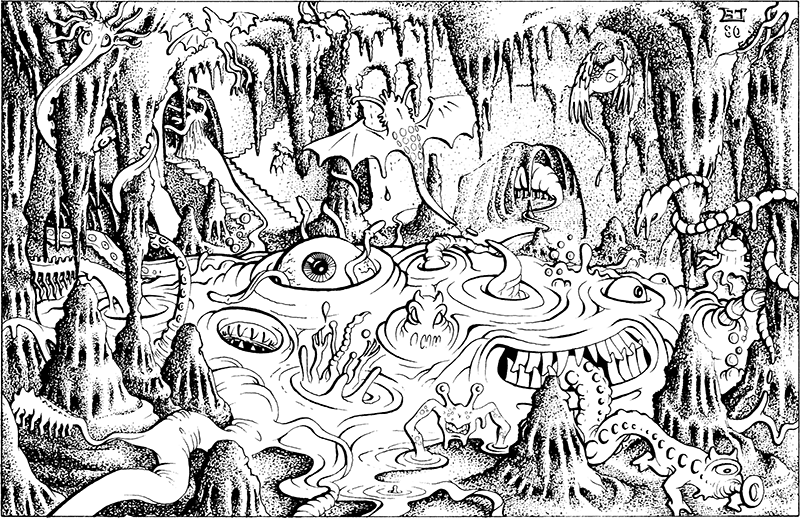
So is it eating that thing in the lower right, or is the thing coming out of its mouth? I'm going to assume the latter.
Shub-Niggurath posted:
This fountain of uncleanliness is a huge pool of gray matter, 100 feet across, in the caverns beneath Mount Voormithadreth. It is constantly bubbling and putting forth mouths, limbs, pseudopods and whole creatures. 1-100 small monsters are created from the pool each round, and they go crawling, flopping, or flying away into the caverns above. Some fall back into the pool, which then grows mouths and devours them.
Did I say Druaga was my favorite god from this book? Hm... I don't know. Shub-Niggurath was up there too. That is, Shub-Niggurath as presented in Deities & Demigods. Lovecraft frequently mentioned Shub-Niggurath in her stories, but never really described her; the closest he came is in a letter in which he said she was a "cloud-like entity". The Deities & Demigods description is, on the other hand, a very good fit for a different figure from the Lovecraft Mythos, an Outer God named Abhoth created by Clark Ashton Smith. This was not, apparently, entirely an accident; TLMDD said that Shub-Niggurath was "[p]robably identical with the god Abhoth of ancient Hyperboria and Ubbo-Stahla the unbegotten source"—though I don't think those three gods are conventionally identified with each other in most sources. Anyway, of course at the time I first got this book, I didn't know any better and didn't realize this version of Shub-Niggurath wasn't really faithful to the stories of the Mythos, but I guess the idea of a giant slimy puddle that continually churned out random monsters really appealed to me.
Anyway, yes, I did use Shub-Niggurath in at least one campaign. According to Deities & Demigods, when Shub-Niggurath senses the approach of enemies she randomly generates monsters from this chapter to defend her—Byakhee, Deep Ones, Great Race, Mi-Go, Primordial Ones, or Shoggoth. (And yes, in the illustration you can see one of the Great Race going up a staircase in the background. Wait... why is there a staircase in this cavern anyway?) But even back then knowing nothing about the Mythos beyond what was in this chapter, that didn't make sense to me—all of those monsters were either tied to different gods, or weren't associated with the Great Old Ones at all; why would Shub-Niggurath create them? So instead I used the "RANDOM GENERATION OF CREATURES FROM THE LOWER PLANES" tables in Appendix D of the Dungeon Master's Guide (itself copied from an earlier issue of Dragon Magazine) to randomly generate her monstrous spawn.
(Okay, admittedly once again I'm using a different pronoun from Deities & Demigods; Deities & Demigods refers to Shub-Niggurath as "it", but most other sources seem to use "she", so that's what I'm doing, I guess.)
Shub-Niggurath posted:
Though its body is trapped deep in the caverns, Shub-Niggurath travels the Prime Material Plane in astral form, using its psionic powers to do evil and aid its worshipers.
Does she still look like a big grey puddle in astral form? Can she still spawn monsters? It doesn't say. Oh well.
Tentacle Count: Well, they did use "pseudopods" in this entry... and "a huge powerful tentacle". Another twofer.
YOG-SOTHOTH (the key and guardian of the gate)
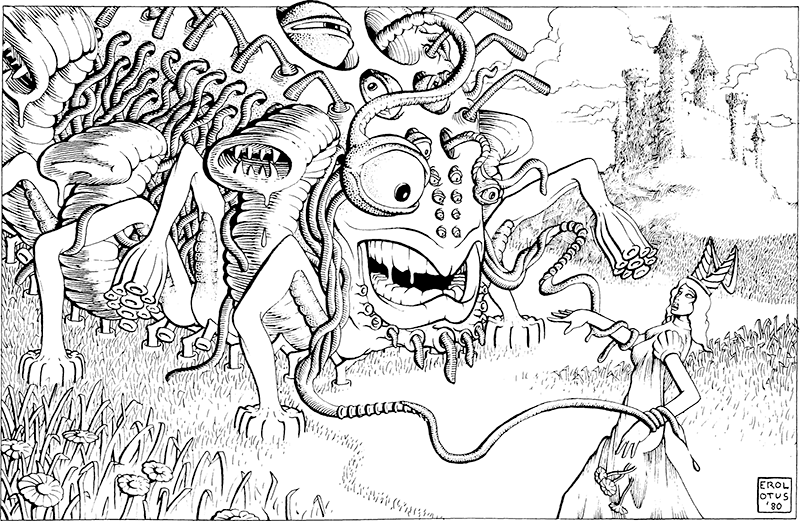
I know the text said he would "mate with human beings", but I don't think we needed an illustration of this. (Though, given how bizarre her anatomy looks, maybe that woman isn't human...)
Yog-Sothoth posted:
Yog-Sothoth exists on the astral plane. He has the ability to enter the universe at any point in space and any point in time. His astral shape appears as a congeries of iridescent globes like giant soap bubbles. When he takes shape on the Prime Material Plane he is partly material and partly astral and appears as a gigantic mass of feelers, legs, and stalked organs. In this shape he will mate with human beings, producing the Spawn of Yog-Sothoth (see "The Dunwich Horror", by H. P. Lovecraft).
Fortunately, the text does not dwell on that any further. (For what it's worth, though, in "The Dunwich Horror" there's no indication that the mating was nonconsensual—though if Yog-Sothoth is chaotic evil I guess that sort of thing wouldn't be beyond him.)
Yog-Sothoth posted:
Yog-Sothoth is not subject to the laws of space and time and can, for example, appear at various parts of the universe simultaneously.
That's kind of something I'd have thought all gods ought to be able to do, but in Deities & Demigods I guess they can't.
Oh... like Azathoth and Nyarlathotep (and maybe Shub-Niggurath, but the jury seems to be out on that one), Yog-Sothoth is supposed to be an Outer God, not a Great Old One, but oh well.
Tentacle Count: "Feelers".
I guess I may also cover the one god that appears in TLMDD but not in Deities & Demigods:
Yig, Supreme God of Serpents
Yig posted:
Yig is represented as a great (17+) long snake, although he (it?) may alter shape slightly to appear as a Naga (see Monster Manual), with the upper part of the body appearing as a human and the lower that of a snake.
Hm... kind of interesting that Yig's entry would refer to the Monster Manual, actually, since his stats are given in OD&D terms like in "Gods, Demi-Gods & Heroes" and the Monster Manual was, of course, for Advanced Dungeons & Dragons. But at the time this issue of Dragon Magazine came out, though, the Player's Handbook and Dungeon Master's Guide had yet to appear, so the Monster Manual was the only AD&D rulebook yet available. Anyway, Yig's entry is fairly long (in general, in fact, the gods' descriptions in TLMDD are longer than the descriptions in "Gods, Demi-Gods & Heroes"), but aside from the quoted sentence it's all about his combat abilities, so... meh. In the story "The Curse of Yig", Yig is described as somewhat more human than in TLMDD—and, interestingly, is also explicitly said to be "not wholly evil".
Okay, that's it for the gods of the Cthulhu Mythos, but we now have two magic items to cover...
...and dang it I went over the maximum message length again. Not by too much this time, so I could probably edit a few paragraphs out and squeeze it in, but, eh, I'll just split the post again. Next post is going to be short, then.
Next time: If You're Smart Enough to Read This Book, You're Not Stupid Enough to Read It
If You're Stupid Enough to Read This Book, You're Not Smart Enough to Read It
Original SA post Deities & Demigods 1EPart 12: If You're Stupid Enough to Read This Book, You're Not Smart Enough to Read It
Yeah, in the "Next time" in the last post, I wrote that the other way around, switching the "smart" and "stupid", but I thought it made more sense this way so I changed it.

Well, once again it's been way too long since the last part of this review, and I really don't have a good excuse since this one is so short and, since it and the previous update were originally intended as a single update and got split up only because it went over the character count, it was already mostly written... although I did add to it a bit (well, kind of a lot) and put in some images (since all the images from the Cthulhu Mythos chapter of Deities & Demigods were already included in the previous part). But, uh, better late than never?
So, when we left off, we'd covered all the gods and monsters in the Cthulhu Mythos chapter of Deities & Demigods, but we still have a couple of magic items left to discuss. These magic items don't get simple one-paragraph descriptions like the magic items in the previous chapters we've covered so far, though; this time they each get several paragraphs devoted to them, and they're fairly long paragraphs. (Well, only two paragraphs for the first one, but four paragraphs for the second.) Still, again, this is going to be a relatively short post.
THE ELDER SIGN
The Elder Sign posted:
This small grey (sometimes greenish) stone in the shape of a five-pointed star is a powerful protection against all minions of the Old Ones. The true potent Elder Signs are few in number and incredibly ancient, having been made by the elder gods.
Are there also false, impotent Elder Signs? Anyway, they provide "100% protection against psionic attacks" (which all the gods and creatures of the Cthulhu Mythos are capable of except Azathoth, Deep Ones, and shoggoths), they can drive off any of the non-god servants of the Great Old Ones and provide a +6 bonus to Armor Class and saving throws against attacks of the Great Old Ones themselves (which, okay, in first-edition rules means lowering the Armor Class by 6), and they're very hard to destroy.
The Elder Sign posted:
The Elder Sign was used by the elder gods to seal off those places where the Great Old Ones were imprisoned or where they had a chance of "breaking through" in force to the Prime Material Plane.
The description of the Elder Sign here as a five-pointed star follows the description in The Lurker at the Threshold, a book that was published eight years after Lovecraft's death and that incorporated a few unfinished scraps by Lovecraft, but which was almost entirely written by August Derleth. Lovecraft himself never described the Elder Sign in any of his published stories, but he did sketch it in at least one letter to Clark Ashton Smith, and Lovecraft's version of the Elder Sign was very different, resembling not a five-pointed star but a branch with six twigs.
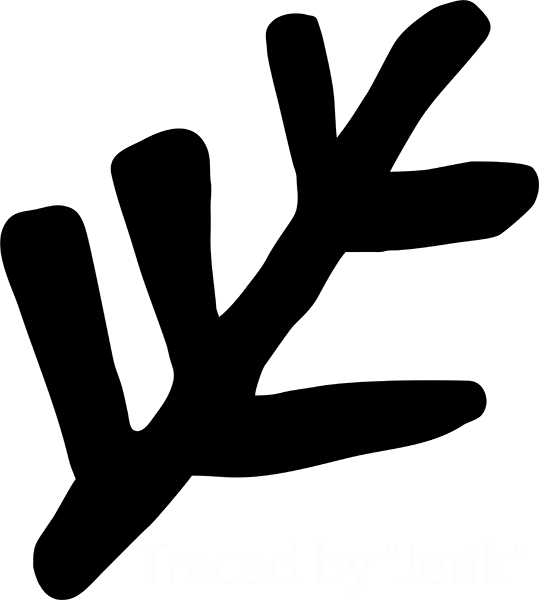
A reproduction of Lovecraft's sketch of the Elder Sign
(Speaking of Clark Ashton Smith, by the way, who was a frequent correspondent of Lovecraft and a major contributor to the Cthulhu Mythos, his work outside the Mythos also made a mark on D&D, albeit a relatively minor one: a good part of the classic Basic D&D adventure X2: Castle Amber, by Tom Moldvay, takes place in Smith's fictional land of Averoigne.)
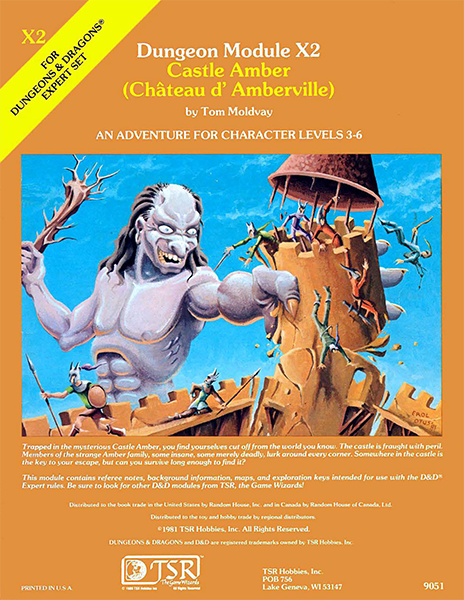
The cover of Castle Amber (coincidentally by Erol Otus, who also did most of the art for the Cthulhu Mythos chapter of Deities & Demigods).
Nevertheless, for better or for worse, it's Derleth's version of the Elder Sign that's more or less gone on to become the "canonical" version, as much as anything is canonical in the highly collaborative and unregulated development of the Mythos. Chaosium's Call of Cthulhu game, too, depicts the Elder Sign as a five-pointed star (or at least, in the latest edition, quotes Derleth's description of it), and in this form it figured prominently on the cover of the 20th Anniversary edition of the core rulebook.
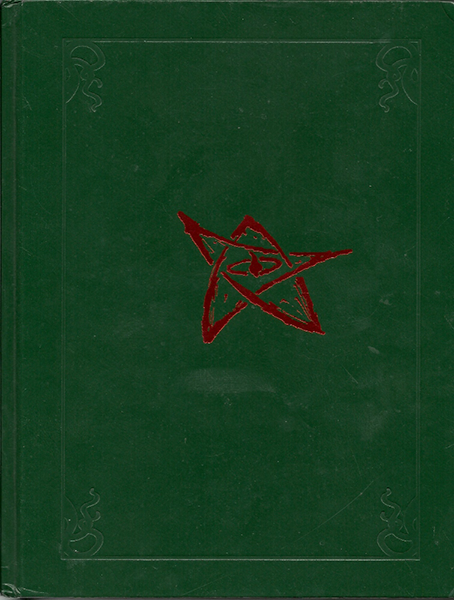
"Prominently" as in it's pretty much the only thing on the cover.
THE NECRONOMICON
Yep, here's the one thing from the Cthulhu Mythos that may be as famous as Cthulhu, if not more so—so much so that there are people who don't realize it's a fictional invention and think it's a real book of the occult. (Some publishers have sold what they claimed were copies of the Necronomicon, but of course they were basically cobbled-together nonsense.) Again, though, I don't think it was nearly as famous at the time Deities & Demigods was published as it is today (or at least if it was I somehow wasn't aware of it). We get four whole paragraphs about it—or really three paragraphs, since the fourth paragraph isn't about The Necronomicon itself but a discussion of "other magical books giving information on the Old Ones and their minions" which are "not as dangerous to the magic-user or his surroundings". The first paragraph summarizes the history of The Necronomicon, which I'm not going to bother going over because if you're familiar with the Cthulhu Mythos you already know it, and if you're not you probably don't care. The next two paragraphs get into the book's contents and its game effects.
According to the second paragraph, "[t]he book gives a description of the pre-human worship of the Old Ones, their banishment by the elder gods, and their imminent return."
The Necronomicon posted:
The revelations of cosmic horror contained within its pages are so intense that there is a 40% probability of characters below level 5 changing alignment to chaotic (d6, 1-3) or going mad (4-6).
Interestingly, it doesn't say characters will change alignment to evil, just chaotic. Huh. And yes, characters level 5 or above still have a chance of changing alignment or going mad; the chance just decreases by 5% per level above fourth. (So I guess a character 12th level or higher can read The Necronomicon risk-free.)
The third paragraph is all about the spells in The Necronomicon.
The Necronomicon posted:
It would appear that spells are given for summoning all of the Old Ones and their minions, and some spells for their control and dismissal, although these latter are not always effective.
Few characters would ever be able to use those spells, though, because you need an Intelligence of 18 and to be at least sixth level to even have a chance of casting them—and even then, it's only a small chance, and you have to be 16th level before that chance even reaches 50%. And that's without factoring in that "[m]any of the spells require that the 'stars be right', and can only take place at certain times of the year or in certain places." And even if you can cast the spells, that doesn't mean you should; the greater summoning spells "will result in a straight 30% chance of the caster going insane". And then we have this:
The Necronomicon posted:
The spells don't always work: in particular they often fail to protect the magic-user from the thing he or she has called from the outer darkness. Such unfortunates are rarely seen again, although simulacra or zombie-like imitations sometimes appear.
So... yeah. You probably shouldn't touch The Necronomicon with a ten-foot pole. Which, to be fair, is pretty genre-appropriate.
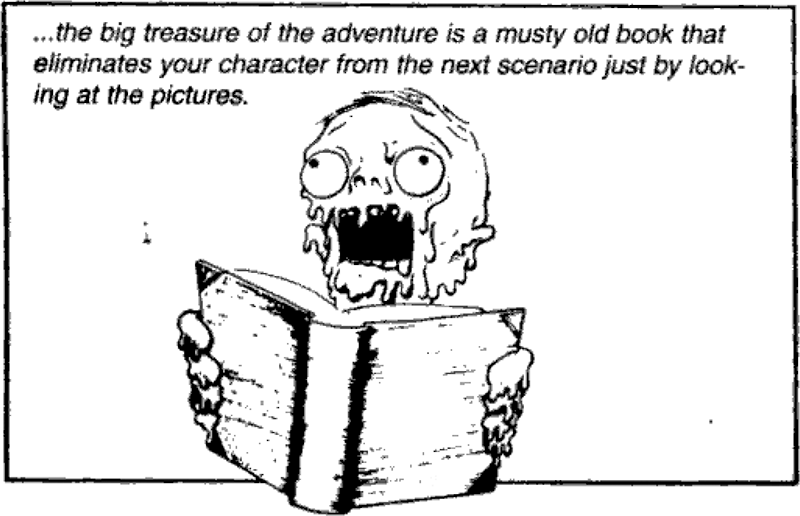
This panel from a cartoon that appeared in the Call of Cthulhu 5th edition rulebook seems relevant.
That's it for the Cthulhu Mythos chapter in Deities & Demigods, but there's one more thing I probably should have included in the previous part. For the mythoi that had also appeared in "Gods, Demi-Gods & Heroes", I'd also discussed the intro to the corresponding section there—and so while the Cthulhu Mythos wasn't in "Gods, Demi-Gods & Heroes", as I said before it did appear in Dragon Magazine #12, and I guess I may as well touch briefly on the text there. We start with the following paragraph by Rob Kuntz:
quote:
Those of you who have read H.P. Lovecrafts [sic] stories based around his fallen gods, The Great Old ones, will know what it means to finally get them into a form which in [sic] they are understood and compatible with the D&D system. J. Eric Holmes (known for his work with Basic Dungeons & Dragons) with additions by my humble self bring you parts of the Cthulhu Mythos. They are laid out to be compatible with Dungeons & Dragons supplement IV "Gods Demi-Gods & Heroes." For all of you Lovecraft enthusiasts here's what you've been waiting for. For all of you not familiar with the Cthulhu cycle here's a new experience.
(I didn't make a formatting error there; that whole paragraph is italicized in the magazine. Also, yes, that's how "Great Old ones" is capitalized there.)
Then we get a paragraph summarizing the Cthulhu Mythos, similar to, but shorter than, the introduction to the Cthulhu Mythos chapter in Deities & Demigods. But as short as it is, there are several things here that I think are worth discussing. Including the first sentence:
quote:
The Great Old Ones of the Cthulhu Mythos are completely evil and often times chaotic.
There are two things to comment on here. Maybe three, because hey, they capitalized "Great Old Ones" correctly this time. But more to the point, it's kind of interesting that they're separating evil and chaos here, since Original D&D focused more on law vs. chaos than good vs. evil. Still, this isn't all that unusual; the standard alignments in OD&D and Basic D&D may have been lawful, neutral, and chaotic, but that doesn't mean good and evil weren't a thing, and they were occasionally highlighted as a separate thing from law and chaos. Heck, we've seen that already here in the "Eastern Mythos" (though it kind of weirdly seemed to contrast law and evil), and I'll have more to say on the subject when we get to the Deities & Demigods appendices. What I think is slightly more interesting is that when the gods finally were fully statted in AD&D terms in Deities & Demigods, rather than being universally evil and mostly chaotic as stated here, they were instead universally chaotic and mostly evil (Azathoth, as mentioned earlier, being chaotic neutral).
The other thing in this paragraph that I think is worth discussing is that, well, it makes it out to be even more dangerous to call on the gods of the Cthulhu Mythos than Deities & Demigods does.
quote:
Evil clerics or magic users who call upon the Old Ones, using the spells from the Necronomicon or the other books of elder lore, run a 25% chance of being destroyed by the gods they evoke. (The Dungeon Master may revise this probability downward for priests of Cthulhu, high level evil magic-users, etc.) 50% chance of one of the servants of one of the Old Ones appearing, 25% of the god appearing and cooperating. If the god attacks he will then ravage the countryside for 1-6 turns and disappear.
At least I guess if one of the Great Old Ones does appear he doesn't stick around for more than an hour, so... could be worse?
We end with the following brief paragraph.
quote:
Only Lovecraft's major gods are described here. There are many minor deities: Chaugnar-Faugn, Lloigor, Tsathoggua or Shudde-M'ell in the works of Lovecraft and his literary disciples, which could be called upon in a Lovecraftian D&D campaign.
Uh... I wouldn't say all the gods described here are among "Lovecraft's major gods". Cthug[h]a and Ithaqua aren't really major gods in the Mythos, and they definitely aren't Lovecraft's; as previously discussed, they were both created by August Derleth.
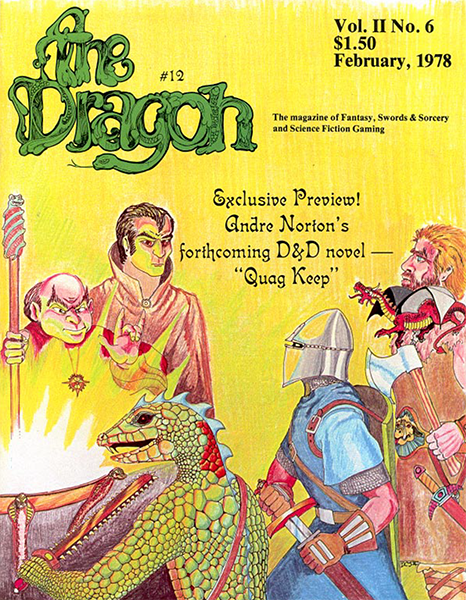
Here's the cover to Dragon #12, just because I thought this post could use more images.
Anyway, there we have it. The Cthulhu Mythos, the first (but not the last) mythos in this book to be based entirely on relatively recent fiction and not on myths or legends, and one of the two mythoi to only appear in the first printing. Like I said, as a child I really loved the monsters of this Mythos, but I had never read anything about Lovecraft and knew nothing about them except what was in this chapter—which didn't stop me from using them in my campaigns anyway. Though the Cthulhu Mythos was cut out of later printings of Deities & Demigods, that wasn't of course the end of Mythos references in D&D. D&D never went all out haphazardly tossing in Mythos creatures apparently at random like Pathfinder later would, but Lovecraft was occasionally namedropped in Dragon Magazine articles; he was brought up several times in the 2E Complete Book of Necromancers; and about a quarter page in the 3E Lords of Madness was given over to discussion of the similarities between the Elder Evils and the beings of the Cthulhu Mythos. The fourth-edition Dungeon Master's Guide asked if the player might "want a horrific campaign inspired by the works of H.P. Lovecraft or Clark Ashton Smith", and the fifth-edition core books not only copy that sentence from the fourth-edition DMG but also, in the Player's Handbook, kind of come full circle by including an "Inspirational Reading" appendix similar to Appendix N from the first-edition DMG which, of course, once again includes the works of H.P. Lovecraft... and the PHB also states that one possible patron of warlocks of the Great Old One is "Great Cthulhu". So the later editions of D&D may not have had statistics for the creatures of the Cthulhu Mythos, but that doesn't mean they weren't in some way still a part of the game.
Next time: Evil is a Semicircle with Legs
There's a 5% Chance That This Will Make Sense
Original SA post Deities & Demigods 1EPart 13: There's a 5% Chance That This Will Make Sense
(No, that's not what I said in the last post would be coming "Next Time", but it's been long enough since then I figured nobody would remember anyway.)

You're probably guessing that those hieroglyphics in the upper right don't actually mean anything. You're probably right.
And so finally we get to one of the Big Three... the three ancient mythologies that even the average American who has little or no interest in history and anthropology will have some passing familiarity with, and will be able to name a few gods from. Most such people may not recognize the names of Anshar or Nuada or Guan Yin, but they've almost certainly heard of Thor and Aphrodite and Anubis. (Not coincidentally, these would also be the only three ancient mythologies to make it into the 3E Deities & Demigods.)
The plus side of these mythologies being so well known is that Kuntz and Ward don't get them as drastically wrong as some of the other mythoi. That's not to say their treatment of the Egyptian, Greek, and Norse myths is completely faithful to actual mythology, by any means, but they're not as utterly, deliriously wrong as most of the other mythoi we've seen so far.
This was kind of a long chapter, and I turned out to have kind of a lot to say about it, so, yeah, I went over the character count again and am going to have to split it into two posts. Sorry about that; I really don't expect this to keep happening with every chapter.
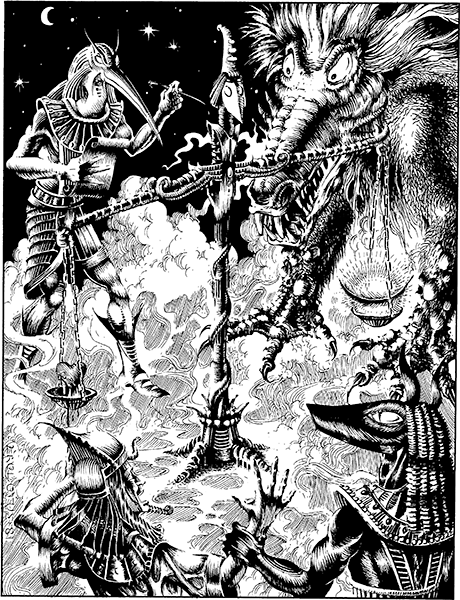
This Erol Otus drawing only appeared in Deities & Demigods starting with the third printing—apparently TSR decided that if they were going to remove the Cthulhu Mythos they ought to at least add a full-page drawing as a consolation prize.
This mythos, too, appeared in "Gods, Demi-Gods & Heroes", of course—in fact, it's the very first mythology in the book. (As I've mentioned before, the mythologies in "Gods, Demi-Gods & Heroes" aren't in alphabetical order—or any other sort of systematic order as far as I can tell.) As with the Chinese Mythos, though, I'll only comment on the entries there if there's something particularly interesting about them or significantly different from their presentation in Deities & Demigods. In fact, let's just assume that's the way things are going to go from now on unless I specify otherwise.
Here's the introduction to the Egyptian Mythology section in "Gods, Demi-Gods & Heroes":
Egyptian Mythology posted:
The ancient Egyptians had a culture lasting over 3,000 years. It is only natural that their faith would undergo a change. Their Gods aged with Ra starting as the ruler and growing senile and Osiris taking over after being killed by Set. The pantheon presented is one with Ra in prominence only because there are more Gods in this early group.
That's not only the introduction to the Egyptian Mythology section in "Gods, Demi-Gods & Heroes", as it happens; it's also very close to the first paragraph to the introduction to the Egyptian Mythos chapter in Deities & Demigods. Yes, while in the other chapters we've seen so far the introduction to the "Gods, Demi-Gods & Heroes" section has been significantly different from the introduction to the corresponding chapter in Deities & Demigods, in this case Deities & Demigods just copied the introduction from "Gods, Demi-Gods & Heroes" almost word for word:
Egyptian Mythos posted:
The ancient Egyptians developed a culture lasting over 3,000 years. It is only natural that their faith would undergo a change in that time. Their deities aged, with Ra starting as the ruler and growing senile and Osiris taking over after being killed by Set and being brought back to life. The pantheon presented is one with Ra in prominence only because there are more beings of power in this early grouping.
Now, it's true, of course, that the Egyptian mythology changed over time (like every other belief system that lasted for a significant length of time), and it's certainly fair enough to choose to present the mythology as it existed in one particular time fairly early on. I do, though, have maybe three or four eensy objections here. First of all, Osiris certainly grew in importance over time, but he never really supplanted Ra as ruler of the gods; in mainstream Egyptian mythology I think Ra was pretty much always considered the head of the pantheon, though he was sometimes conflated with other deities. (In fact, the third-edition Deities & Demigods and the listing of gods in the fifth-edition Player's Handbook both reflect this, listing as the head of the Egyptian pantheon not Ra by that name, but "Re-Horakhty", a combination of Ra and Horus.) Even if we do accept that Ra's importance faded somewhat with time, I don't think there's any mythological basis for claiming that he was growing senile; that just seems like a... really weird thing to say. (It's true that in later Egyptian myths, there was a belief that Ra aged along with the sun over the course of the day, but, you know, that meant he was old and arguably senile in the evening, but by the morning he was young again.) But whatever, sure, I guess now Ra is rooming with Odin at the Woodshead Hospital.
Second (or maybe third if you count the above as two separate issues), it also strikes me as a bit strange to say that the early myths had more gods. Surely the ancient Egyptians may have added to their myths over time, but I don't think they were known for removing gods from their pantheon. Now, granted, technically the text in Deities & Demigods (unlike the corresponding text in "Gods, Demi-Gods & Heroes") doesn't say there were more gods in early myths, only that there were more beings of power, and I guess you could make an argument that later myths put the spotlight on a smaller number of gods and left more gods on the sidelines, but even so I'm not sure that's true. I mean, obviously I'm not an expert on ancient Egyptian mythology (just like I'm not an expert on American Indian mythology, or Babylonian mythology, or Celtic mythology, or Chinese mythology, or...), and maybe there's more to this than I think, but it doesn't sound right to me.
The last objection here is maybe a bit more of a nitpick. I'd mentioned in a previous part of this review that Set wasn't originally considered evil in Egyptian mythology; he was originally a benevolent protective god, and only became villainized relatively late in the course of the civilization, more or less coinciding with Osiris's rise in popularity. So if you're going to say you're specifically drawing on the mythology from before the rise of Osiris, that means you're specifically drawing on the mythology from a time when Set was still widely honored and respected. So what's he doing as a lawful evil enemy of the rest of the pantheon? But of course, D&D writers have always loved their evil gods, so it was probably inevitable they would have made Set evil given the slightest excuse to do so.
Anyway, that's the end of the introduction to the Egyptian Mythology chapter in "Gods, Demi-Gods & Heroes", but the introduction to the Egyptian Mythos chapter in Deities & Demigods goes on for another three paragraphs. The first paragraph is about Egyptian temples.
Egyptian Mythos posted:
Temples were many in Egyptian society, but each city had only one major deity. All the other deities could be worshiped, but only in an inferior position. Temples always follow the same design and differ only in size and splendor.
The rest of the paragraph describes that design in depth. The next paragraph gives three more sentences about the temple sanctuary and really probably should have been part of the same paragraph—I guess the writers thought that paragraph would have been too long (which, okay, I guess it kind of would have been), but the paragraph break comes in a really odd and arbitrary place. Then the third paragraph discusses the duties of Egyptian clerics. Apparently the Egyptian gods are sexist:
Egyptian Mythos posted:
Female clerics can rise no higher than the 9th level in ability, but it is necessary for all 11th level males or higher to take on a female cleric as a consort and advisor, and these women often rule in the stead of their male counterparts when the males have to be away from the temple. The female clerics keep all official temple records.
This can't, incidentally, be attributed to historical authenticity, since historically in the ancient Egyptian priesthood men and women were actually of surprisingly equal status, and during the New Kingdom era the priestess holding the position of God's Wife of Amun was the most powerful priest in Egypt.
Also, besides being sexist, the Egyptian gods in Deities & Demigods are really mercenary:
Egyptian Mythos posted:
Egyptian clerics can only rise in levels by donating large sums to the sect for its use (in AD&D terms it is necessary to donate the equivalent of the needed experience points in gold in order to rise in levels).
Again, I'm... pretty sure this doesn't have any historical basis.
So, on to the gods. Starting, of course, with:
RA (sun god) "Pharaoh to the Gods"
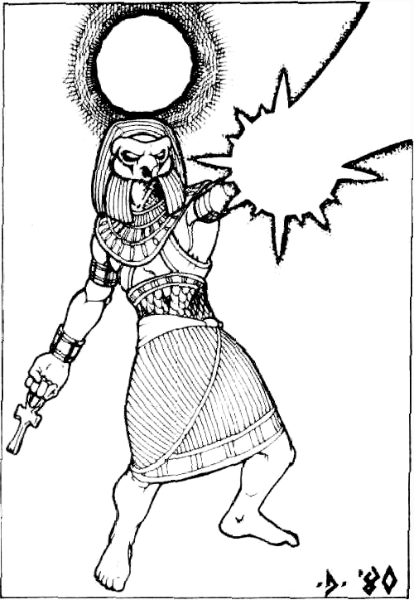
"Take that, illustration border!"
As the introduction says, the leader of the mythos is Ra, who is neutral good and for some reason lives on the Prime Material Plane.
Ra posted:
He rides through the air in a huge war galley made of part of the sun and called the Matet (this galley changes into a simple barge at night called the Semktet). It travels at a rate of 24", is surrounded by flames (which inflict 40 points of searing damage on contact), and is never affected by magic.
Yes, that's right. Not only do we, as usual, get lots of useless information on Ra's combat abilities, we get statistics for the combat abilities of his boat, too.

Also an illustration. Wait... who's steering the ship?
Ra posted:
This god prevents fighting among the other beings of the pantheon and is able to reduce all conflict to a state where only the clerics of each sect are able to do battle, with their respective gods never taking a hand, unless Ra himself is out of commission.
Uh, wait, so was Ra out of commission when Set personally murdered Osiris? Except from the introduction I guess we're basing this on an early version of Egyptian mythology and that hasn't happened yet. So... will Ra be out of commission when Set personally murders Osiris? Eh... whatever.
The only difference worth noting in Ra's entry in "Gods, Demi-Gods & Heroes" is that instead of saying it inflicts damage it says it "is immolated for 40 points", which makes it sound like the barge is burning up.
ANHUR (god of war)
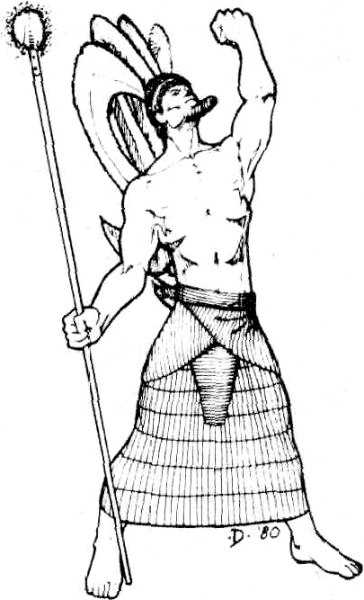
Anhur, doing a classic cartoon villain "Curses!" pose.
Anhur "always appears as a human", except that we're told in the next sentence that he "shape changes", which seems to imply that he does not always appear as a human, unless he only shapechanges to the form of another human. However, he only shapechanges "when attacked by more than one being", except then we're also told that he "commonly fights in +4 scale mail", so does his armor shapechange with him, or...
Anhur posted:
A worshiper of Anhur offers sacrifices to him in battle, in the form of powerful enemies. If a follower of Anhur promises the god a foe's life as a sacrifice, and the foe is at least twice as powerful as the worshiper (considering levels, hit points, special abilities, etc.), then if the worshiper is successful, there is a 1% chance that Anhur will immediately grant him or her sufficient experience to raise one level of experience.
On the one hand, there would seem to be no incentive not to just offer the life of every powerful foe as a sacrifice, just in case that 1% chance happens. On the other hand, how often in any edition does a D&D character fight and win against a foe twice as powerful?
Like Ra, Anhur lives on the Prime Material Plane for some reason.
Oh... he's also "unusually tall". That's... important, I guess.
ANUBIS (guardian of the dead)
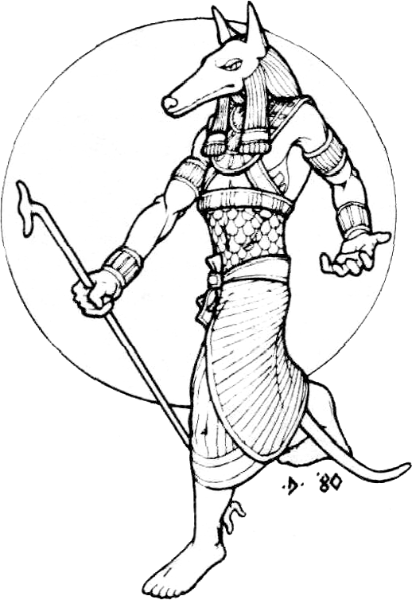
I'm not sure what the top of that staff is supposed to be shaped like.
Anubis doesn't live on the Prime Material Plane. He lives on the Astral Plane. So... okay. The Egyptian gods just want to be different; they don't want to hang out on the Outer Planes like those plebeian gods. Well, all right, most of the remaining Egyptian gods do live on the Outer Planes. Most, but not all; we'll still get a couple more gods living on the Prime Material Plane, three on the Elemental Planes, and one on the Ethereal Plane... but I'm not sure why so many of them are on the Prime Material Plane. Huh.
Anubis posted:
Anubis appears as a man with the head af a jackal.
Anubis has what I think is the most circumstantial combat ability so far: he can animate any statue of himself, which I guess can be handy if he ever... gets in a fight near a statue of himself. Which I guess he sometimes does, because there's a 5% chance that he will come and kill anyone who robs a tomb with an image of himself, because the writers of Deities & Demigods really loved having small random chances of the gods doing things, which seems pointless because that means those chances almost never matter, but the DM still (theoretically) has to roll just in case this time they do. Anyway, if the "tomb has been consecrated especially to Anubis", the chances of his appearing go up to 10%, but that "involves the intercession of a 10th level priest and the sacrifice to Anubis of 50,000 gp worth of precious gems."
By the way, in "Gods, Demi-Gods & Heroes", the chances of Anubis's showing up are larger—he has a 5% chance of coming to kill the robber of any tomb, and it rises to 25% if the tomb has an image of him in it. Also, he has the head of a dog instead of a jackal. He still animates statues of himself, though.
But, getting back to Deities & Demigods, the writers aren't done throwing random percentage chances into Anubis's entry. We're then told that since Anubis is the "collector of souls for transportation to the house of the dead"... um, actually, this part is sufficiently longwinded and awkwardly worded that I'm just going to quite it rather than try to summarize it.
Anubis posted:
In his role as the collector of souls for transportation to the house of the dead, there is a 20% chance that a dead being (worshiping any Egyptian deity) will, while in the process of being raised from the dead by a cleric, attract the anger of the god, and as a result that cleric will be forced to go on a quest for the purpose of increasing the power of the cult of Anubis (no saving throw; judge's option as to the quest).
Yeah, okay.
Finally we're told that while Anubis can use magical powers in combat, he's especially fond of just biting enemies to death. Oh, Anubis. Have some dignity.
APEP (king of serpents)
Apep is presented as a unique monster rather than a god, which, really, is fair enough; I don't think anyone in ancient Egypt ever worshipped Apep. Which, of course, didn't stop Wizards of the Coast from making Apep into a full-fledged god (or at least demigod) in third edition.
Apep posted:
This creature of the Abyss is the deadly enemy of the gods, particularly Osiris. Apep is the physical embodiment of chaotic evil in the Egyptian mythos. He is usually attended by 5-50 flame snakes (q.v.), who act at his will.
Apep doesn't appear in "Gods, Demi-Gods & Heroes", but it has a different evil reptilian being in his place:
APESH GOD OF GREED AND EVIL
Apesh posted:
Apesh looks like a dragon turtle straight out of D&D. Its main attribute is the power to summon 1-4 of any evil creature per day to fight for it. In battle it relies on its shapechanging power to kill its enemies. It is very fond of allowing maps to its many treasures to be found by lawful beings and then taking a personal hand in killing them when they try to take the gold.
And no, this isn't just a typo or another name for Apep; Apesh and Apep were distinct beings in Egyptian mythology, though Apesh was rather more obscure. I'm not sure the writers of Deities & Demigods knew they were distinct beings, though, since they never appeared in the same D&D book.
Also, it probably goes without saying that in Egyptian mythology Apesh did not look like a dragon turtle, which... wasn't a thing. He did look like a turtle, though, so, uh, close enough?
APSHAI (god of insects)
quote:
Apshai is a great praying mantis, able to shape change at will and call an insect plague on a person, town, or country. He can control any type of insect (of a non-divine nature).
Yeah, that's all we get about Apshai except for a sentence about his, ugh, combat abilities.
This god is kind of a weird one. Yes, Apshai really does come from Egyptian mythology, but he was definitely not a major god. He wasn't really a god at all. He was just kind of a... well, an insect that the dead had to confront on their way to the afterlife, mentioned briefly in the Egyptian Book of the Dead. He doesn't seem to have really been a praying mantis, either. More likely a flesh-eating beetle.
So why was such an obscure entity included as a god in Deities & Demigods? Well, I had a theory as to why:
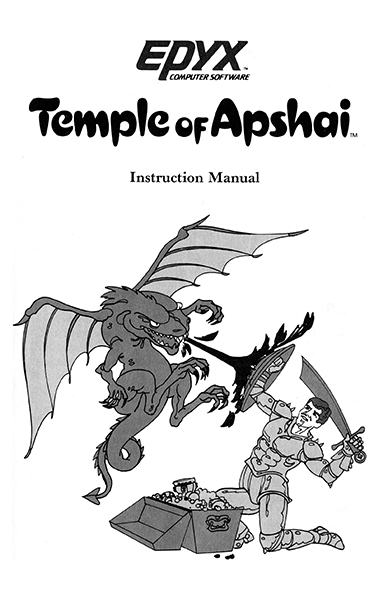
Please note that there are no dragons in this game.
That's the cover to the instruction manual of Temple of Apshai, one of the earliest computer role-playing games. This game took place in a temple of "Apshai, the insect god", now a buried ruin inhabited by monsters including six-foot antmen that smelled like vanilla. The game was released in 1979... the year before Deities & Demigods was published.
So that seems like a likely inspiration, doesn't it? Well, that's what I thought at first, until I realized something that completely falsified this theory.
Sure, Deities & Demigods was published in 1980... but "Gods, Demi-Gods & Heroes" was released in 1976, before Temple of Apshai, and Apshai was in that book too (and, as in Deities & Demigods, was an insect god in the form of a praying mantis). So no, I guess Apshai wasn't in Deities & Demigods because of Temple of Apshai. Rather, Apshai was in Temple of Apshai because of "Gods, Demi-Gods & Heroes". As with Tower of Druaga, the D&D entry came first.
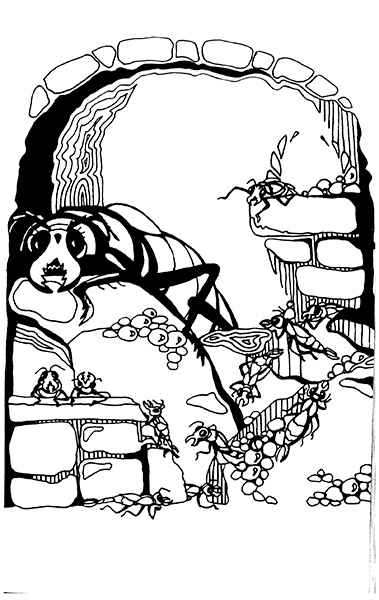
No dragons, but there are plenty of ants.
So that brings us back to the question, then, why was this obscure entity in "Gods, Demi-Gods, & Heroes"? I don't know. Maybe because Kuntz and Ward were thumbing through the Book of the Dead at random, ran across the mention of Apshai, and decided to throw it in. Why not.
BAST (cat goddess)
 Link to NSFW image on external site
Link to NSFW image on external site
Bast posted:
Bast's bitter enemies are Set and his minions. When fighting evil with her claws, she often teleports about and shape changes so that she can use more claws in battle.
Uh... so what does she shape change into? Like, just a giant ball of claws, or...?
Not that it matters, because again, we're talking about a god's combat abilities, and who cares.
Anyway, returning to the persistent theme in this book of gods having pointlessly tiny chances of reacting to things, there's a 2% chance of Bast noticing when someone kills "one of the cat race", and if she does there's a 5% chance that she'll react to it, either by killing the slayer or by demanding "that he or she devote one-half of the rest of his or her life to Bast." So, you know... I guess by these rules every time the PCs slay a giant lynx or a kamadan or a luck eater or a nonafel or one of the dozen other cat monsters that exist in first-edition D&D, the DM is supposed to roll to check for the one in a thousand chance that Bast will show up and kill them. Or force them to serve her.
("Gods, Demi-Gods & Heroes" has Bast significantly more reactive: there's a 40% chance that she's see a being killing "one of the cat race", and if she does she'll come and kill them, period, unless they're "very powerful", and then she'll demand "that he or she raise the cat to life and devote one half the rest of their life to Bast." So... yeah, don't kill a cat in OD&D. Though OD&D didn't really have any cat monsters anyway except for the displacer beast, which was introduced in the first supplement, "Greyhawk". So, yeah, I guess in OD&D RAW if you kill a displacer beast there's a better than one in three chance that a literal goddess shows up to avenge its death.)
Also, all of Bast's priests have special powers against snakes. Because clearly that's a cat thing. No, really, I think it's because Bast is an enemy of Set (in Deities & Demigods, that is, not in actual Egyptian mythology), and Set... is connected with snakes, I guess? I mean, he didn't really have any connection to snakes in Egyptian mythology (if anything, his opposition to Apep made him an enemy of snakes—or at least of one snake), but in Deities & Demigods he... doesn't really have much connection to snakes either, actually. Though his symbol is a coiled cobra for some reason, so I guess that's enough.
BES (god of luck)
Bes posted:
Bes appears as a mountain dwarf as described in the MONSTER MANUAL.
Also not a thing in Egyptian mythology: dwarves. Though yeah, in a lot of his ancient Egyptian depictions, Bes did kind of look like a dwarf, so, okay, fair enough I guess.
Anyway, Bes likes people who take gambles, and if he's "really pleased (judge's option)" by seeing someone take a big risk, there's a
 5% chance that he'll "give the being a luck stone, no strings attached. (DMs must exercise discretion in this.)" Yeah, because the luck stone (or, as it's actually called in the DMG, the "Stone of Good Luck (Luckstone)") is one of the most potentially powerful items in first-edition D&D, not least because it affects even rolls to randomly determine treasure. Are you hoping to find a specific extremely rare magic item? Well, the luckstone can multiply your chances by a factor of well over a hundred.
5% chance that he'll "give the being a luck stone, no strings attached. (DMs must exercise discretion in this.)" Yeah, because the luck stone (or, as it's actually called in the DMG, the "Stone of Good Luck (Luckstone)") is one of the most potentially powerful items in first-edition D&D, not least because it affects even rolls to randomly determine treasure. Are you hoping to find a specific extremely rare magic item? Well, the luckstone can multiply your chances by a factor of well over a hundred.FLAME SNAKE
Flame Snake posted:
This creature is an enemy of the gods, and is related to the great serpent Apep. It appears as a small harmless grass snake and is most often found sitting coiled on the highest pile of treasure in a tomb... The Egyptian hells swarm with flame snakes.
We saw these mentioned in Apep's description; now we get stats for them. They're chaotic evil monsters that are... kind of pathetic, actually; they only have one hit die, and their bite does a maximum of two hit points of damage. The best thing they have going for them is a breath weapon that does fifteen hit points of damage. Also, they have magic resistance and a decent armor class. Still, these things are enemies of the gods? Somehow I don't think the gods are going to be too scared.
By the way, flame snakes did appear in "Gods, Demi-Gods & Heroes", even though Apep didn't. Except they were called fire snakes. And they were actually a lot tougher; they had 20 hit points and their breath weapon did 35 hit points of damage. They still looked like grass snakes and sat on piles of treasure, though.
GEB (god of the earth) also known as Seb or Qeb
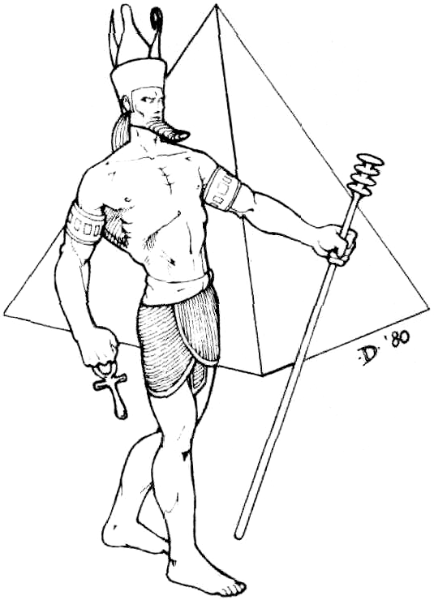
Okay, so Anubis isn't the only Egyptian god to have a staff with a tip shaped like nothing in particular.
Obviously the names of most if not all ancient Egyptian gods have multiple different English transliterations, so I'm not sure why only Geb gets alternate versions listed of his name. Anyway, Geb's description is almost entirely about his combat abilities. In fact, the only part that's not about his combat abilities is the first sentence, "Geb appears as a heavily muscled man." So moving on...
HORUS (son of Osiris) "The Avenger"
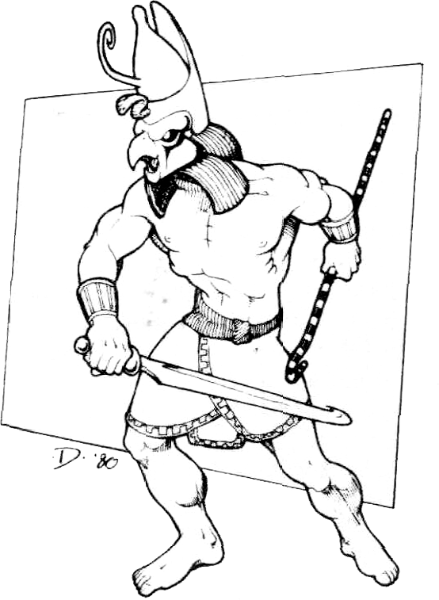
Insert topical Avengers joke here. I don't know. I haven't seen the movies, but I'm sure there's some reference that can be made. Maybe something about Hawkeye?
According to some sources, there were actually at least two different Horuses in ancient Egyptian mythology, sometimes called Horus the Elder and Horus the Younger. It's Horus the Younger that was the son of Osiris, while Horus the Elder was one of the oldest gods, so I'd say the version in Deities & Demigods represents Horus the Younger, except that I'm not sure Kuntz and Ward were even aware of the difference. Then again, I'm not sure how much the difference was important to ancient Egyptians, who may very well have just seen the two as aspects of the same god and not worried about the contradictions in their origin stories, so, eh, I guess I'd give them a pass on that.
What I won't give them a pass on is the fact that once again the vast majority of his description is about his combat abilities. We get half a sentence of description, "Horus appears on the earth as a muscular man with a hawk's head," and then we launch into a lengthy paragraph of what he does in combat. (I say "half a sentence" because while the quoted clause could stand on its own as a sentence, it doesn't—it's the first half of a compound sentence the second half of which is about how his "main attribute is the ability to triple the power of any weapon or magic item he uses.")
We do get a second, much shorter paragraph that isn't about his combat abilities, but which is about Deities & Demigods' other pointless obsession, that being a god having a tiny random chance of reacting to some event. In this case, we're told that "When a 'good' person seeks righteous revenge, there is a 5% chance that the god will aid by increasing all of the being's ability scores to 19 until the deed is done." And yes, "good" is in quotation marks. I'm... I'm not even going to bother speculating as to why.
ISIS (goddess of magic and fertility)
 Link to NSFW image on external site
Link to NSFW image on external site
Okay, yeesh. There are four goddesses in this pantheon, but only two of them have illustrations, and both of those are drawn in costumes that leave their perky breasts fully exposed. I guess it's possible that the artist for this chapter (Jeff Dee) thought the ancient Egyptians really dressed that way, but I think it's much more likely he just wanted to draw boobs.
"Isis usually appears as a beautiful well-proportioned female," because of course she does. She likes creating "magical charms" that each resist the effect of a single spell, and she has a 5% chance
 of giving them to anyone who creates a new spell or magic item. Did any DM ever consistently roll for all the tiny chances for all the gods' reacting to various events?
of giving them to anyone who creates a new spell or magic item. Did any DM ever consistently roll for all the tiny chances for all the gods' reacting to various events?NEPHTHYS (goddess of wealth and protector of the dead)
Nephthys is the twin sister of Isis, and of course she also appears as a beautiful woman, and she almost certainly would have walked around with her breasts hanging out if Jeff Dee had bothered to draw her.
Nephthys posted:
Nephthys was once married to Set, but she left him when that god turned to evil.
In Egyptian mythology, Nephthys was indeed married to Set, but I'm unaware of any myths in which she left him. I guess Kuntz and Ward just didn't think a chaotic good and lawful evil god could be married. Even though the chaotic good Chalchiuhtlicue was said to be married to the lawful evil Tlaloc in the Central American Mythos. Hm.
OSIRIS (god of nature and the dead)
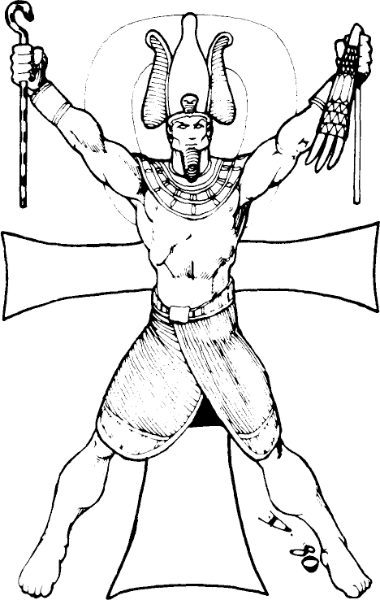
Osiris, seen here doing jumping jacks as part of his morning exercise routine.
quote:
Osiris usually appears as a muscular green man. He is the lord and protector of the dead. Vegetation or anything made out of vegetation has no effect on the god. His also is the power to raise the dead, no matter how long in that condition.
Then we get the requisite long paragraph about his combat abilities, and the almost as requisite shorter paragraph about his having a 5% chance of doing something. In this case, "if one [of his clerics] does a great deed for the religion (judge's option). that cleric may (5%) be given a wish." ("Gods, Demi-Gods and Heroes" doesn't have the 5% chance; it just says straight out that "if one [of his clerics] does a great deed for the religion (judge's option) the priest is given a wish." Still includes that wishy-washy "judge's option", though.)
quote:
Osiris is second only to Ra in power and rules in Ra's absence.
He's actually given a full 400 hit points like the leader of a pantheon, though as mentioned above I don't think he was ever really the head of the gods in actual ancient Egyptian mythology. Osiris was considered the king of the dead, and sometimes also the "king of the living", but he was never the king of the gods.
PHOENIX
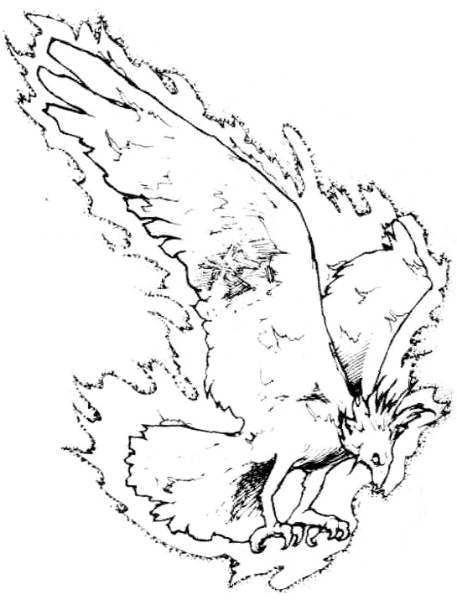
Is it just me, or does it kind of look like it has a windmill tattooed on its wing?
Phoenix posted:
The phoenix was said to exist and be watching at the time of the creation of the universe, and it stands for everlasting life beyond even the power of gods to attain.
The phoenix wasn't Egyptian, so I'm not sure what it's doing in this chapter. Well... the Greek historian Herodotus did repeat accounts of the phoenix being found in Egypt, but then Herodotus also wrote about griffins in northern Europe and "headless men with eyes in their breasts" living in Libya. To Herodotus's credit, he didn't relate these accounts uncritically as unquestioned truth; he generally explicitly said they were things he had heard of but could not personally vouch for—and that goes for his account of the phoenix as well, which he admitted he had never seen and that he didn't believe all the stories about. So anyway, the only connection the phoenix had with Egypt is that a Greek guy said they were found there. Certainly there are no mentions of the phoenix in any ancient Egyptian sources—there was a magical bird called the Bennu that some scholars have suggested may have inspired the Greek phoenix, but even that is dubious at best. So, yeah, if Kuntz and Ward wanted to include the phoenix in Deities & Demigods, it really belonged in the chapter on Greek Mythology, not Egyptian.
Anyway, the phoenix is of course presented as a monster, not a god, and it's pretty much what you probably think: it's on fire, it attacks with its wings and beak, if killed it explodes and is reborn 3-18 rounds later.
Phoenix posted:
There is no way by which the phoenix can be killed permanently. Even if its ashes are destroyed, it will rise again, seemingly out of nothingness.
Being that it's just a giant bird that doesn't seem to be hurting anything, I'm not sure why anyone would be interested in killing it permanently anyway.
In "Gods, Demi-Gods & Heroes", the header for the phoenix reads "PHONEX (Phoenix)". I don't know why. Did anyone ever spell it that way?
PTAH (creator of the universe) "Opener of the Ways"
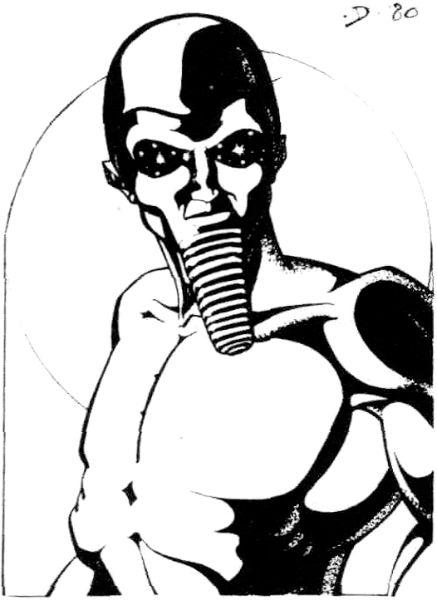
Is he wearing a bald cap?
Ptah posted:
Ptah appears as a dwarf with eyes that reflect the universe. He exudes a feeling of great power. According to legend, Ptah formed the Prime Material Plane out of the Ethereal, and created the Egyptian pantheon of gods. However, he is not really a member of their group, and generally makes his own way.
We also get information about how Ptah is a "master of planar travel" and can force people to other planes or "teleport anywhere in the multiverse with accuracy", and then we get information about
 his combat abilities and
his combat abilities and  how he has a 5% chance of rewarding people who come up with "highly useful" inventions. (15% if they're worshippers of Ptah, and 20% if they're clerics.) He rewards them with a special magic item called a Thet which is only mentioned here inside Ptah's description instead of having its own entry. Anyway, it's a charged item that lets wielders become ethereal or create an anti-magic shell that doesn't affect their own spellcasting. There is absolutely no information on what a Thet looks like, so you can use your imagination. A jellybean? A spork? It's up to you!
how he has a 5% chance of rewarding people who come up with "highly useful" inventions. (15% if they're worshippers of Ptah, and 20% if they're clerics.) He rewards them with a special magic item called a Thet which is only mentioned here inside Ptah's description instead of having its own entry. Anyway, it's a charged item that lets wielders become ethereal or create an anti-magic shell that doesn't affect their own spellcasting. There is absolutely no information on what a Thet looks like, so you can use your imagination. A jellybean? A spork? It's up to you!Okay, I looked it up online, and a thet looks like this:
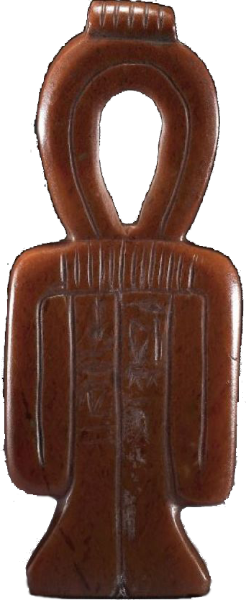
So kind of like a stick figure guy with his arms at his sides, though that's probably not what the ancient Egyptians were going for.
Also, it was strongly associated with the goddess Isis, so why Ptah is handing these things out is anybody's guess.
SEKER (god of light)
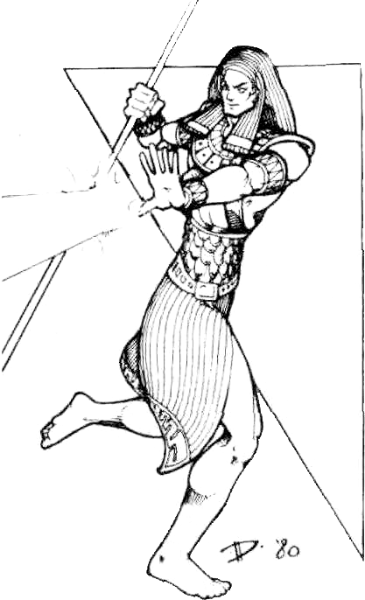
This time the artist just completely gave up on deciding what the tip of his staff looked like.
Seker posted:
Cousin to Shu, Seker appears as a rather ordinary man.
What a vivid description. He's not just ordinary, he's rather ordinary.
Seker posted:
Seker is one of the gods of the afterworld, and protects neutral good souls (of the Egyptian cults) after death.
And that's all the information we get about him besides his combat abilities. One of which is that he "casts shafts of light from his hands that kill any undead they touch (range 500 yards)". Which I mention only because we get a bonus drawing of his doing just that:

At least, I assume that's what's supposed to be happening here, although the middle figure looks less undead and more blob of Play-Doh. Also, I like the way the mummy looks like it's trying to hold the bandages in place over its forehead.
In Egyptian iconography, incidentally, Seker was often shown with the head of a falcon. I only bring this up because it seems a bit odd that he's not given the head of a falcon in Deities & Demigods, despite many of the other Egyptian gods being described with animal heads. I mean... you could make a case for the Egyptian gods having animal heads (because that's the way the ancient Egyptians depicted them), or you could make a case for them having regular human heads (on the grounds that the animal heads in their depictions were meant as symbolic), but let's be consistent.
The description of Seker in "Gods, Demi-Gods & Heroes" is basically similar, though shorter, but it does have one interesting bit:
Seker posted:
[Seker] can use all of his powers shapechanged as opposed to all the other Gods who cannot.
Wait... so usually gods who can change their shape lose their powers when they're not in their normal form? And this is something you didn't think was important enough to mention anywhere outside of the entry of the one god who's apparently an exception to the rule?
SET (god of evil and the night)
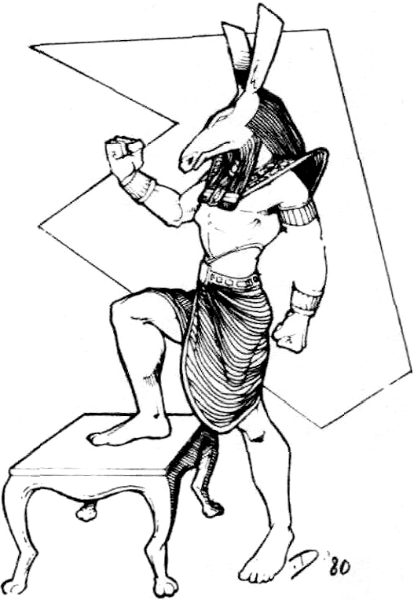
Set, seen here making use of his specially designed posing stool.
Set posted:
Set is a scaled humanoid with the head of a fierce jackal. He is totally dedicated to the spreading of evil and has attributes to match.
Okay, we've already covered how Set wasn't originally evil, and we've touched on his implied but not explicit association with snakes; now let's talk about that "head of a fierce jackal" thing. (Though this was already touched on in KingKalamari's review of Wilderlands of High Fantasy, since Wilderlands apparently heavily drew from 1E Deities & Demigods.) I don't think any jackals have ever had heads remotely like Set's head in the illustration. Still, saying that Set has the head of a jackal isn't actually completely unfounded. Some Egyptologists have indeed proposed that the animal whose head Set has—and the full body of which is often shown in other depictions of Set, or in hieroglyphics representing him—was meant to be a jackal (and that the differences in the depiction of Set's head with Anubis's are intentional for the purpose of distinguishing the two gods). Others have identified it with different animals, including the donkey, the okapi, or the aardvark. All of these, however, are minority views; the mainstream modern consensus is that this animal, called the Set animal or the sha, is an entirely fanciful beast that was never meant to correspond to any real-world animal. As amusing as it might be to have a god with the head of an aardvark.
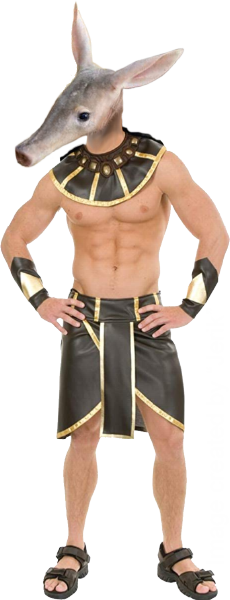
Fear Set, bane of ants and termites everywhere!
He can turn people into evil Minions of Set with a touch, regardless of their original alignments, and there's (ugh) "a 5% chance that Set may be watching when one of his worshipers does a highly evil act, and if so, Set will lend that being 2-20 Minions of Set for 12 weeks."
Hey, remember this part from the book's introduction?:
Dungeon Mastering Divine Beings posted:
If an entreaty for aid were heard one time in 100, surely each and every deity would be as busy as a switchboard operator during some sort of natural disaster.
Because given all these gods' having 5% chances or whatever to respond to various events, I'm not sure the writers remembered it. Apparently the gods are far too busy to actually respond to prayers, but they have plenty of time to personally kill tombrobbers and avenge cats and reward inventors and whatnot. They have their priorities.
Anyway, we've had a few mentions of a "Minion of Set". What's a Minion of Set? Well, it's the next entry in the book, that's what.
But I think I'll stop here for now and save them for the next post.
Next time: Curse Be On You Forever
Curse Be On You Forever
Original SA post Deities & Demigods 1EPart 14: Curse Be On You Forever
Okay, let's finish up the Egyptian Mythos. When we left off, we were just about to get to the...
Minions of Set
So, minions of Set are lawful evil "go-betweens for Set and mankind" who can turn into giant snakes, and some of them can also turn into "cave bears, giant crocodiles, or giant scorpions". And that's about it. Here, have a picture.
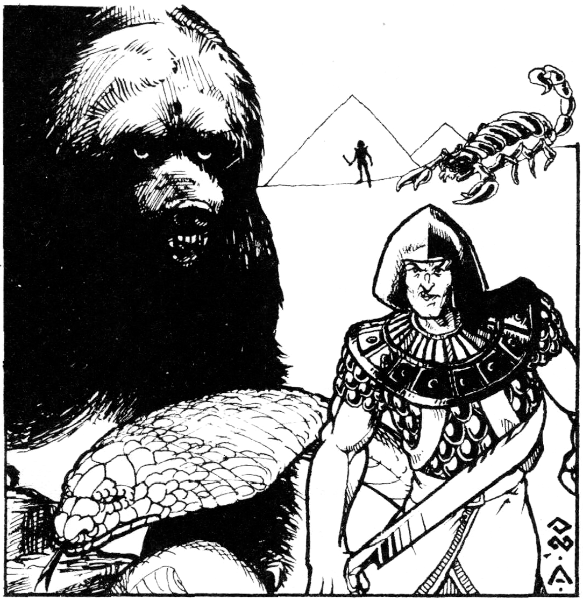
It's Bruce Campbell's evil twin.
SHU (god of the sky)
Shu posted:
Twin brother to Tefnut, this god appears as a normal man.
Not a rather ordinary man, mind you. Just a normal man. These distinctions are important.
And all the rest of his description is about his combat abilities. What do his worshippers do? Does he have any special ceremonies? Who knows? Let's move on.
TEFNUT (goddess of storms and flowing water)
Tefnut posted:
Shu is Tefnut's brother, and he is very protective of his sister. Anything that dares to harm her will suffer his immediate vengeance, and there is a 75% chance that Horus will also help.
Deities & Demigods was secretly a plot to sell percentile dice.
Anyway, that's all we get about Tefnut besides her combat abilities, the only one of which worth noting is that she has the ability to summon water monsters. Which is italicized as if it were a spell, but... isn't a spell.
THOTH (god of knowledge)
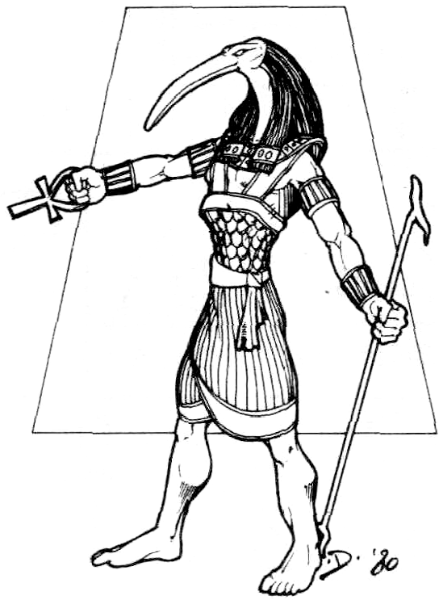
"Wait... am I pointing this thing the right way? I can never remember."
Thoth posted:
Thoth was the teacher of the gods, and this role allows him full knowledge of everything and anything, particularly magic. His spells always inflict maximum possible damage (saving throws are still applicable).
Yup. We get one sentence of potentially useful (if vague) description, before we dive right in to combat abilities.
Well, we do get a little more in the next few paragraphs: he's instantly aware of any new knowledge discovered on the Prime Material Plane, and his worshipers are primarily interested in the acquisition and spread of knowledge. Also, he has "a set of 3 books that detail all clerical knowledge, all magical knowledge, and all divine knowledge. They have been stolen several times during his existence, much to the regret of the thieves when Thoth caught up to them."
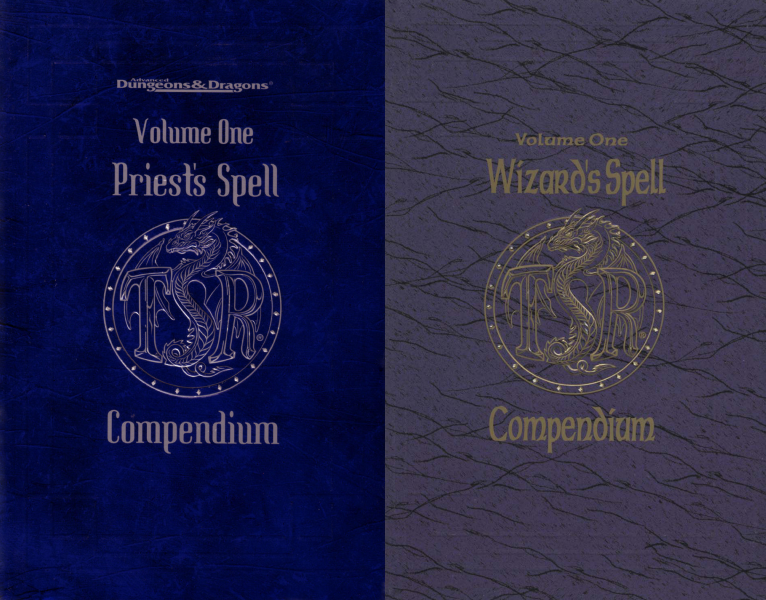
The third book is Deities & Demigods.
Then we get to this chapter's one magic item:
TRUE ANKH
True Ankh posted:
This magical device, carried by all of the gods of the Nile at one time or another, enables them to raise any dead creature fully (as the spell) as long as all of the body pieces are present at the time of the raising. The device will kill by fire any non-divine being that touches it. It is about one foot long, with a cross shope, having a loop on the top. It is usually bright blue in color. There are only 7 of these in any given plane at any one time.
It's bright blue? What the heck is it made of? And saying there 7 "in any given plane" implies there could be more on other planes. So what happens if you try to bring one from another plane to a plane where there are already seven? Does it just... not work? Or is that there can have more than seven True Ankhs on a given plane but just currently aren't?
There's actually still a page and a half left in this chapter, but before I get to that, let's go over the gods, monsters, and items that are in the Egyptian Mythology section of "Gods, Demi-Gods & Heroes" but not in Deities & Demigods. We've already seen one, Apesh, but he's not alone. Here are the rest, in the seemingly random order in which they appear in "Gods, Demi-Gods & Heroes":
RENENET GODDESS OF GOOD FORTUNE
quote:
Renenet looks like an ordinary woman
Oh, good, this again. Kuntz and Ward's raw descriptive power never ceases to amaze.
quote:
and when looking upon another being gives them the Luck of the Gods. The being will make their saving throw every time, will always hit their enemies, and will never be struck by their foes.

I... wow. What? How long does this last? Is it permanent? She can just look at someone and make them... basically invulnerable forever? Well, technically I guess people with the Luck of the Gods would still take damage from area spells that do half damage on a save, but still... dang.
(Bast, incidentally, has no area of effect abilities, so I guess if you get Renenet to look at you, you can slaughter displacer beasts with impunity.)
Okay, maybe I can see why she was left out of Deities & Demigods. I mean, sure, the writers could have just changed her powers, but that would have been too much work.
AMSET GOD OF THE SOUTH
HAPI GOD OF THE NORTH
TUAMAUTEF GOD OF THE EAST
QEBHSENNUF GOD OF THE WEST
Yeah, these are four separate beings, each with their own stat block, but they're listed right next to each other and are obviously related. They all have the same stats, and the same powers, and differ only in their appearance: Amset "looks like an extremely short man", Hapi "like an extremely short dwarf right out of D&D", Tuamautef like "a man with a crocodile head", and Qebhsennuf like a random sequence of Scrabble tiles. I mean, "like a man with a hippo's head".
SPHINX
Sphinx posted:
A sphinx is one of the most powerful of all Egyptian magical beasts. It has the body of a lion and the head of a woman, sometimes having wings, but not always.
Well, uh, that describes the Greek sphinx, but not the Egyptian. Oh well.
Sphinx posted:
While it is very short tempered and likes the taste of human blood, it is also curious and will spare a person with a good story (judges option). ... Its saving throw against everything is 02 and it loves riddles.
Riddles? Oh, goddammit, this is just the Greek sphinx. You're not even trying.
WINGED SERPENT
Winged Serpent posted:
These snakes are about 1 foot long with 2 foot long wings. It flies about its treasure and has only one power; it can spit a contact poison that will seep through even armor at a distance of 30 yards. This snake will try not to close with an attacker, spitting every melee round.
What do these have to do with Egyptian mythology? Search me.
LIFE SCEPTER
Life Scepter posted:
A magical weapon found only in the hands of Gods.
Oh, great, another of those.
Life Scepter posted:
Its main power is the ability to make the being holding it unkillable.
Uh... I think gods are pretty close to unkillable already. (Unless you're Waldorf.) So what does the life scepter do for them?
Life Scepter posted:
It acts like the magic jar spell but it holds the hits points [sic] of the being. The holder can be hacked at forever with no harm because whenever he wishes he can return his hit points to his body.
That... kind of makes it sound like hit points are tangible objects that fly out of the gods when you hack them like candy out of piñatas, but okay.
Life Scepter posted:
It is made out of a woody material and is easily affected by anything that affects wood and destroying it destroys the user.
Wait, hold on. That's not making the gods unkillable. That's doing the opposite of making the gods unkillable. It's a lot easier to kill a god if all you have to do is destroy some dumb wooden stick they're holding.
But this point does not go entirely unaddressed:
Life Scepter posted:
It is not used often by the Gods except Thoth because he is able to negate all the forms of damage inflicting wood.
He... he is? I don't recall that being mentioned among his powers. I guess aside from its making him the only god for whom the Life Scepter is remotely useful, it must not come up very often.
Anyway, that's it for the Egyptian Mythology section of "Gods, Demi-Gods & Heroes", so let's get back to that last page and a half of the Egyptian Mythos chapter of Deities & Demigods. These last pages deal with a single topic:
HIEROGLYPHS
We get a few paragraphs of description, which I'm just going to go ahead and quote in full because I'm getting tired of trying to summarize things.
Hieroglyphs posted:
Egyptian written language did not use an alphabet as we know it; rather, ideas were conveyed by means of hieroglyphs, or word-pictures. Each hieroglyph could mean one simple word, or it could stand for a whole phrase or concept.
Well, no, I don't think it was normal for hieroglyphs (if you're using "hieroglyph" to mean a single symbol) to stand for entire phrases. They didn't even all stand for entire words. Many hieroglyphs had phonetic values, and could be used to represent particular sounds within a word or name. But let's continue.
Hieroglyphs posted:
A hieroglyph could be altered slightly with the effect of negating, emphasizing, or otherwise modifying the meaning of the base hieroglyph; however, this practice tended to confuse meanings when artists couldn't agree on their depictions. Later, archaeologists would face these same difficulties in trying to uncover the meanings of the hieroglyphs they found.
DMs using the Egyptian pantheon may wish to use hieroglyphs on maps, scrolls, temple writings, and anywhere else runes might be found (warning of danger ahead, etc.). These hieroglyphs con be combined to make phrases and sentences; for more information consult The Book of the Dead, a translation of ancient hieroglyphs found in Egyptian tombs.
The bibliography (which we'll get to in the appendices) does indeed include The Egyptian Book of the Dead, specifically the translation by E. A. Wallis Budge. Now, this does not strike me as necessarily the most logical source to look to for more information on hieroglyphics. Yes, it does include translations of passages of Egyptian hieroglyphics, with the English translations presented below the hieroglyphics they're translating, and yes, I guess by looking through it you could make some guesses about what hieroglyphs corresponded to what English words. But it doesn't really include a summary of how hieroglyphics worked, and it certainly doesn't include any ordered lexicon or dictionary that would allow you to look up specific words. Unlike Budge's two-volume An Egyptian Hieroglyphic Dictionary, which, well, includes exactly that. So why did Kuntz and Ward suggest The Book of the Dead as a source for information on hieroglyphs, and not the much more apt An Egyptian Hieroglyphic Dictionary by the same author? I don't know, but I'm guessing maybe only the former was available in their local library.
To be fair, of course, old books like that weren't as easily accessible when Deities & Demigods was written as they are today. I happen to have physical copies of both Budge's translation of The Book of the Dead and his An Egyptian Hieroglyphic Dictionary—I've had them long enough I don't actually remember where I got them—but even if I didn't, both books are old enough now they're in the public domain, and easy to find online. But obviously that wouldn't have been the case back in 1980, and Kuntz and Ward's access to these books would have been more limited. Of course, there's also the fact that since those books are so old, they're kind of outdated; anthropologists have learned more about ancient Egyptian hieroglyphics since then, and revised some of Budge's translations, but for the purposes of the following discussion I'll go ahead and use Budge's Hieroglyphic Dictionary anyway.
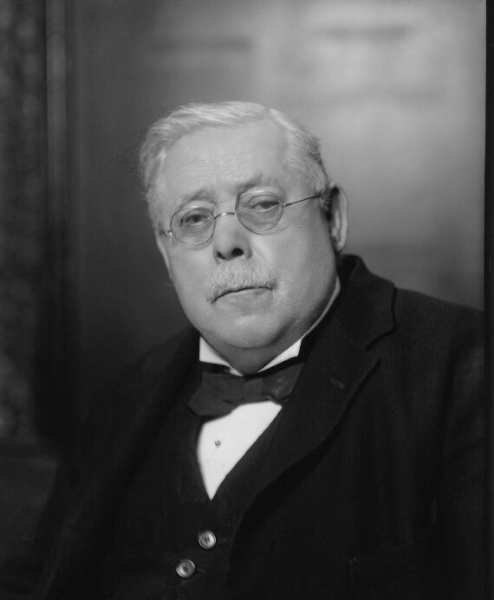
Here's what E. A. Wallis Budge looked like, in case you were wondering. You probably weren't wondering.
Anyway, the rest of this section is taken up by a big chart, filling the rest of this page and all of the next, giving the hieroglyphs (supposedly) corresponding to various English words. I'm not going to reproduce the whole chart here, but I'll show the first bit of it to give you the idea:
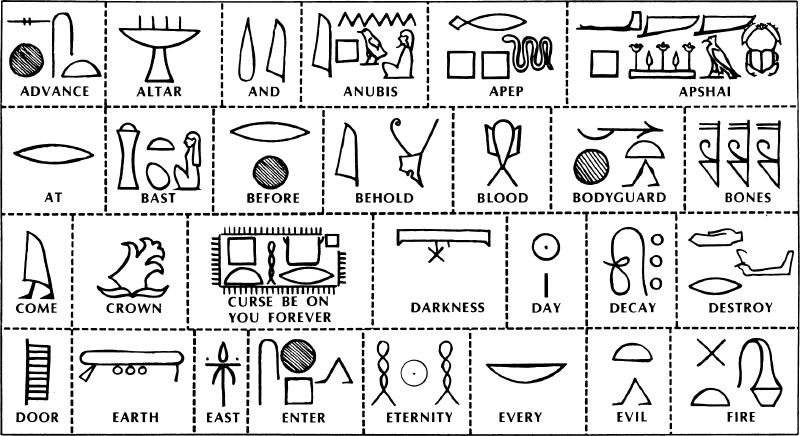
Creative writing challenge: Come up with a short story using only the words in this chart.
Now, I admit as a child I found this chart pretty nifty, even though I don't think I ever used it in a game. But how accurate is it? Well... not entirely, of course, but maybe more than you might expect. (Certainly more than I expected.) I didn't take the time look up every hieroglyph (or set of hieroglyphs) in this chart, but from those I did look up, it seems that the hieroglyphs for the gods, at least, are somewhat mangled but at least close to correct (though not unique; the important gods had multiple variant sets of hieroglyphs that could be used to represent them). The other words are a bit more of a mixed bag; most of them are more or less correct ("at", "behold", "bones", "crown", "every"), but others have entirely different meanings from the ones the chart ascribes to them ("before", "blood"—according to Budge those hieroglyphs actually mean "to know" and "magical protection", respectively). There were some I was unable to locate in Budge's Dictionary, but I'm guessing that's because Kuntz and Ward misinterpreted and/or miscopied them; I get the impression they were at least trying to give authentic hieroglyphs and meanings, even if they didn't always succeed. That is to say, I don't think they made any of these hieroglyphs up, though they did get some of them wrong.
Their choice of words to include, however, is somewhat baffling. Why fire and earth, and not air and water? Why before, but not after? Why come, but not go? Life, but not death? Yesterday, but not tomorrow? And, but not or? He and his, but not she and her? This, but not that? Right, but not... wrong, or left, depending on which "right" they meant? (For that matter, why didn't they specify which "right" they meant? "Right" as in the opposite of left and "right" as in the opposite of wrong happen to be the same word in English, but that's certainly not true in most languages.) Why are there no numbers or colors, two very common and useful categories of word? It could be that this is simply because they didn't run across those words in their perusal of The Book of the Dead, of course, but it does somewhat limit the sentences that can be made using these charts. Still, I guess you could write a sentence like "Enter hidden door within north passage", though certainly not in the way that the ancient Egyptians would have really written it, given that the book gives no information on ancient Egyptian grammar and word-for-word translations from one language to another don't really work.
The weirdest bit is the "curse be on you forever", the longest multiword phrase represented in the charts, and in fact the only multiword phrase besides "magical charm", "magical powers", and, oddly, "to give", which unlike any other verb in the charts includes the "to" with the infinitive. Please note that the charts do not include the words "curse" and "forever"; they do include the words "is", "on", and "you", but the hieroglyphs it gives for those words don't match anything in the "curse be on you forever" hieroglyph. (Well, okay, they do include "eternity", which I guess could be used for "forever", but the "eternity" hieroglyph doesn't appear there either.) Apparently Kuntz and Ward just thought this one specific phrase was useful enough to warrant inclusion, and that no Dungeon Master would ever have occasion to refer to curses in any other context. Unfortunately, this is another hieroglyph they rather badly misinterpreted... I may not be getting the meaning exactly right, but as far as I can tell, the hieroglyphs they've translated as "curse be on you forever" actually mean something more like "shrine of Ptah".
Anyway, I guess that's a good note to end on, which is fortunate because this is the end of the chapter anyway.
Next time: "All Mothers Will Conform to the Following Statistics"